My most current blog entry:
Entries in Buddha (40)
Rural Thai Temple Loi Kratong Celebration
 Saturday, December 26, 2020 at 2:05PM
Saturday, December 26, 2020 at 2:05PM  A young couple setting their kratong to float into Klong Ha (canal 5). Loi Kratong is a wonderful occasion in Thailand . . . everyone participates.
A young couple setting their kratong to float into Klong Ha (canal 5). Loi Kratong is a wonderful occasion in Thailand . . . everyone participates. Driving home from an evening of testing at my local drag strip, I noticed many cars parked near the rural canalside Buddhist temple. So I stopped to take a look.
Driving home from an evening of testing at my local drag strip, I noticed many cars parked near the rural canalside Buddhist temple. So I stopped to take a look. I parked and walked across a narrow bridge toward the lights in the distance.
I parked and walked across a narrow bridge toward the lights in the distance. I entered the temple grounds through a 'side entrance' . . . lots of motorcycles parked.
I entered the temple grounds through a 'side entrance' . . . lots of motorcycles parked. Although it was a festival, a trampoline was the only amusement here for the kids in this rural location.
Although it was a festival, a trampoline was the only amusement here for the kids in this rural location. Once inside, I joined the crowd of rural Thai folks enjoying the evening out.
Once inside, I joined the crowd of rural Thai folks enjoying the evening out. And what the people had come for was to stroll about the temple grounds eating various Thai treats, watching presentations and dancing on a stage, meet with the Buddhist monks for blessings, make a donation to the temple, to purchase or make their own kratong, and to launch their kratong into the klong (canal).
And what the people had come for was to stroll about the temple grounds eating various Thai treats, watching presentations and dancing on a stage, meet with the Buddhist monks for blessings, make a donation to the temple, to purchase or make their own kratong, and to launch their kratong into the klong (canal). There were rows and rows of food stalls set up for the evening.
There were rows and rows of food stalls set up for the evening. As always in Thailand, were was every imaginable delicious thing to eat on sale . . . readymade dinner packs . . . .
As always in Thailand, were was every imaginable delicious thing to eat on sale . . . readymade dinner packs . . . . What would a festival be without deep fried frog?
What would a festival be without deep fried frog? The deep-fried bug snack stall was doing a brisk business.
The deep-fried bug snack stall was doing a brisk business. The fried bug stall had two kinds of grasshoppers: these 'type A' grasshoppers, and . . .
The fried bug stall had two kinds of grasshoppers: these 'type A' grasshoppers, and . . . . . . and these 'type B' grasshoppers. Take your pick.
. . . and these 'type B' grasshoppers. Take your pick. If you were looking to munch on something a little more crunchy, there were the deep-fried june bugs on offer in green and black.
If you were looking to munch on something a little more crunchy, there were the deep-fried june bugs on offer in green and black. If crispy bugs weren't to your liking, there was also the chewy option: deep-fried and highly spiced grubs. Mmmmmmm!
If crispy bugs weren't to your liking, there was also the chewy option: deep-fried and highly spiced grubs. Mmmmmmm! For this festival, the food stalls had been erected in and among the temple buildings and large Buddha statuary.
For this festival, the food stalls had been erected in and among the temple buildings and large Buddha statuary. At the base of this Buddha statue many local ladies were crafting kratongs for purchase to benefit the temple.
At the base of this Buddha statue many local ladies were crafting kratongs for purchase to benefit the temple. An onsite workshop of kratong production.
An onsite workshop of kratong production. I purchased one of these kratongs made with a banana stalk base. "A krathong is traditionally a small floating container fashioned of leaves which is made to hold a small portion of goods like a traditional Thai dish (such as hor mok) or dessert. The traditional krathong used for floating at the festival are made from a slice of a banana tree trunk or a spider lilly plant. Modern krathongs are more often made of bread or Styrofoam. A bread krathong will disintegrate after a few days and can be eaten by fish. Banana stalk krathongs are also biodegradable, but Styrofoam krathongs are increasingly banned, as they pollute rivers and oceans." (**) There were NO kratongs for sale at this temple with Styrofoam bases . . . I was very happy to see that.
I purchased one of these kratongs made with a banana stalk base. "A krathong is traditionally a small floating container fashioned of leaves which is made to hold a small portion of goods like a traditional Thai dish (such as hor mok) or dessert. The traditional krathong used for floating at the festival are made from a slice of a banana tree trunk or a spider lilly plant. Modern krathongs are more often made of bread or Styrofoam. A bread krathong will disintegrate after a few days and can be eaten by fish. Banana stalk krathongs are also biodegradable, but Styrofoam krathongs are increasingly banned, as they pollute rivers and oceans." (**) There were NO kratongs for sale at this temple with Styrofoam bases . . . I was very happy to see that. In addition to having kratongs for sale, there was a "Best Kratong" contest! Here are a few of the entrants:
In addition to having kratongs for sale, there was a "Best Kratong" contest! Here are a few of the entrants: This entry in the "Best Kratong Contest" was very beautiful.
This entry in the "Best Kratong Contest" was very beautiful. My favorite to win the contest: the COVID-19-themed kratong. Yes, let's send the virus down the river along with our best wishes for a better life in the future.
My favorite to win the contest: the COVID-19-themed kratong. Yes, let's send the virus down the river along with our best wishes for a better life in the future. The families would eventually wait their turn to enter a temple structure to pay respect to the Buddha.
The families would eventually wait their turn to enter a temple structure to pay respect to the Buddha. Buddhism is a living "religion" in Thailand. Families carry out ancient rituals still today.
Buddhism is a living "religion" in Thailand. Families carry out ancient rituals still today. Small donations are placed on these bushes like leaves. Sweet.
Small donations are placed on these bushes like leaves. Sweet. Just wandering around the wat to enjoy the Buddha imagery.
Just wandering around the wat to enjoy the Buddha imagery. The 'Wat festival' is not only a celebration of Loi Krathong and a fund raising event for the temple, it is also a community event. A stage is set up for local rural folk to share cultural and artistic expression, like this troupe of elderly traditional Thai dancers.
The 'Wat festival' is not only a celebration of Loi Krathong and a fund raising event for the temple, it is also a community event. A stage is set up for local rural folk to share cultural and artistic expression, like this troupe of elderly traditional Thai dancers. The traditional Thai dance group being publicly acknowledged and praised.
The traditional Thai dance group being publicly acknowledged and praised.  Community leaders and event organizers acknowledged by the area political leader.
Community leaders and event organizers acknowledged by the area political leader. I took my new kratong (float) toward the canal to launch it and was met with throngs of people now entering the Wat for the festival and launching their own kratongs. Notice everybody eating some delicious Thai snack or other.
I took my new kratong (float) toward the canal to launch it and was met with throngs of people now entering the Wat for the festival and launching their own kratongs. Notice everybody eating some delicious Thai snack or other. I arrived at the canal as the crowds poured in across the bridge.
I arrived at the canal as the crowds poured in across the bridge. A nice family photo just before launching their individual krathongs.
A nice family photo just before launching their individual krathongs. I pressed myself into this human mass to launch my own kratong, express my hopes for the coming year, and send respect to the Buddha.
I pressed myself into this human mass to launch my own kratong, express my hopes for the coming year, and send respect to the Buddha. Such a wonderful sight: a whole community collectively floating away the bad from last year and the hopes for the coming year.
Such a wonderful sight: a whole community collectively floating away the bad from last year and the hopes for the coming year. And one giant krathong for the entire community and Wat.
And one giant krathong for the entire community and Wat. The whole scene brightly lit up in fantastic colorful neon arrays.
The whole scene brightly lit up in fantastic colorful neon arrays. Reflect light on Klong 5. Magic.
Reflect light on Klong 5. Magic. Extraordinary reflection!
Extraordinary reflection! When I left I crossed back over the bridge and saw this amazing scene!
When I left I crossed back over the bridge and saw this amazing scene! Looking across the canal to the other side, I noticed just as many people there crowding to float their kratongs.
Looking across the canal to the other side, I noticed just as many people there crowding to float their kratongs. Looking back under the bridge to the Wat side of the canal . . . many, many people out joining in an ancient Thai cultural tradition.
Looking back under the bridge to the Wat side of the canal . . . many, many people out joining in an ancient Thai cultural tradition. My last look back at the the rural Loi Krathong festival . . . way out in a dark Thai farmland night.
My last look back at the the rural Loi Krathong festival . . . way out in a dark Thai farmland night.First Post-Lockdown Jaunt: Two Days in Rural Khao Yai!
 Wednesday, June 3, 2020 at 2:18PM
Wednesday, June 3, 2020 at 2:18PM 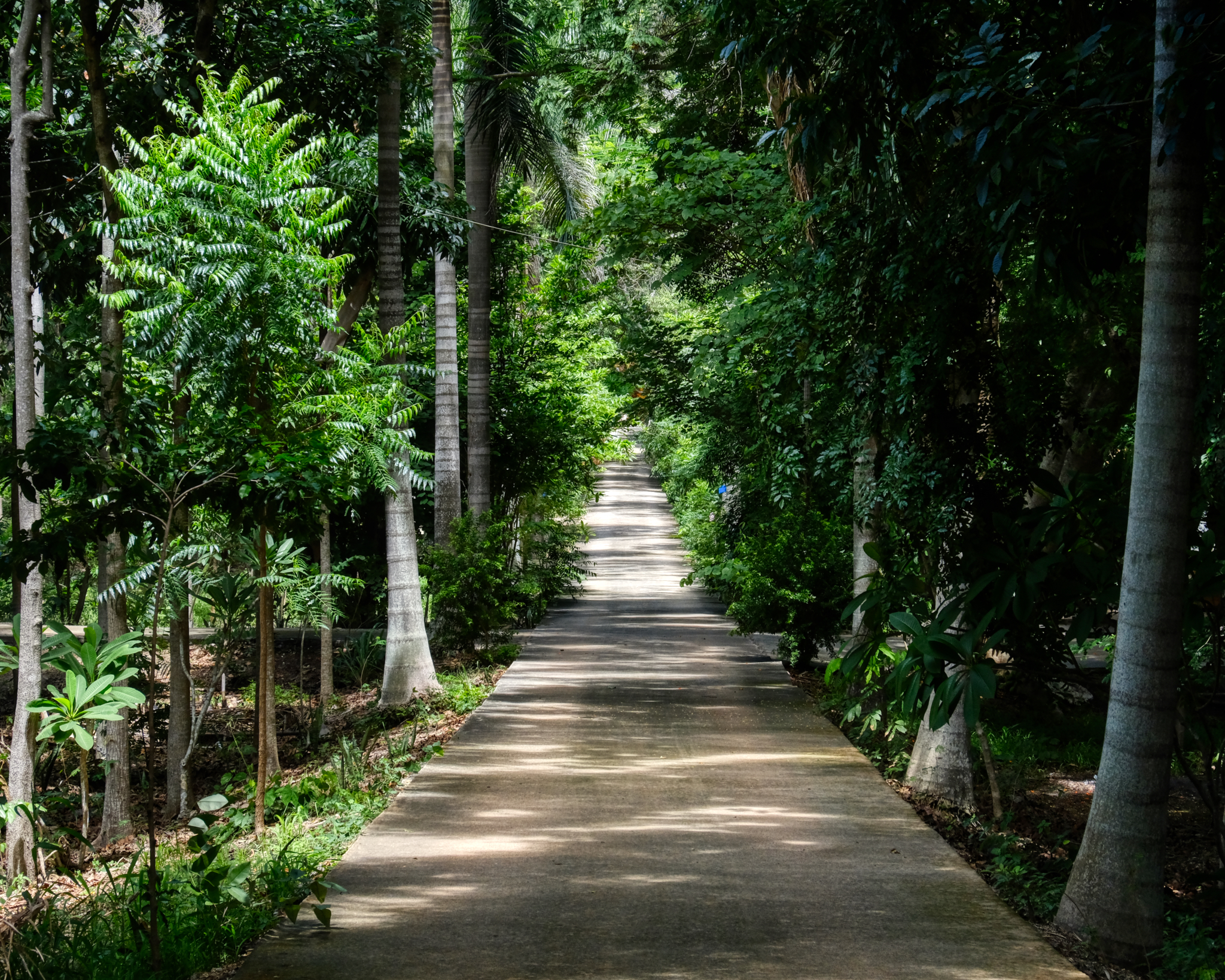
Khao Yai (literally, "large mountain" in the Thai language) is a region of Thailand about a three hour drive northeast of Bangkok. It is thought of as an area with a national park, mountains, and nature, although the mountains are really just tall hills. There is a lot to see in this part of rural Thailand . . . and one very special temple: Wat PA Phrom Prathan (last half of this entry).
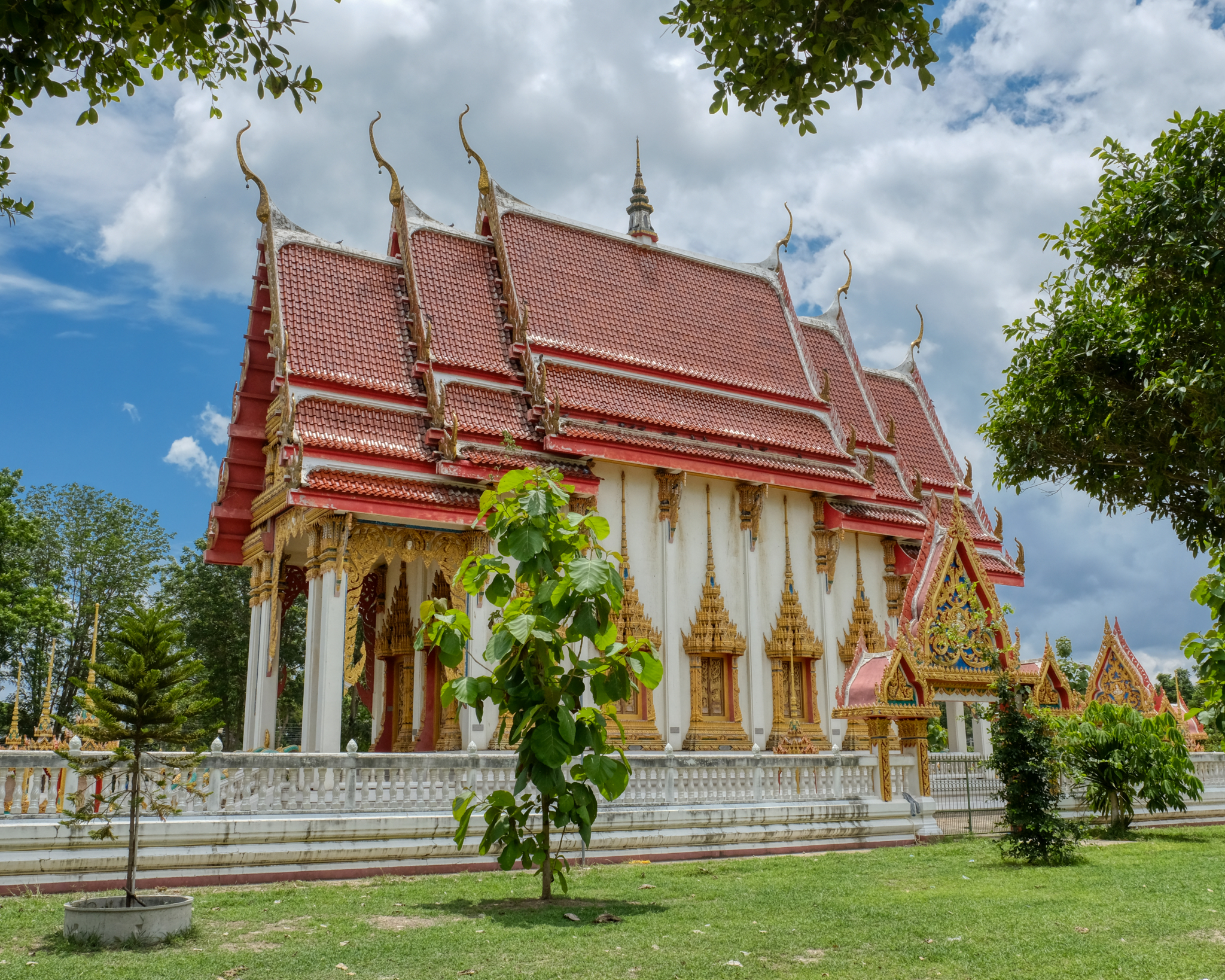 While my wife played golf with her golfing gang, I escaped to the small back roads. There are always Buddhist temples (wats) every 4-5 kilometers along almost every road in Thailand.
While my wife played golf with her golfing gang, I escaped to the small back roads. There are always Buddhist temples (wats) every 4-5 kilometers along almost every road in Thailand.
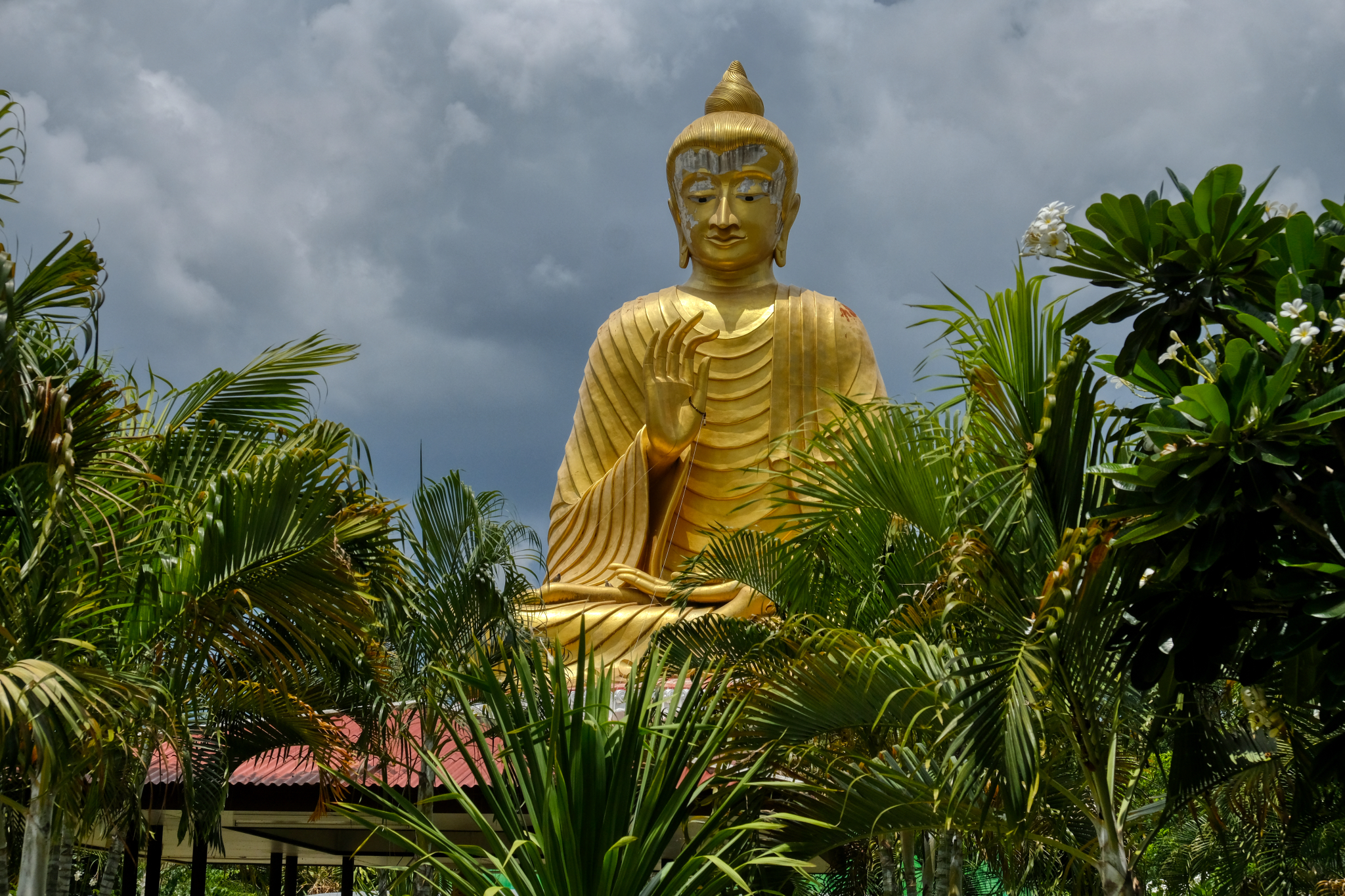 I stopped in at many of these roadside wats and walked around and took a few photos. I have lived in Thailand for a very long time and have been in literally many hundreds of these Thai wats.
I stopped in at many of these roadside wats and walked around and took a few photos. I have lived in Thailand for a very long time and have been in literally many hundreds of these Thai wats.
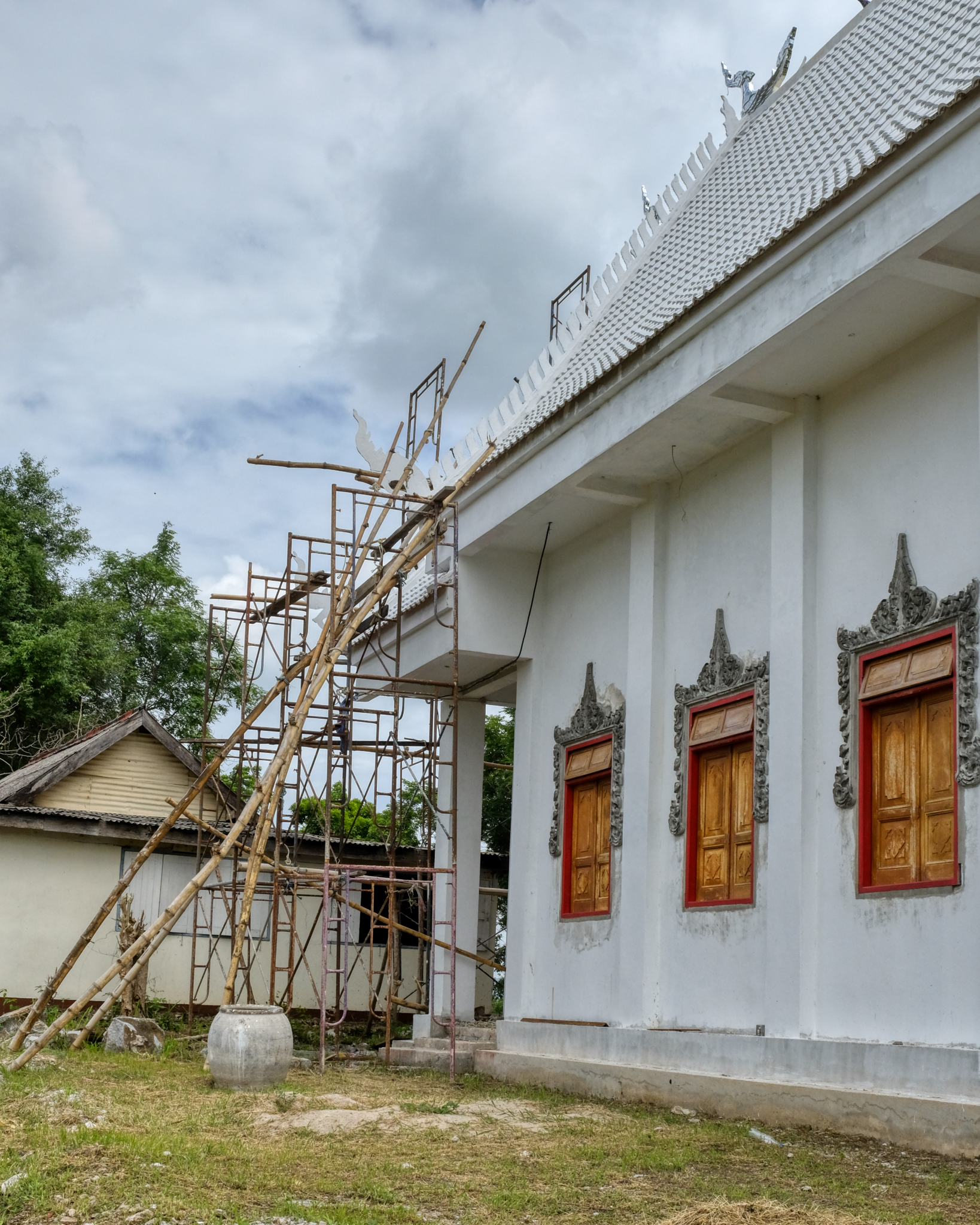 Rural Thai wats can be very similar, but there are always surprises and idiosyncrasies. This wat was in the process of building a new temple building.
Rural Thai wats can be very similar, but there are always surprises and idiosyncrasies. This wat was in the process of building a new temple building.
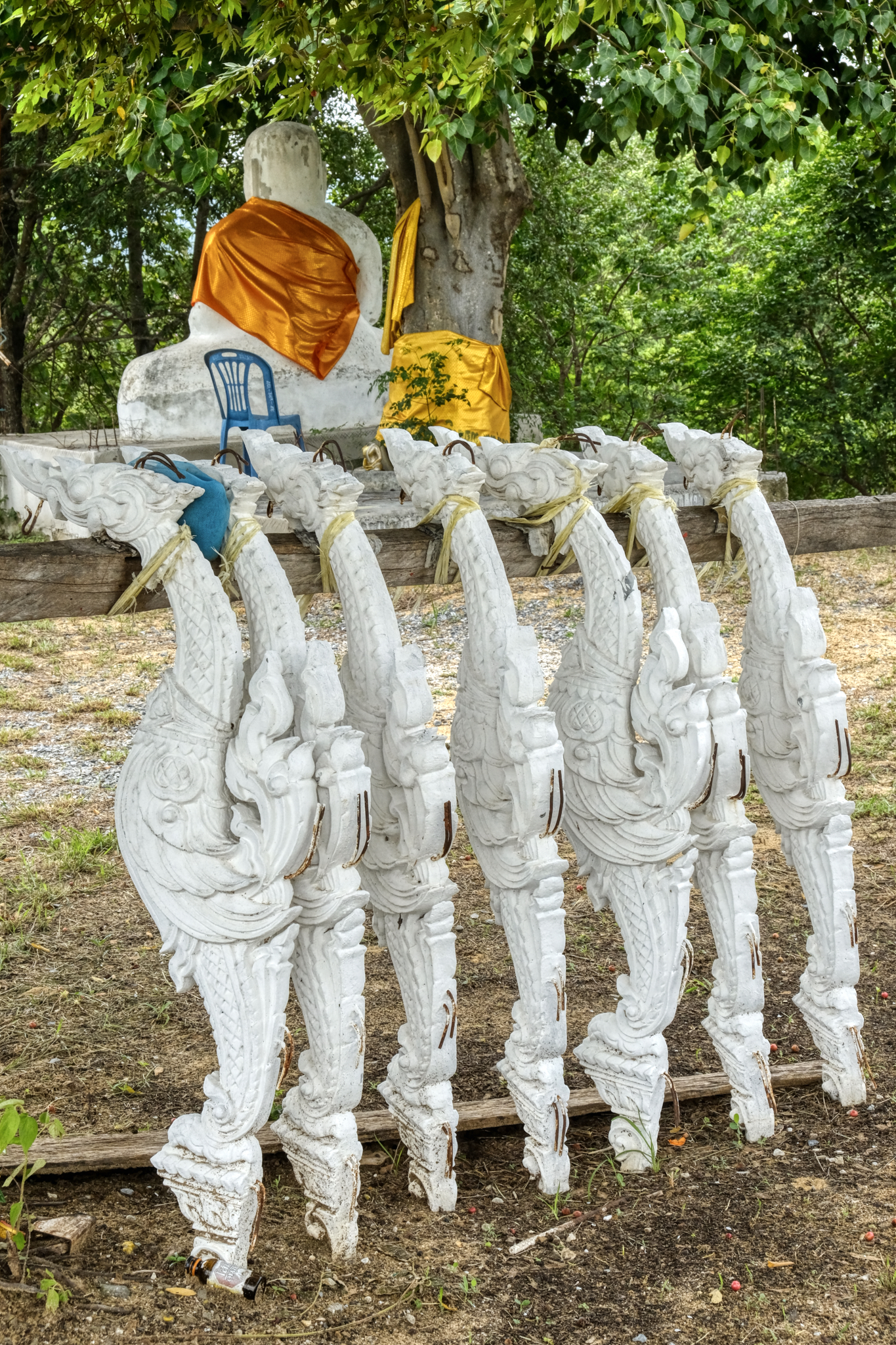 Pre cast decor waiting too be added to the exterior of the new wat structure.
Pre cast decor waiting too be added to the exterior of the new wat structure.
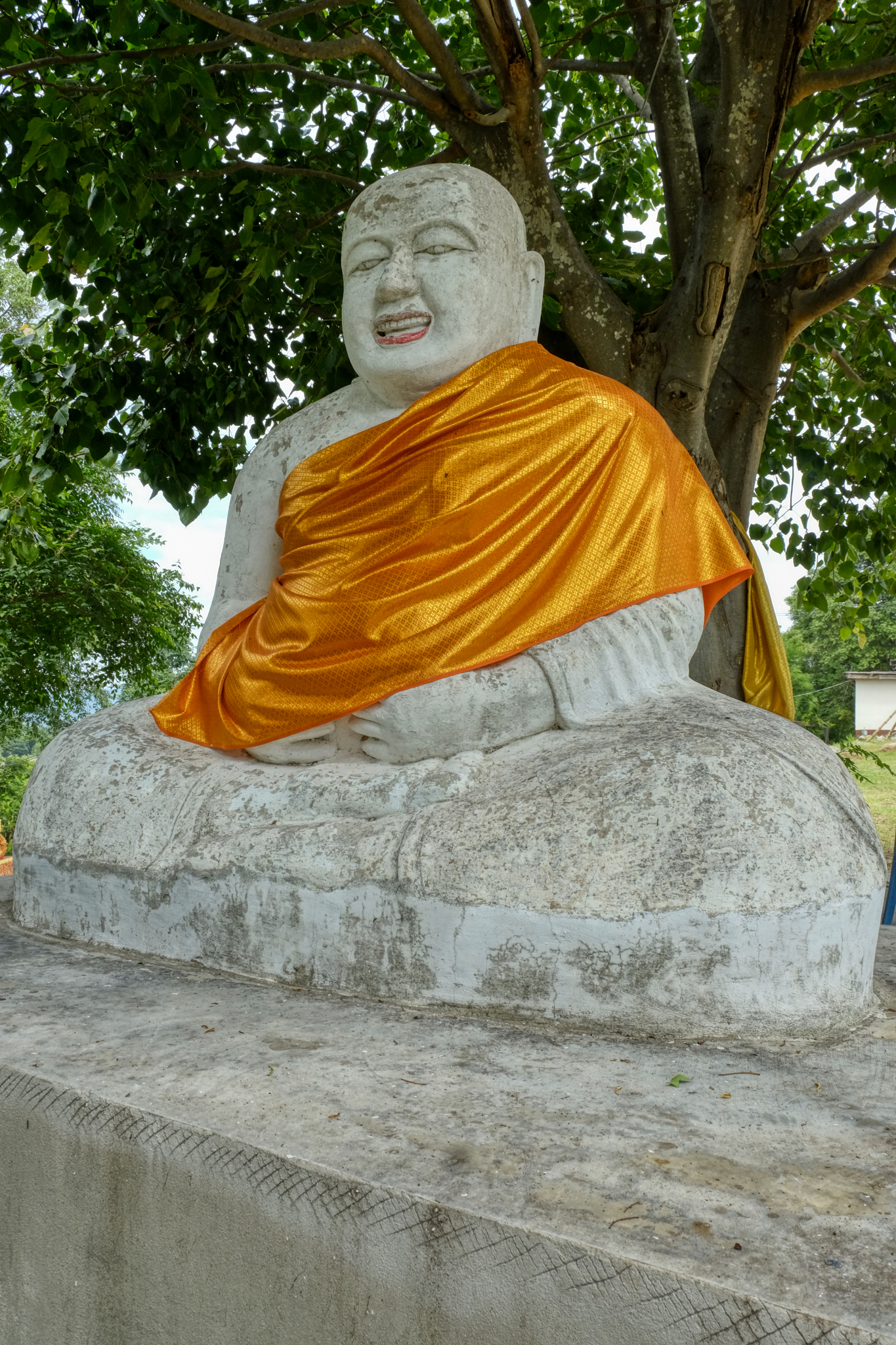 This Buddha image was very unusual for Thailand! It seems more Japanese . . .
This Buddha image was very unusual for Thailand! It seems more Japanese . . .
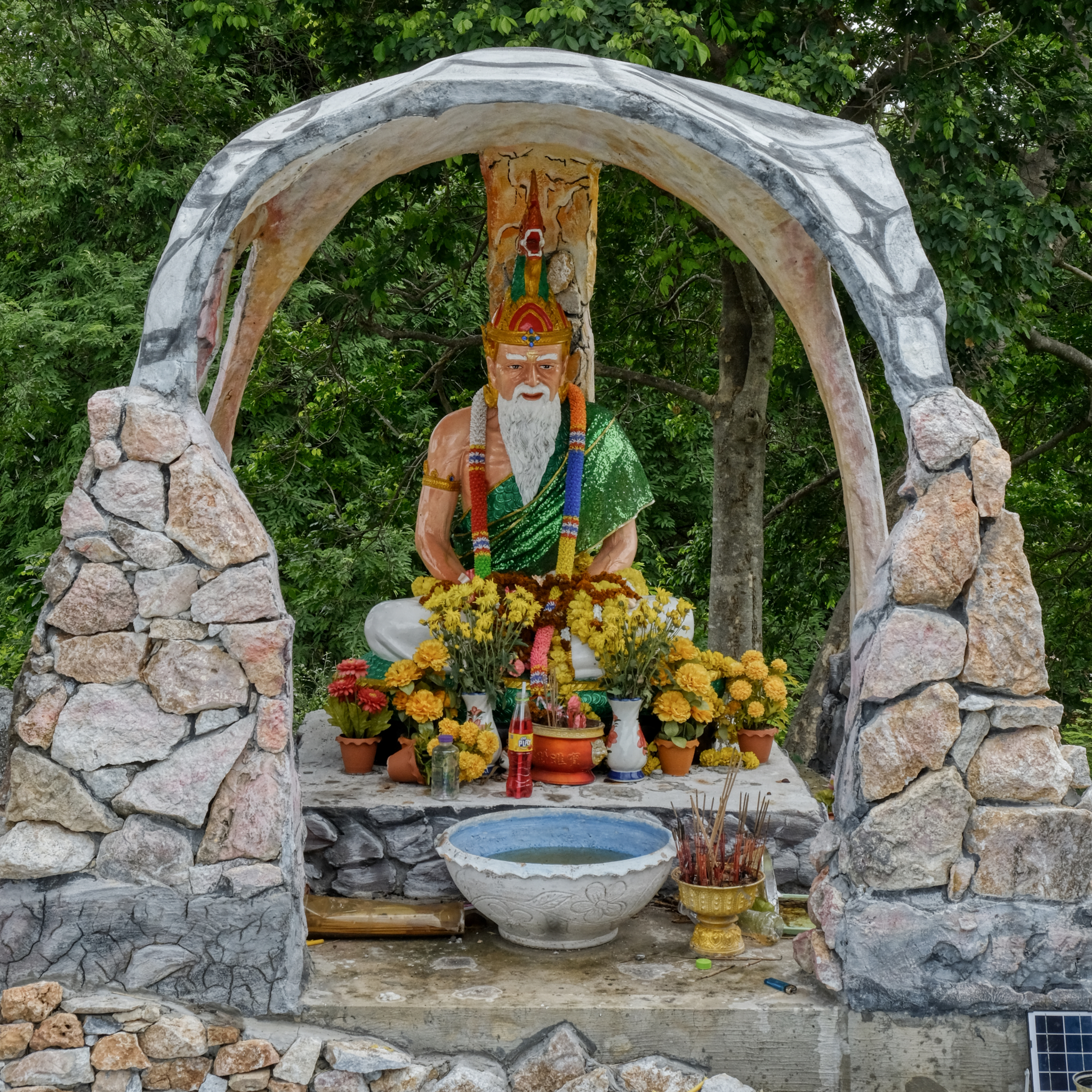 You have to remember that what is found inside a Buddhist temple was put there by the donors, not necessarily by monks who live there. This is a grotto dedicated to a Hindu guru. It is not uncommon to see Hindu gods and iconography in Thai wats.
You have to remember that what is found inside a Buddhist temple was put there by the donors, not necessarily by monks who live there. This is a grotto dedicated to a Hindu guru. It is not uncommon to see Hindu gods and iconography in Thai wats.
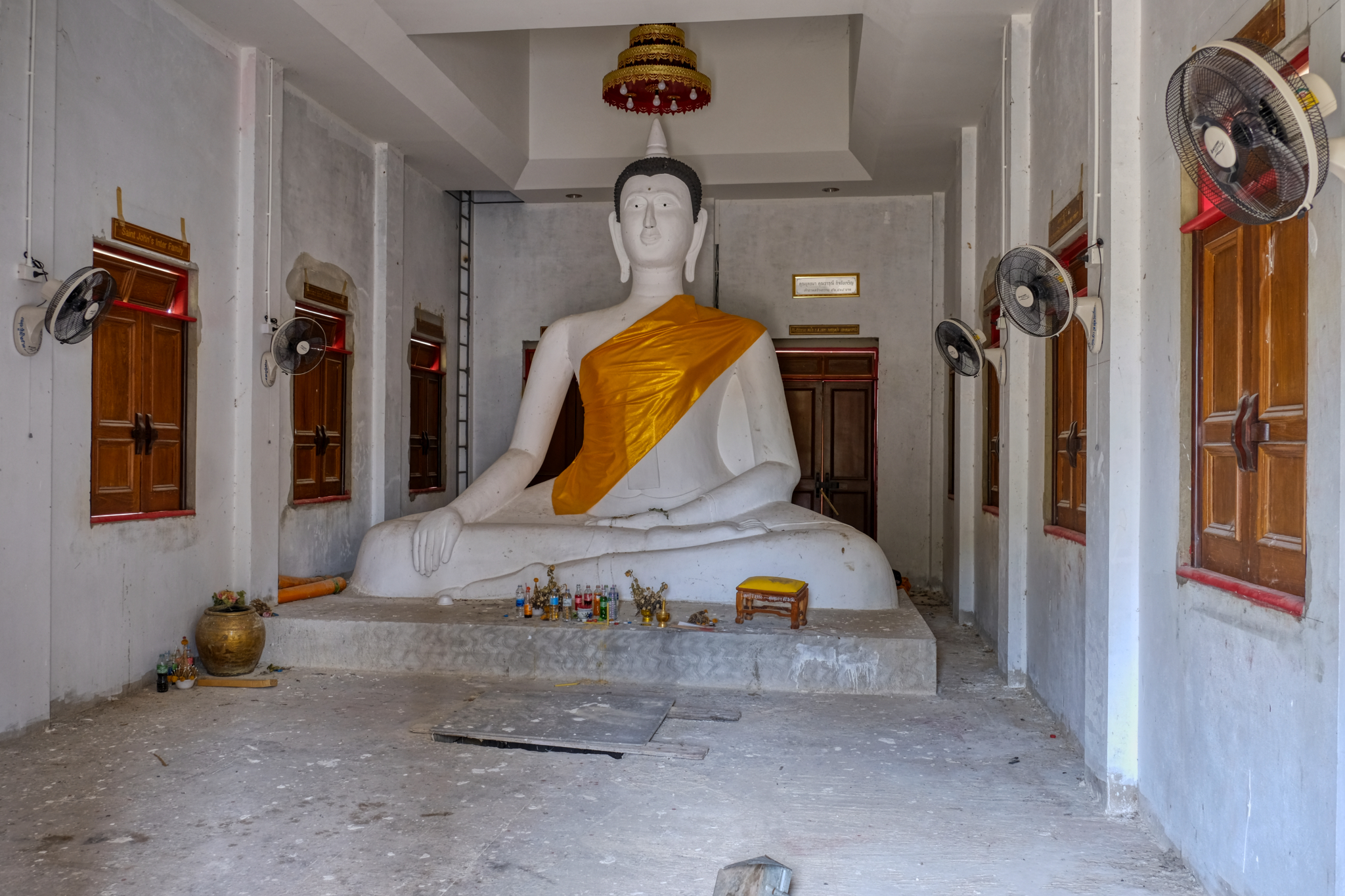 Having been a sponsor of the construction of a wat myself, I am always excited to see a new wat being built . . . I especially enjoy the interiors . . . . a wonderfully naive Buddha statue awaiting a gold leaf covering, I assume.
Having been a sponsor of the construction of a wat myself, I am always excited to see a new wat being built . . . I especially enjoy the interiors . . . . a wonderfully naive Buddha statue awaiting a gold leaf covering, I assume.
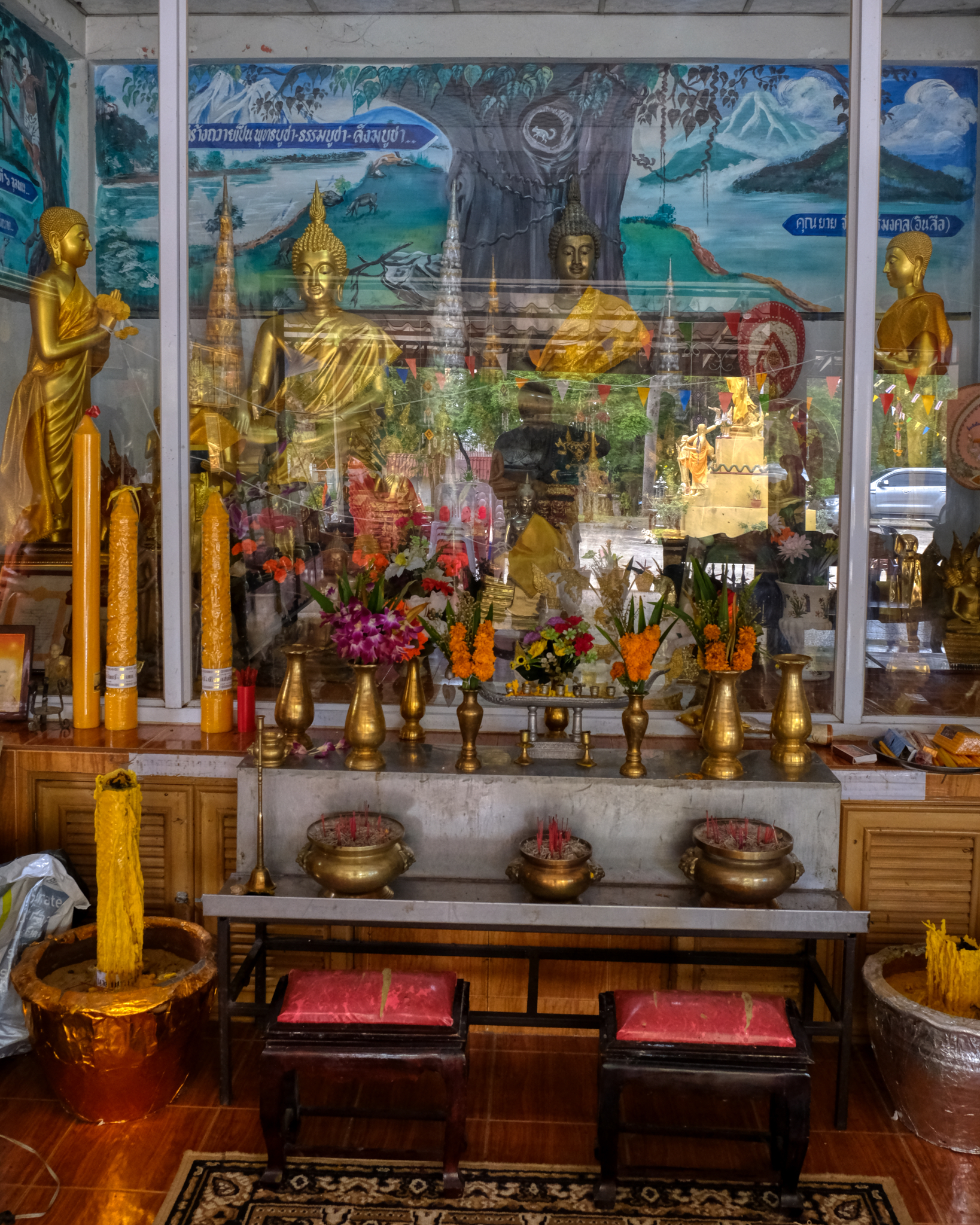 The wat did not have a proper temple building. This is the altar the new building will replace . . . just a covered portico.
The wat did not have a proper temple building. This is the altar the new building will replace . . . just a covered portico.
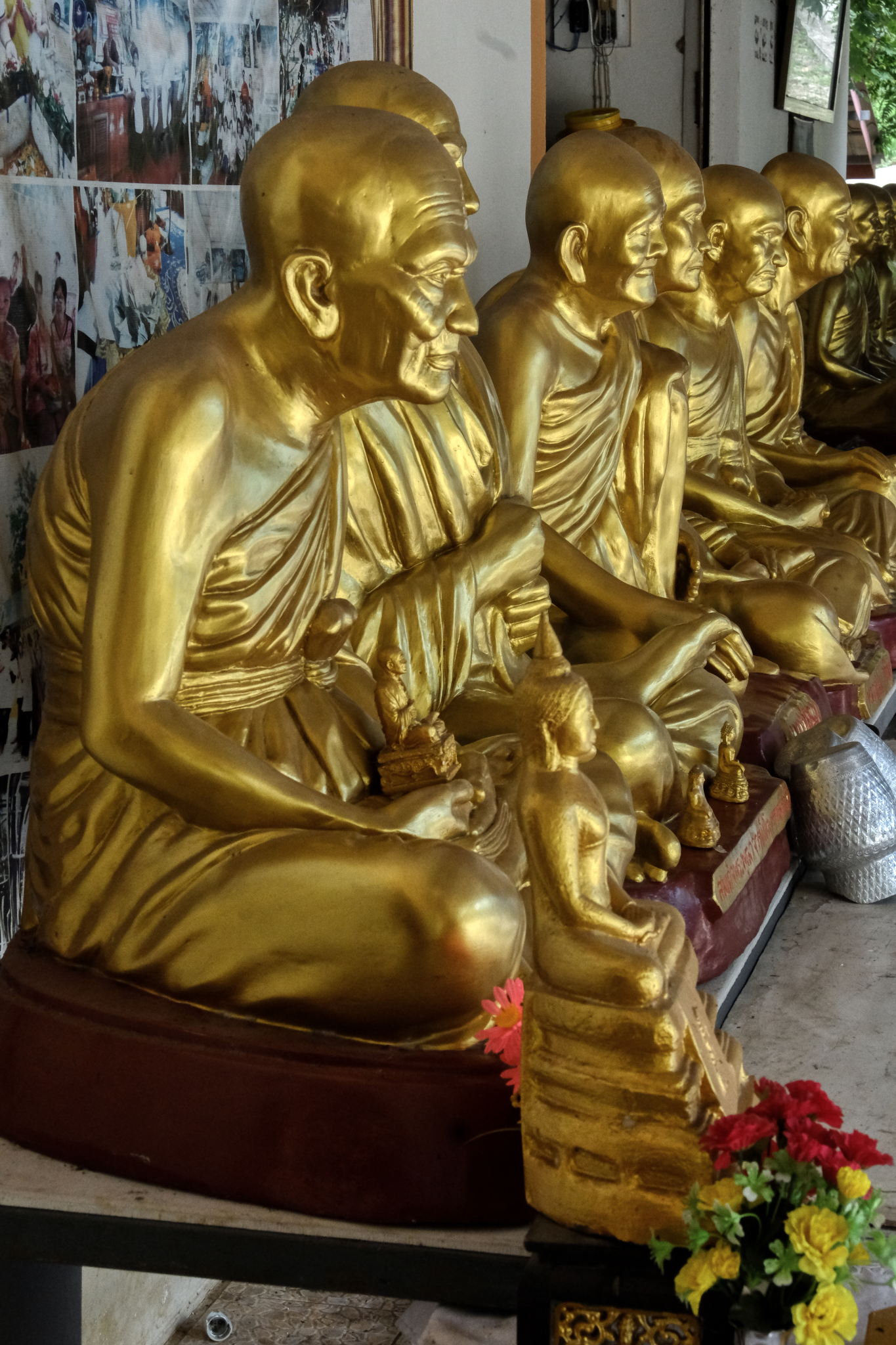 This wat had a line of gilded revered monk statues. Very powerful: These Guys Made It All The Way And You Can Too!
This wat had a line of gilded revered monk statues. Very powerful: These Guys Made It All The Way And You Can Too!
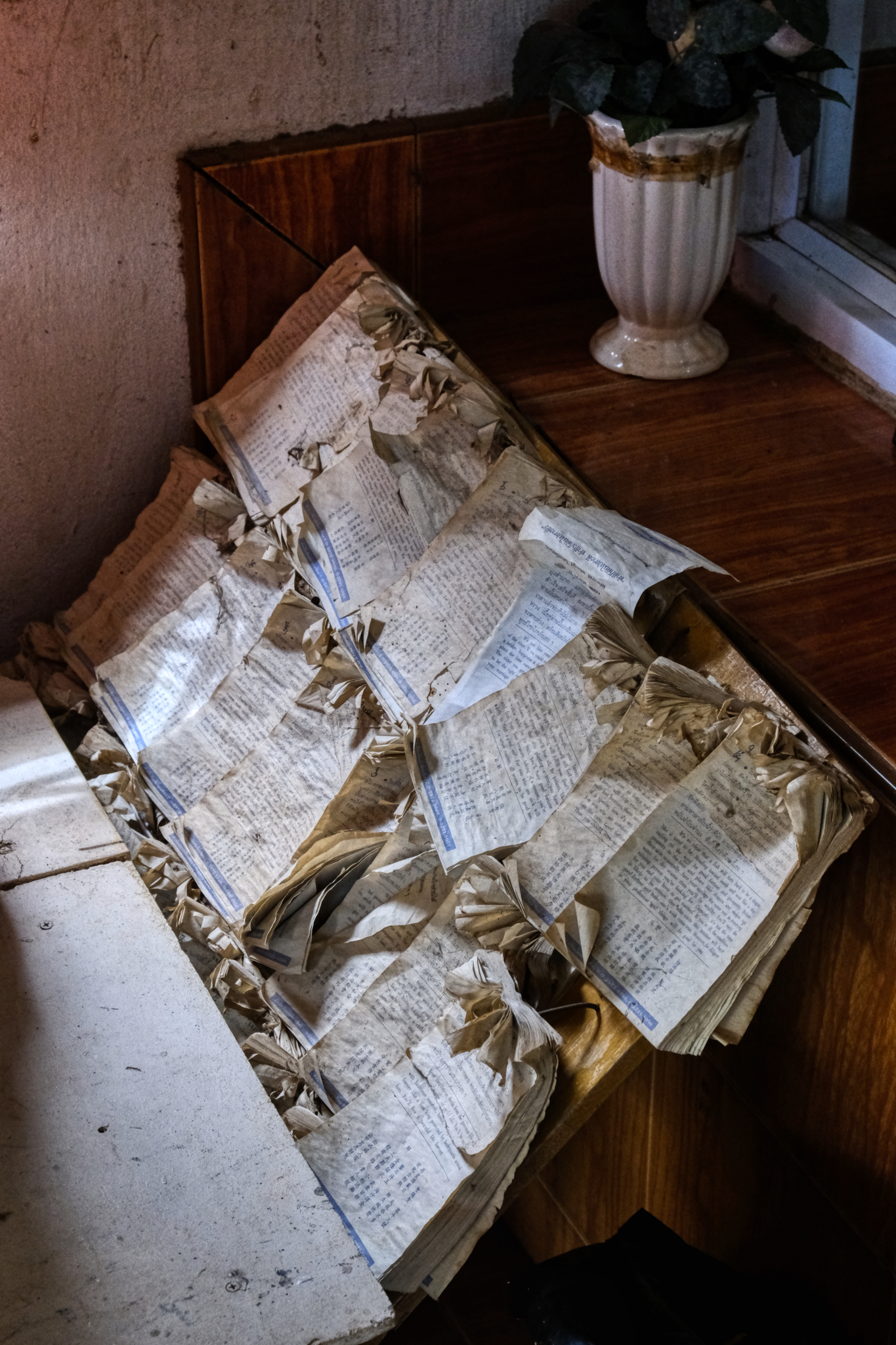 There are non-Buddhist, but old spiritual practices to be found in Thai Buddhist temples. These are for use in a numerological system for fortune telling. Beautifully weathered.
There are non-Buddhist, but old spiritual practices to be found in Thai Buddhist temples. These are for use in a numerological system for fortune telling. Beautifully weathered.
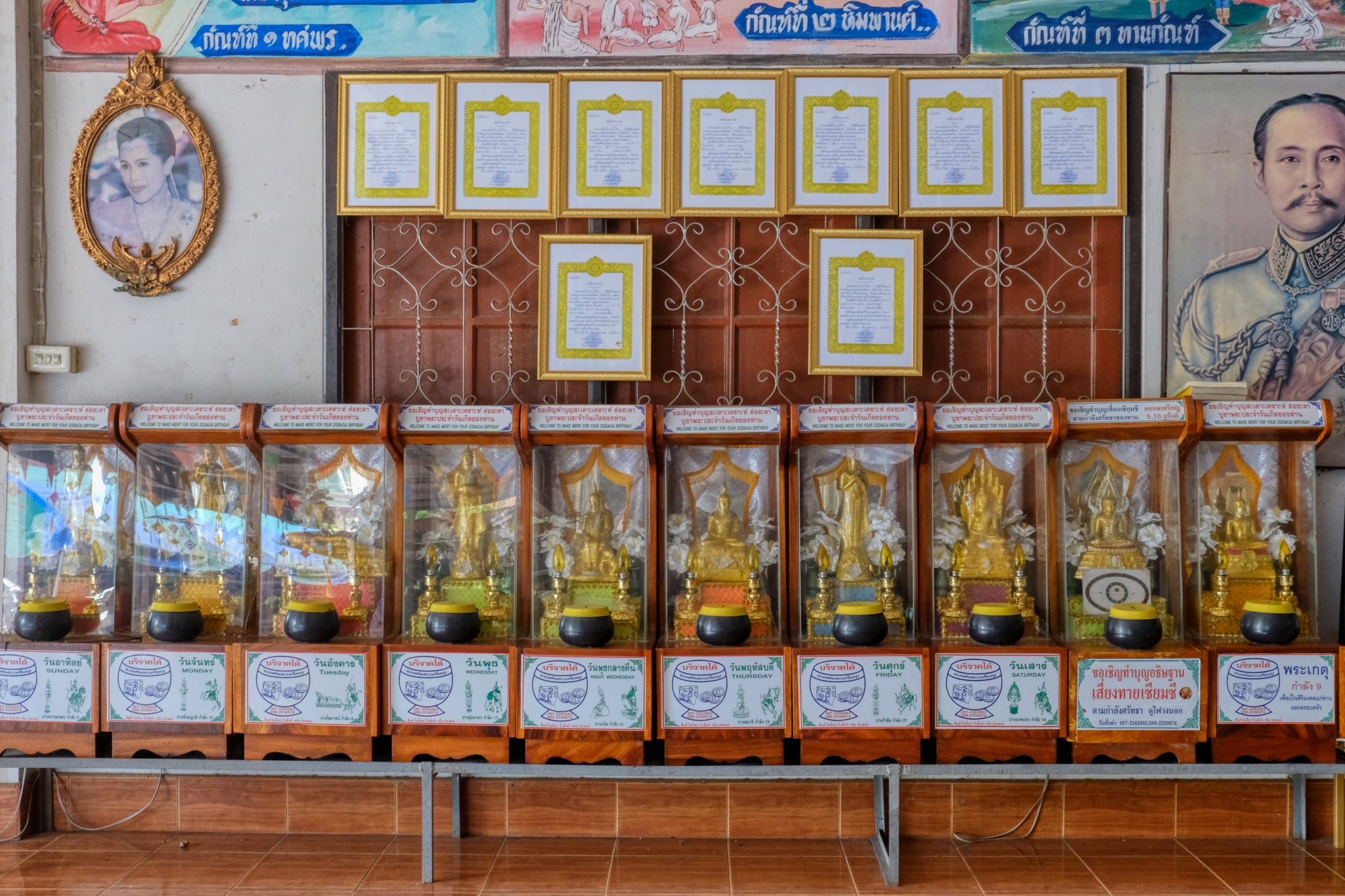 "Welcome to make merit for your Zodiacal Birthday" . . . . and a little something for the days of the week too!
"Welcome to make merit for your Zodiacal Birthday" . . . . and a little something for the days of the week too!
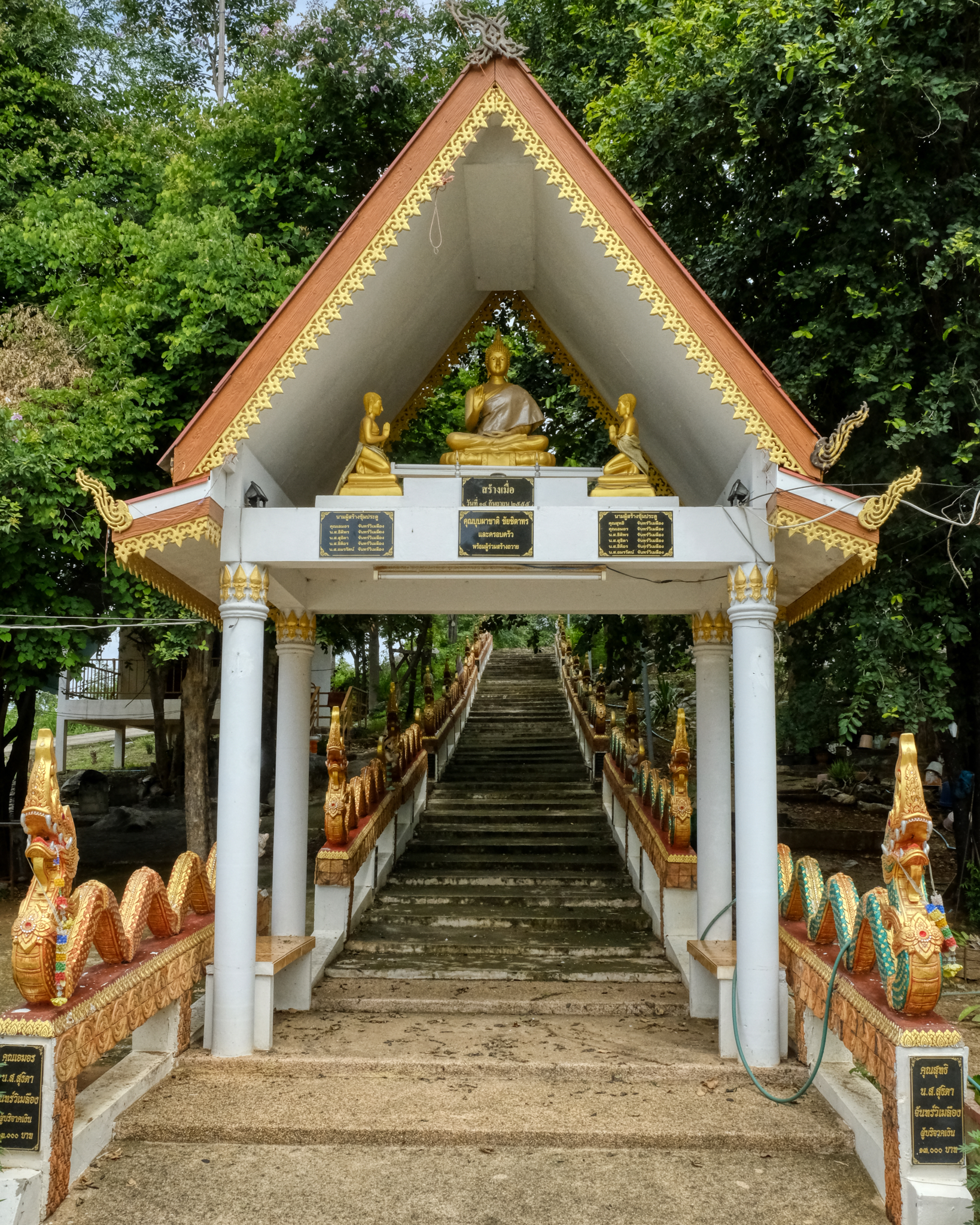 The hillside wat had a beautiful staircase up to the new wat location.
The hillside wat had a beautiful staircase up to the new wat location.
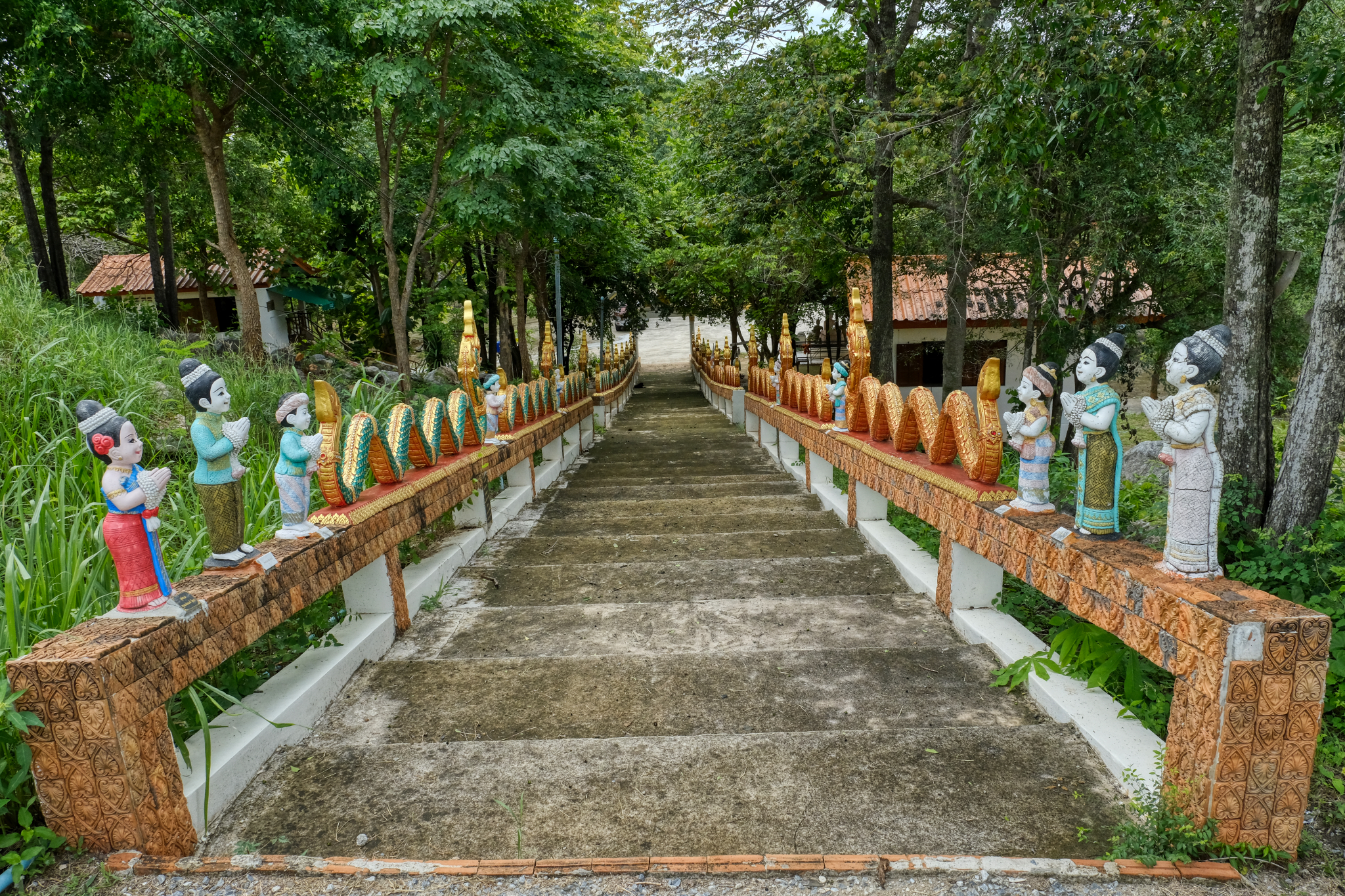 The same staircase looking down.
The same staircase looking down.
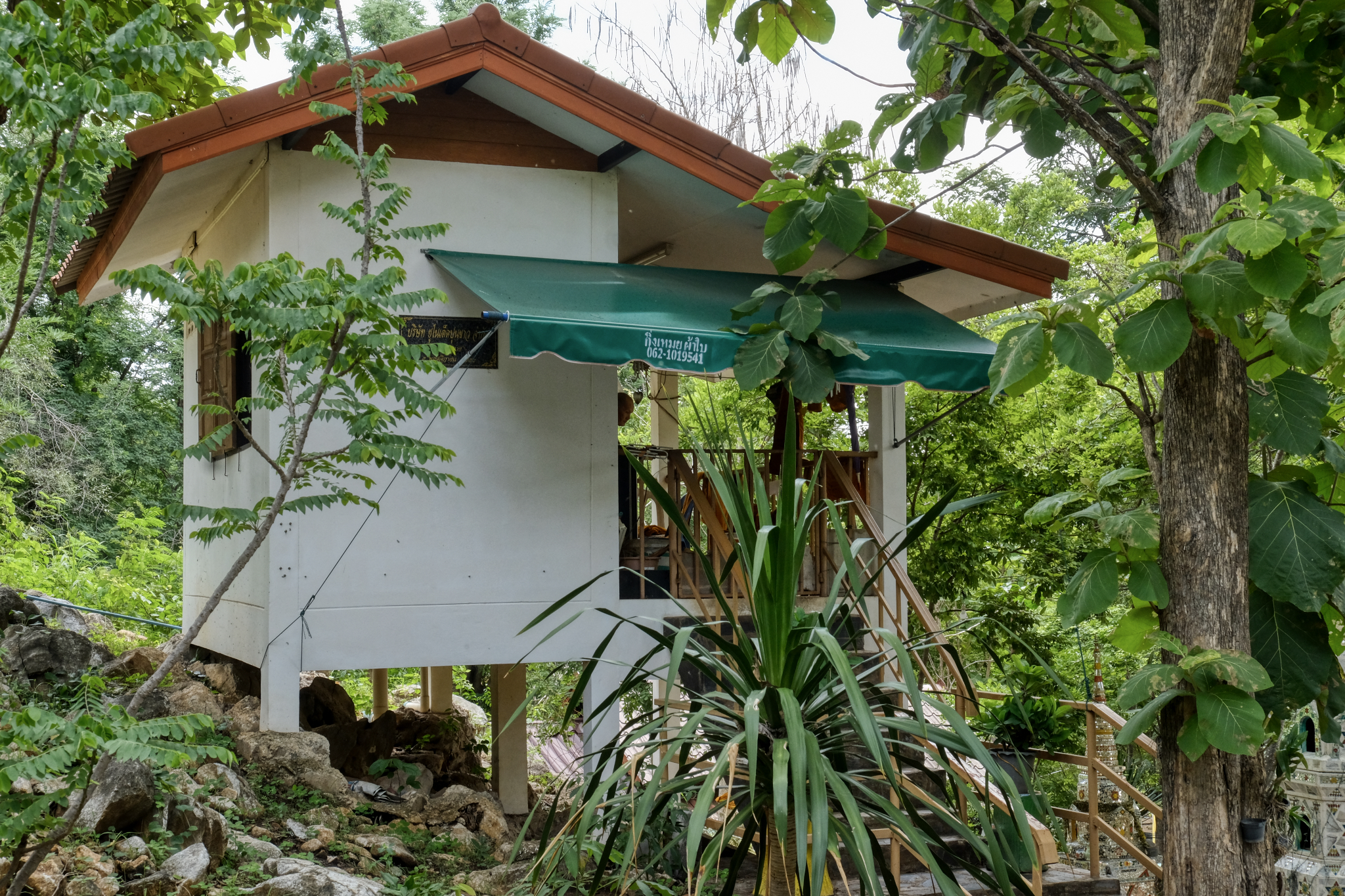 The monks live in a variety of accommodation: sometimes they have their own 'hut' or cabin, like this one. Sometimes these can be very nice, and sometimes very austere dormitories.
The monks live in a variety of accommodation: sometimes they have their own 'hut' or cabin, like this one. Sometimes these can be very nice, and sometimes very austere dormitories.
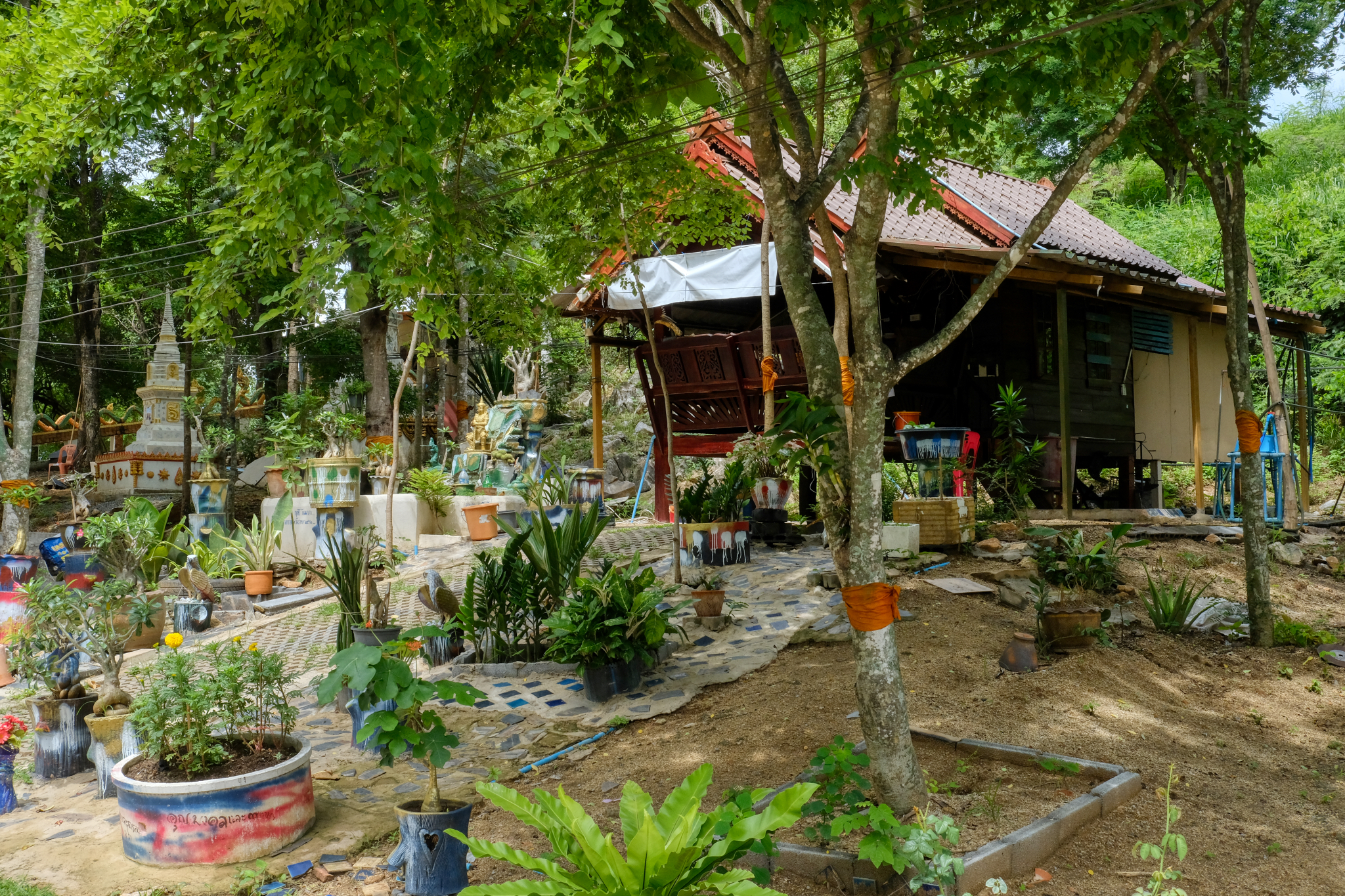 This monk keeps an interesting and cluttered front yard!
This monk keeps an interesting and cluttered front yard!
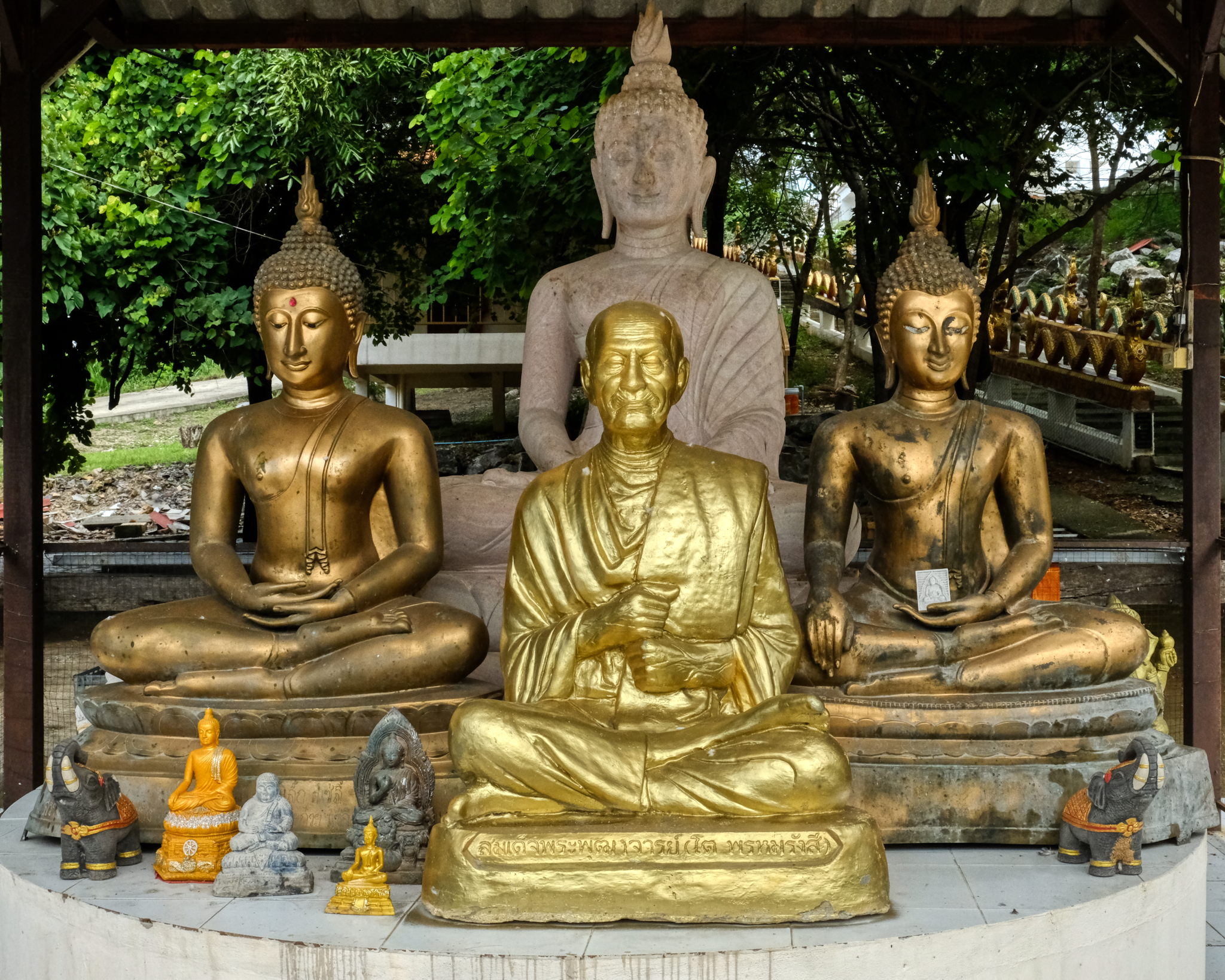 I found this wonderful altar in a sala out in a wooded area of the wat.
I found this wonderful altar in a sala out in a wooded area of the wat.
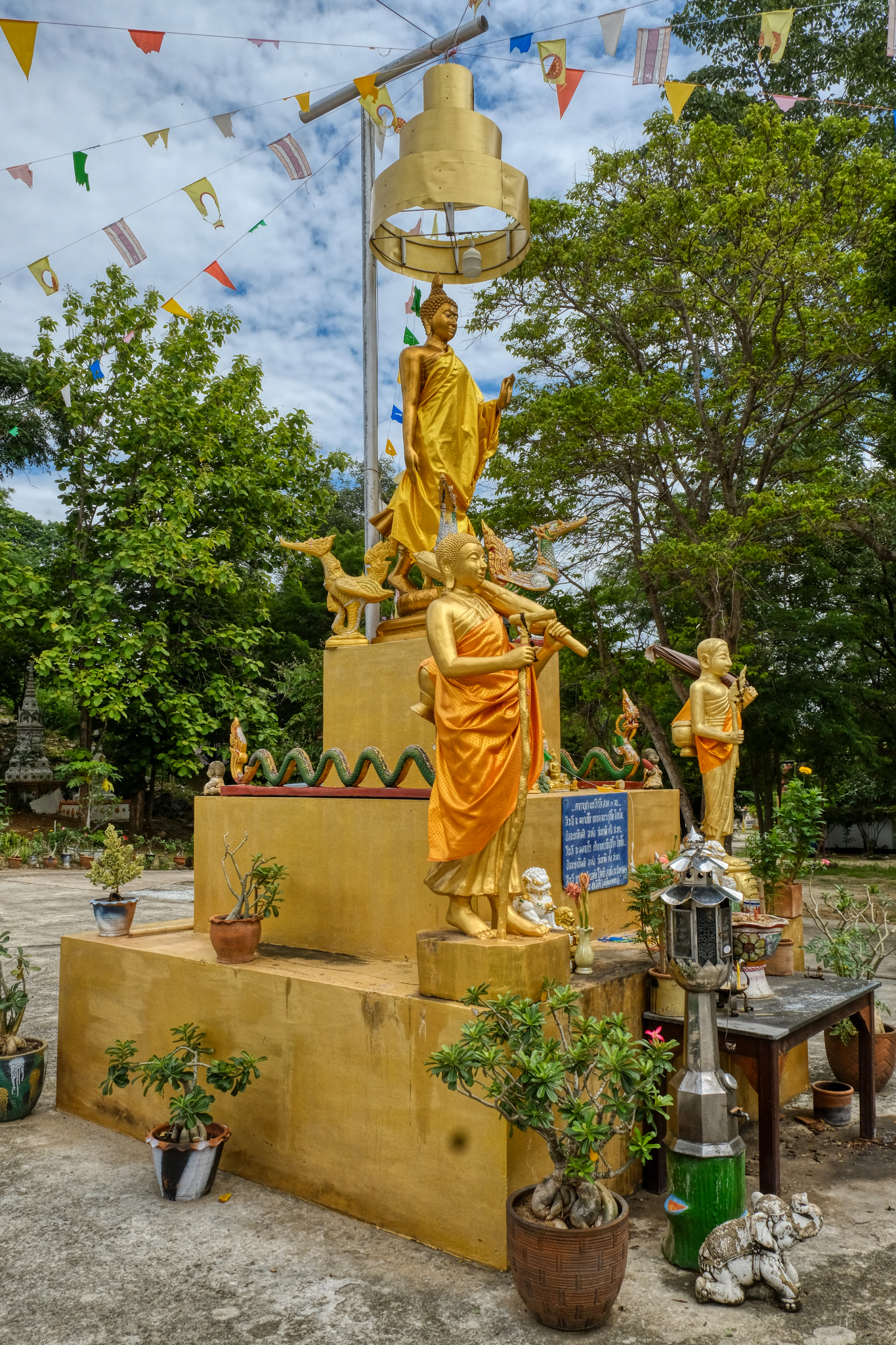 There always some amazing things to see on the grounds of Thai Buddhist wats!
There always some amazing things to see on the grounds of Thai Buddhist wats!
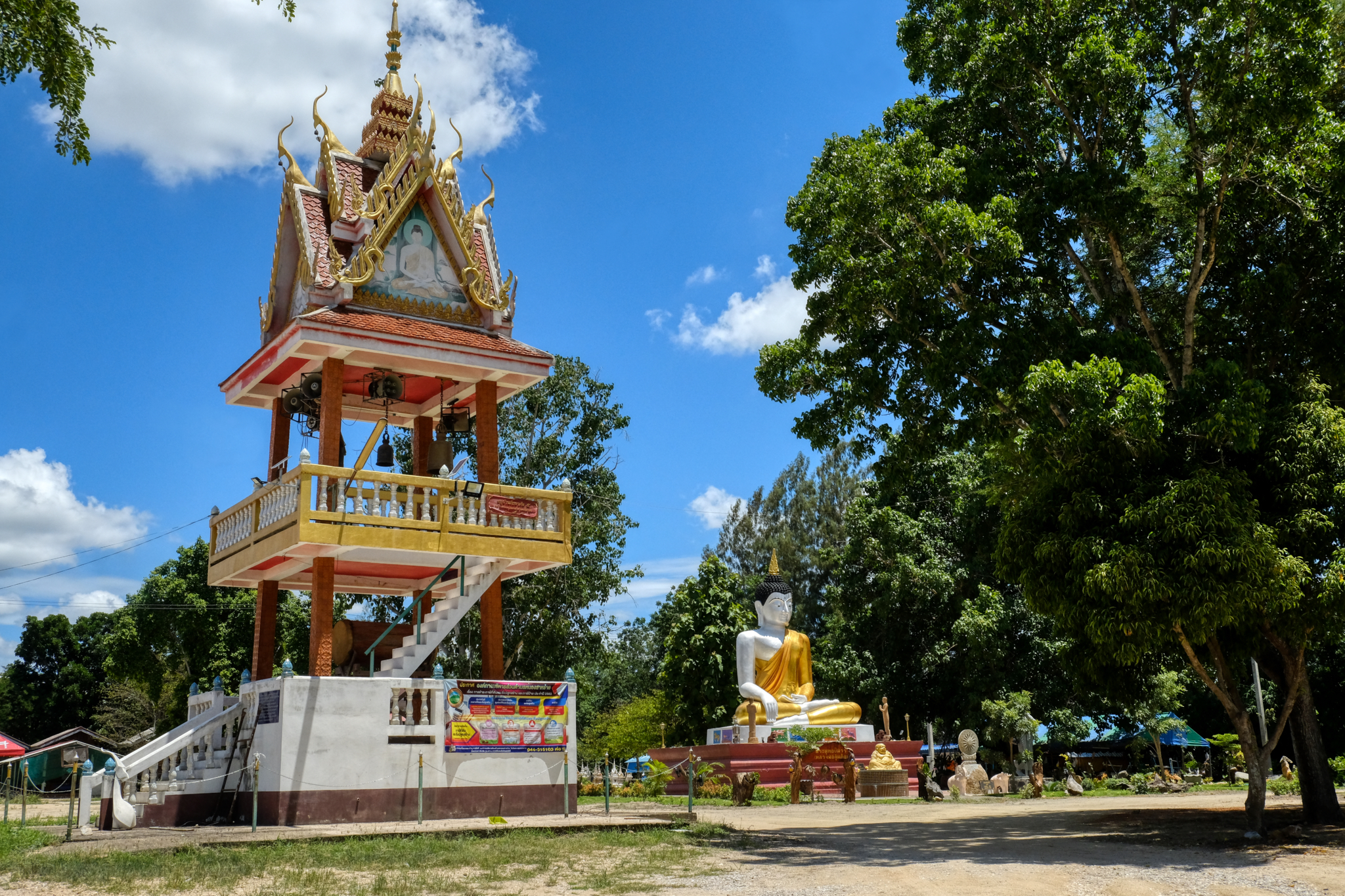 At another wat along a country lane . . . a bell and drum tower and very large outdoor Buddha.
At another wat along a country lane . . . a bell and drum tower and very large outdoor Buddha.
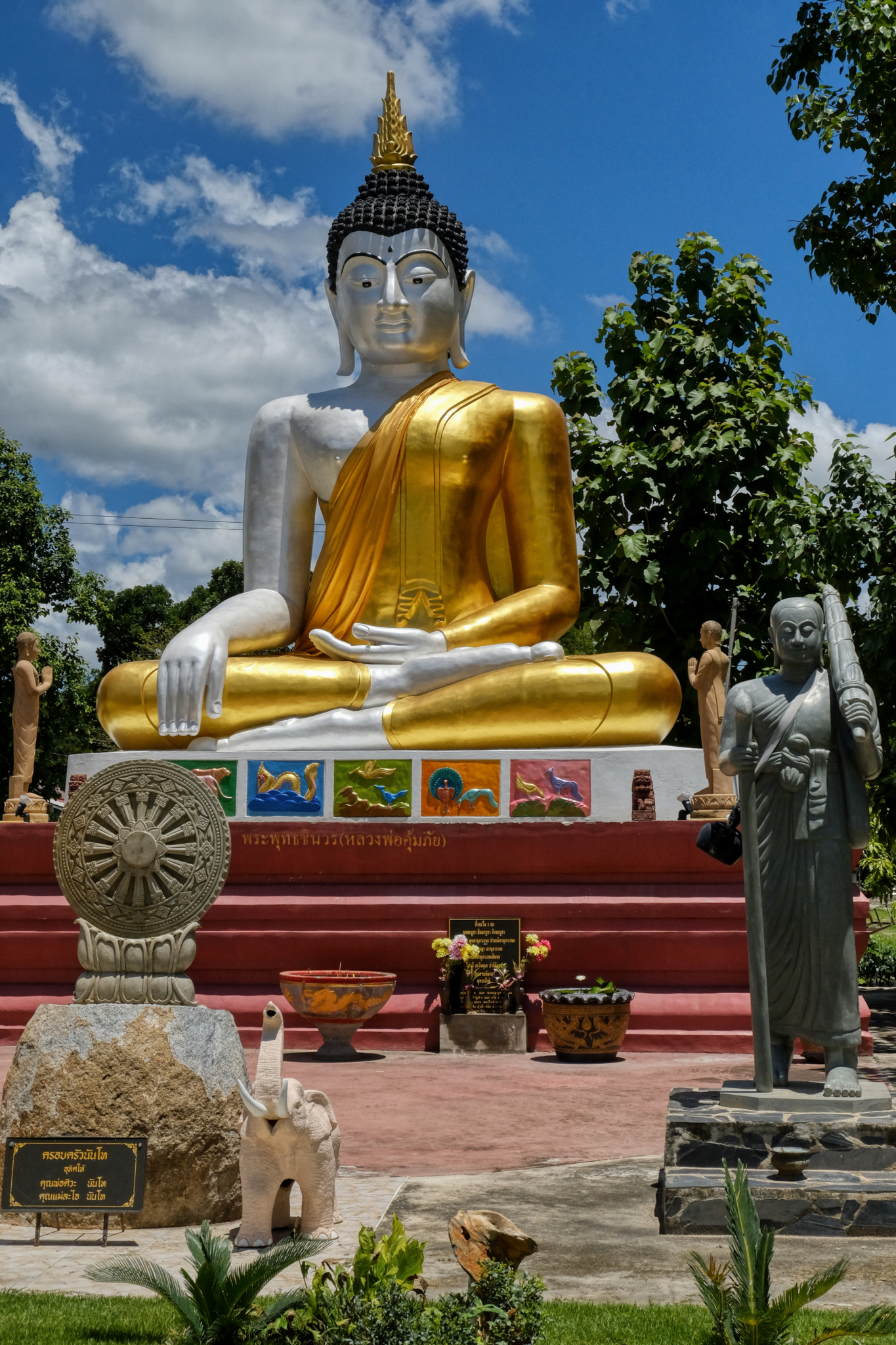 Such a serious-looking Buddha . . .
Such a serious-looking Buddha . . .
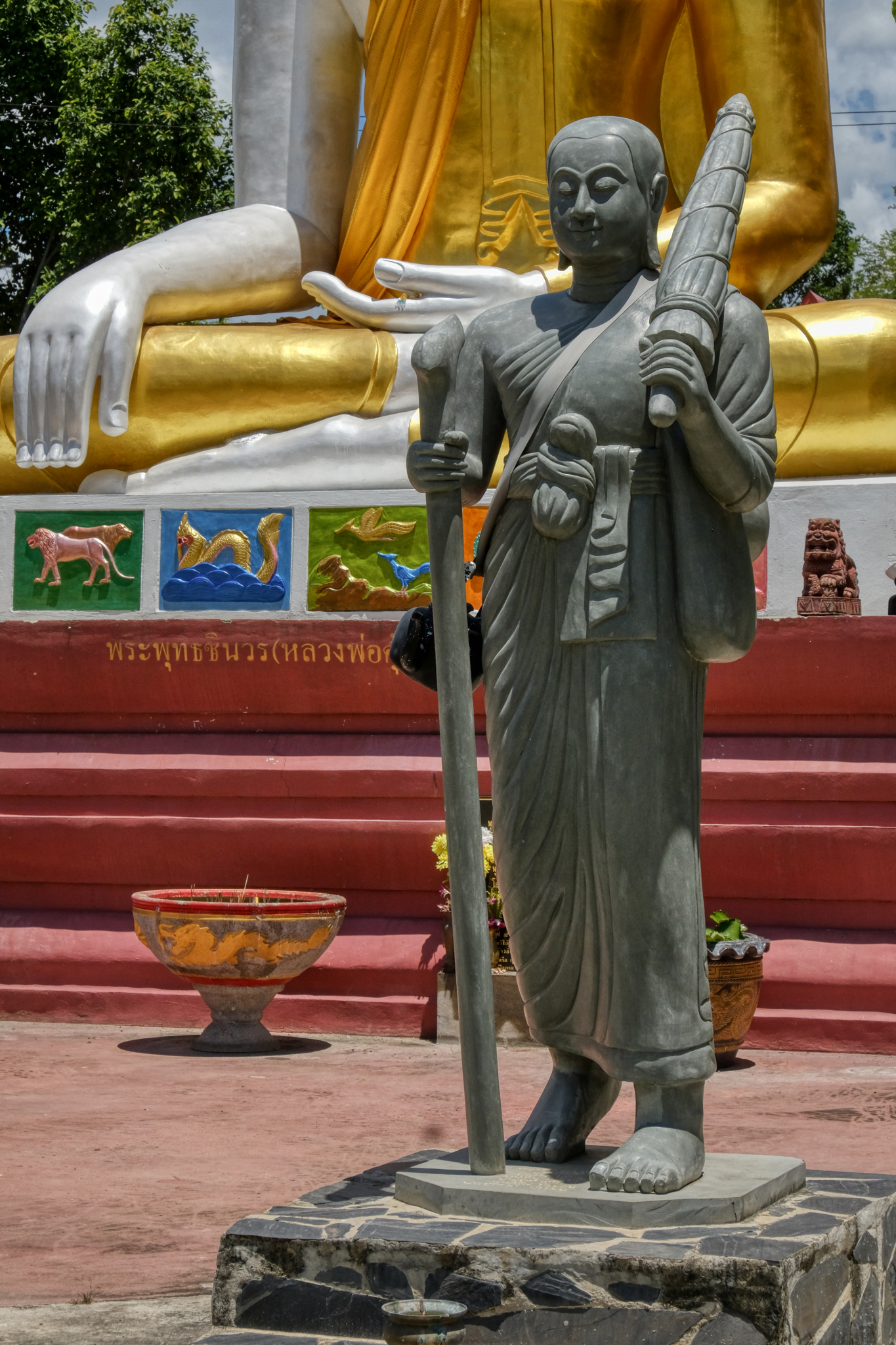 I loved this statue of the Buddha as a wondering monk . . . which he was.
I loved this statue of the Buddha as a wondering monk . . . which he was.
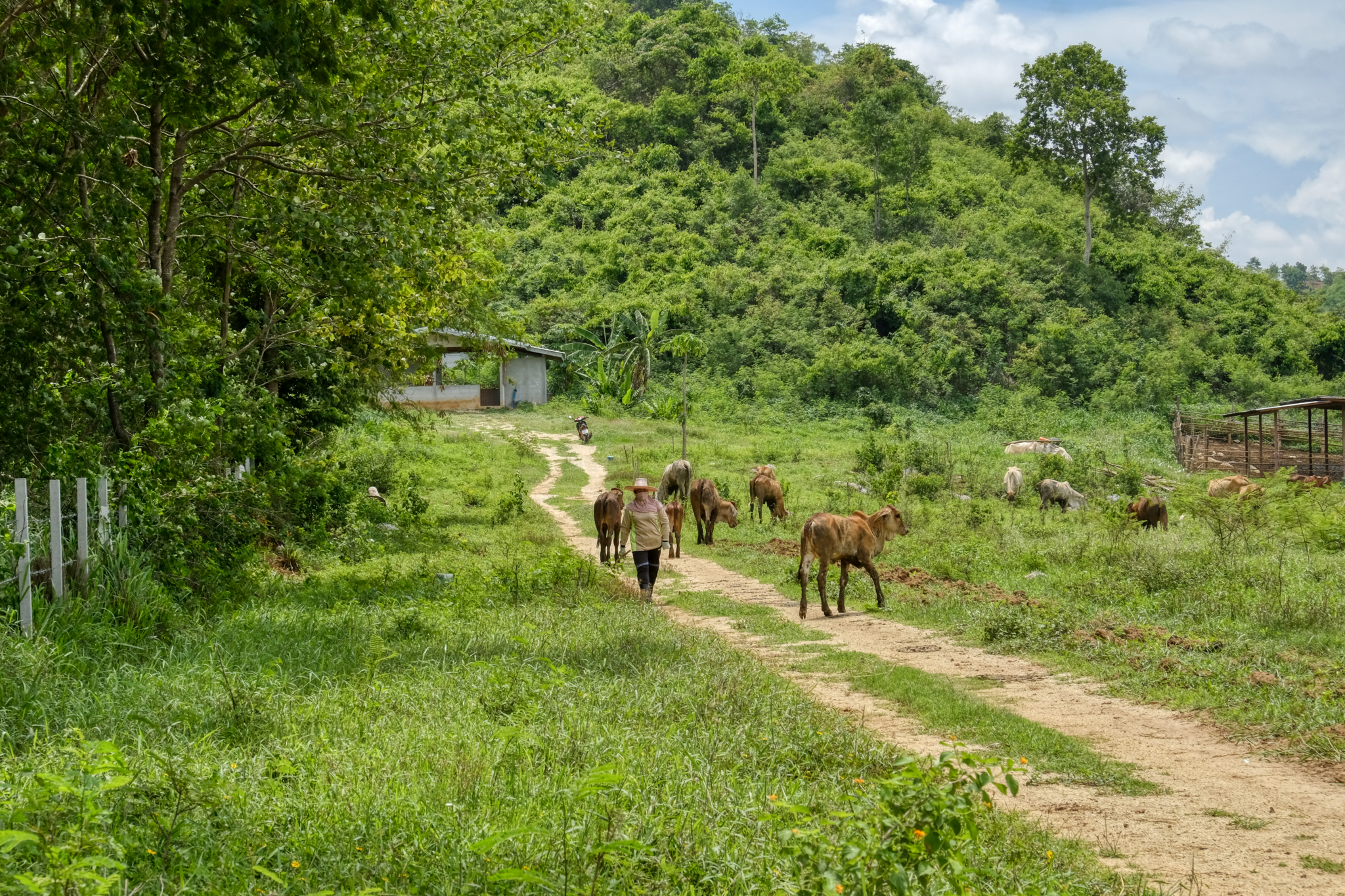 Sometimes my small rural lanes would come to a dead-end . . . as it did here in a farmers field.
Sometimes my small rural lanes would come to a dead-end . . . as it did here in a farmers field.
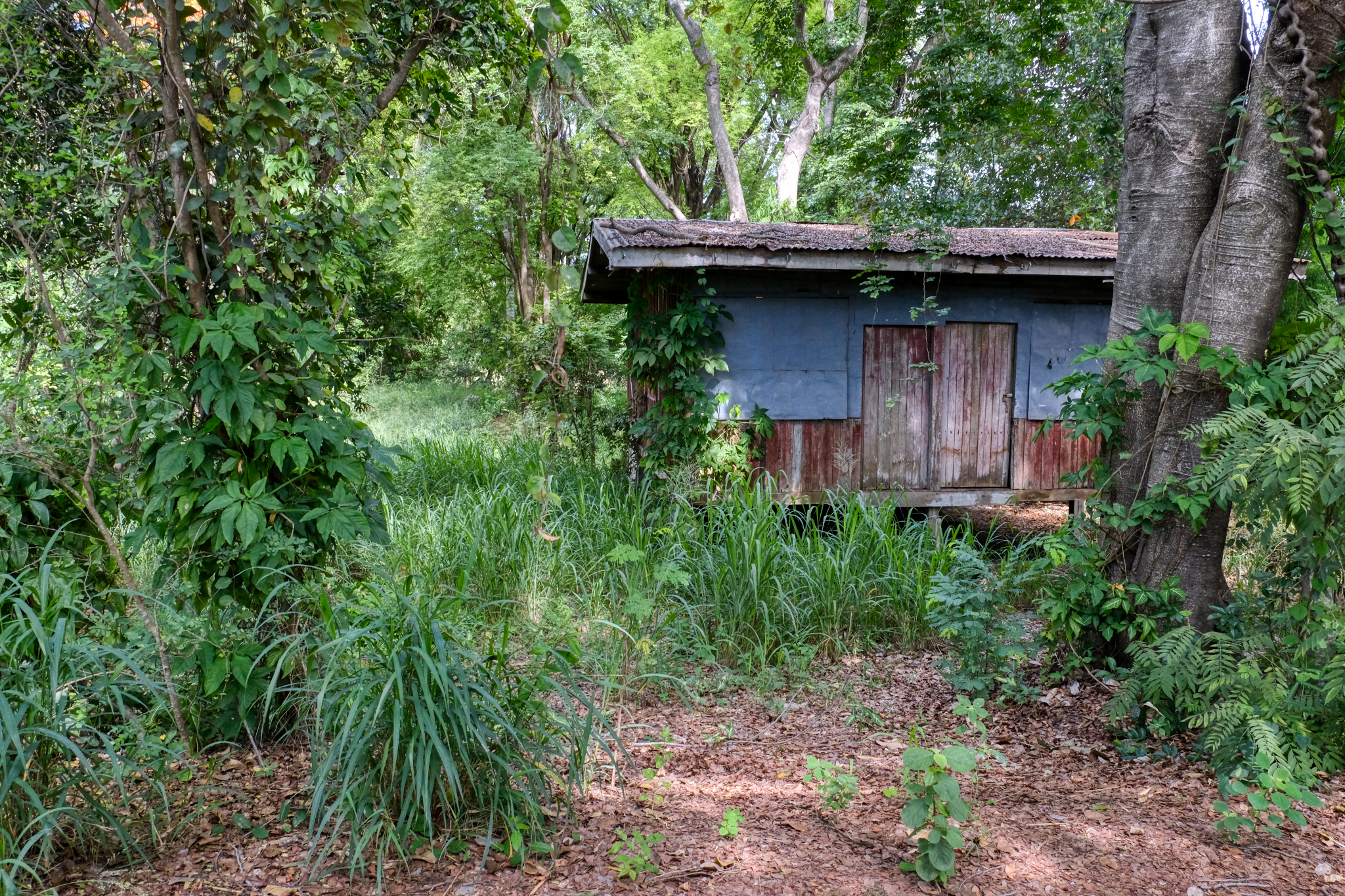 Many small work sheds dot the agricultural landscape in this part of Thailand.
Many small work sheds dot the agricultural landscape in this part of Thailand.
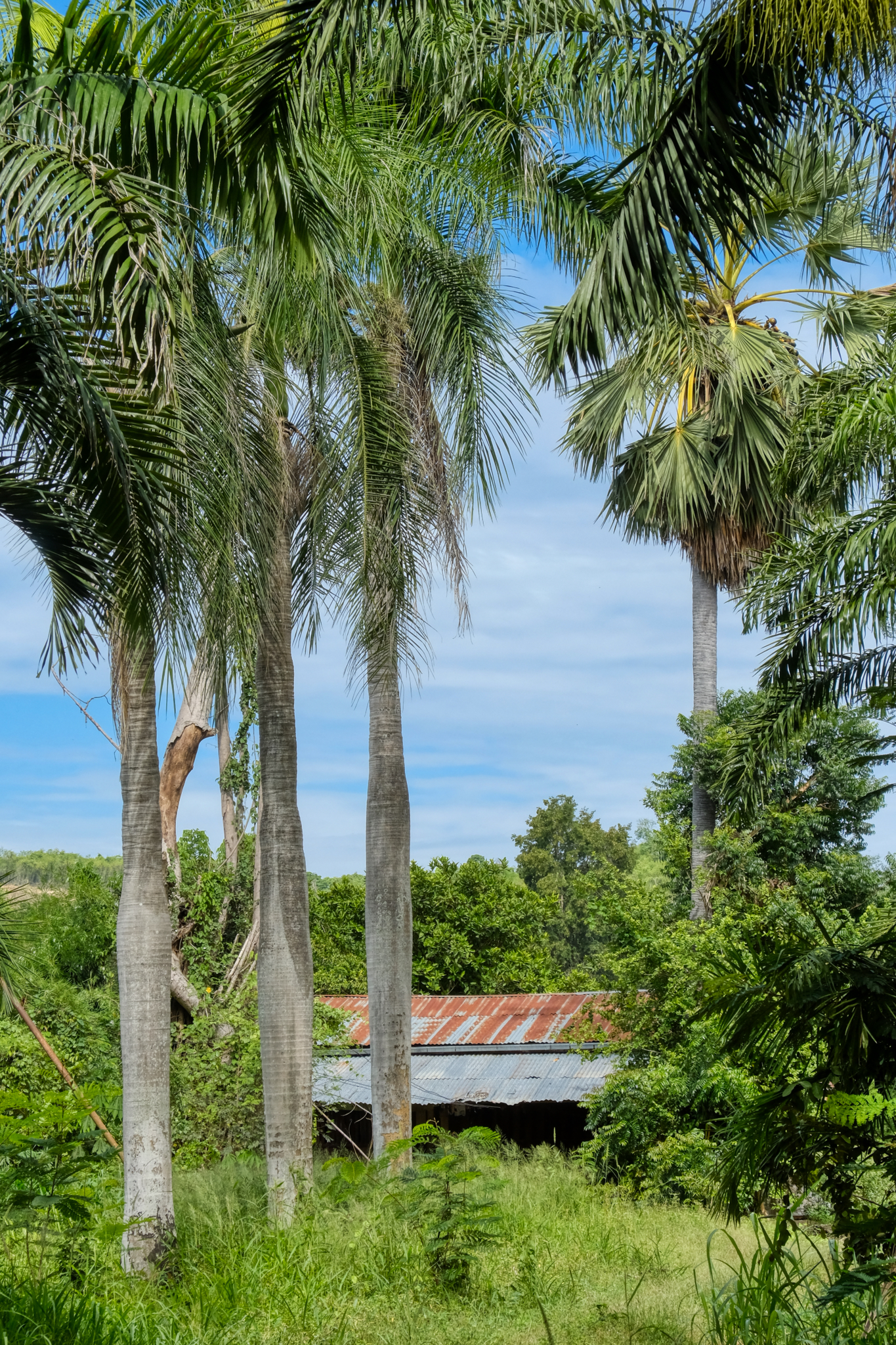 It was a beautiful day to be out rambling in the Thai countryside.
It was a beautiful day to be out rambling in the Thai countryside.
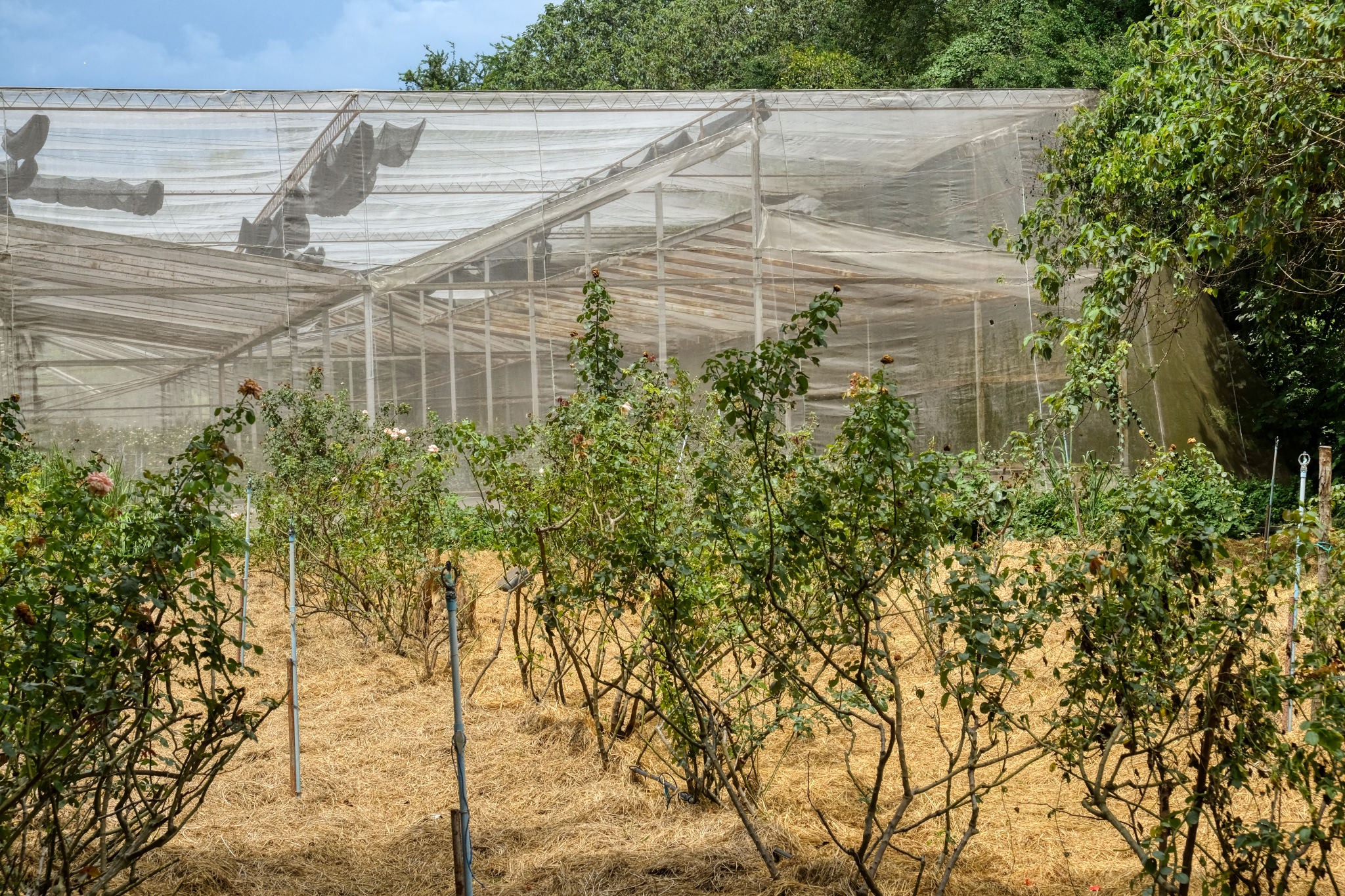 I stumbled upon this big greenhouse operation raising roses. Big agribusiness out in the deep forest.
I stumbled upon this big greenhouse operation raising roses. Big agribusiness out in the deep forest.
 A bamboo pump house.
A bamboo pump house.
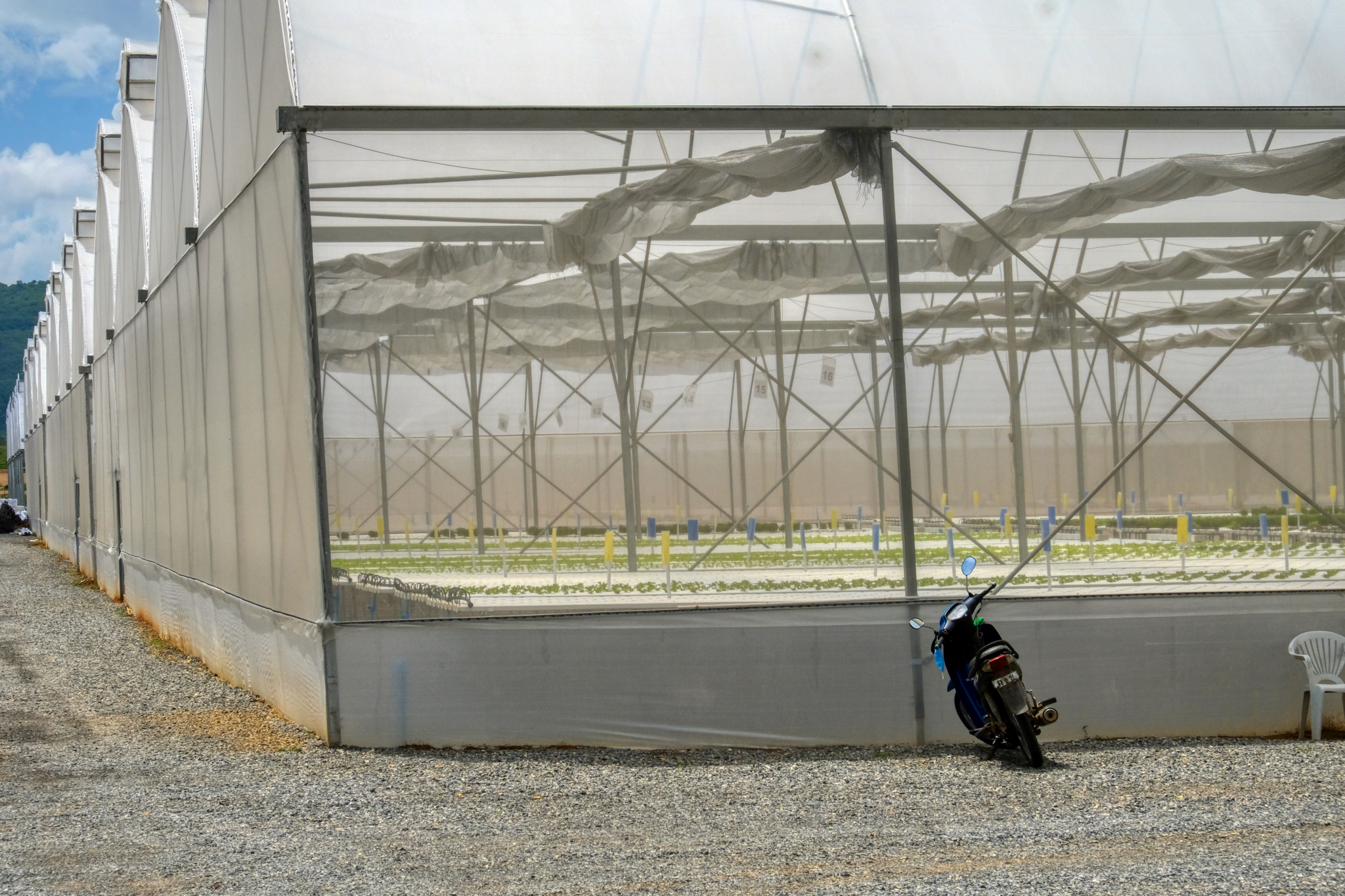 More rural agribusiness . . . lettuce.
More rural agribusiness . . . lettuce.
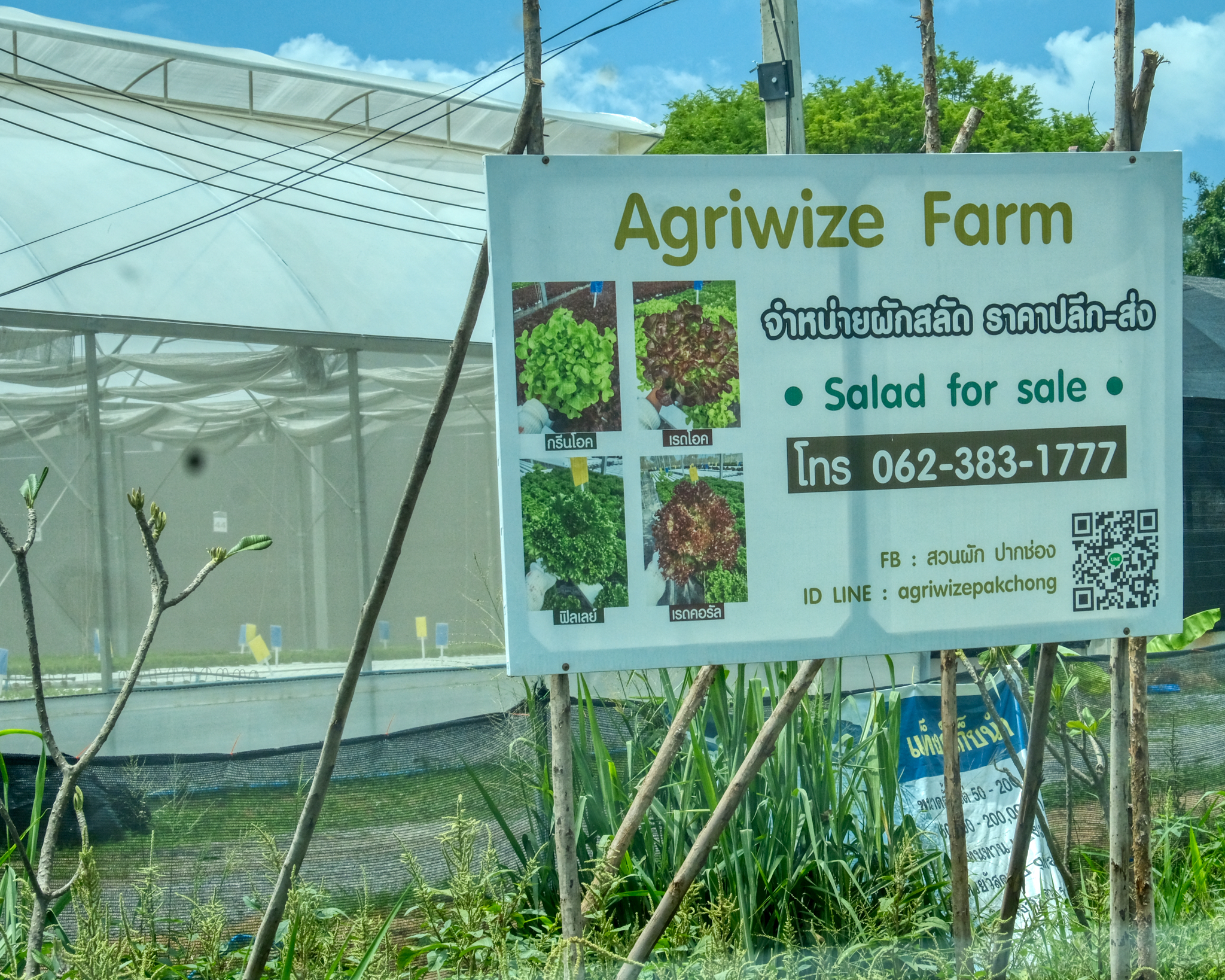 Being only 3 hours to a city of 13 million people, this kind of big agribusiness was to be expected.
Being only 3 hours to a city of 13 million people, this kind of big agribusiness was to be expected.
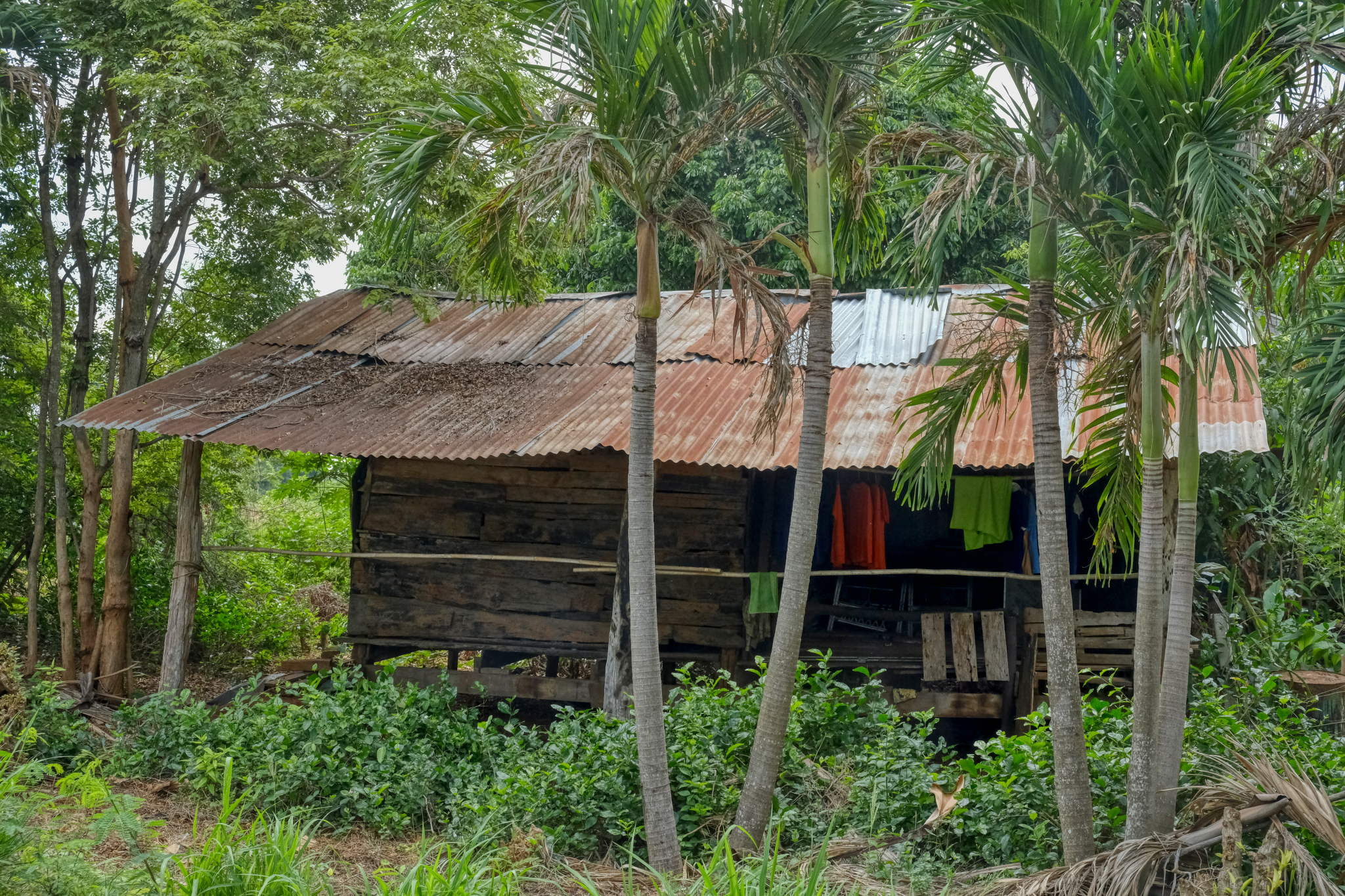 This old teakwood shack was occupied . . . rural splendor?
This old teakwood shack was occupied . . . rural splendor?
-----------------------------------------------------------------------------------------------------------------
WAT PA PHROM PRATHAN
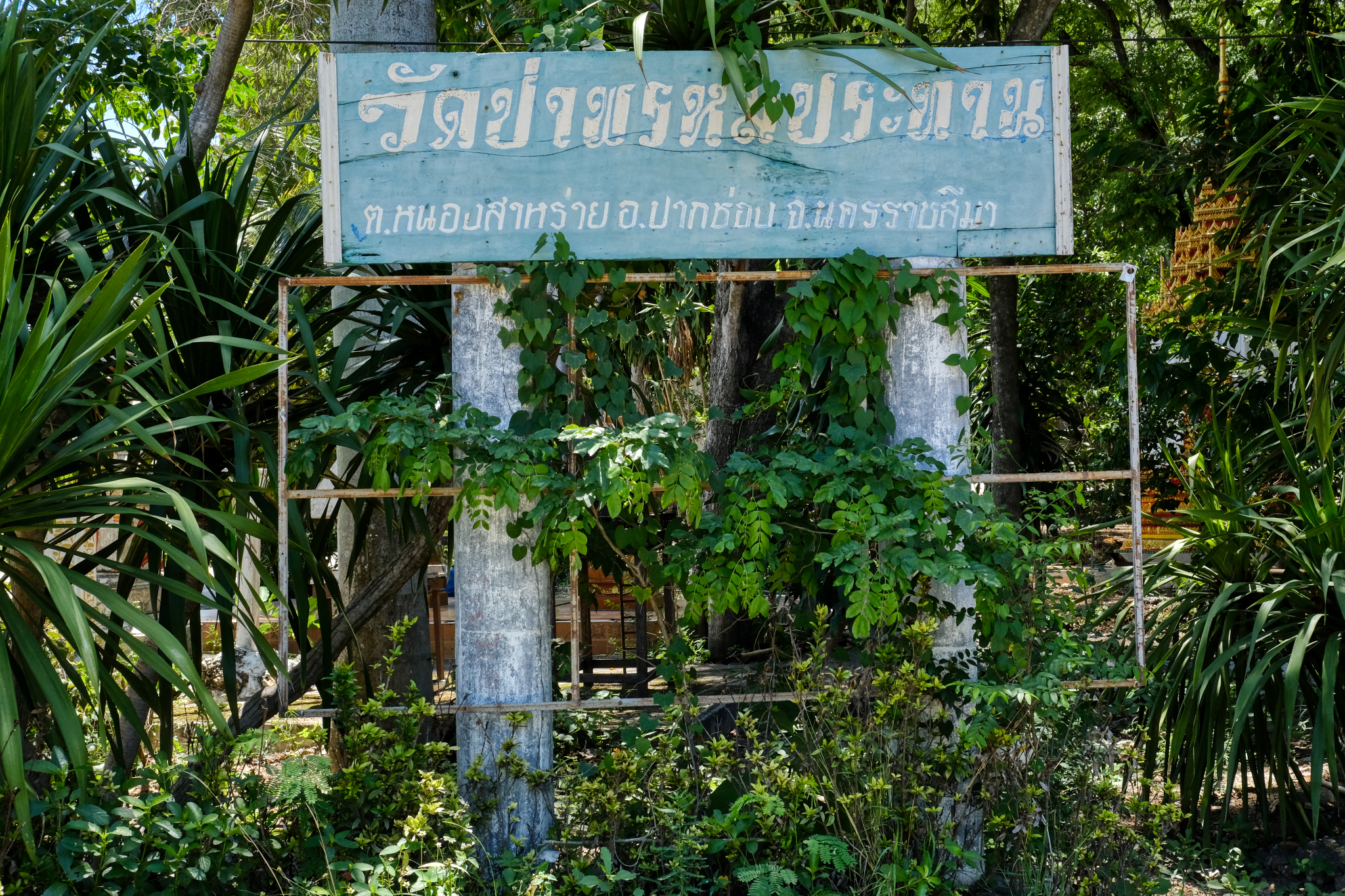 This small sign caught my eye . . . It must be a wat . . .
This small sign caught my eye . . . It must be a wat . . .
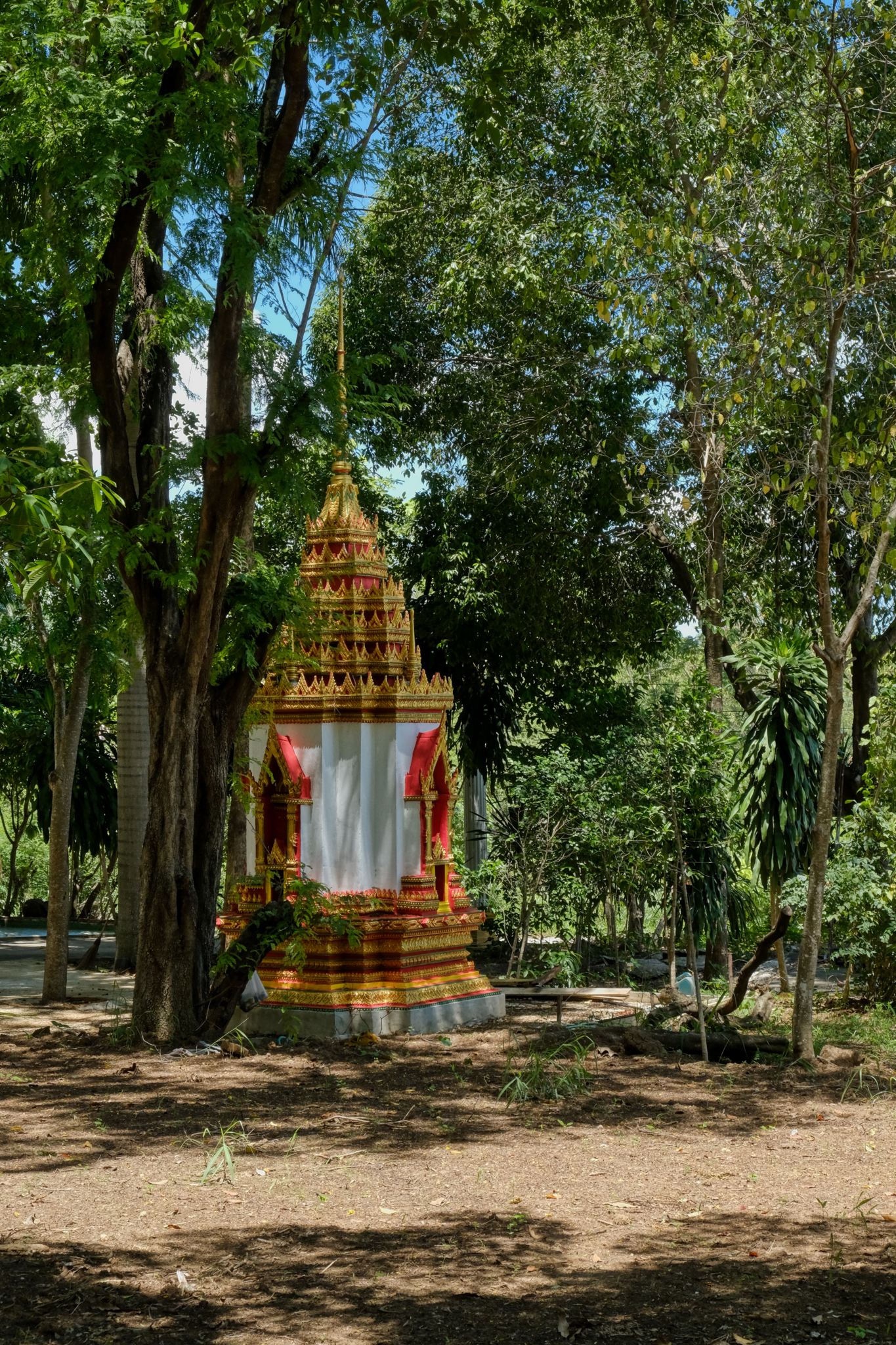 While driving into the wat grounds I did not notice anything unusual at first.
While driving into the wat grounds I did not notice anything unusual at first.
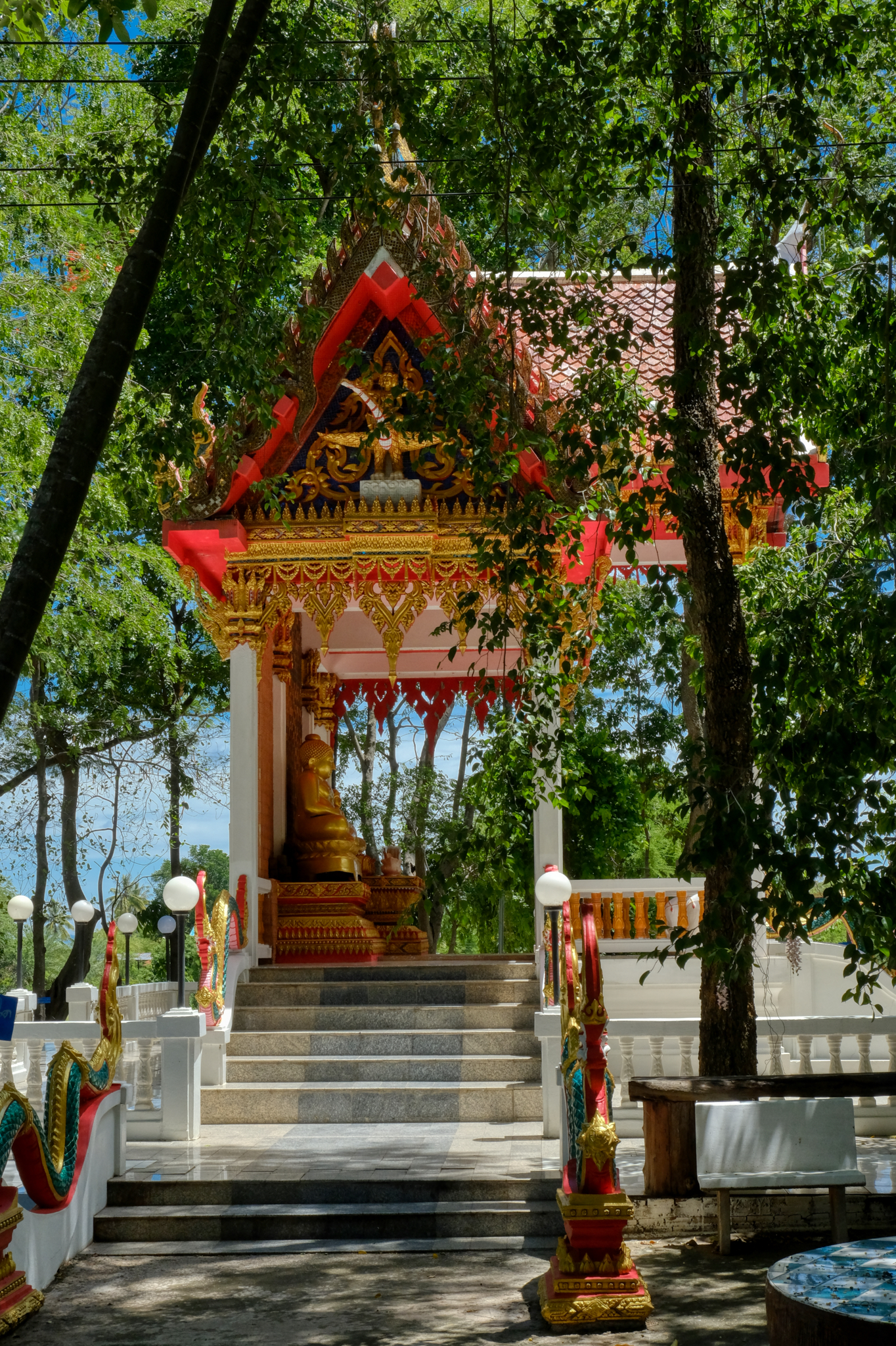 For such a deeply rural wat in a forested area, the salas and monuments seemed especially wonderful.
For such a deeply rural wat in a forested area, the salas and monuments seemed especially wonderful.
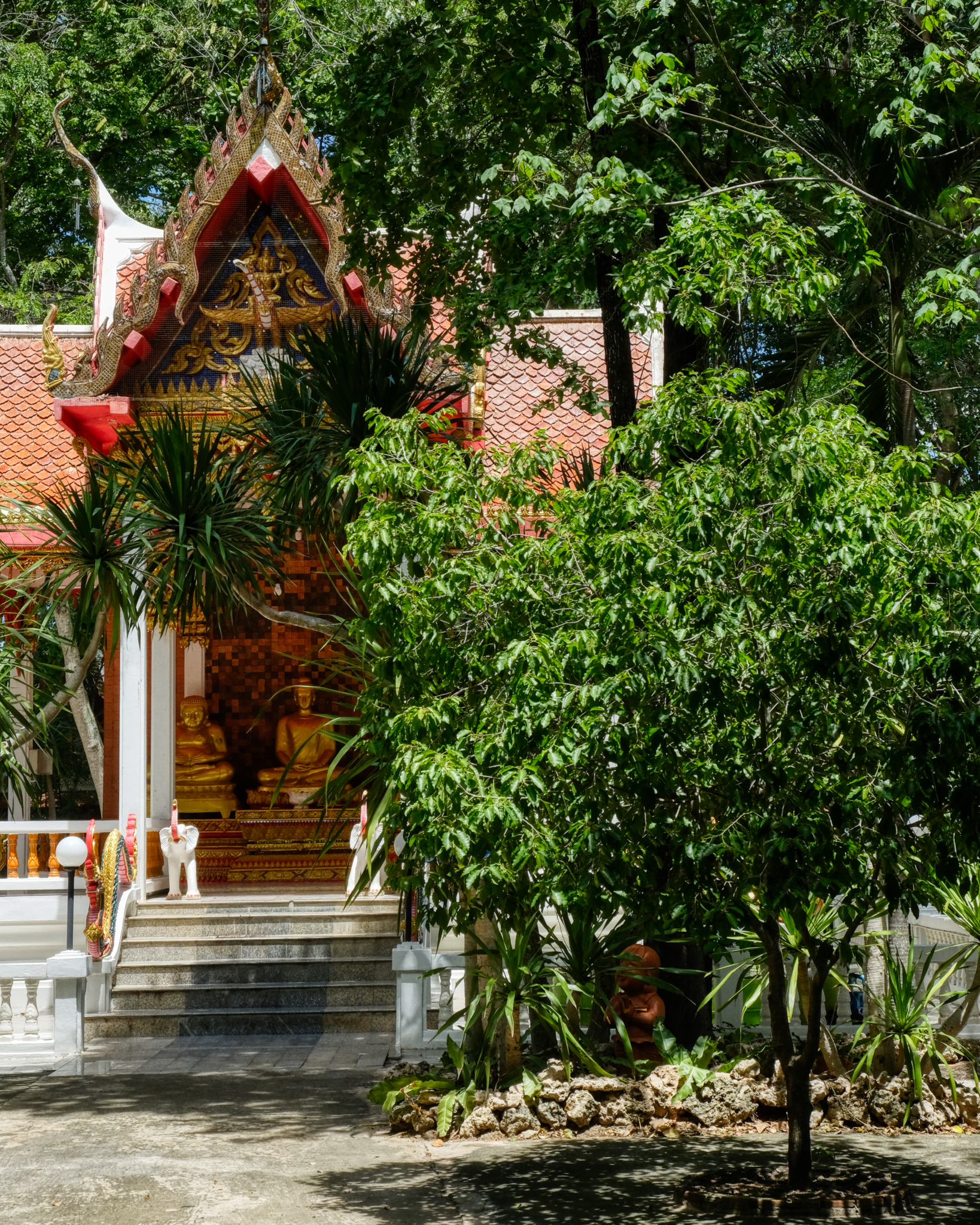 Such a wonderful Buddha sala . . .
Such a wonderful Buddha sala . . .
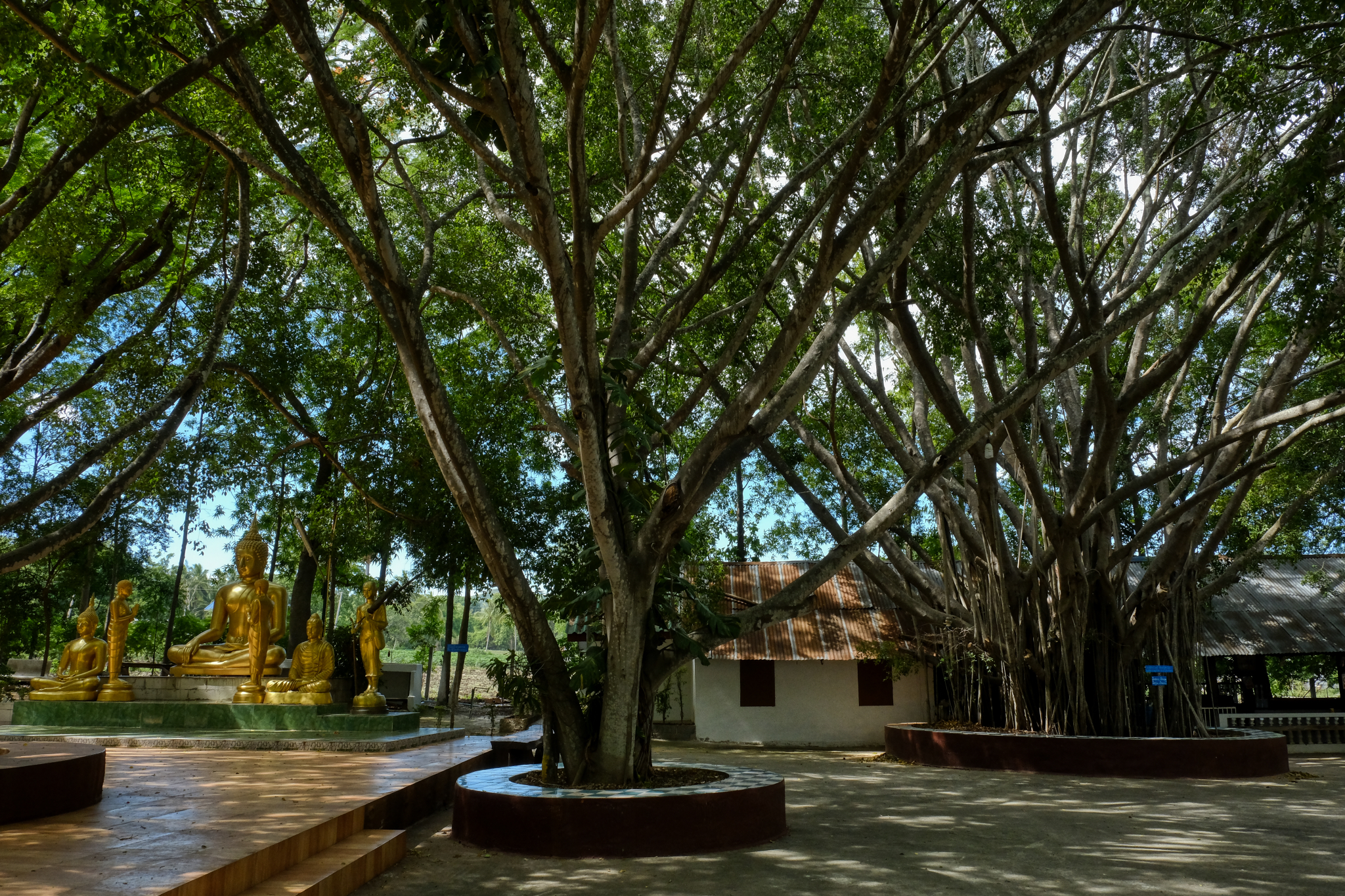 I found a place to park and as I stepped out of the car this is what I saw! Remarkable!
I found a place to park and as I stepped out of the car this is what I saw! Remarkable!
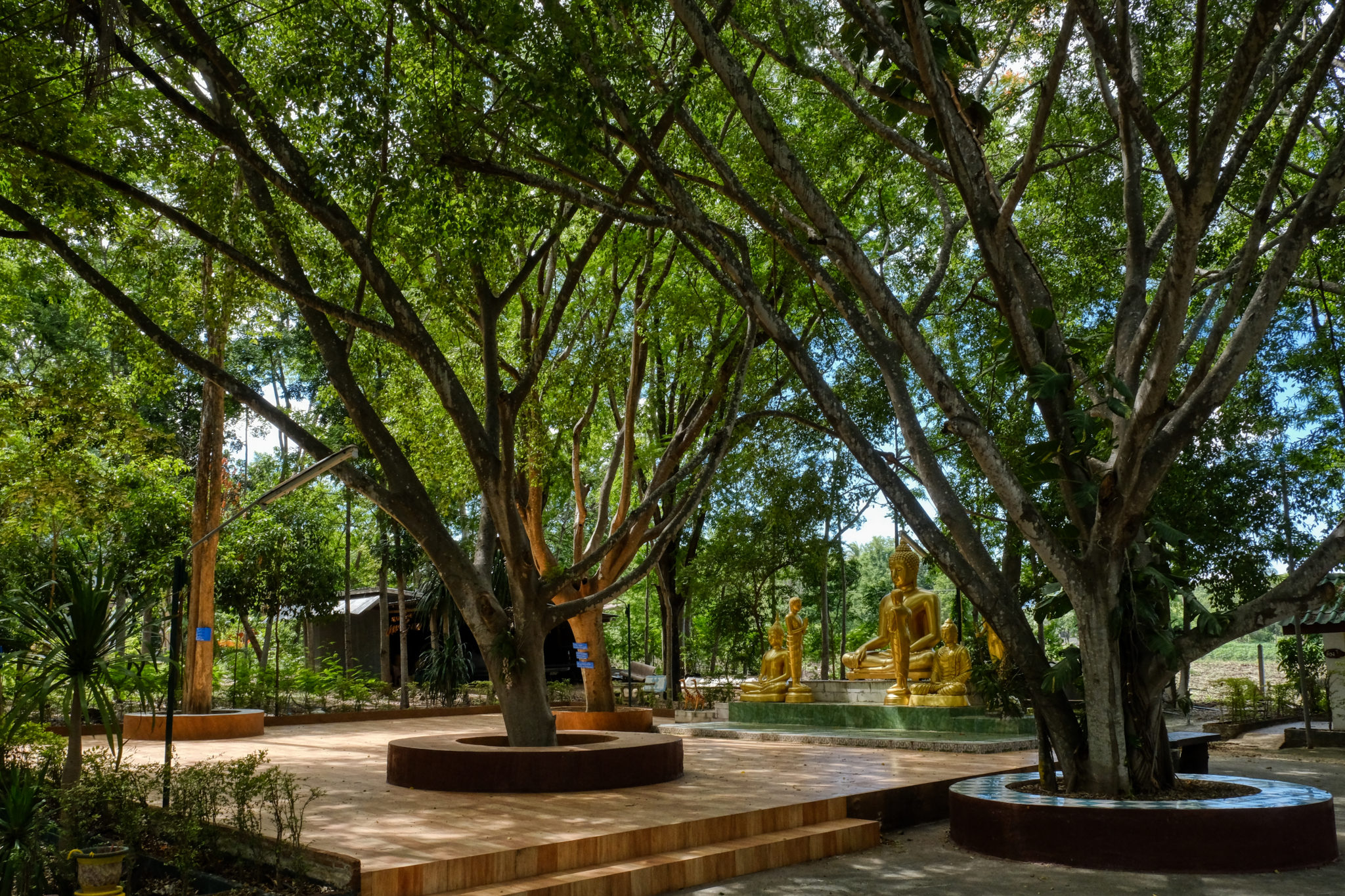 There was a powerful spiritual presence in this place.
There was a powerful spiritual presence in this place.
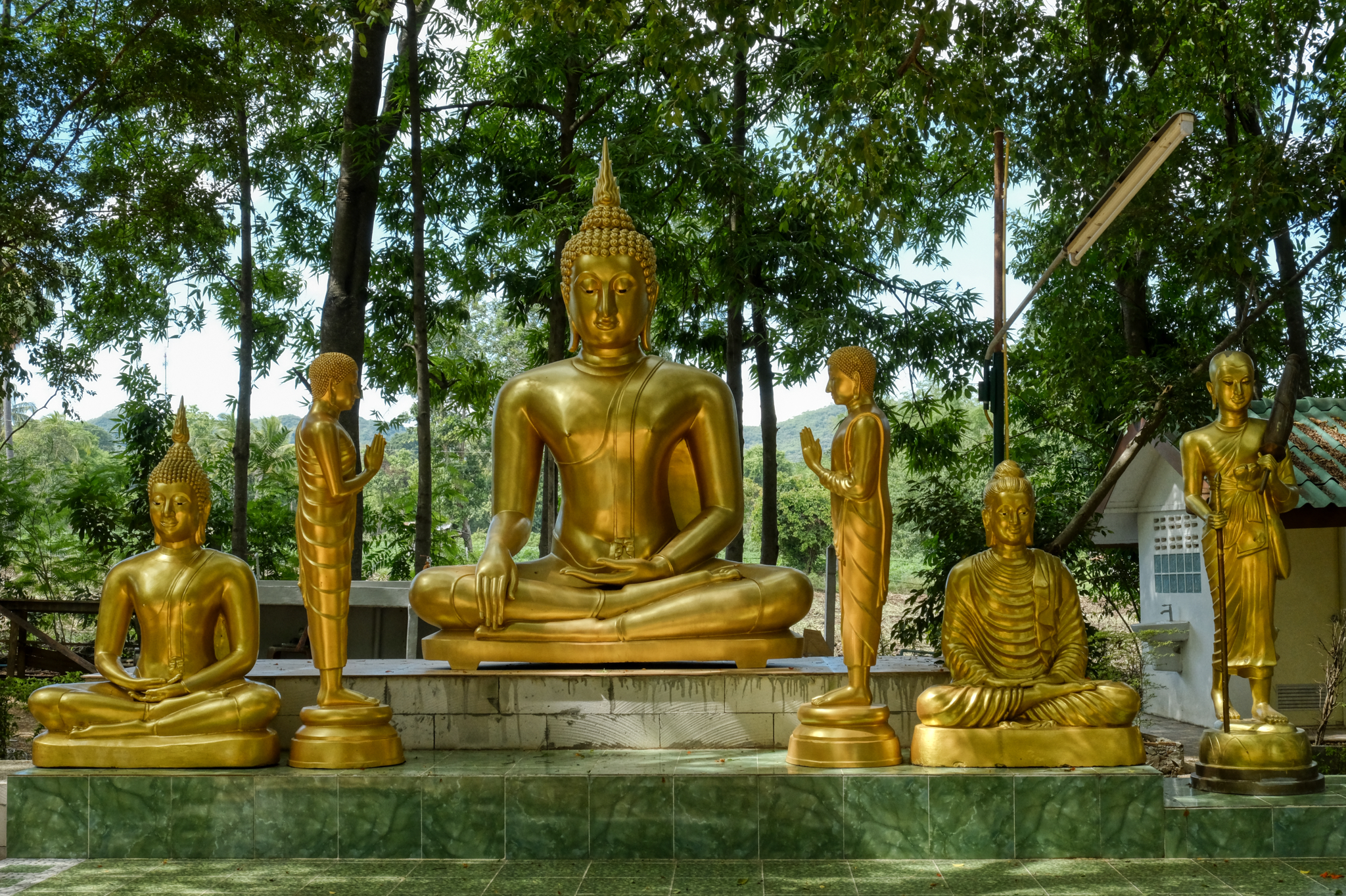 I sat here for quite awhile . . . and lost myself . . .
I sat here for quite awhile . . . and lost myself . . .
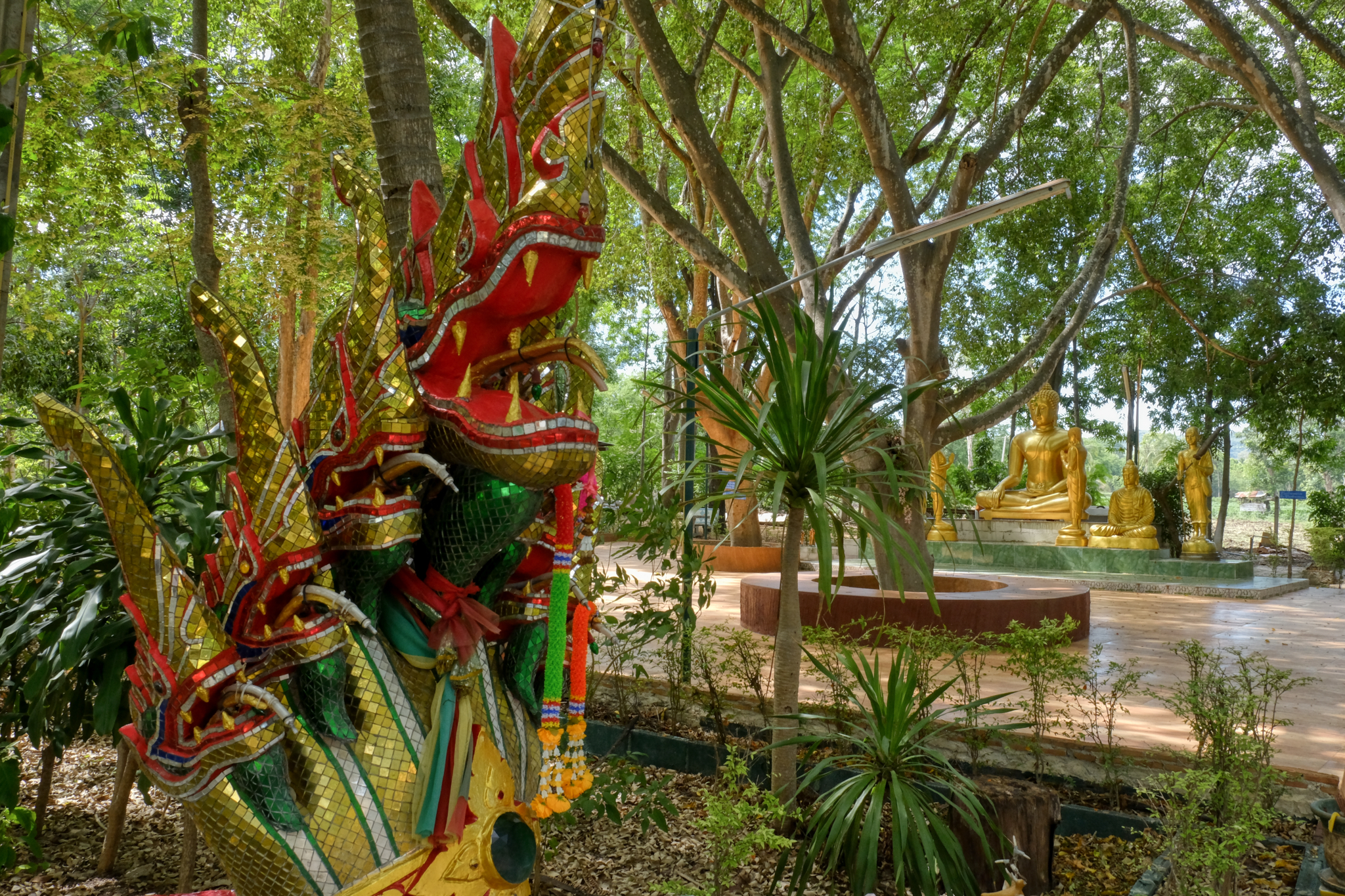 After sitting . . . I went for a walk to appreciate the spiritual environment I had fortunately found.
After sitting . . . I went for a walk to appreciate the spiritual environment I had fortunately found.
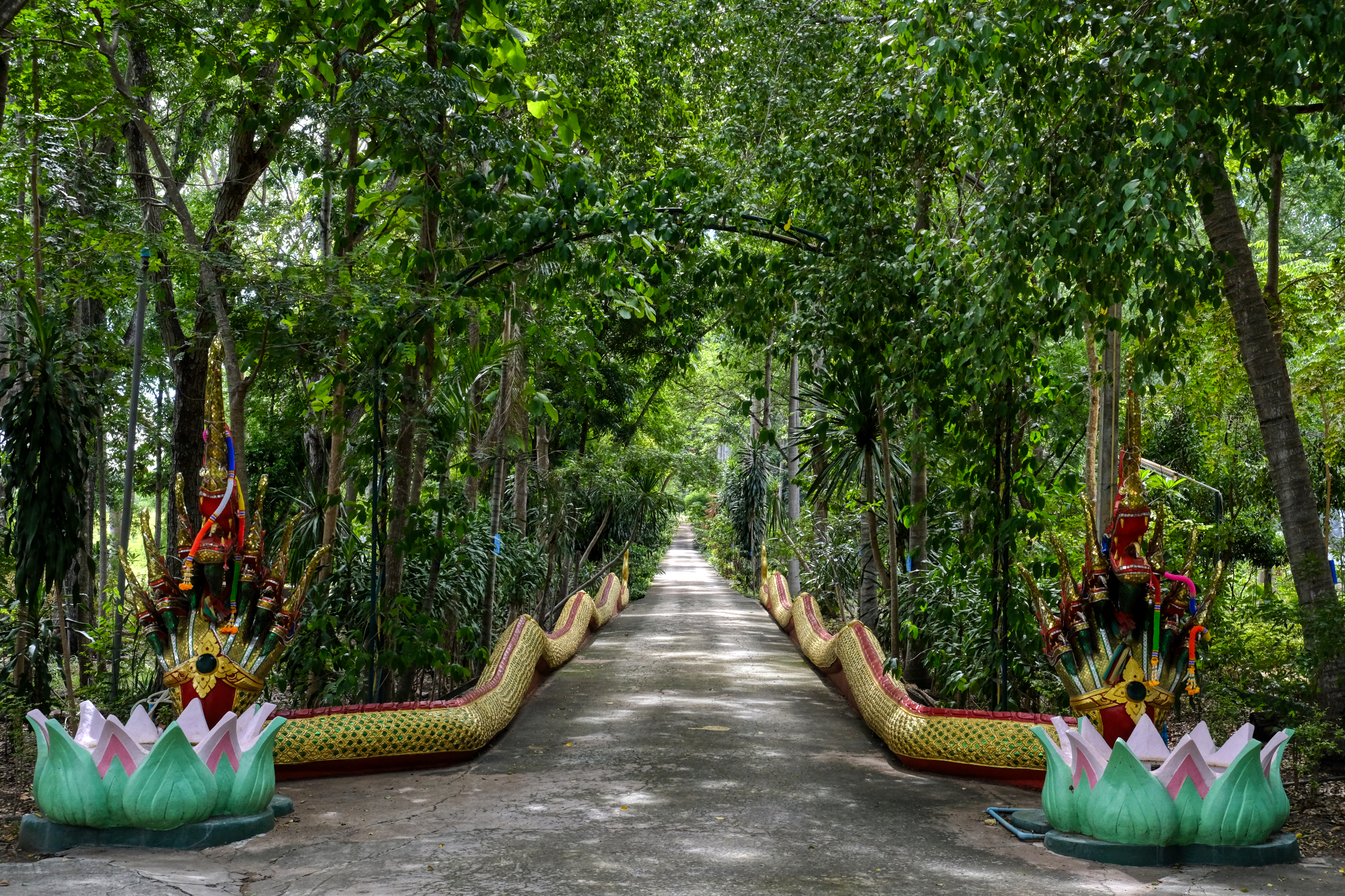 When I spotted this inviting road, I had to find out what was up there . . .
When I spotted this inviting road, I had to find out what was up there . . .
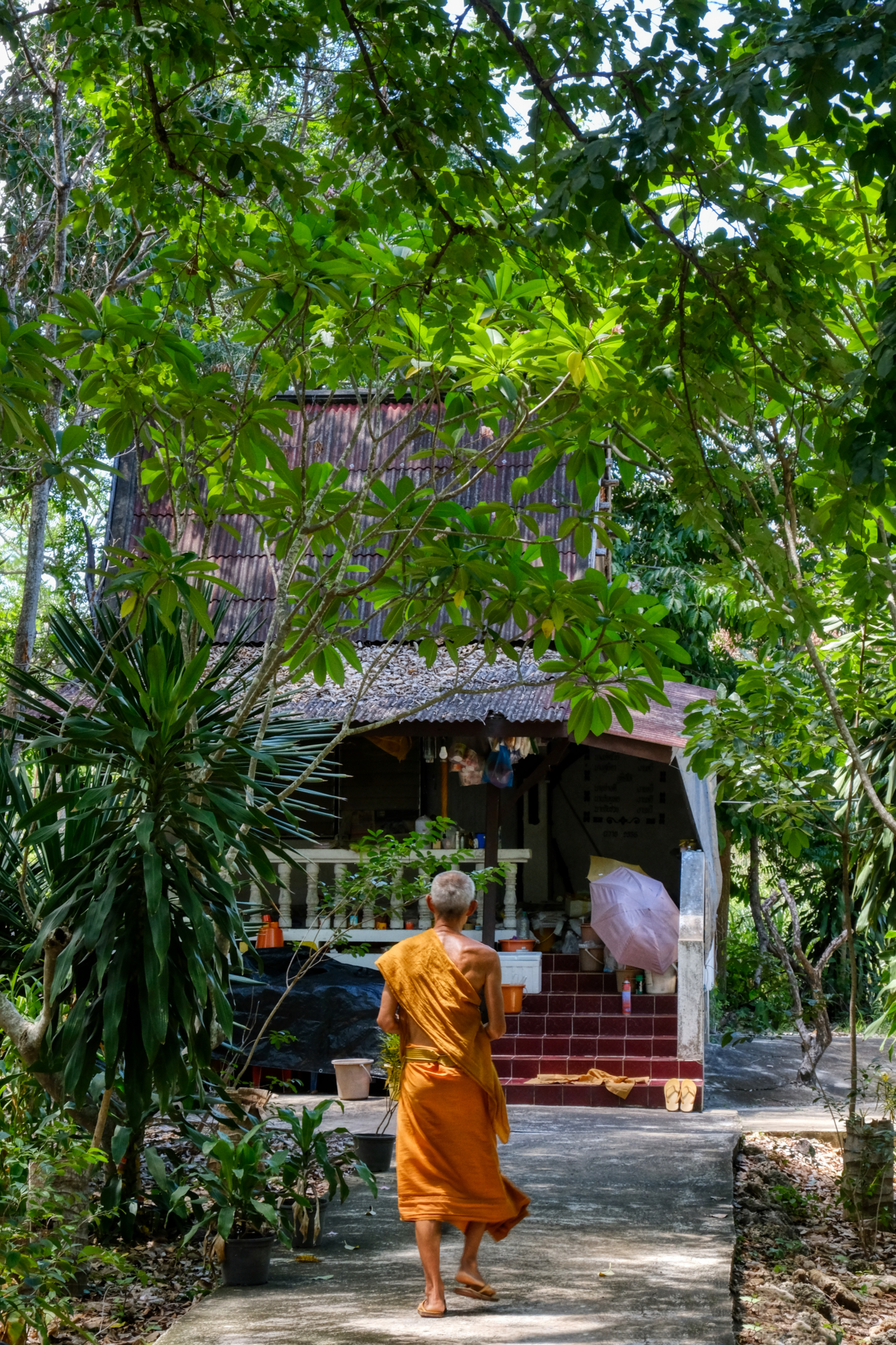 What I found at first were several very sweet monks' houses set in the trees.
What I found at first were several very sweet monks' houses set in the trees.
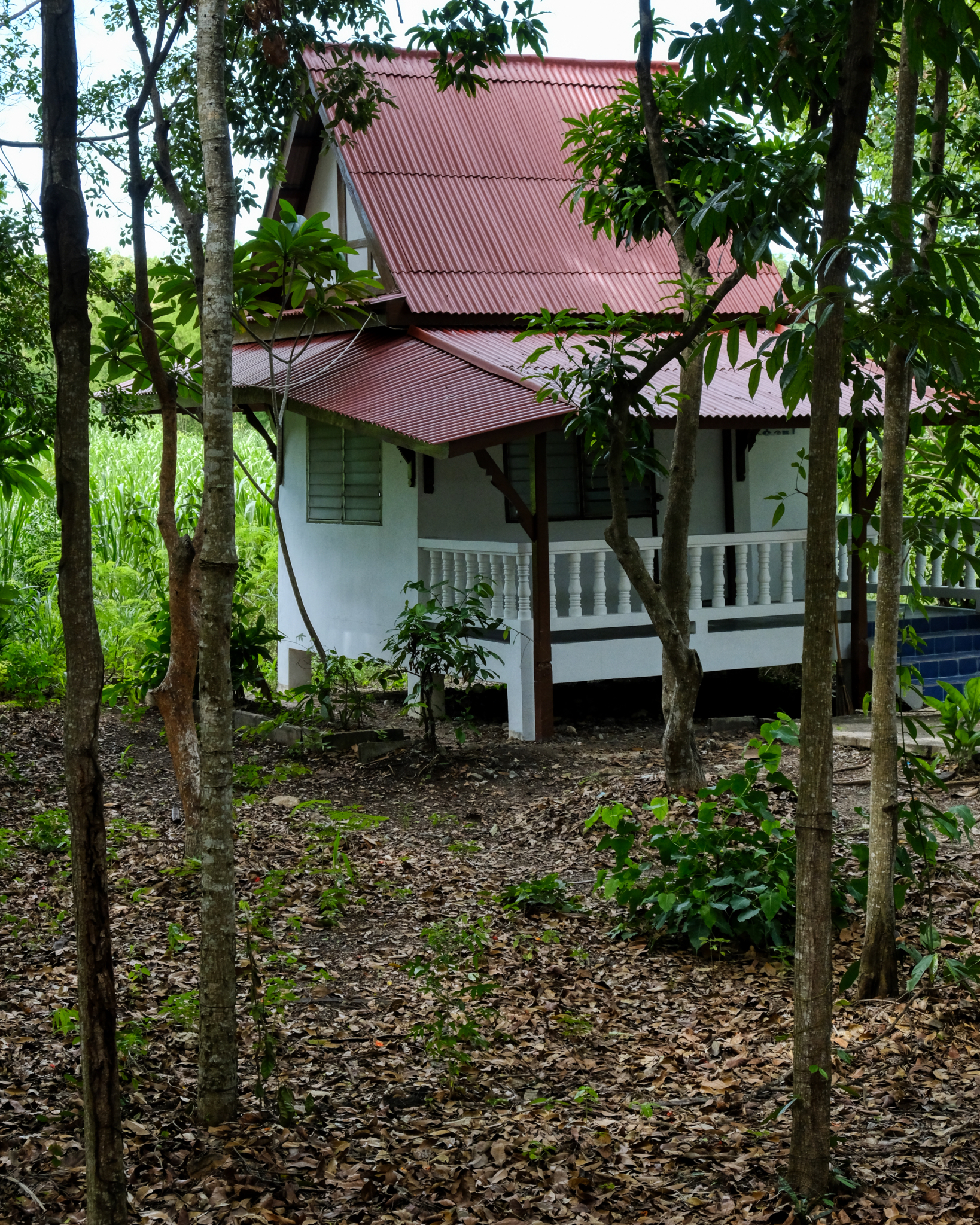 A simple, but attractive, monks quarters.
A simple, but attractive, monks quarters.
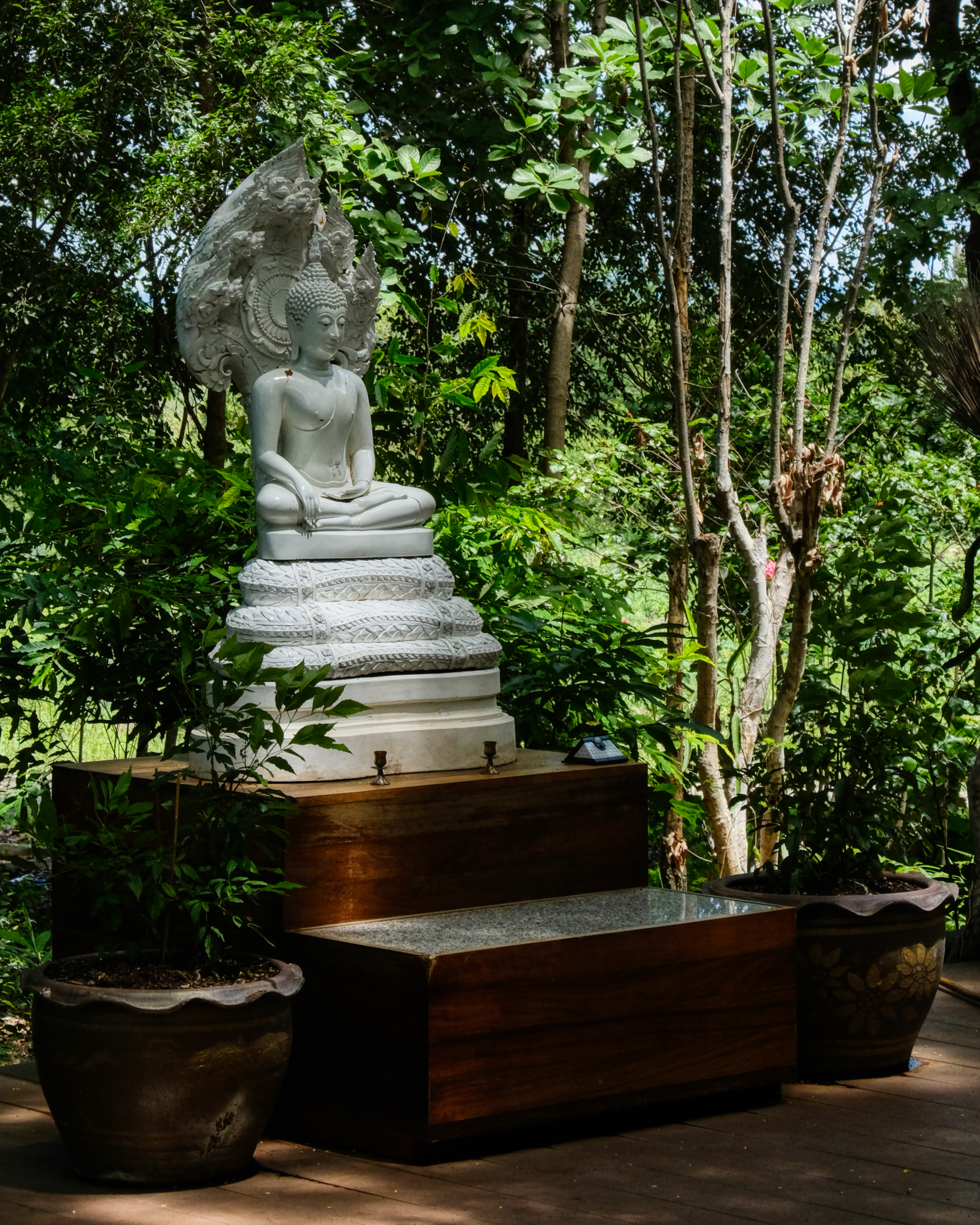 This remarkable Buddha was outside one of the modest monk's quarters.
This remarkable Buddha was outside one of the modest monk's quarters.
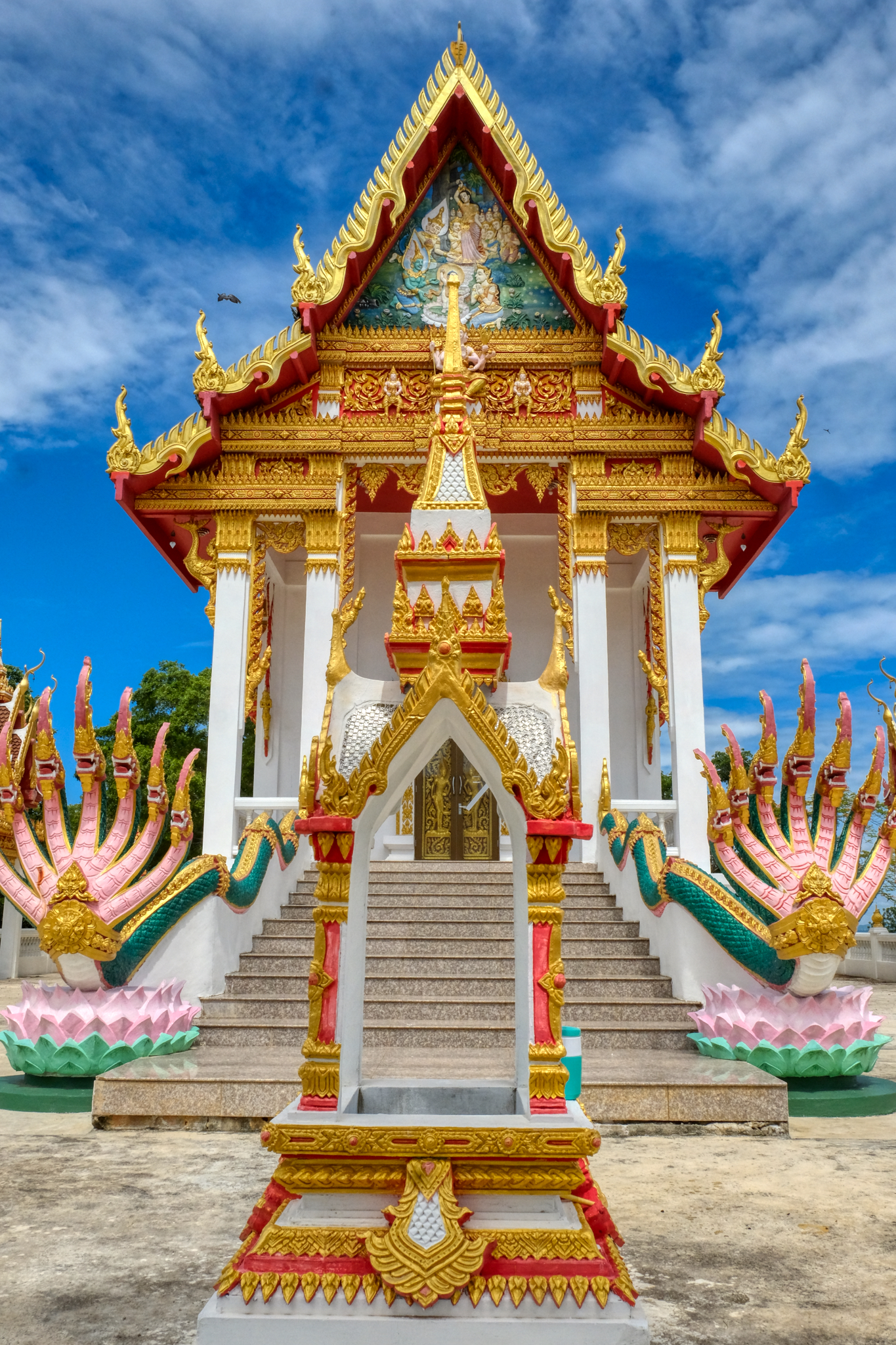 My long walk up the hill was rewarded with this view of a new wat building nearing completion. A brand new Thai Buddhist Temple, Wat PA Phrom Prathan.
My long walk up the hill was rewarded with this view of a new wat building nearing completion. A brand new Thai Buddhist Temple, Wat PA Phrom Prathan.
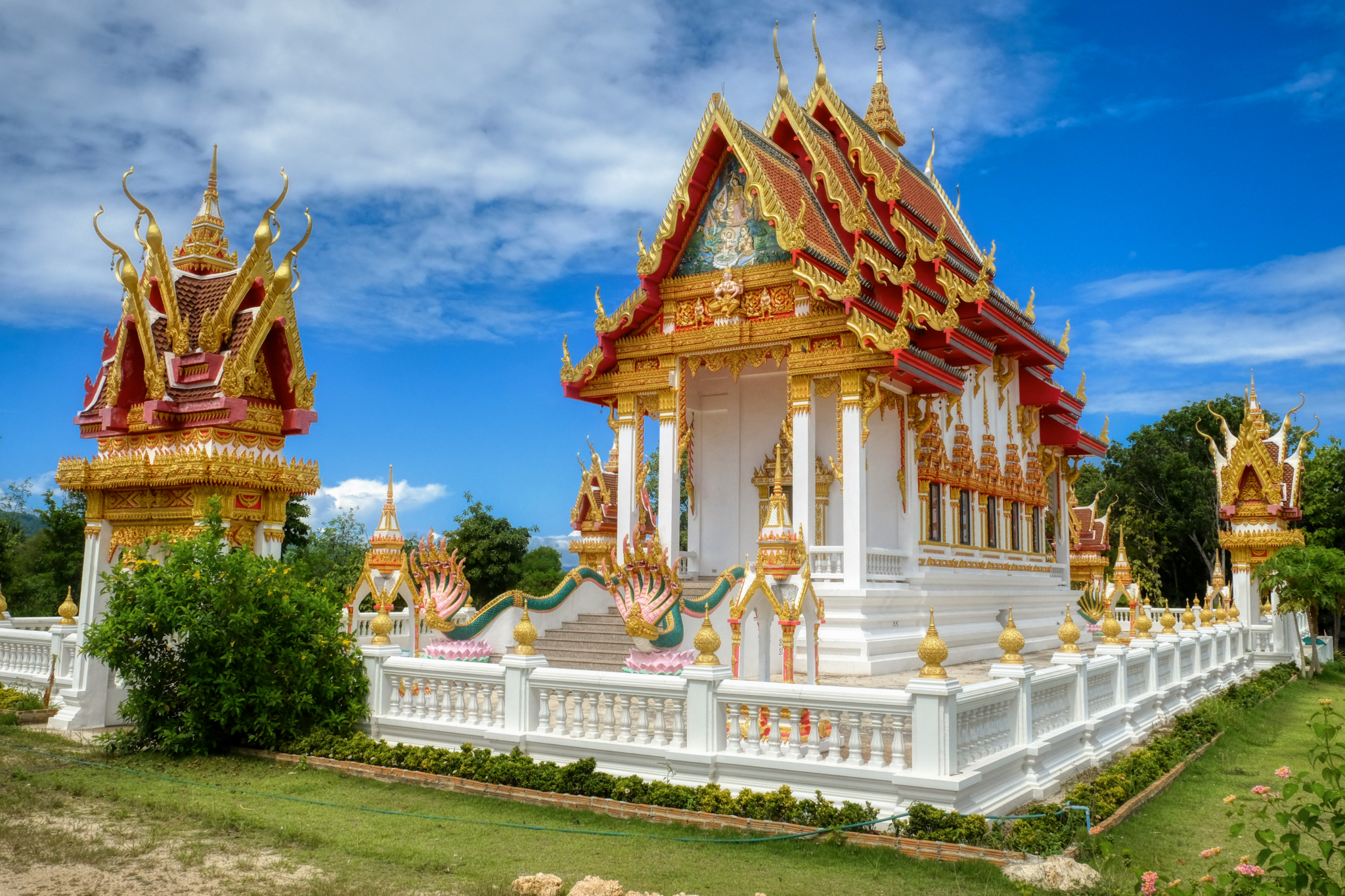 The new wat sat high on a hill over the valley. I walked around the site several times marveling at its fresh, pristine beauty.
The new wat sat high on a hill over the valley. I walked around the site several times marveling at its fresh, pristine beauty.
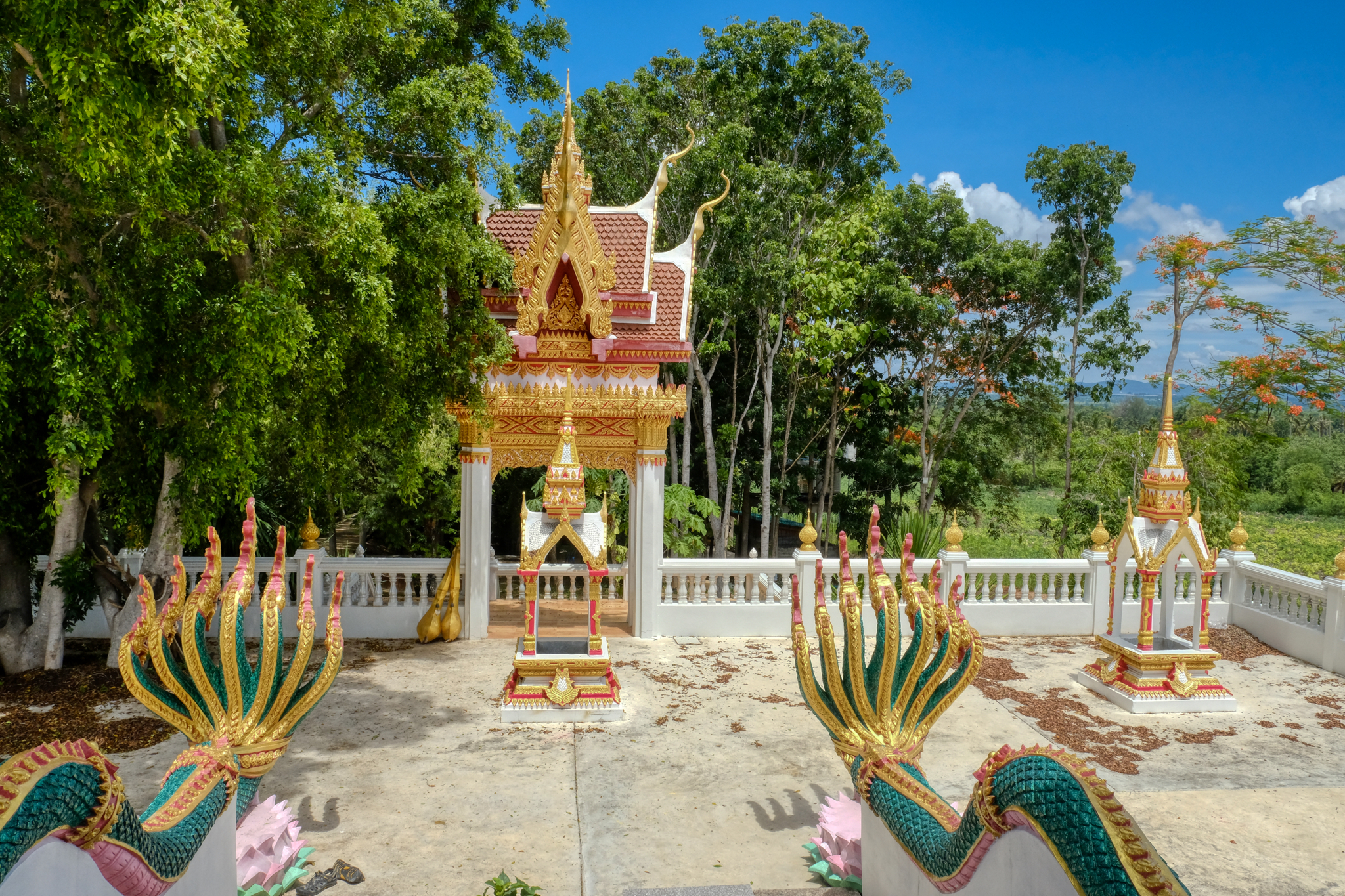 I noticed that the inner spaces of the wat were not swept or tiled . . . I knew this meant that they had not officially moved in . . . they were still working on it. The door was ajar, so I peaked in . . .
I noticed that the inner spaces of the wat were not swept or tiled . . . I knew this meant that they had not officially moved in . . . they were still working on it. The door was ajar, so I peaked in . . .
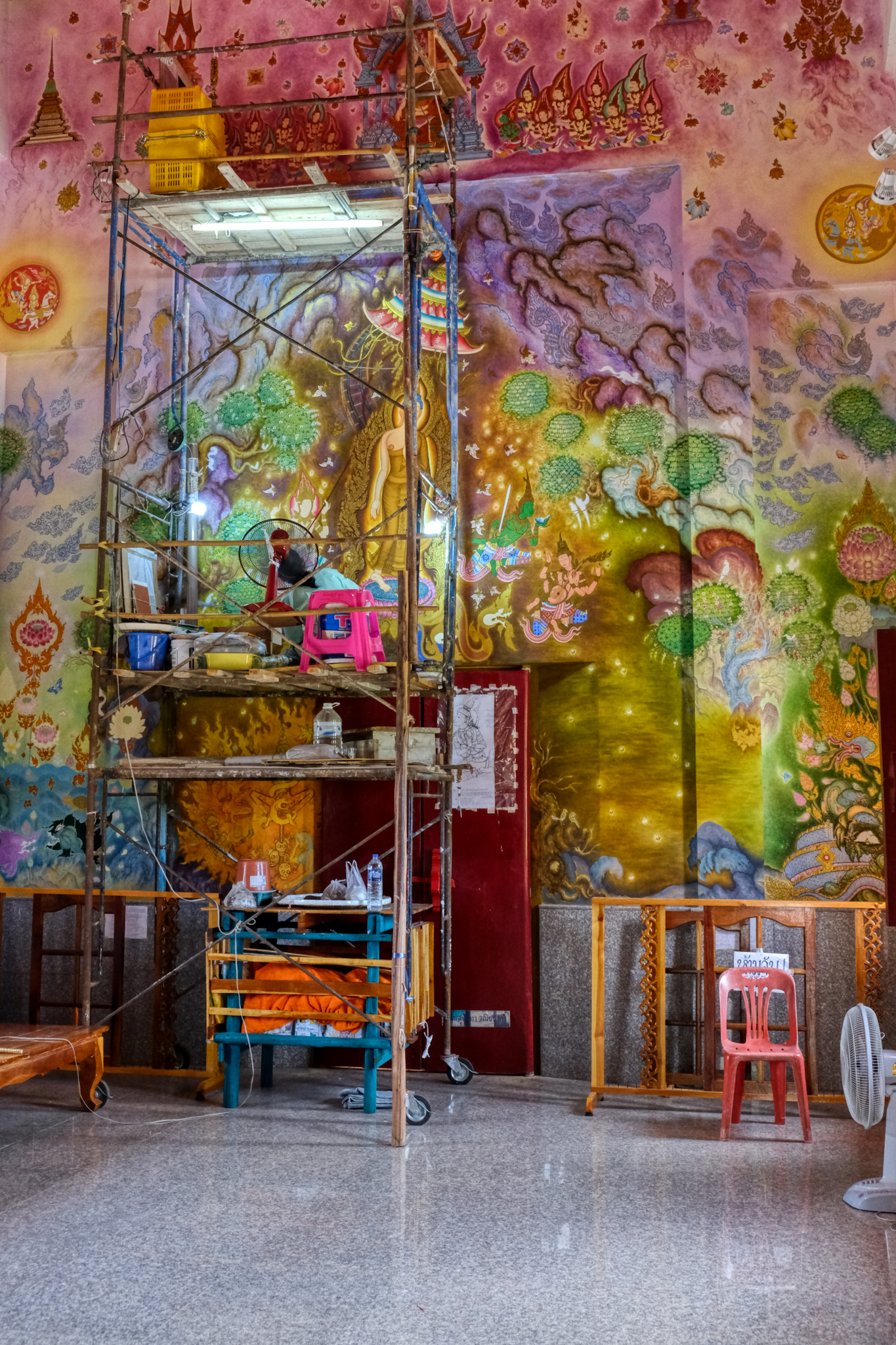 And this is what I saw when I opened the door . . . an artist on scaffolding painting an amazing mural on the far wall. WOW!
And this is what I saw when I opened the door . . . an artist on scaffolding painting an amazing mural on the far wall. WOW!
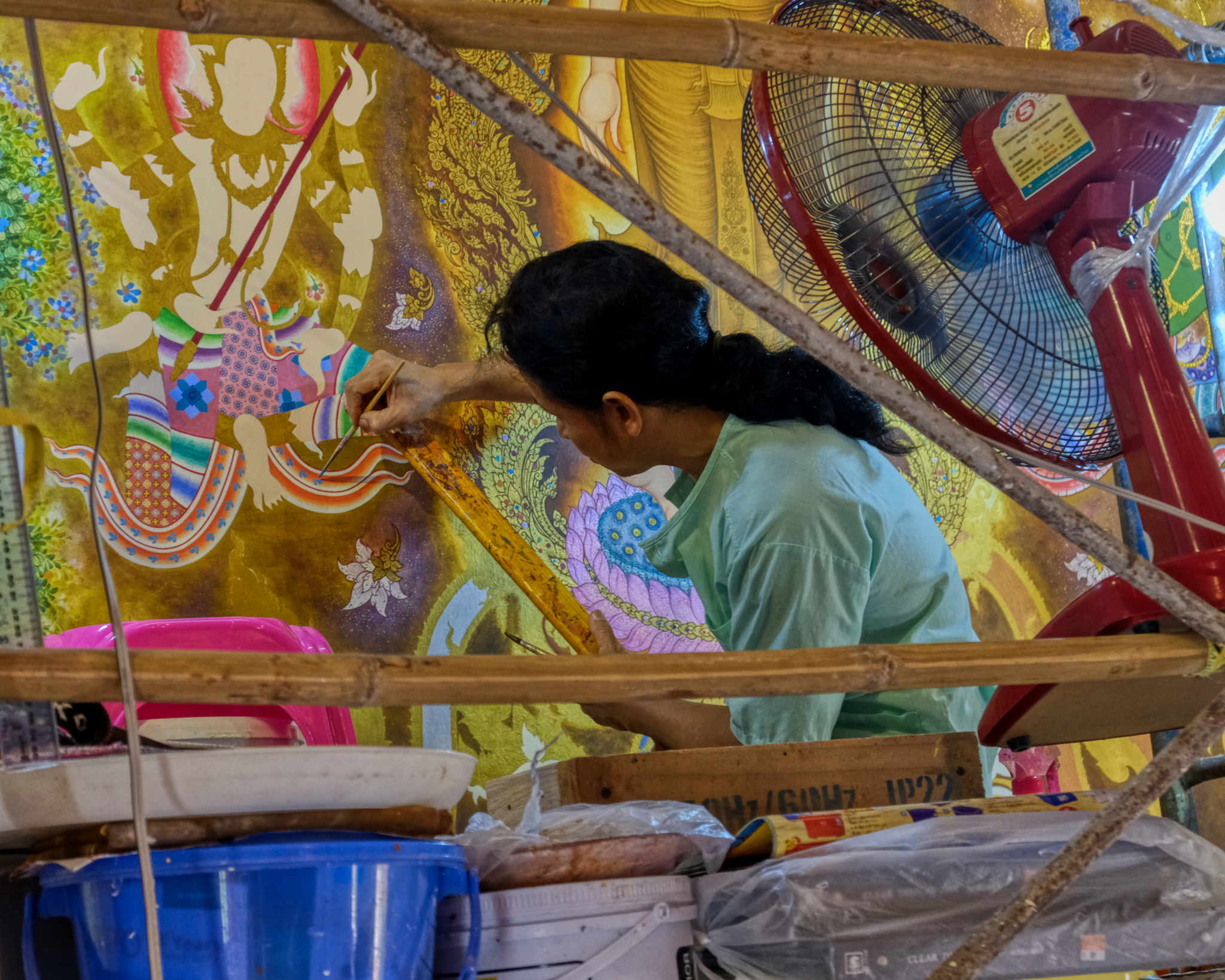 The artist at work.
The artist at work.
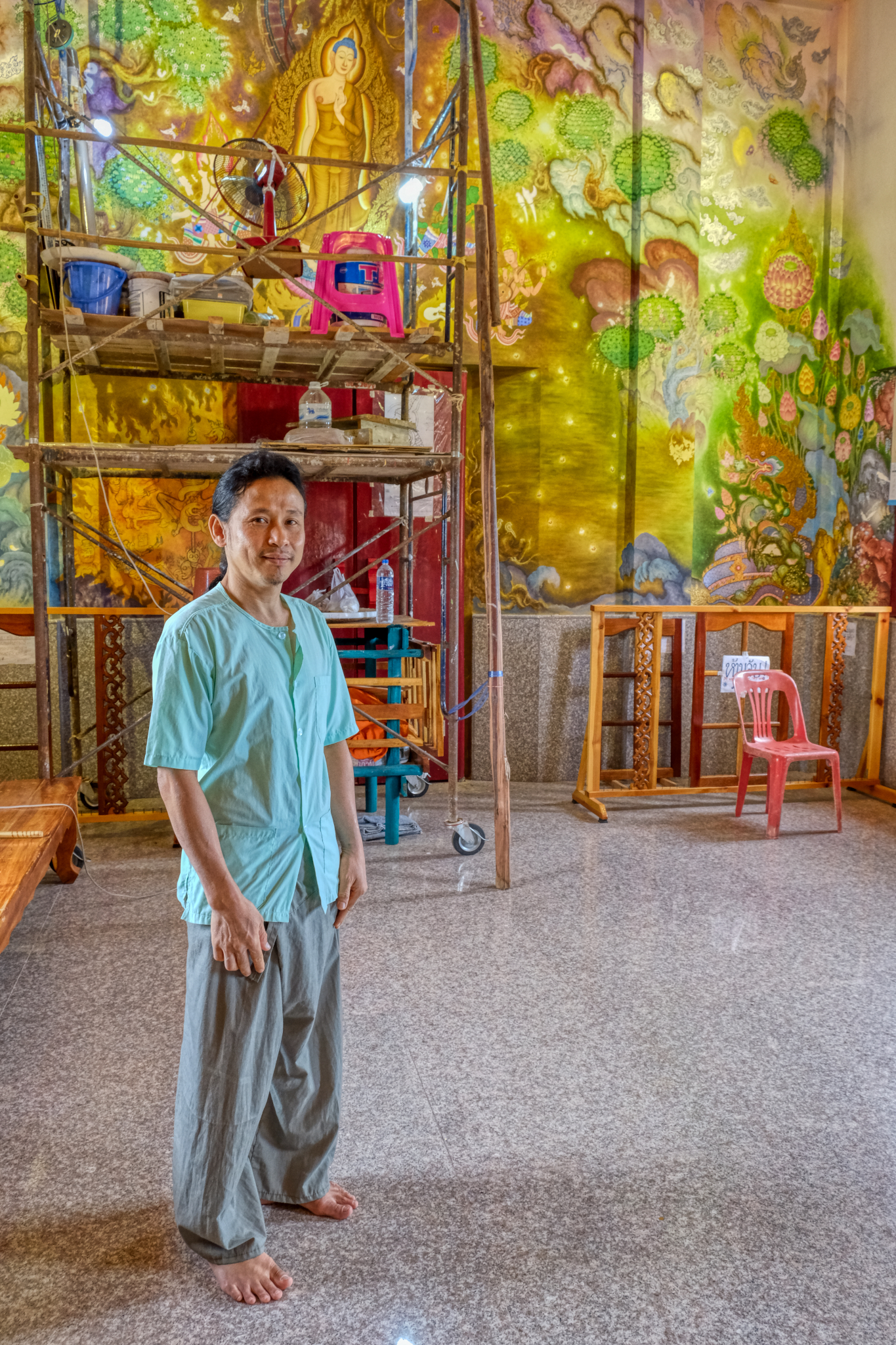 The artist came down off the scaffolding to offer me some water. I declined as I had my own. We chatted for a while. He said he had been working on that wall for three years already and that there were two or three more years left to finish the rest of the interior.
The artist came down off the scaffolding to offer me some water. I declined as I had my own. We chatted for a while. He said he had been working on that wall for three years already and that there were two or three more years left to finish the rest of the interior.
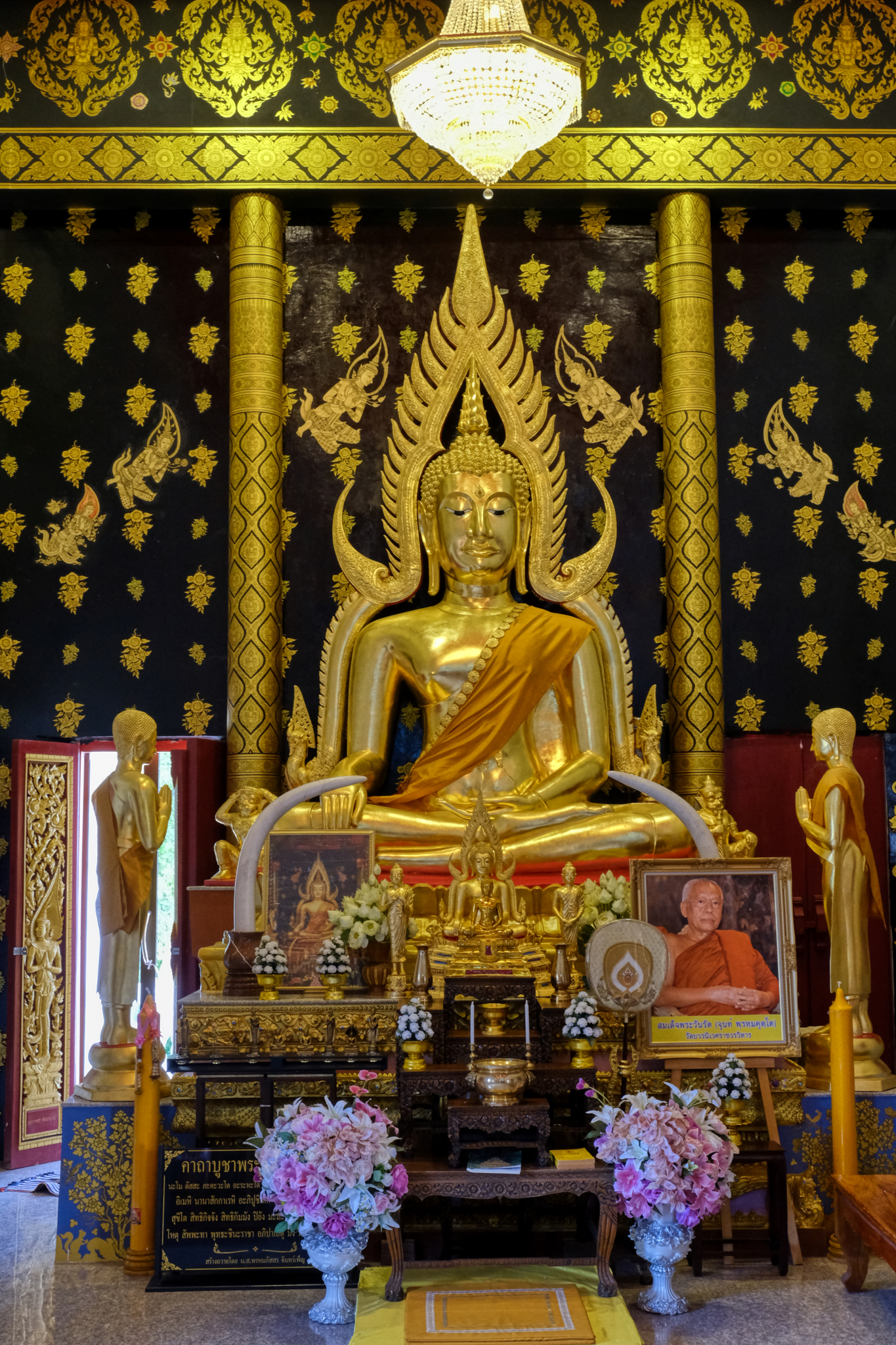 This altar faced the wall he was currently painting. He said that this wall only took six months to paint.
This altar faced the wall he was currently painting. He said that this wall only took six months to paint.
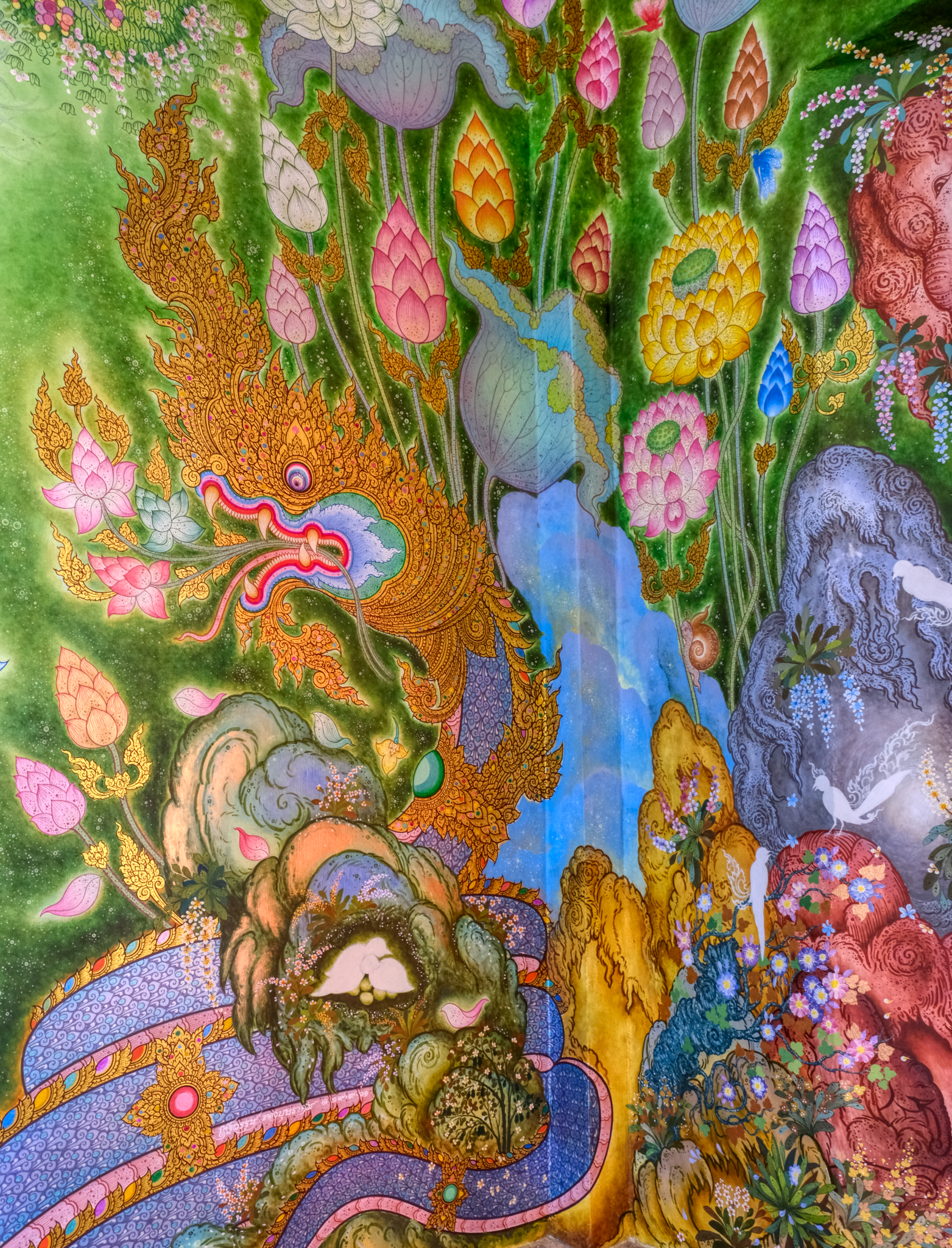 The artist's work and workmanship were masterful.
The artist's work and workmanship were masterful.
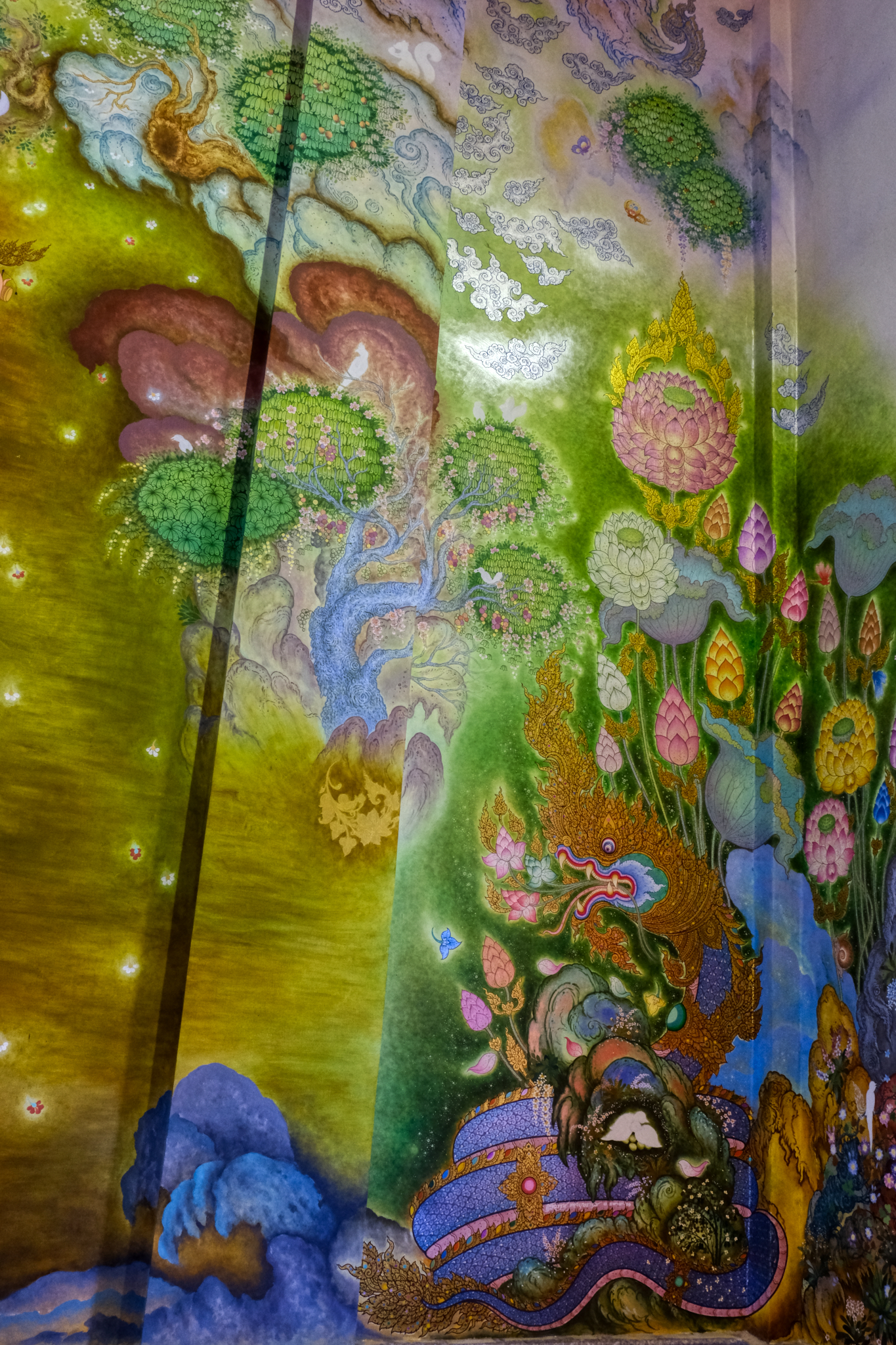 The huge mural depicted Buddhist and Thai iconography, as well as scenes from the life of the Buddha Gotama.
The huge mural depicted Buddhist and Thai iconography, as well as scenes from the life of the Buddha Gotama.
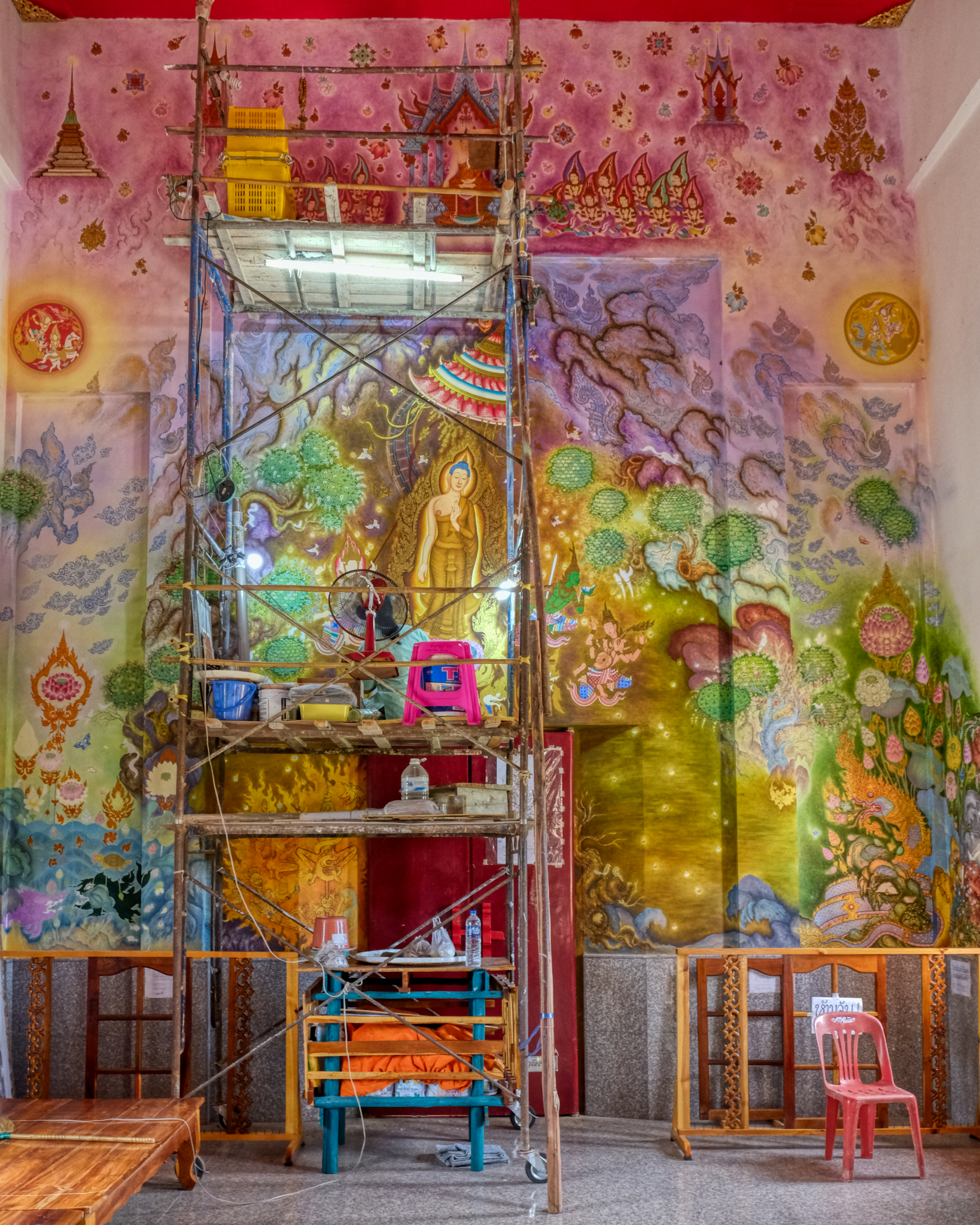 After we spoke he climbed back up to his platform and resumed painting. I sat watching him paint for quite awhile.
After we spoke he climbed back up to his platform and resumed painting. I sat watching him paint for quite awhile.
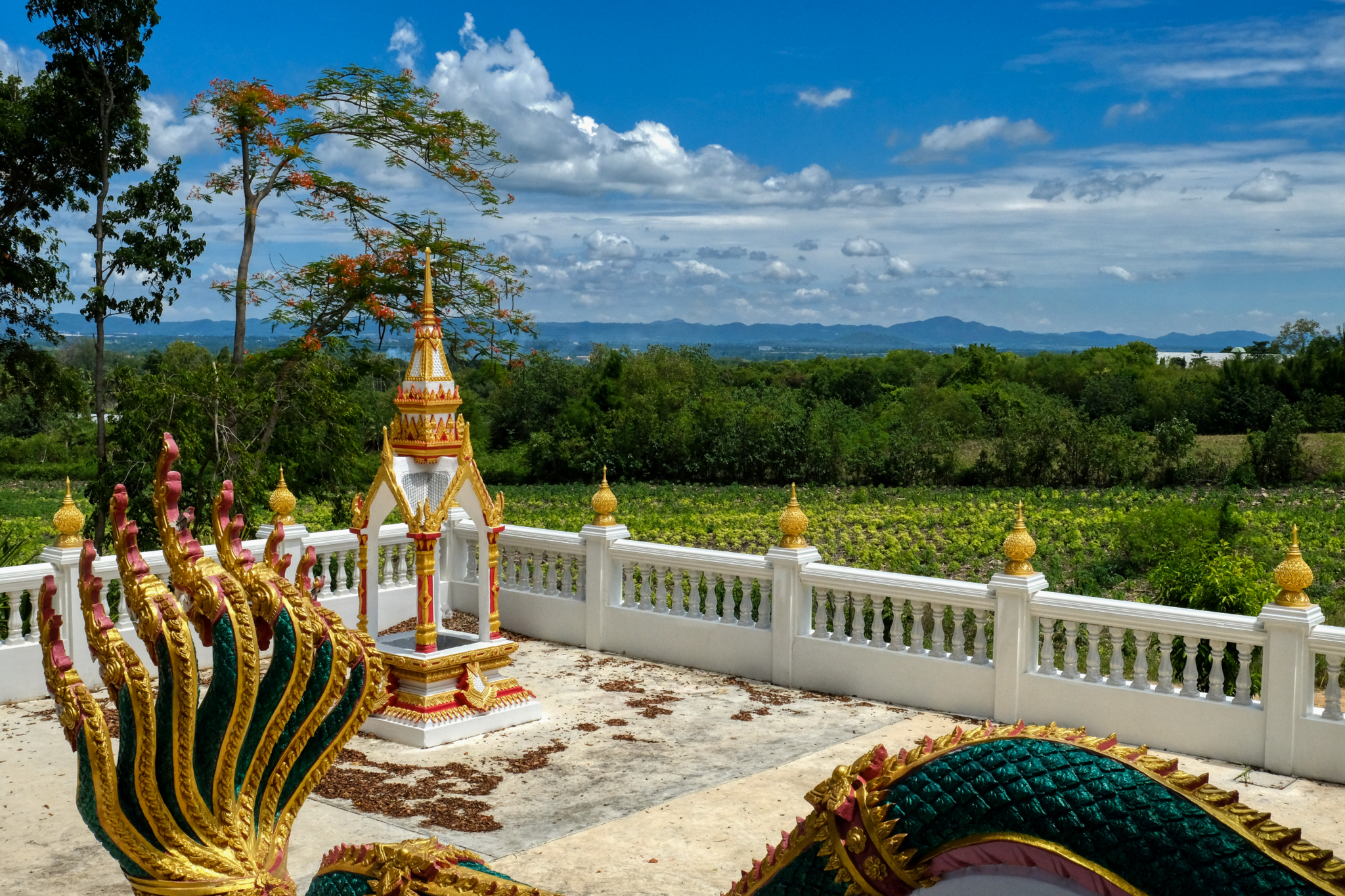 Standing outside the new wat enjoying the hilltop view out over the agricultural landscape of Khao Yai.
Standing outside the new wat enjoying the hilltop view out over the agricultural landscape of Khao Yai.
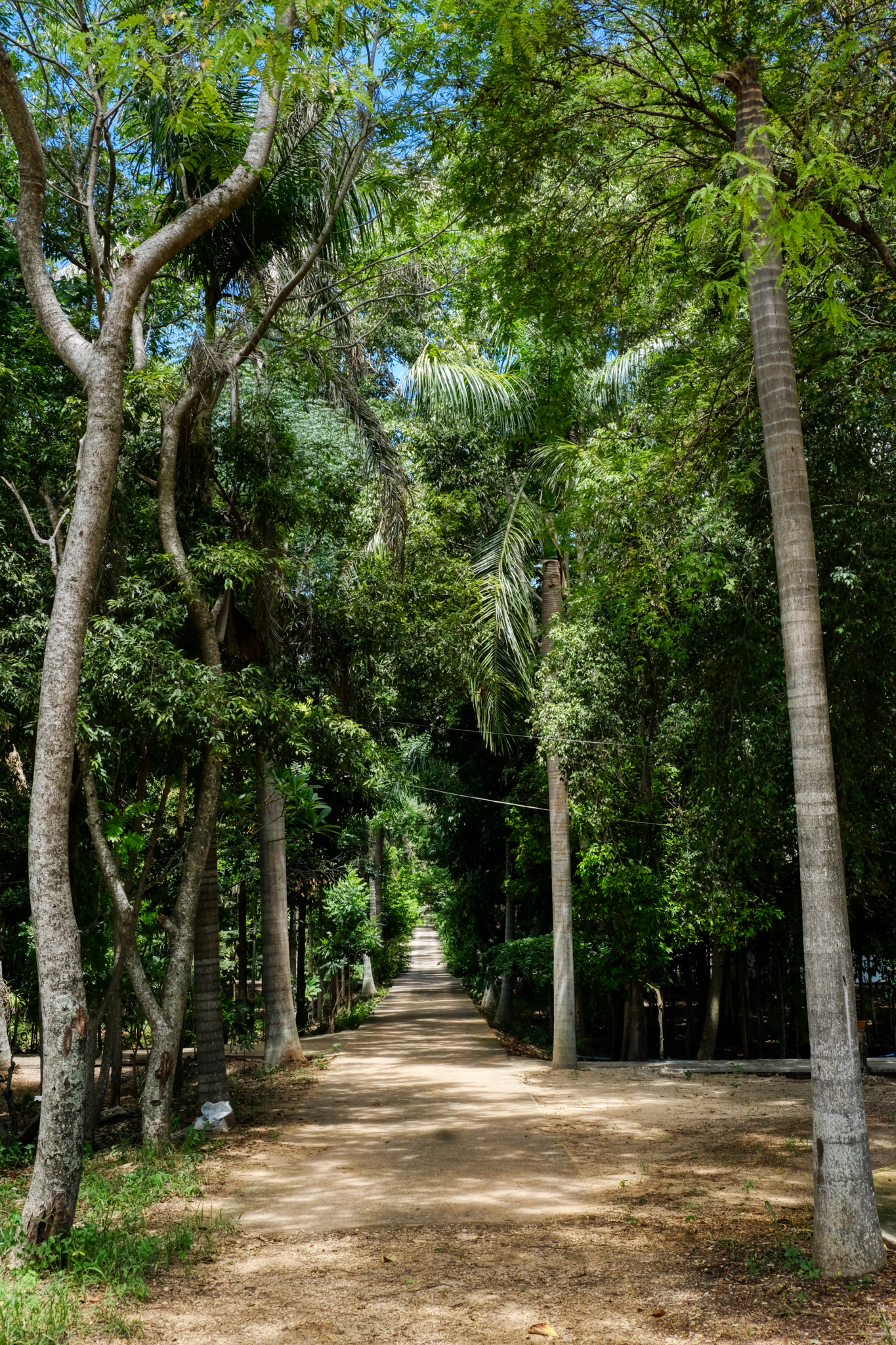 I walked back down the wooded land past the many monks cabins.
I walked back down the wooded land past the many monks cabins.
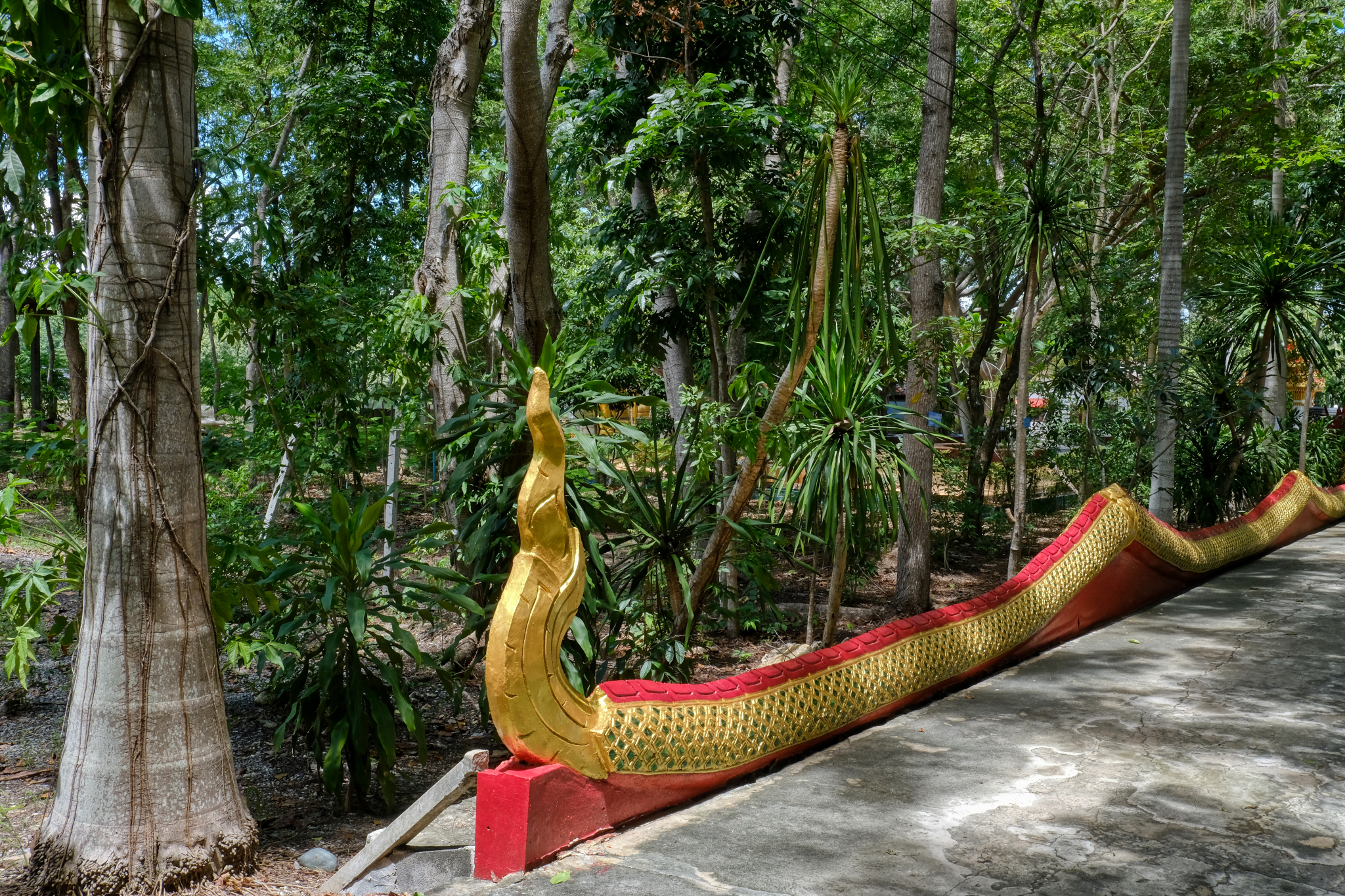 On the way back down I stopped at the tail of the many-headed dragon-snake that had welcomed me when I started up the hill.
On the way back down I stopped at the tail of the many-headed dragon-snake that had welcomed me when I started up the hill.
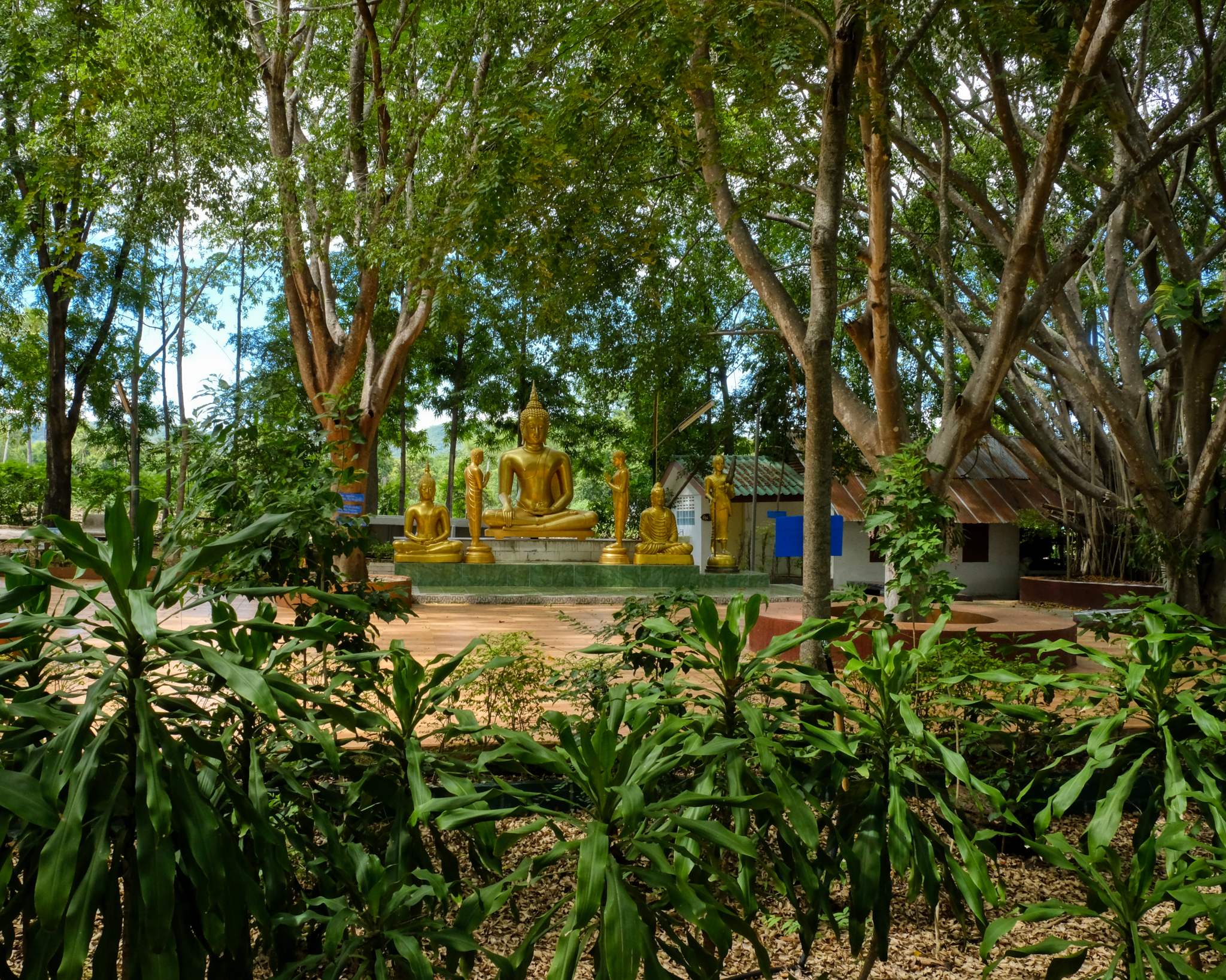 Back where I started, at the tree sheltered Buddha altar.
Back where I started, at the tree sheltered Buddha altar.
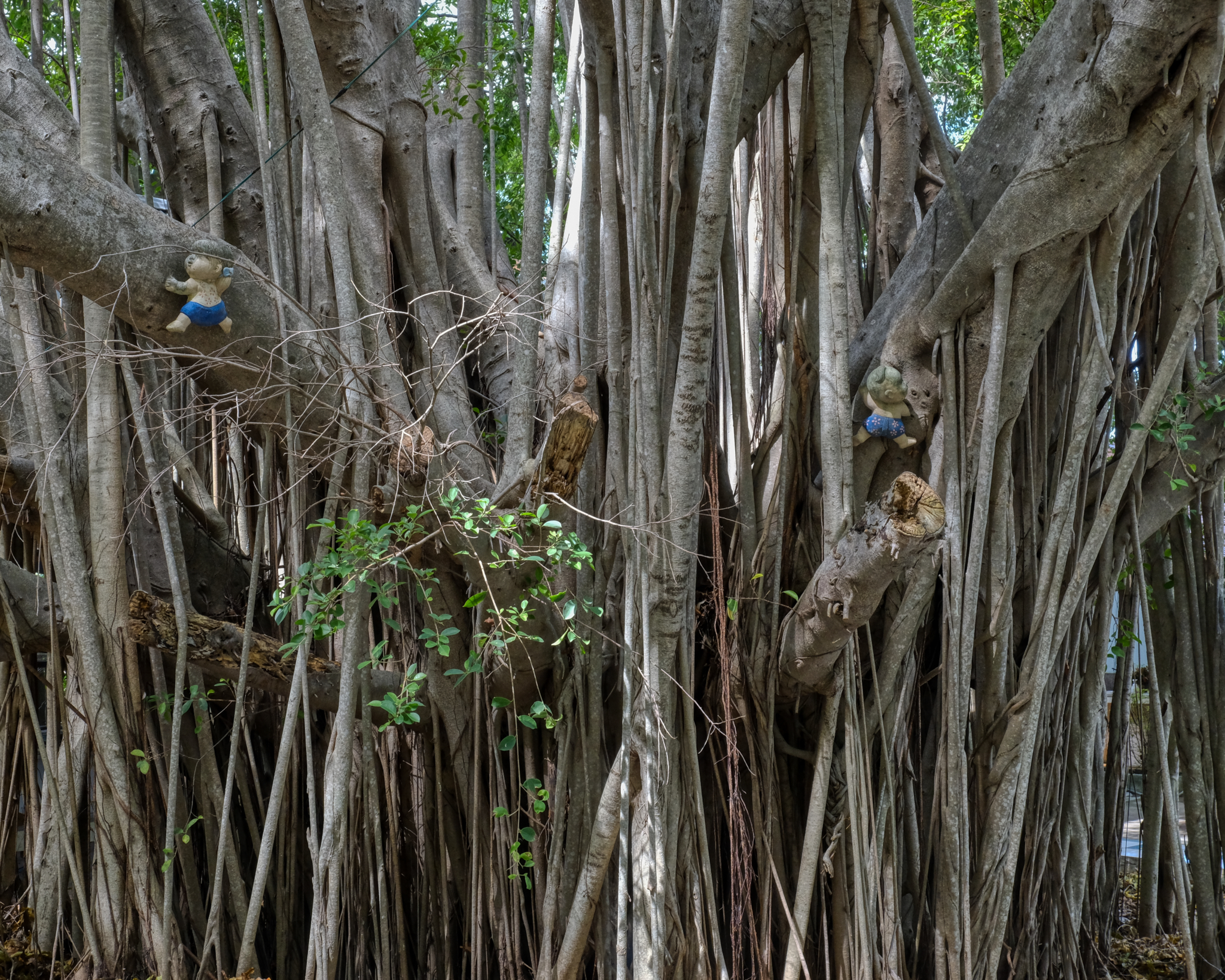 Extraordinary 'bodi' trees at this wat.
Extraordinary 'bodi' trees at this wat.
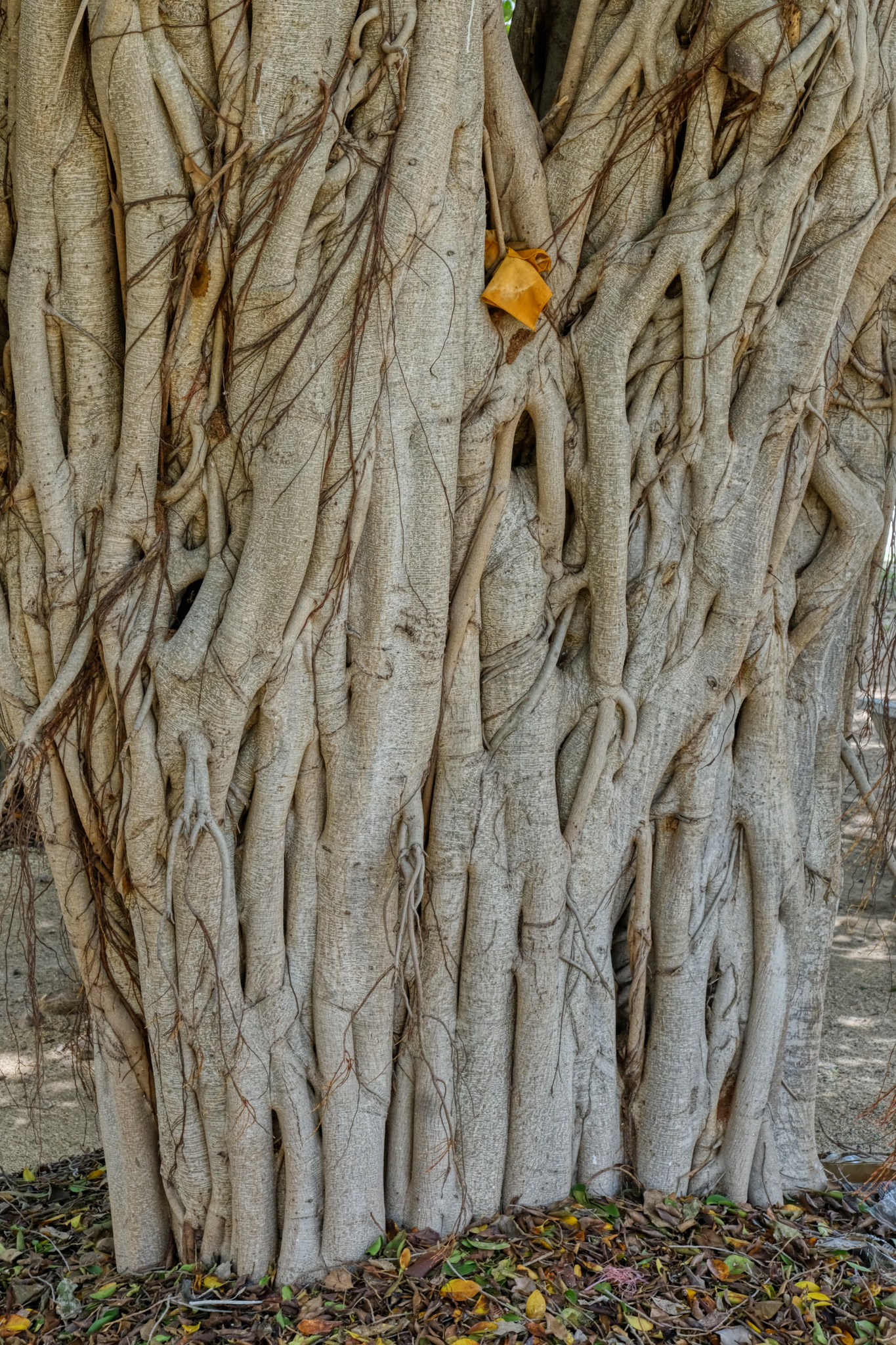 These trees!!!
These trees!!!
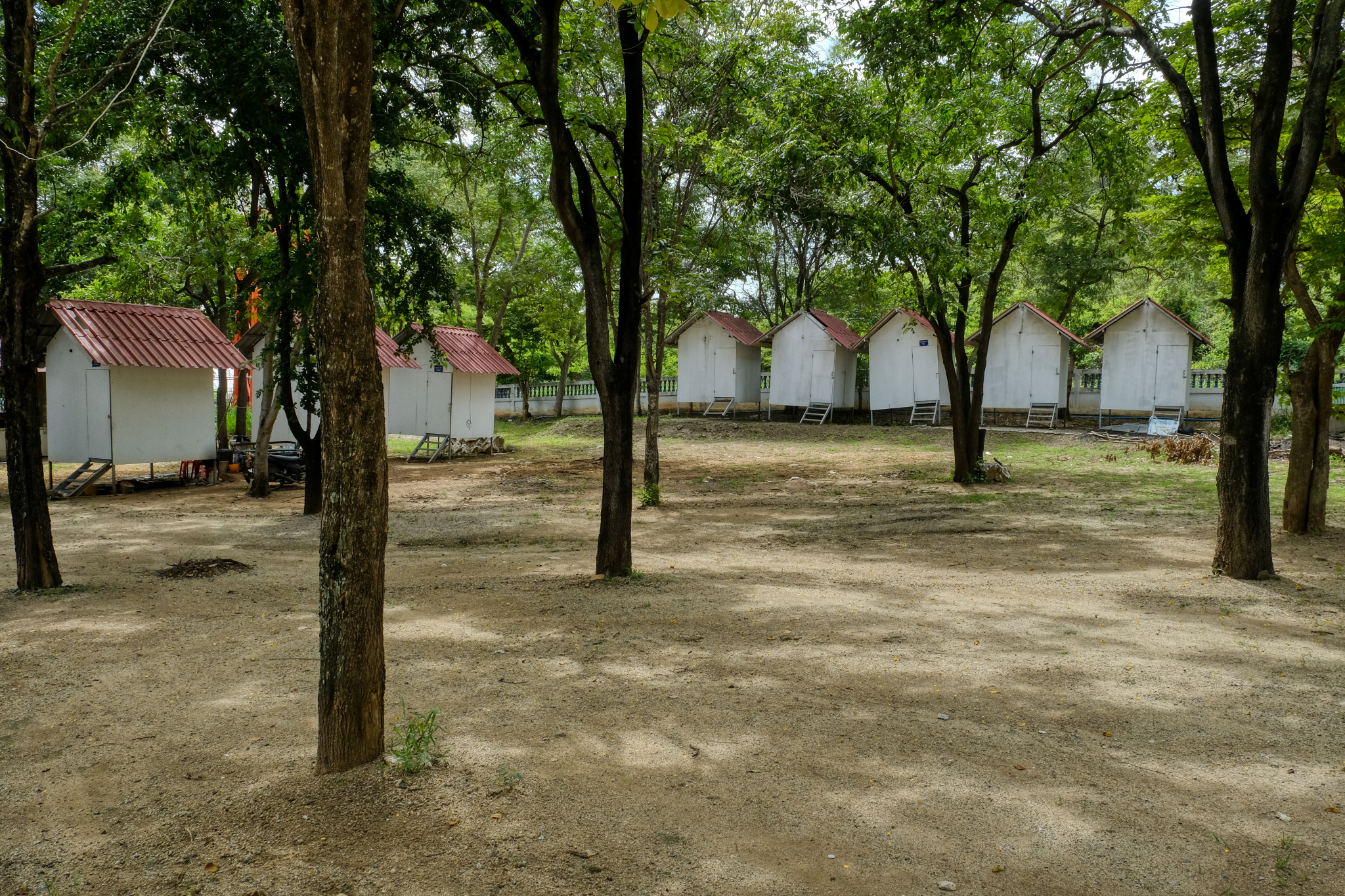 I strolled around the rest of the temple grounds and came upon these monks' cells. I assume this was a wat that took in novice/new monks and trained them here. Very austere . . .
I strolled around the rest of the temple grounds and came upon these monks' cells. I assume this was a wat that took in novice/new monks and trained them here. Very austere . . .
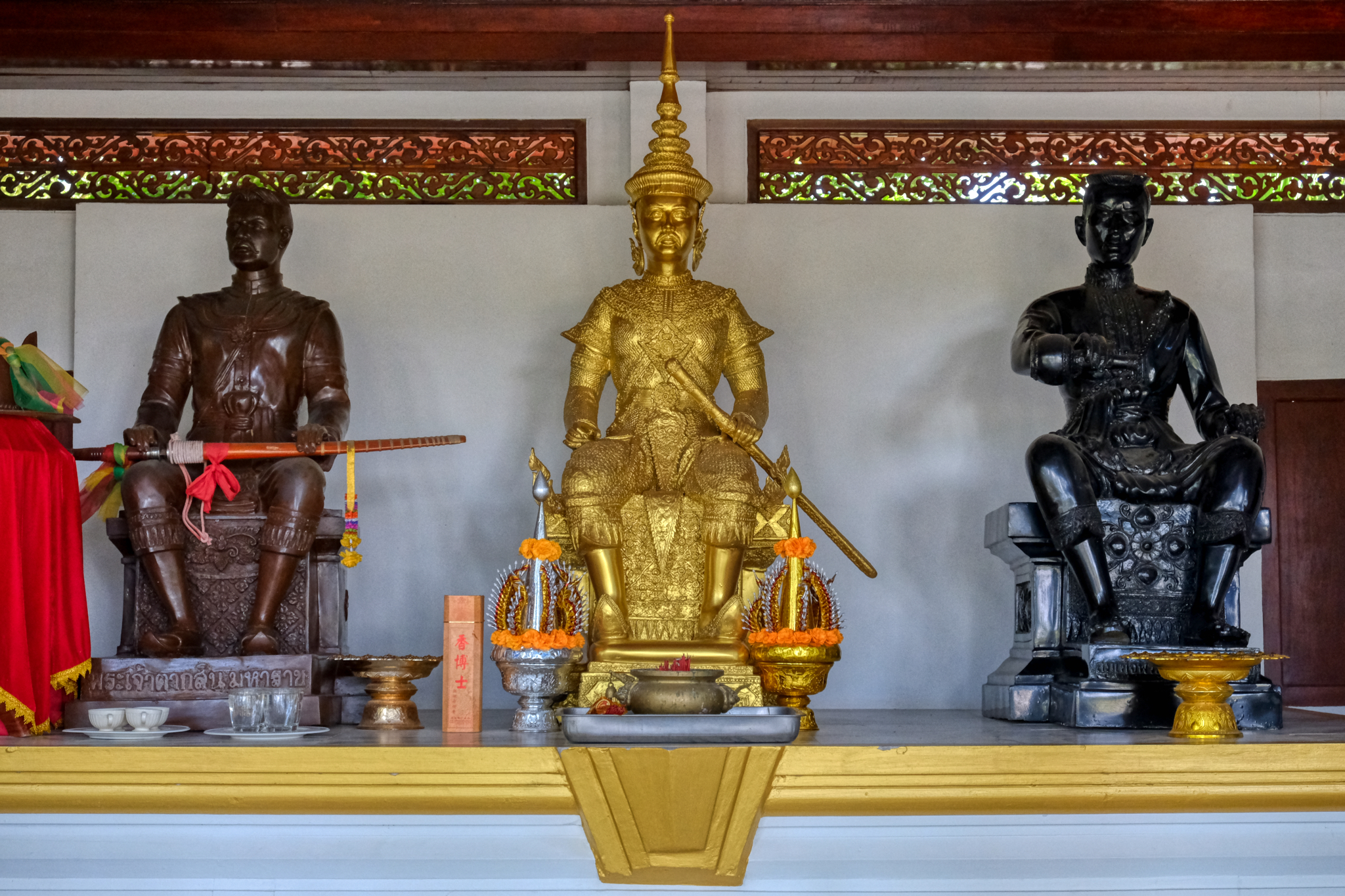 Someone had built a very nice sala with statues of three ancient Thai Kings. Sweet.
Someone had built a very nice sala with statues of three ancient Thai Kings. Sweet.
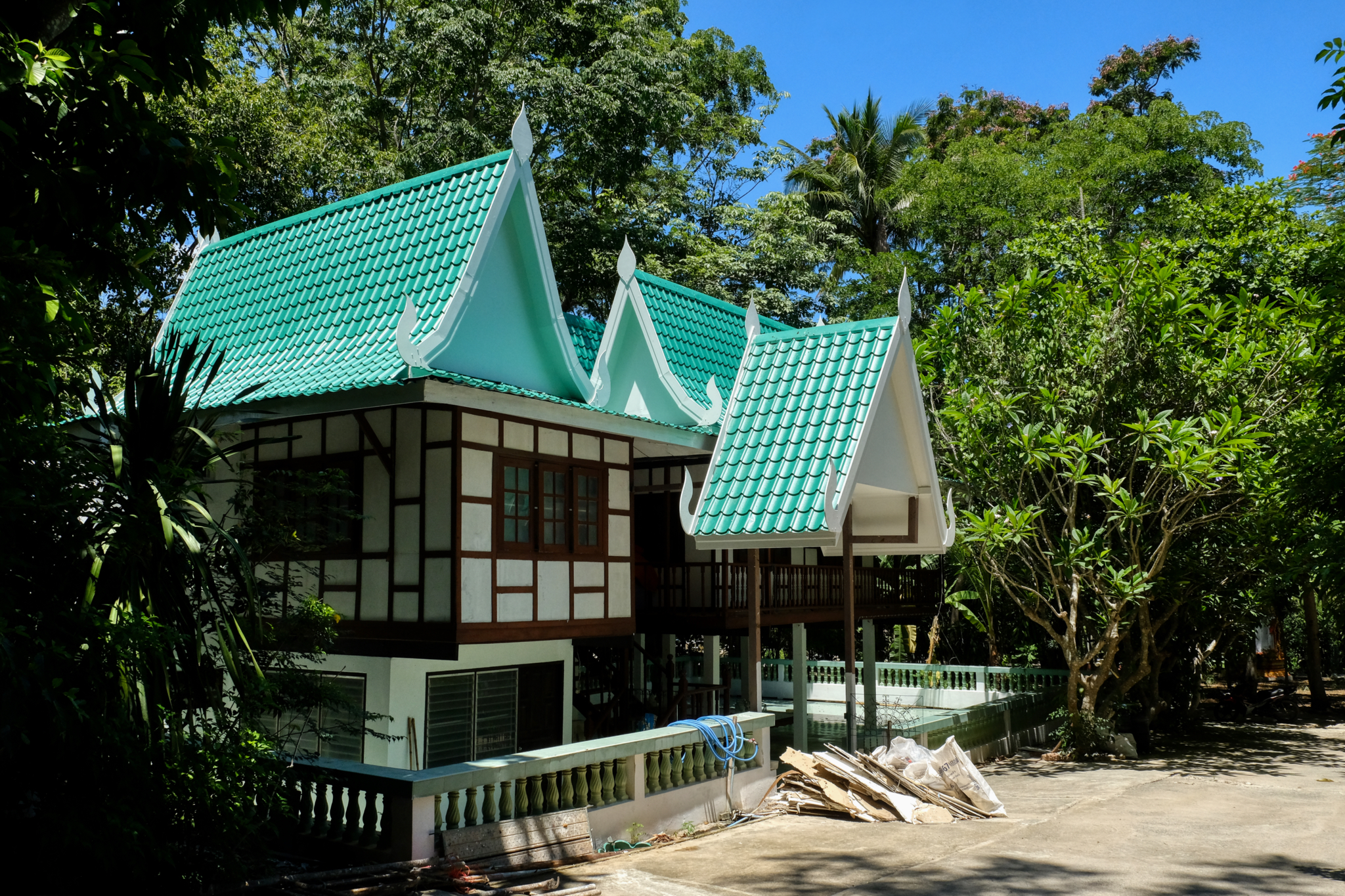 What I assumed to be the head Abbot's house getting the finishing touches on a new roof.
What I assumed to be the head Abbot's house getting the finishing touches on a new roof.
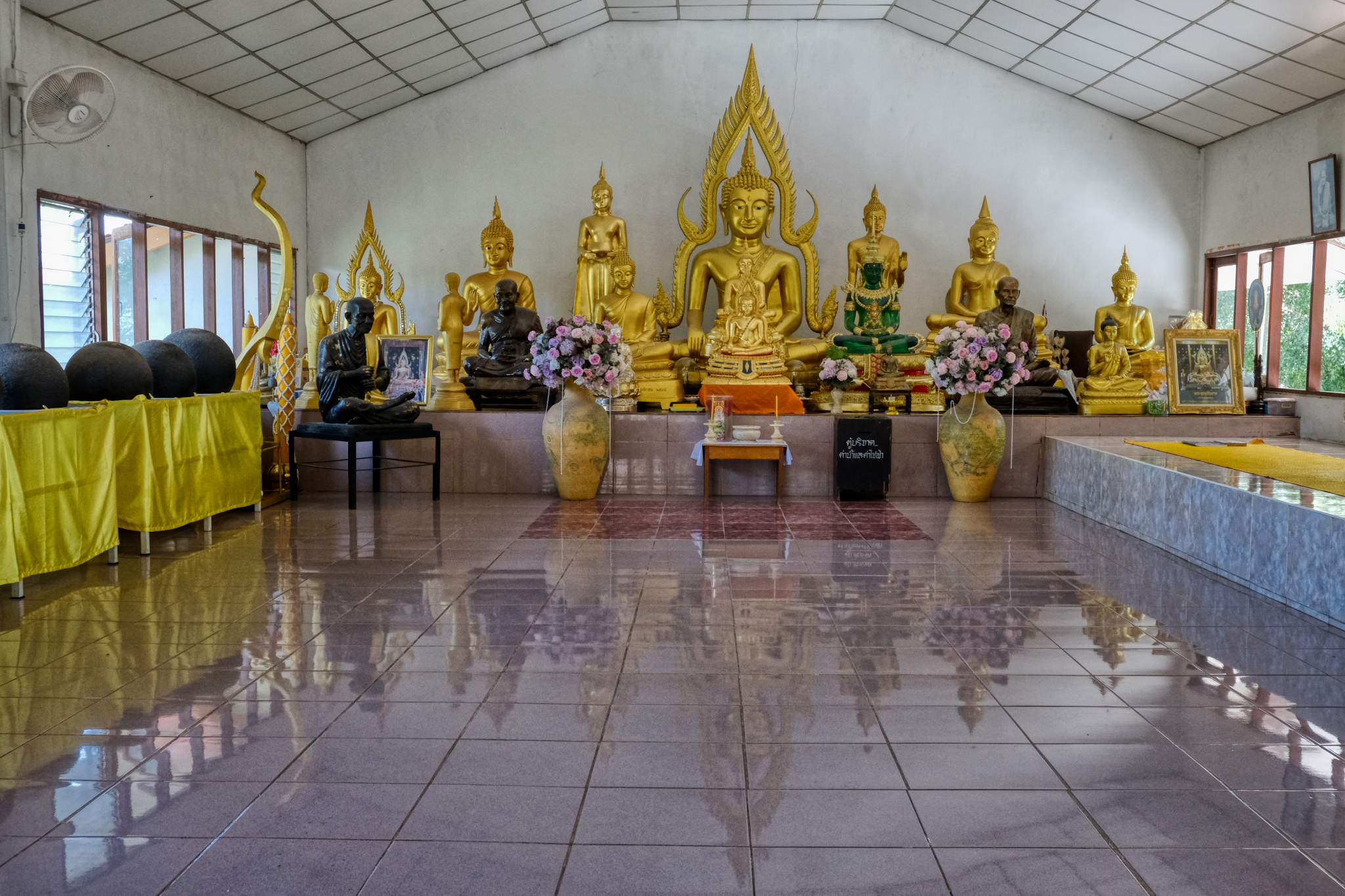 The current main hall where the monks daily meet to meditate and chant. The door was open and I went in. I had been looking for the donation box and I found it here. I left a substantial donation toward the construction and maintenance of this wonderful place.
The current main hall where the monks daily meet to meditate and chant. The door was open and I went in. I had been looking for the donation box and I found it here. I left a substantial donation toward the construction and maintenance of this wonderful place.
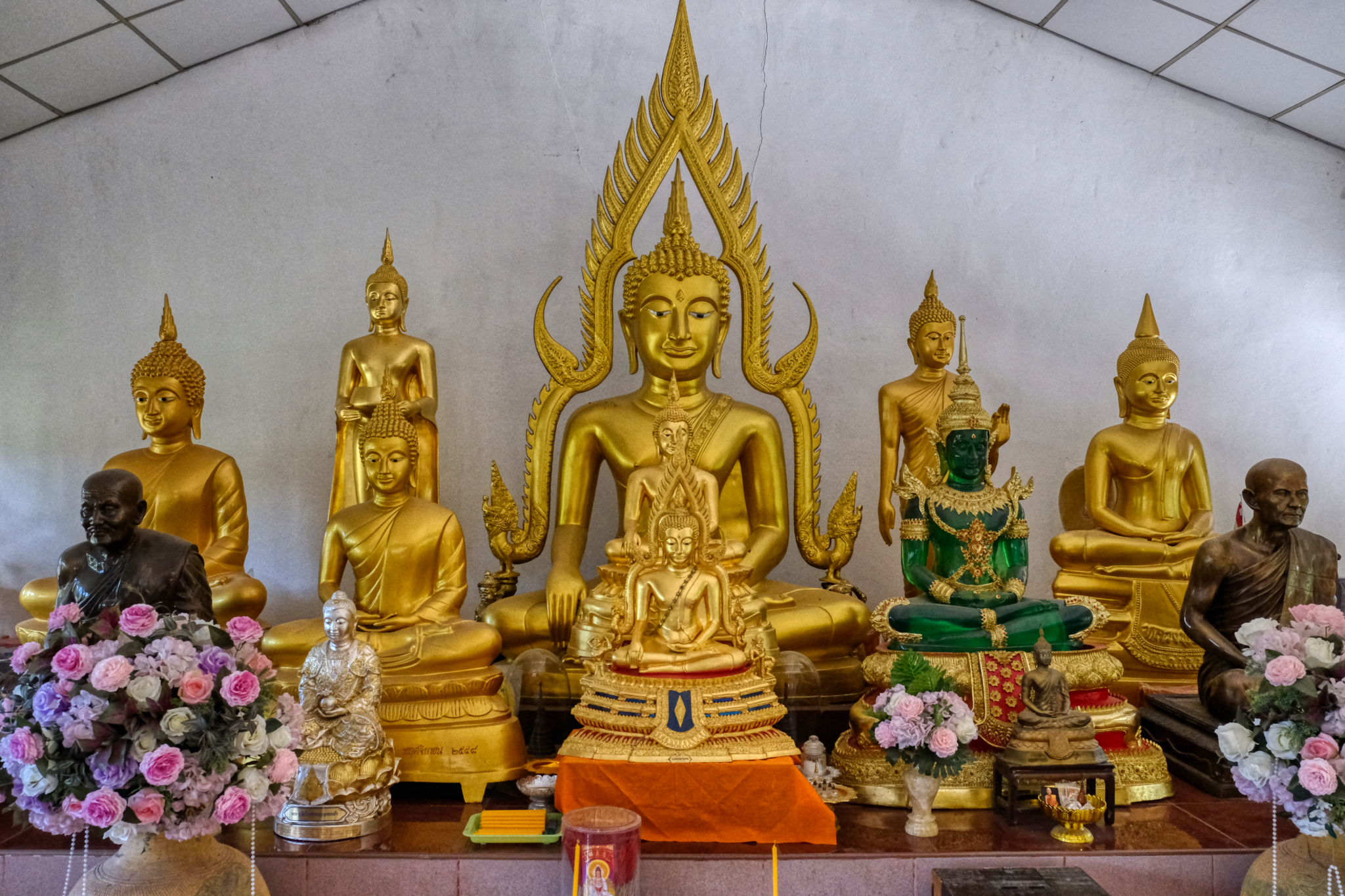 I left this wat after many hours exploring its beauty and spirituality.
I left this wat after many hours exploring its beauty and spirituality.
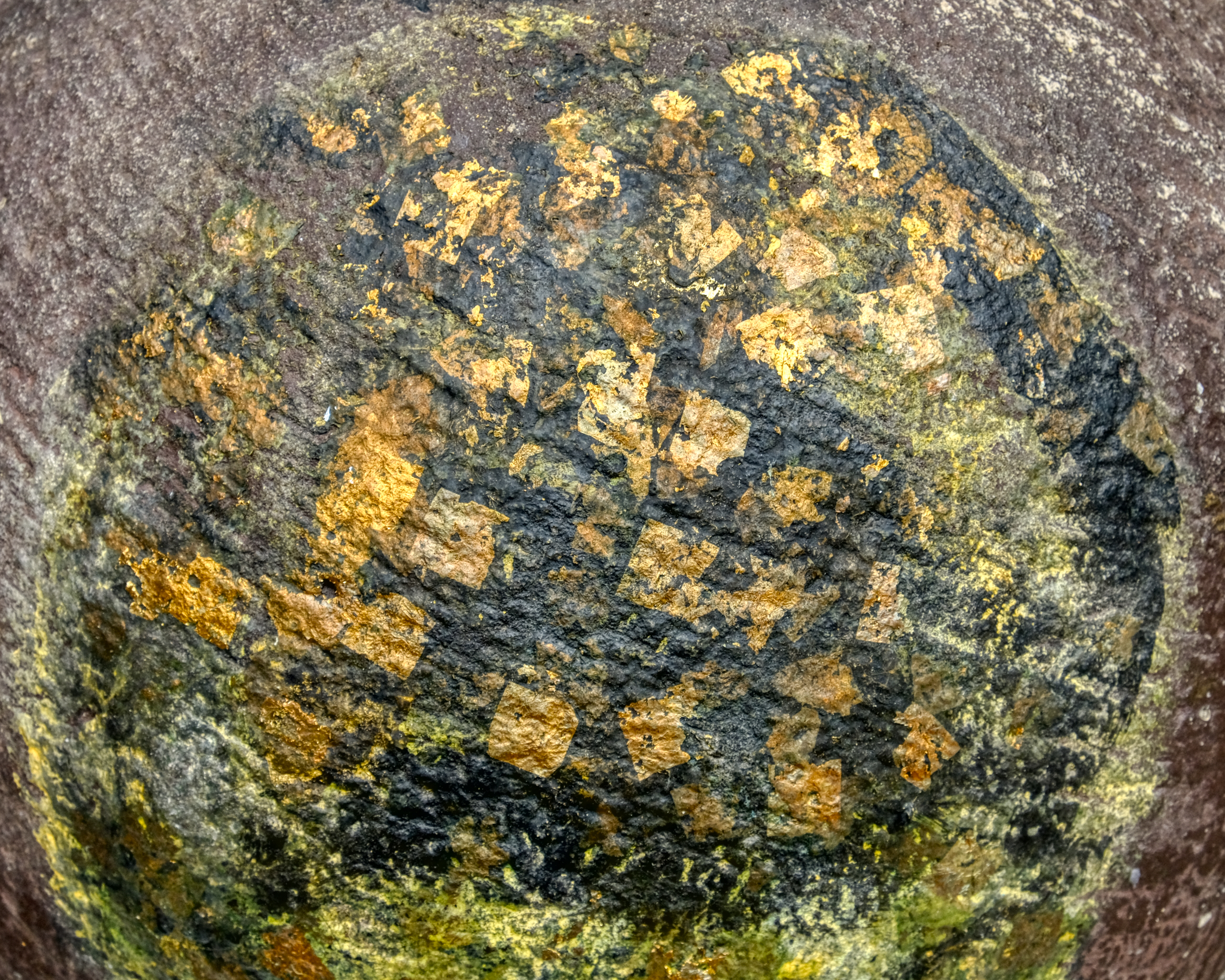
Visitors From Abroad Day Trip: Pak Khlong Flower Market
 Tuesday, March 31, 2020 at 5:45PM
Tuesday, March 31, 2020 at 5:45PM 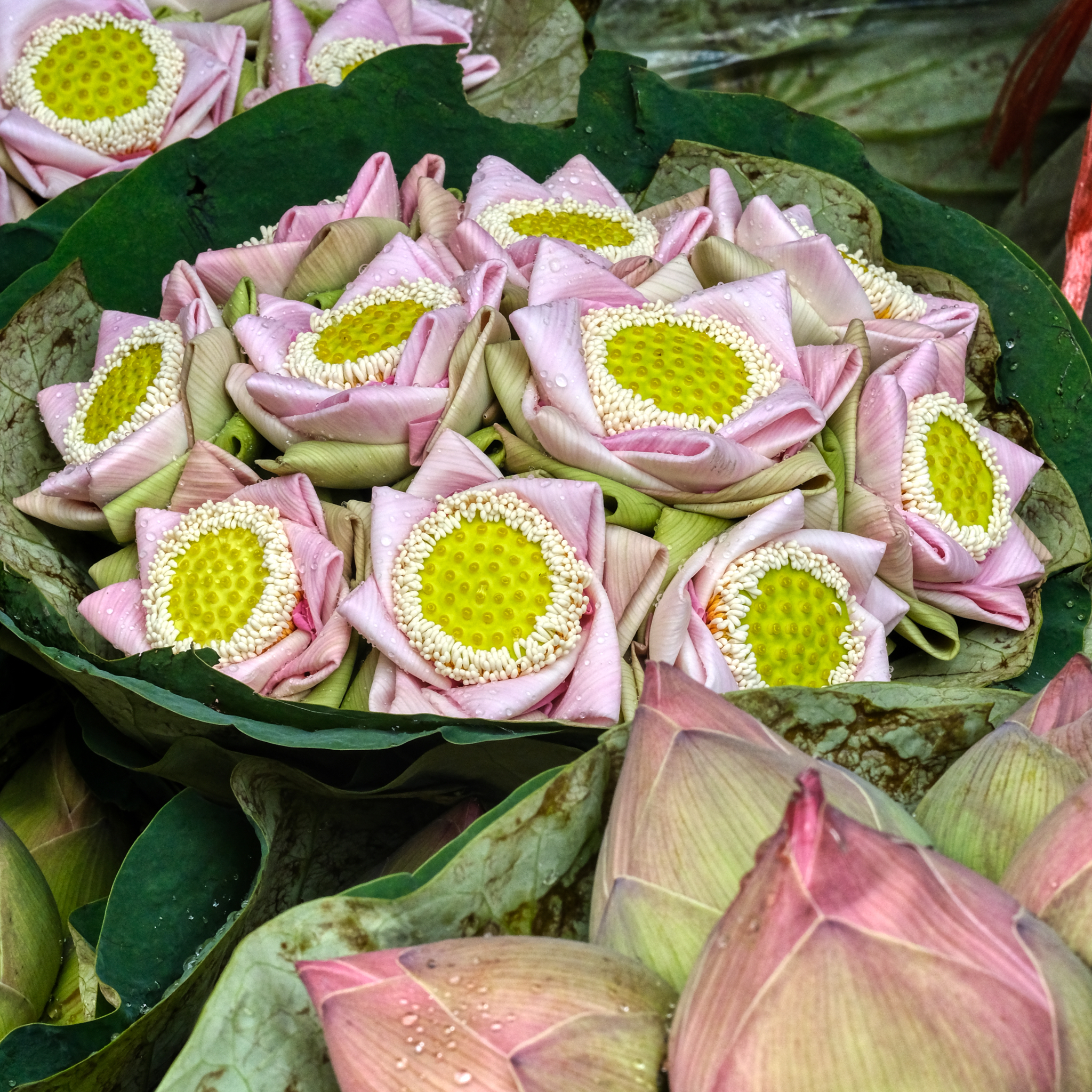 Pak Khlong Talat is Bangkok's great flower market . . . and one of the largest flower markets in the world.
Pak Khlong Talat is Bangkok's great flower market . . . and one of the largest flower markets in the world.
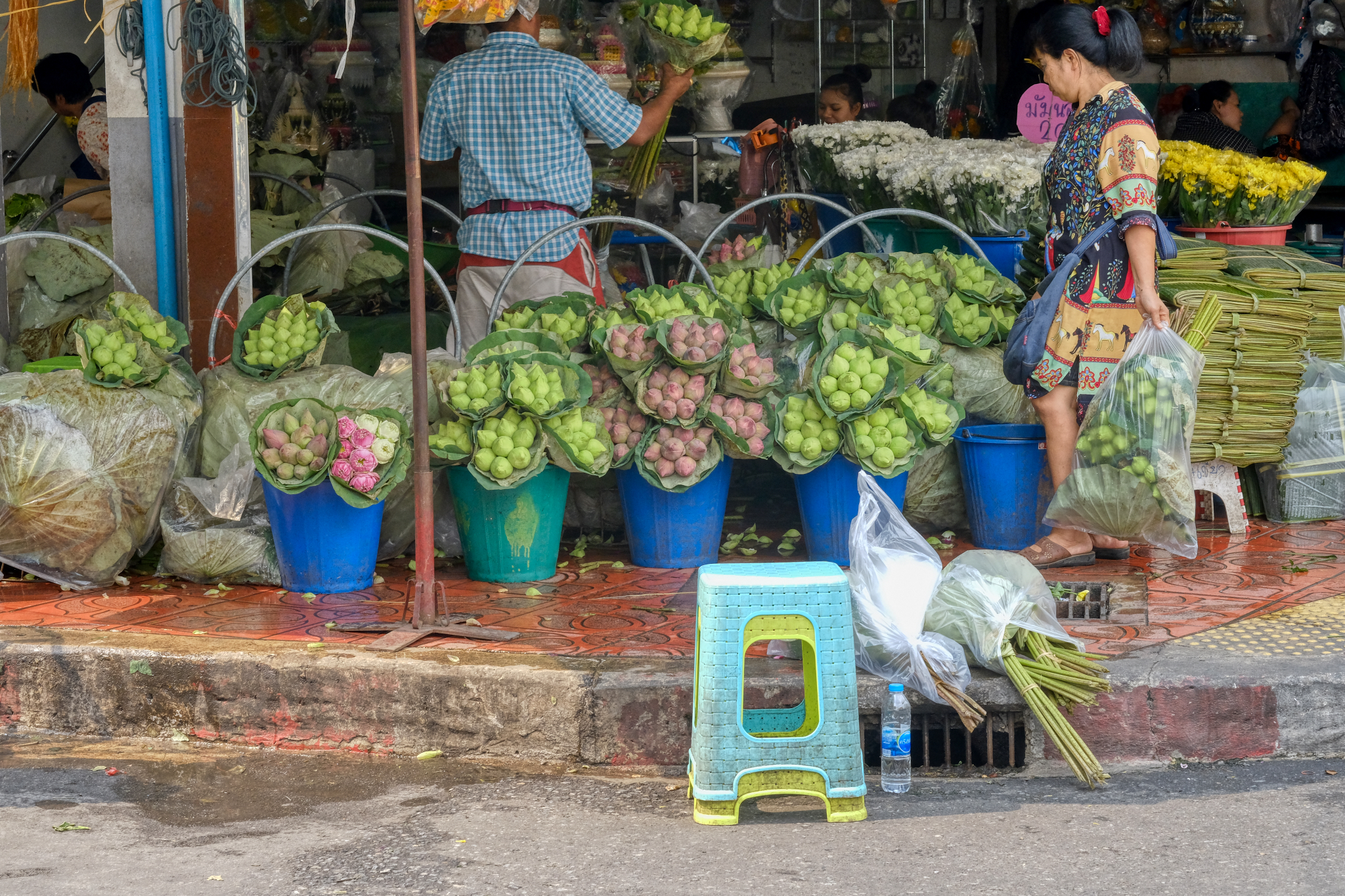 Literally millions of fresh lotus buds and flowers every day pass through this flower market.
Literally millions of fresh lotus buds and flowers every day pass through this flower market.
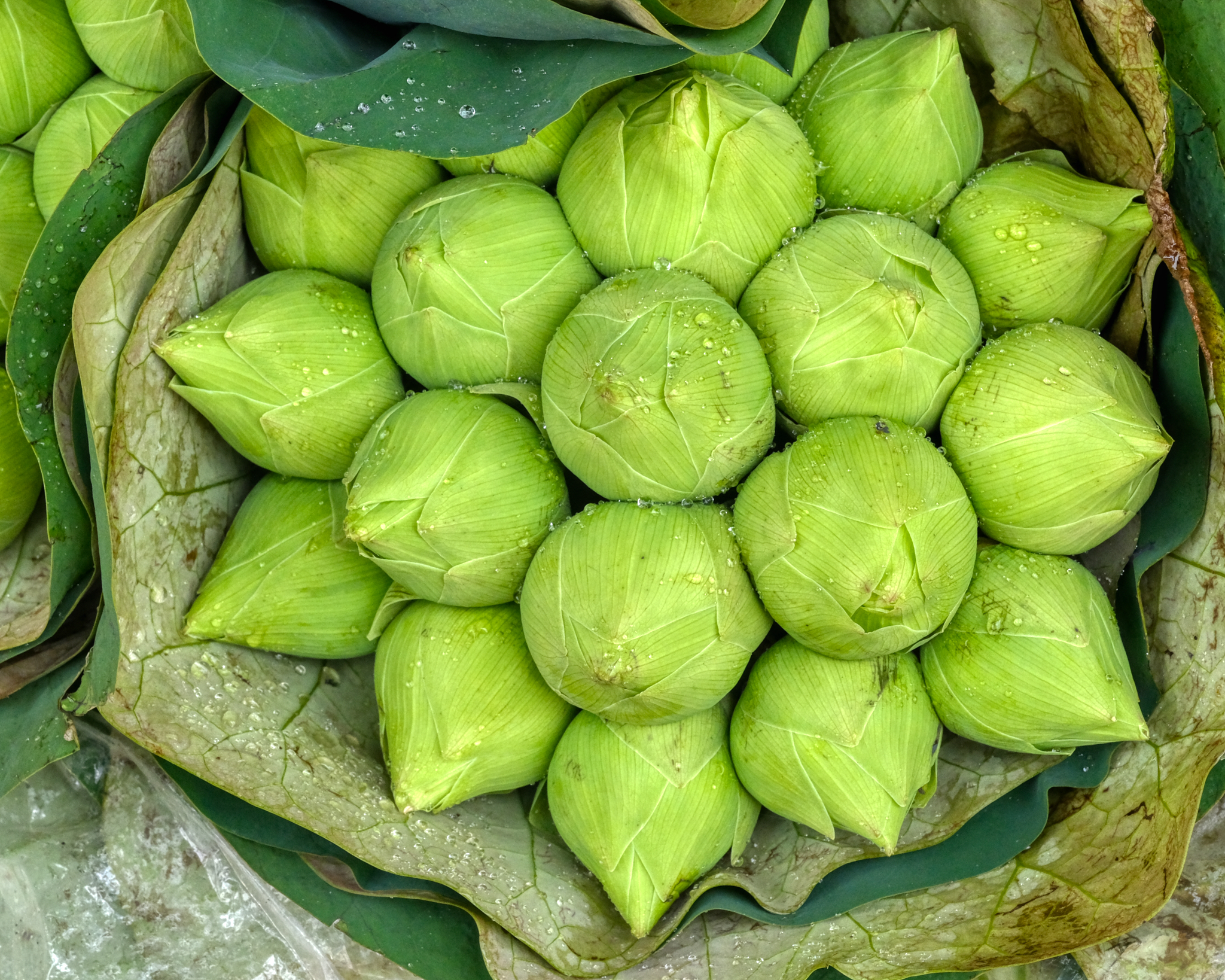 The lotus bud is a powerful symbol in Buddhist thought.
The lotus bud is a powerful symbol in Buddhist thought.
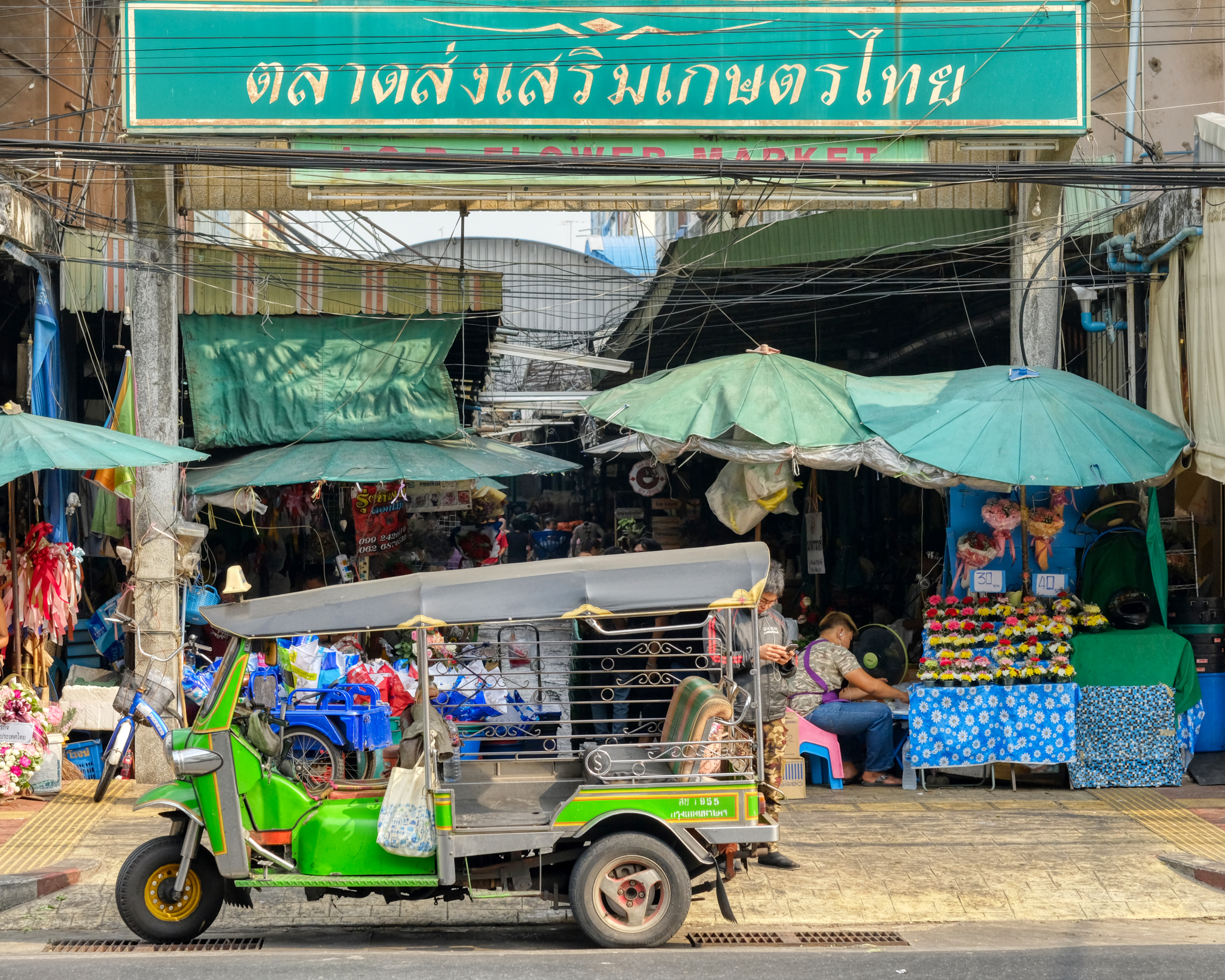 Pak Khlong Talat is a huge flower market with large indoor spaces and narrow alleys all full of flowers . . . it is a wholesale market, so many buyers come every morning and send their purchases back to their shops by tuk-tuk.
Pak Khlong Talat is a huge flower market with large indoor spaces and narrow alleys all full of flowers . . . it is a wholesale market, so many buyers come every morning and send their purchases back to their shops by tuk-tuk.
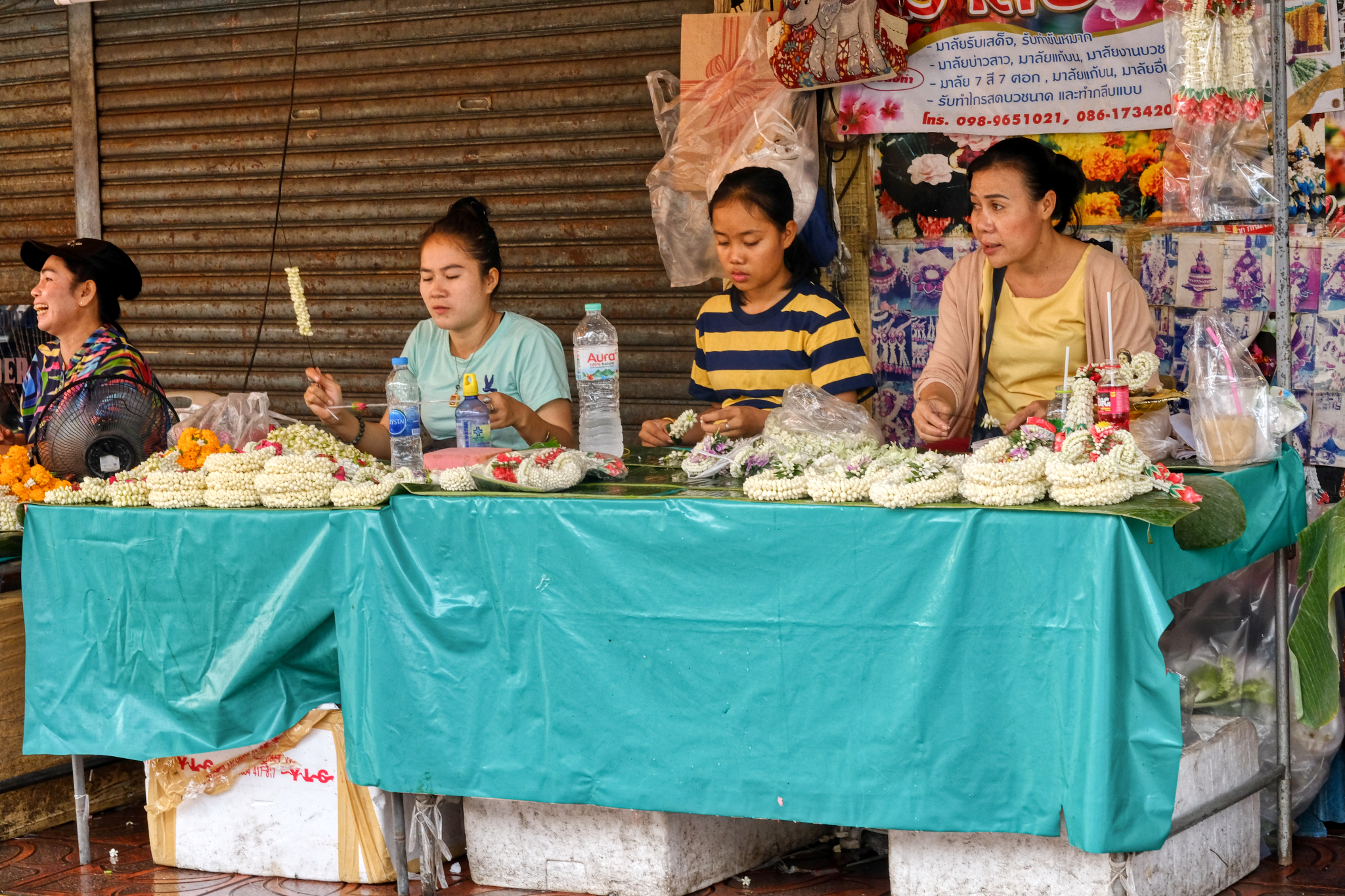 Some buyers come to buy 'raw' flowers for arrangement elsewhere, and some come to buy ready-made arrangements, like these aromatic jasmine bud garlands (used in Buddhist blessings). Imagine how wonderful these women smell after a days' work!!!
Some buyers come to buy 'raw' flowers for arrangement elsewhere, and some come to buy ready-made arrangements, like these aromatic jasmine bud garlands (used in Buddhist blessings). Imagine how wonderful these women smell after a days' work!!!
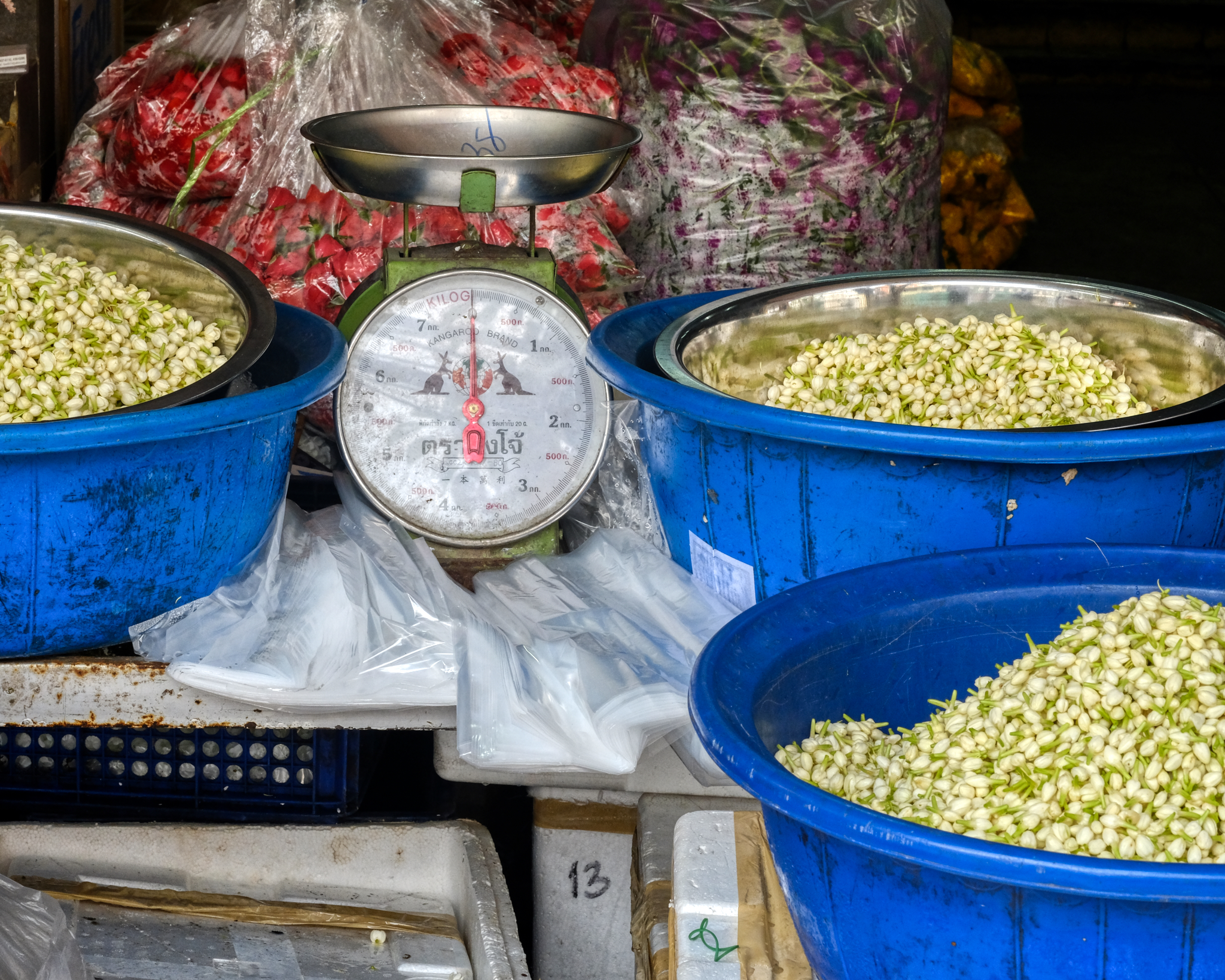 Fragrant jasmine buds being weighed.
Fragrant jasmine buds being weighed.
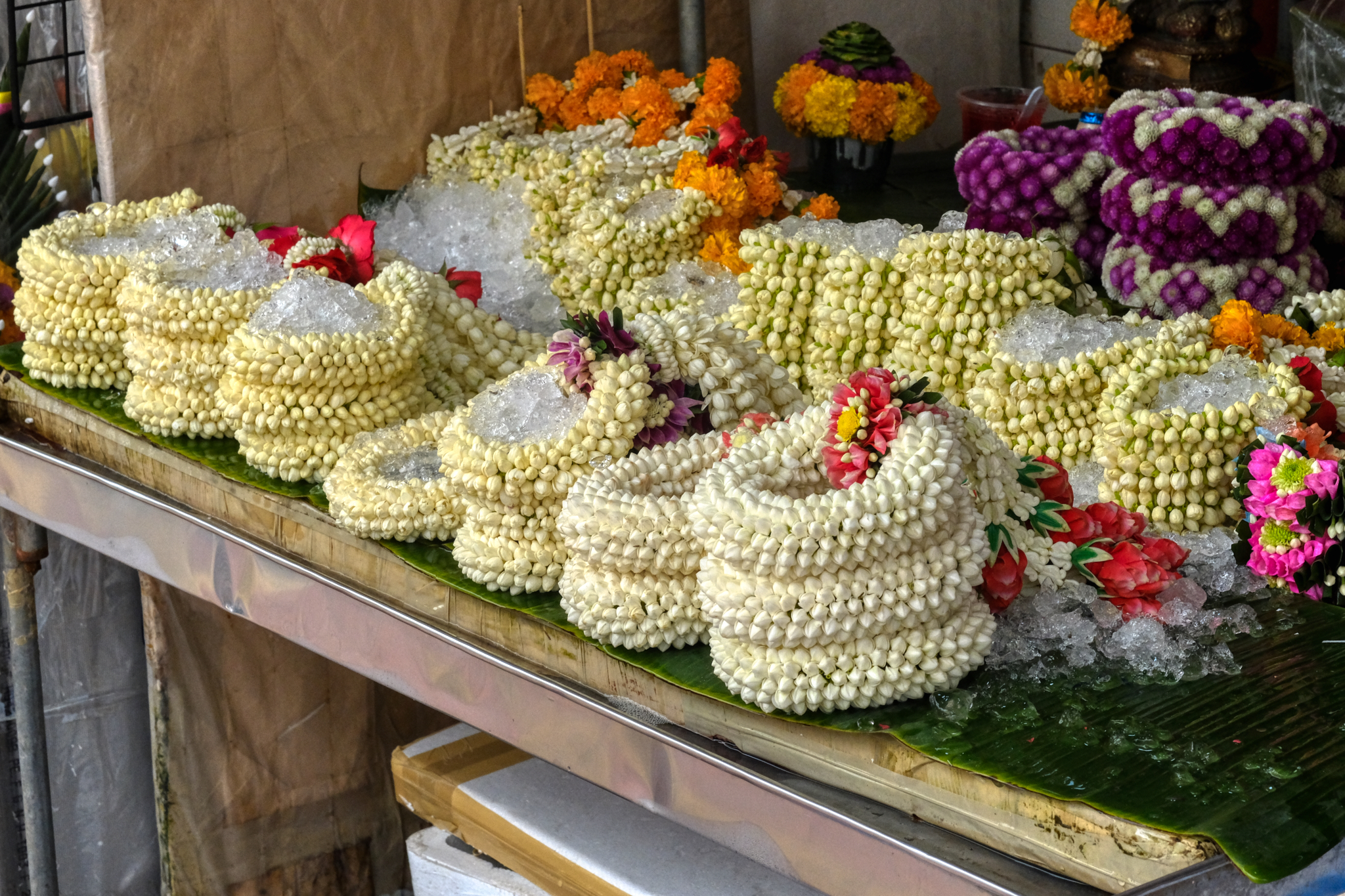 Beautifully made jasmine garlands on ice, ready for sales.
Beautifully made jasmine garlands on ice, ready for sales.
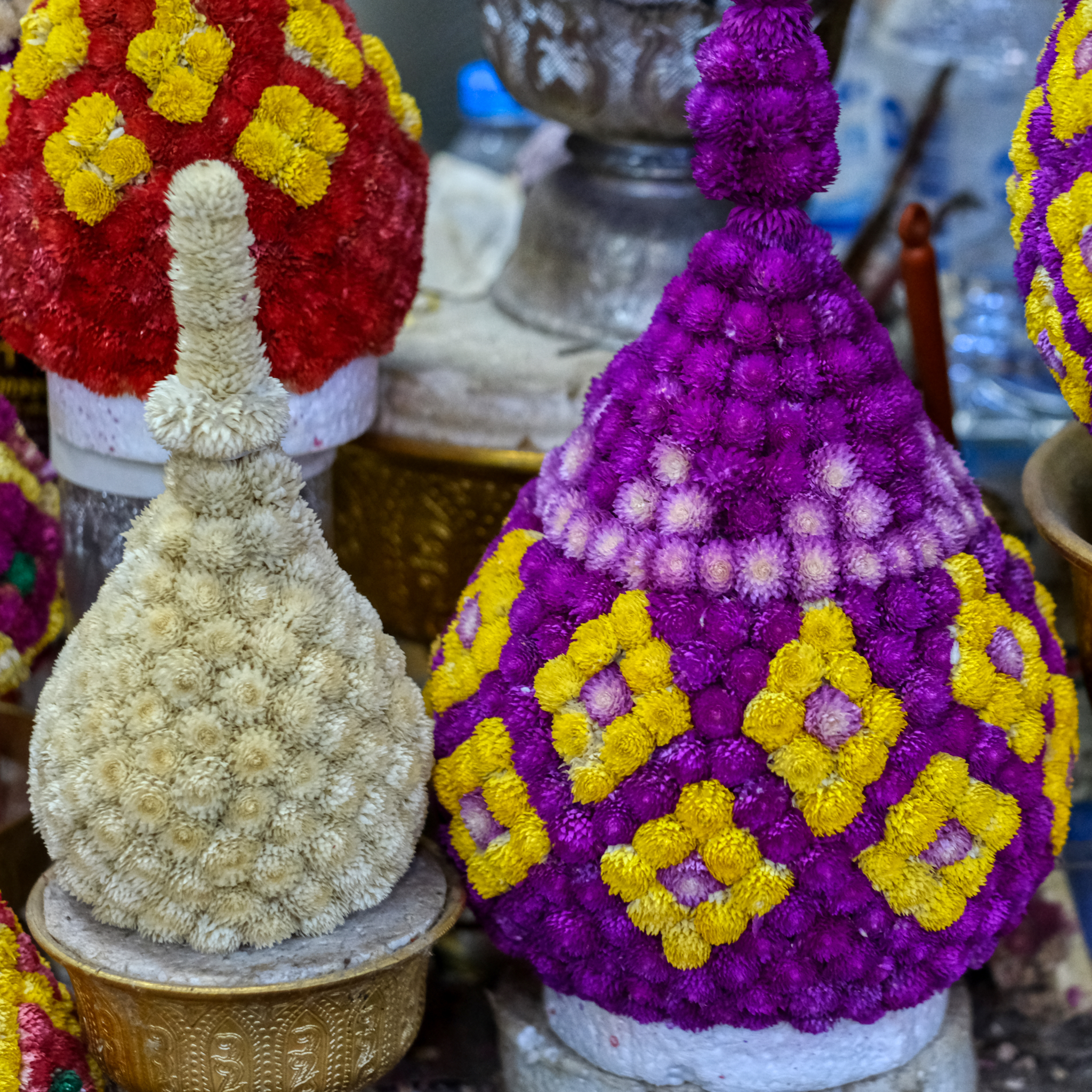 Many kinds and styles of Buddhist votive flower arrangements were being made everywhere.
Many kinds and styles of Buddhist votive flower arrangements were being made everywhere.
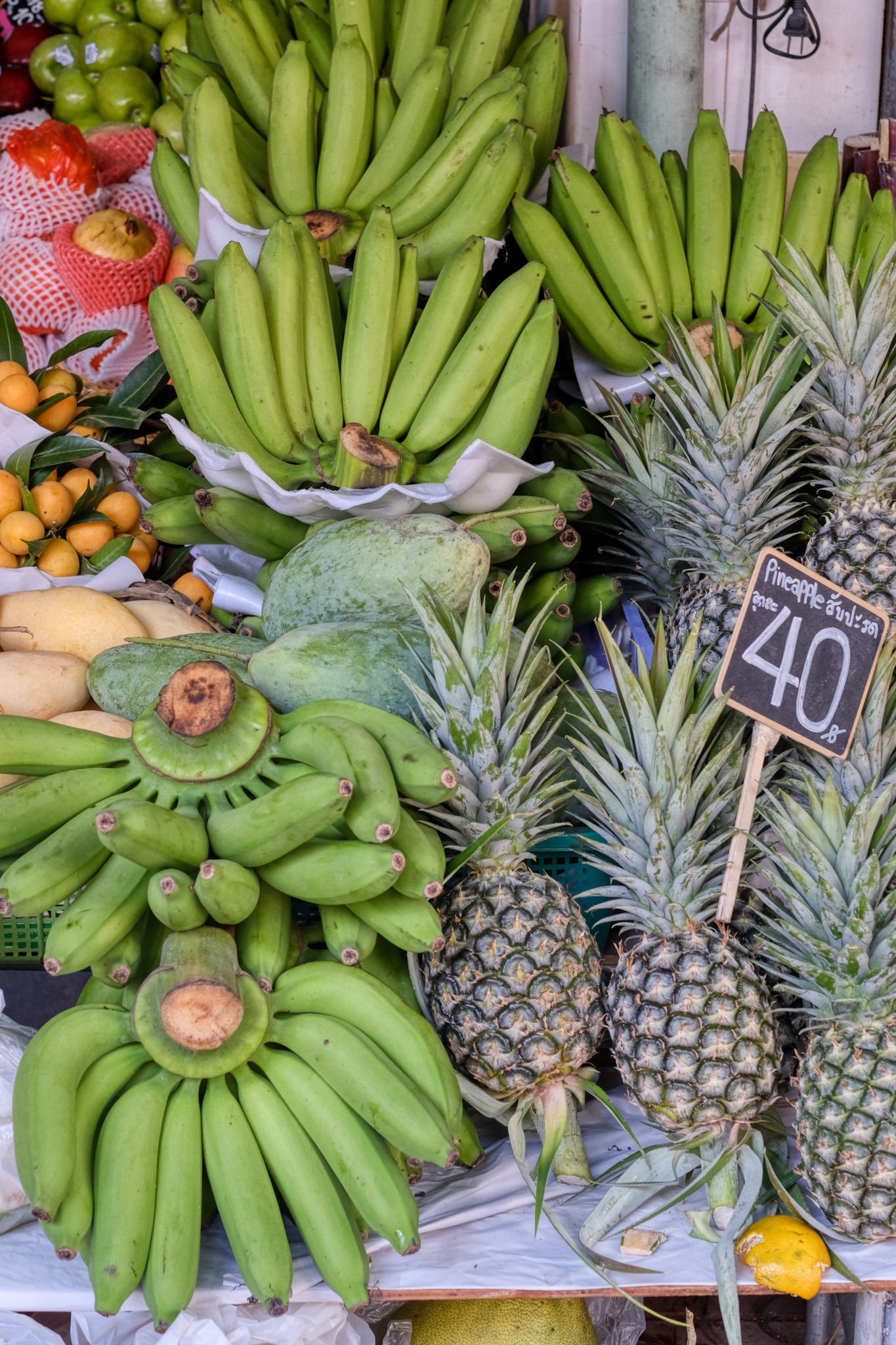 The market has more than flowers for sale . . . fruit for the hundreds, if not thousands of flower market workers.
The market has more than flowers for sale . . . fruit for the hundreds, if not thousands of flower market workers.
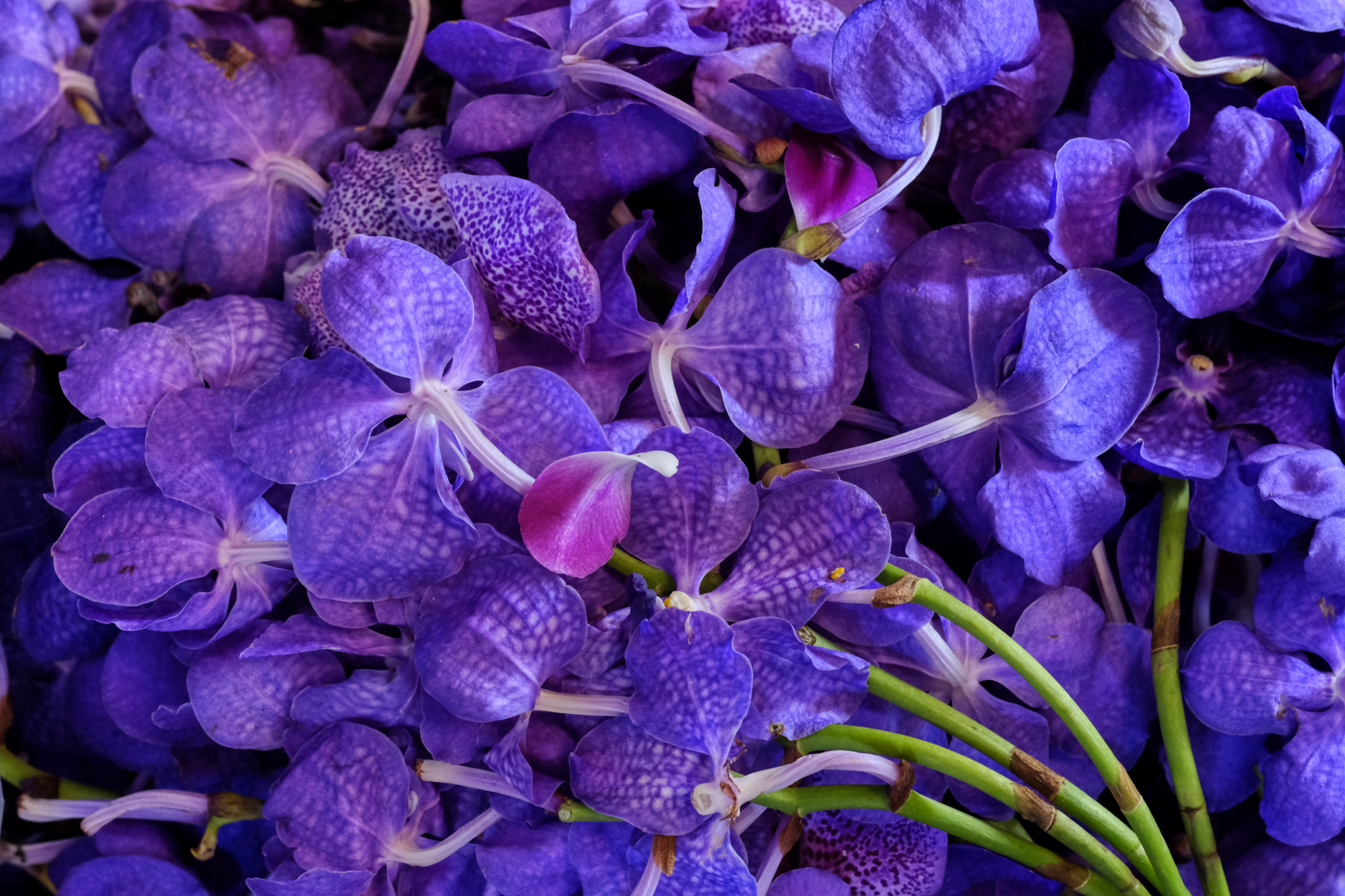 But, of course, it is the flowers that amaze a visitor to the flower market. Orchids everywhere!
But, of course, it is the flowers that amaze a visitor to the flower market. Orchids everywhere!
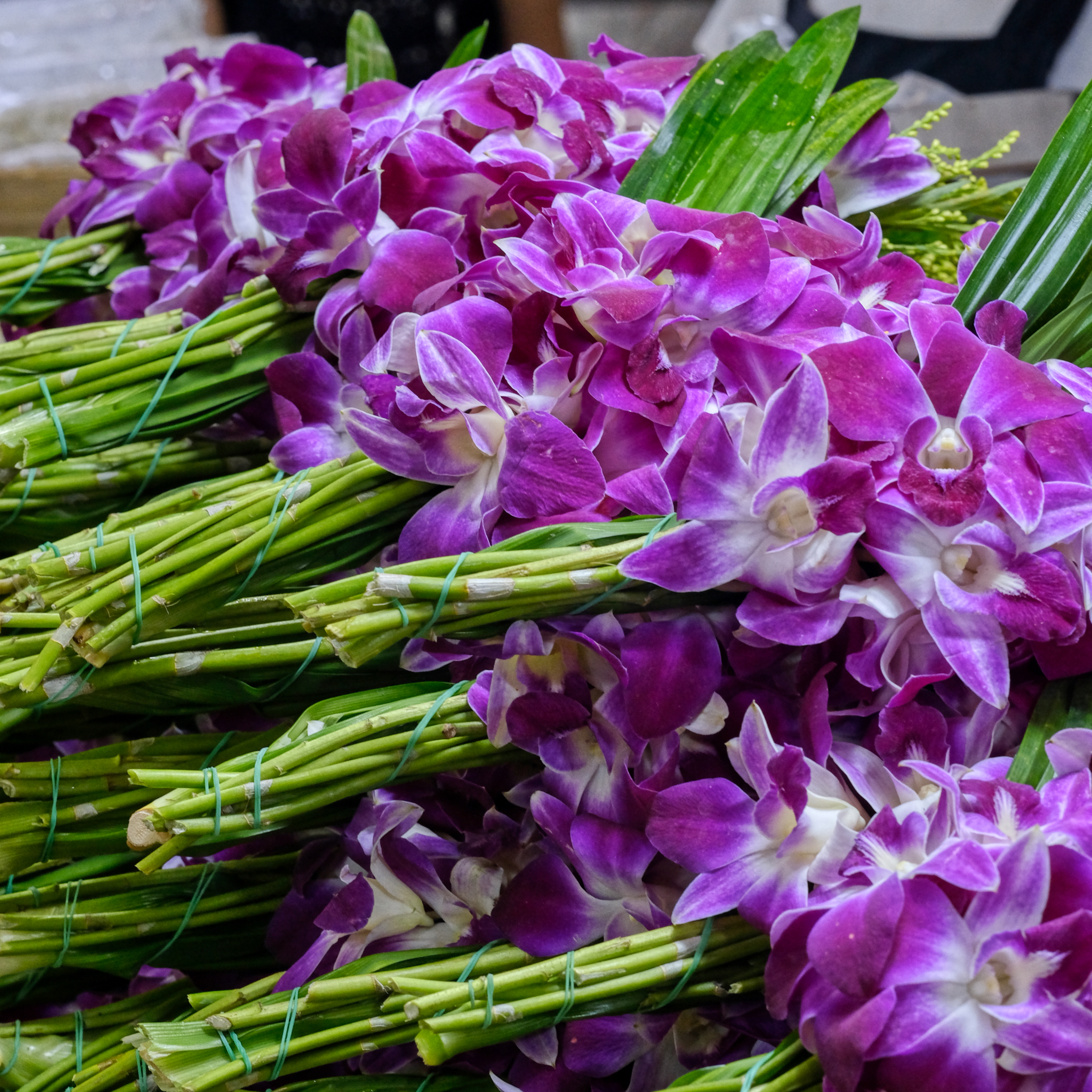 Thailand's hot and humid climate means that orchids grow outside all year long. Just nail one on a tree and it grows!
Thailand's hot and humid climate means that orchids grow outside all year long. Just nail one on a tree and it grows!
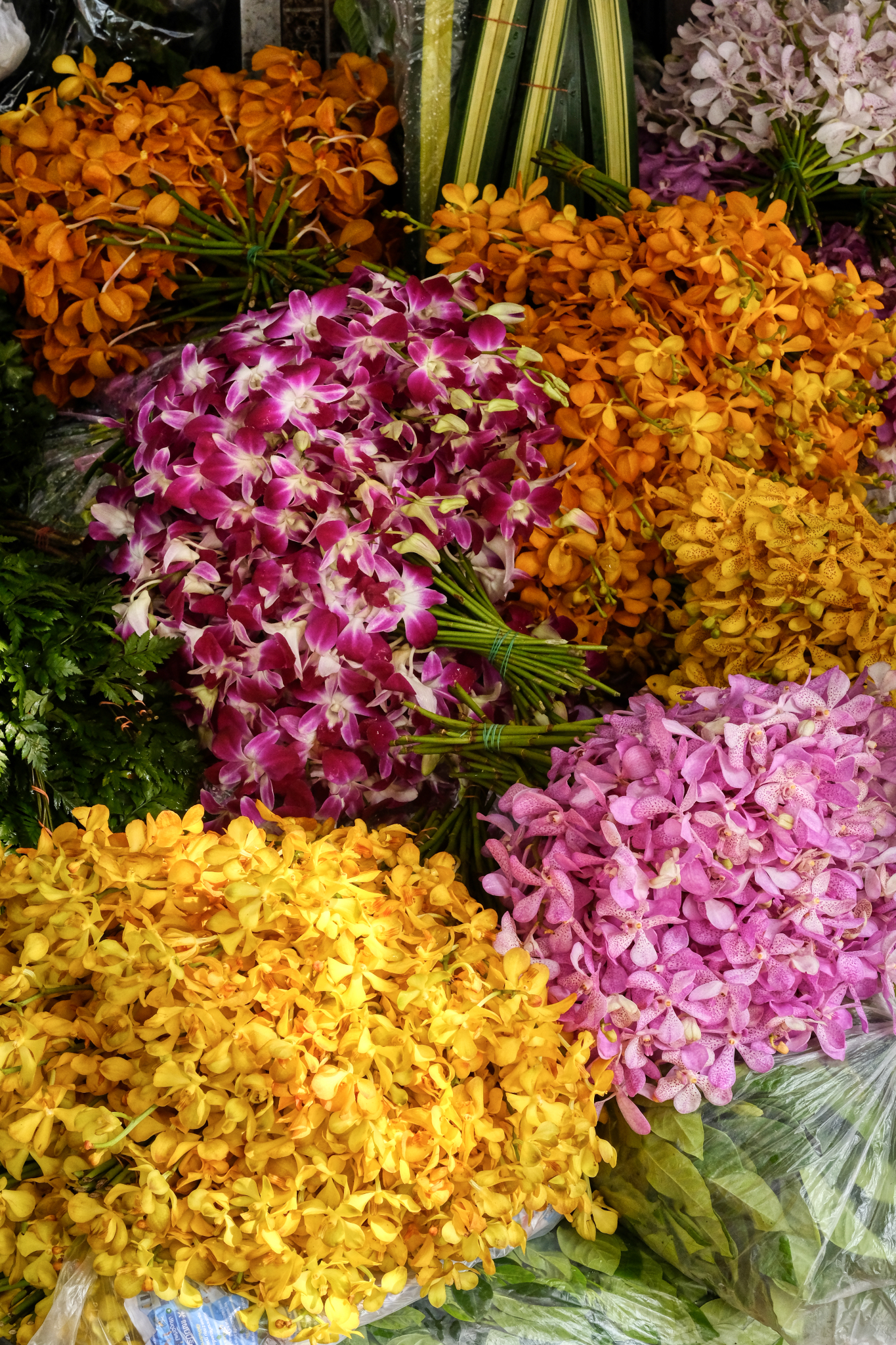 Orchids come in every color of the rainbow . . .
Orchids come in every color of the rainbow . . .
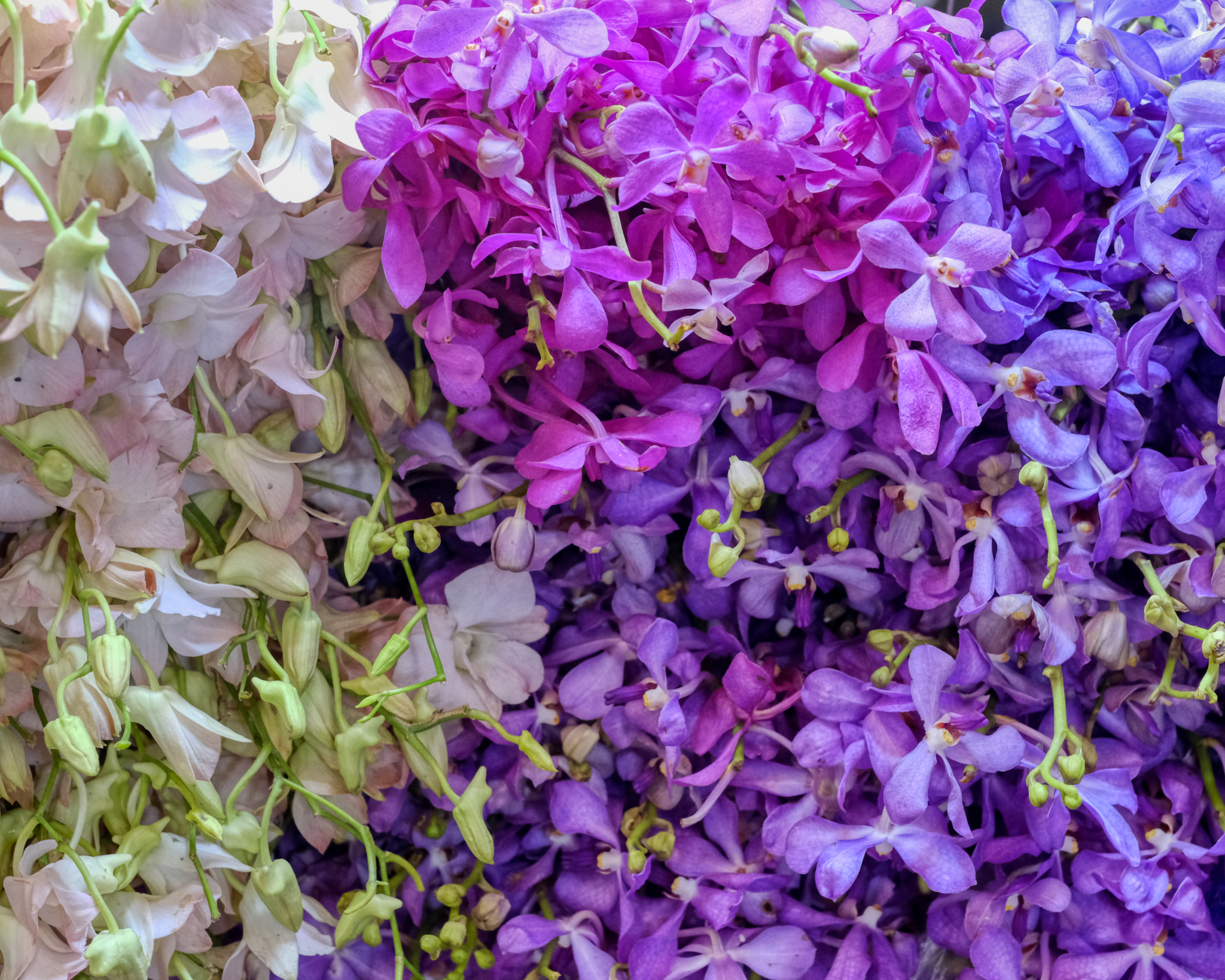 Exquisite orchids.
Exquisite orchids.
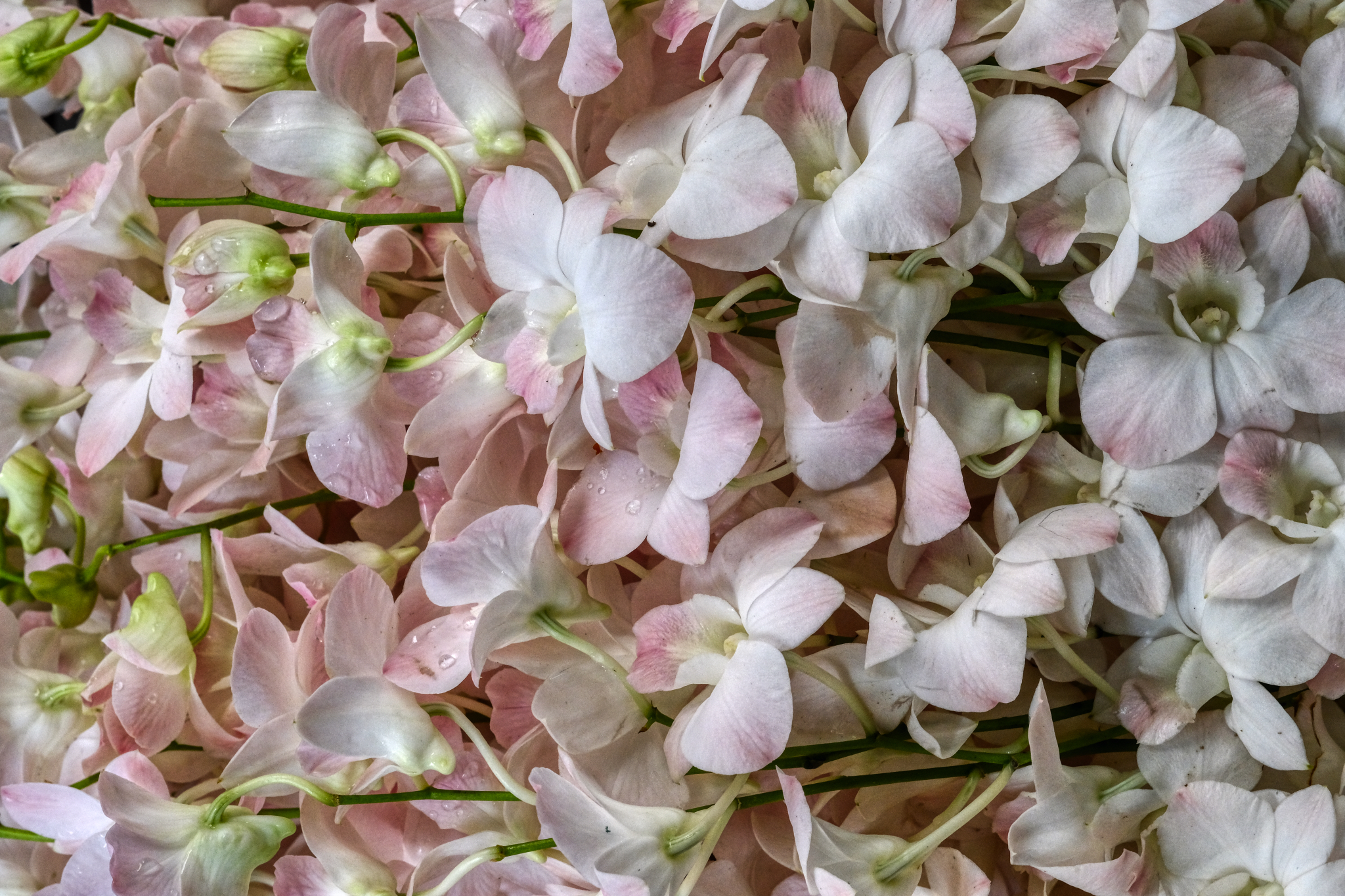 . . . including white orchids.
. . . including white orchids.
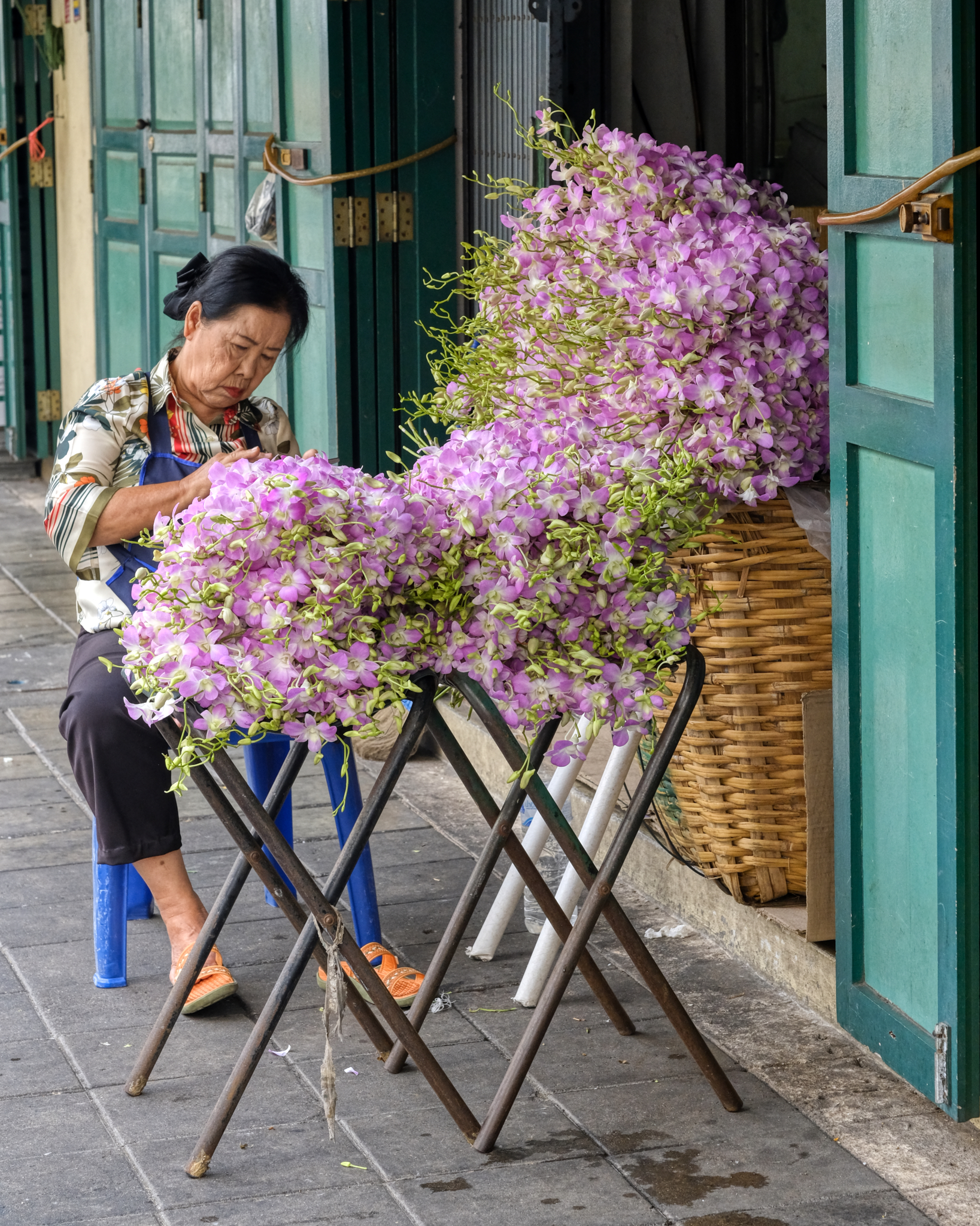 An orchid hawker tending her product.
An orchid hawker tending her product.
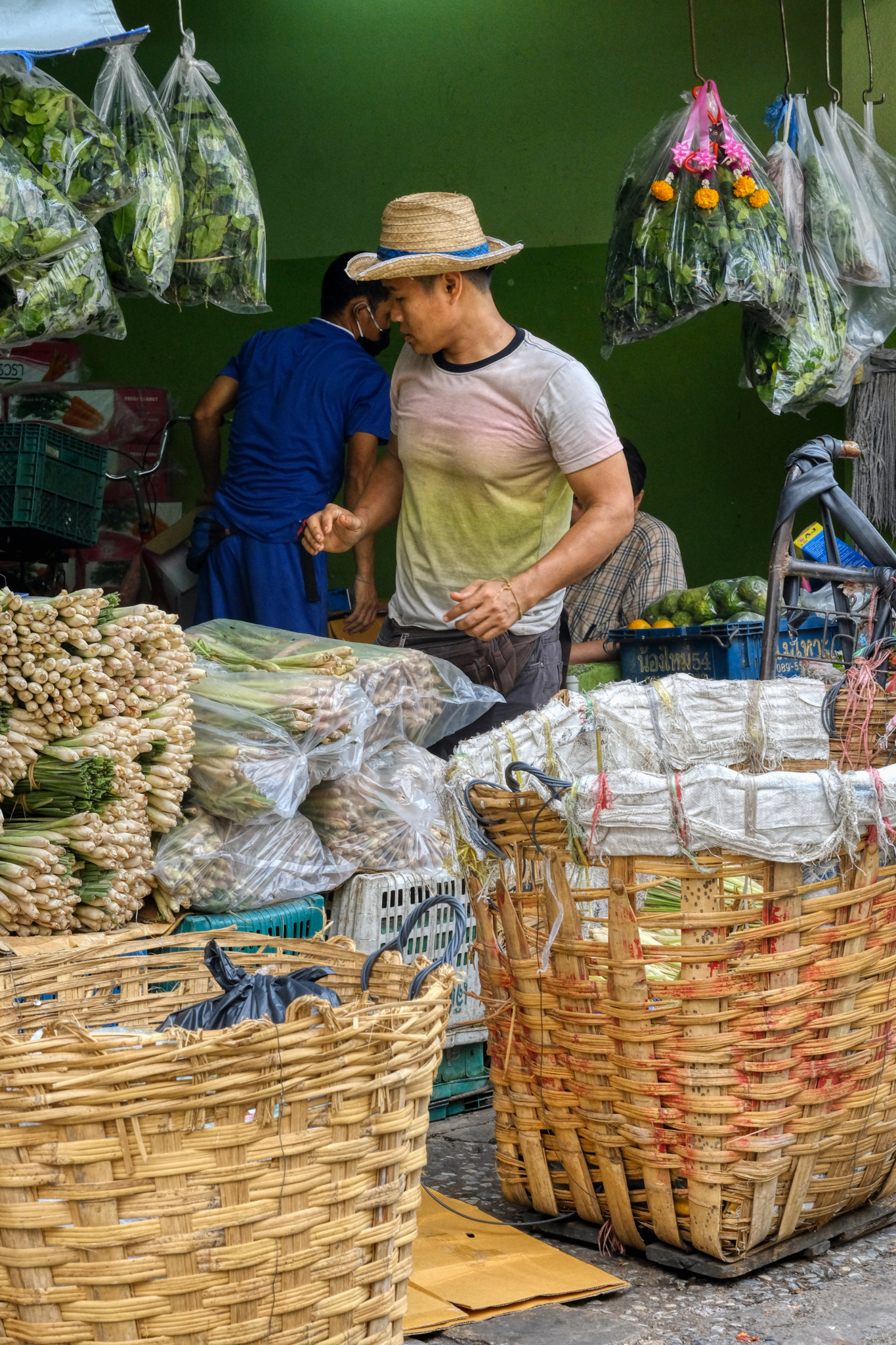 The flower market is also a good place to get people photos.
The flower market is also a good place to get people photos.
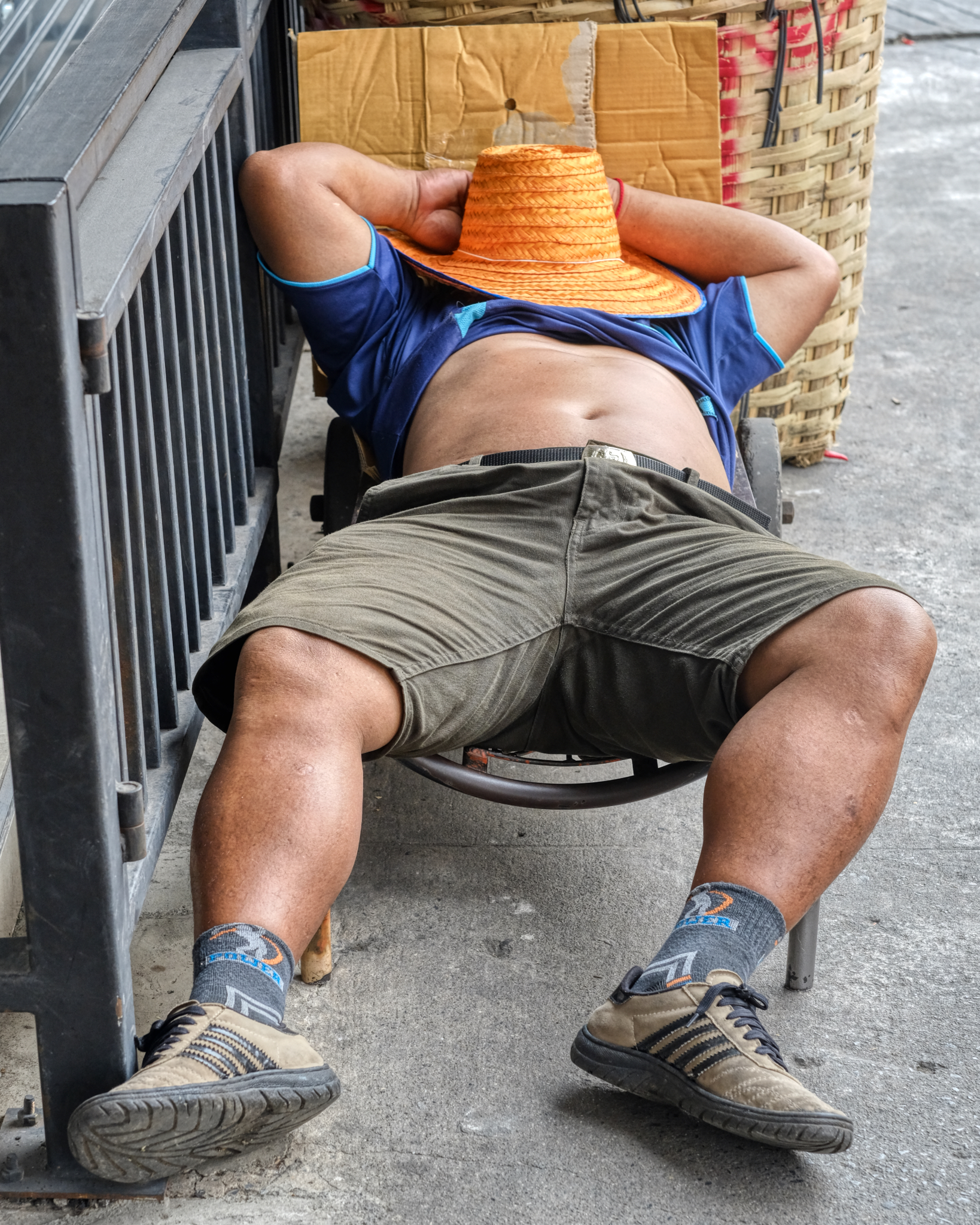 The market opens at 3:00am when the growers begin to bring in their flowers . . . and buyers begin to purchase and ship. This draymen looks tired!
The market opens at 3:00am when the growers begin to bring in their flowers . . . and buyers begin to purchase and ship. This draymen looks tired!
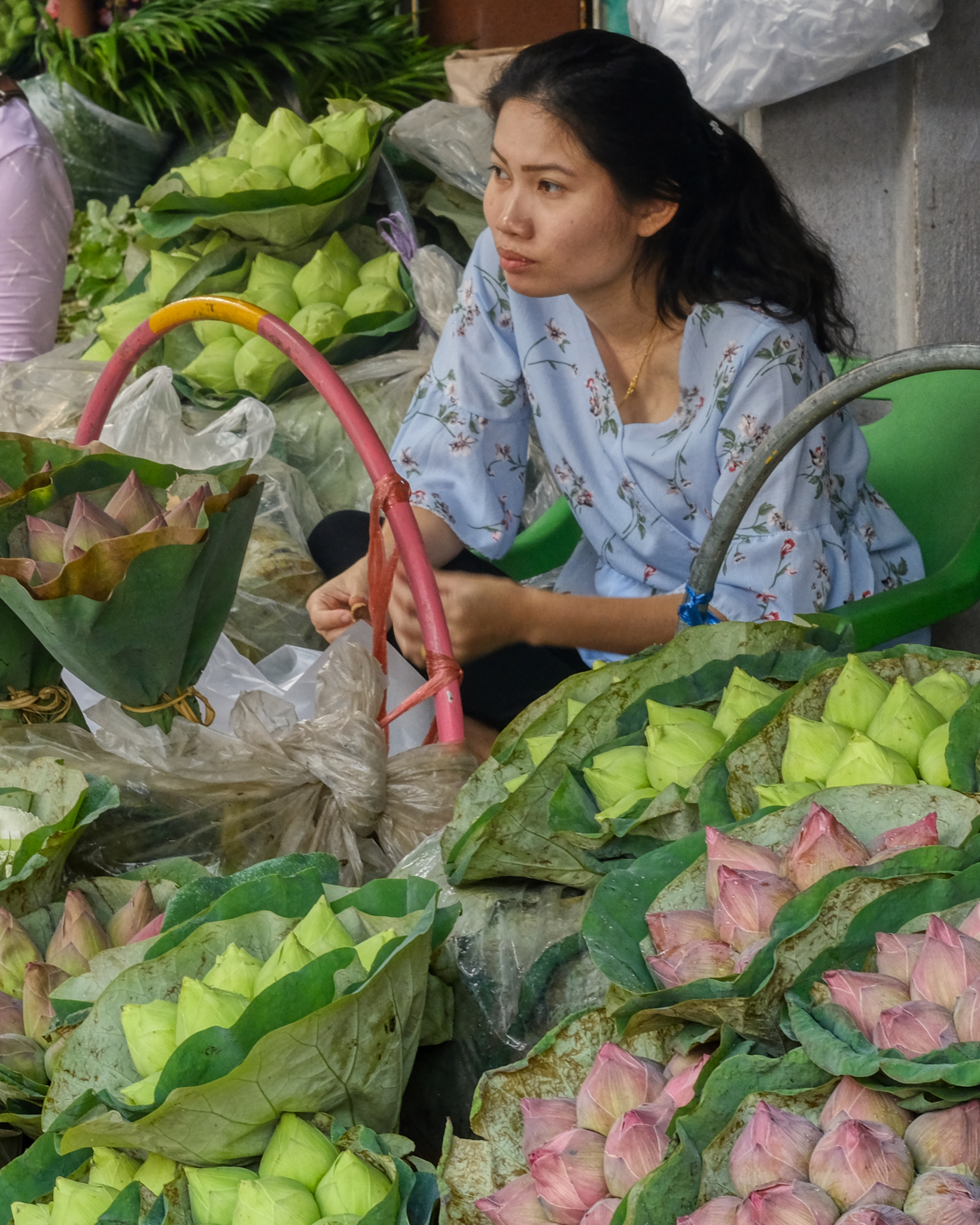 Hoping for a big sale.
Hoping for a big sale.
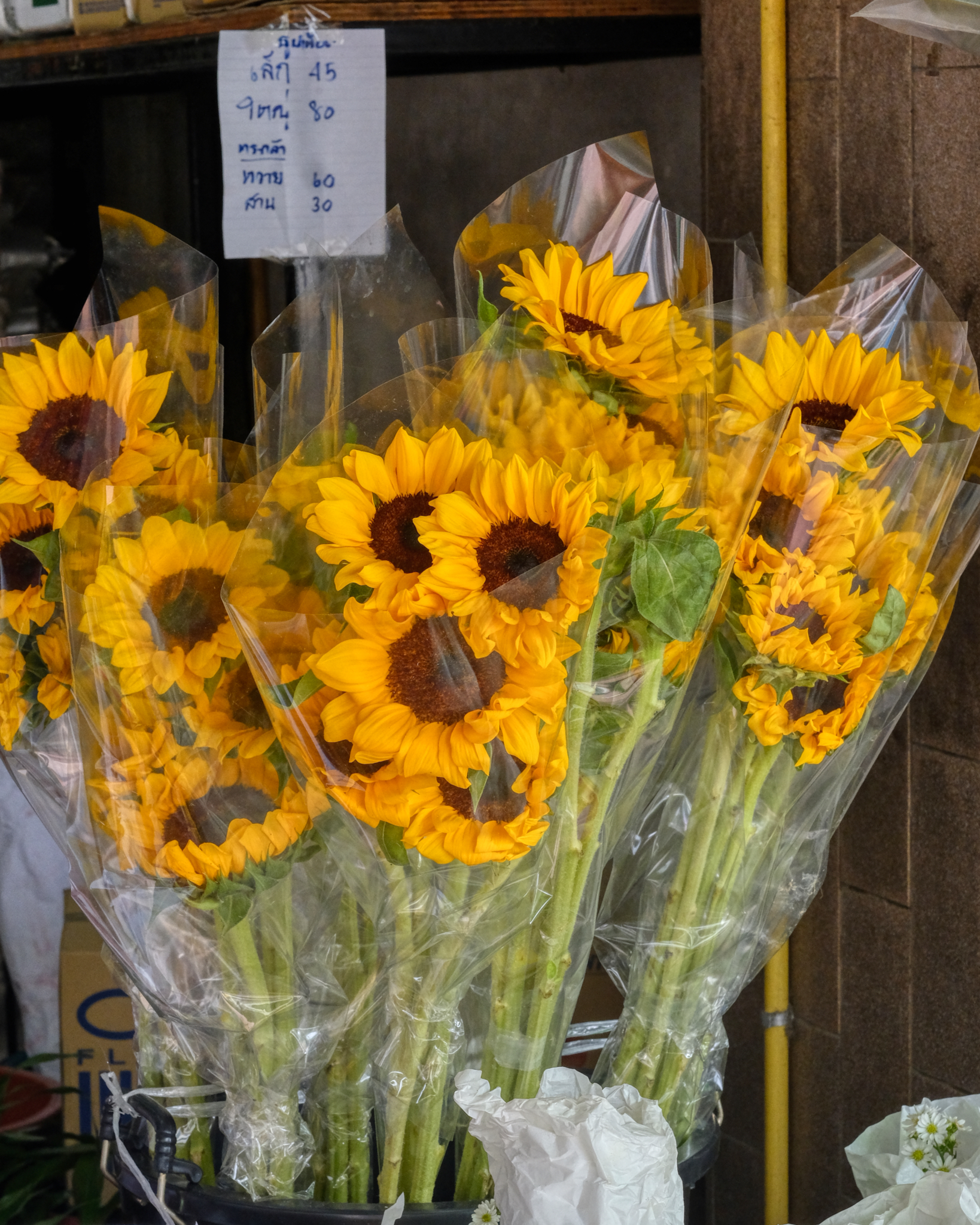 The kinds and varieties of flowers available for sale was staggering! These sunflowers are from Thailand.
The kinds and varieties of flowers available for sale was staggering! These sunflowers are from Thailand.
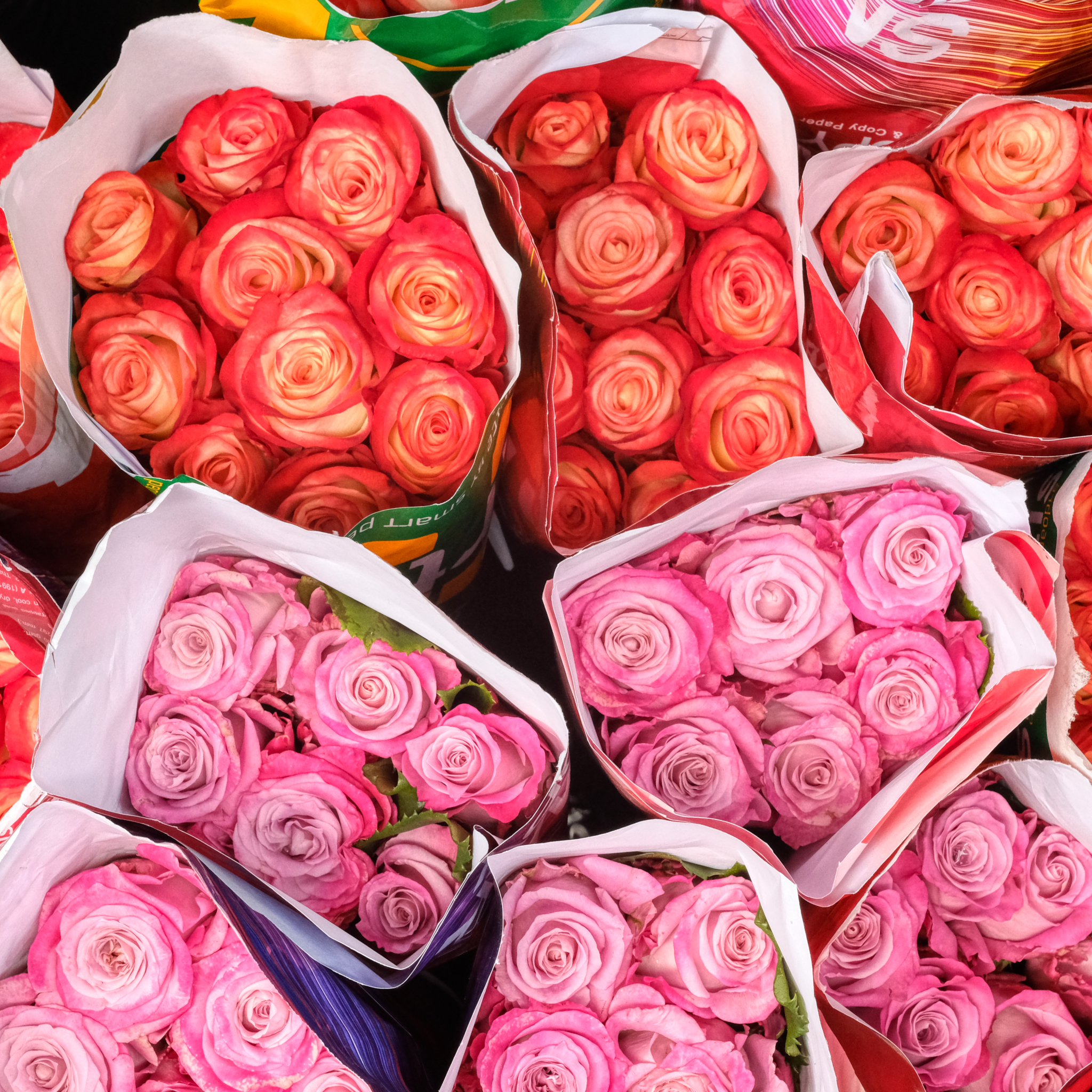 Roses, roses, roses . . .
Roses, roses, roses . . .
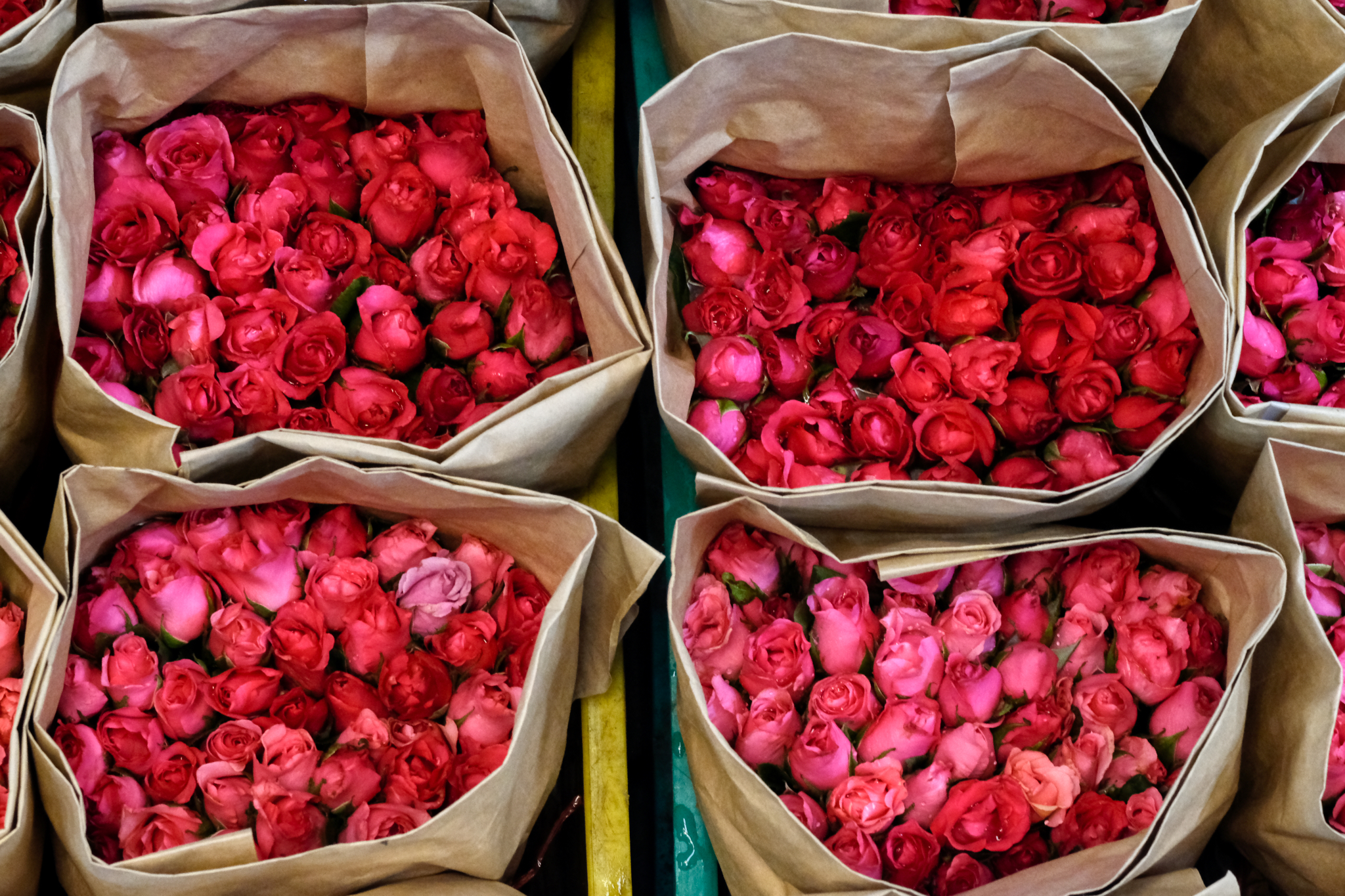 . . . roses, roses, roses . . .
. . . roses, roses, roses . . .
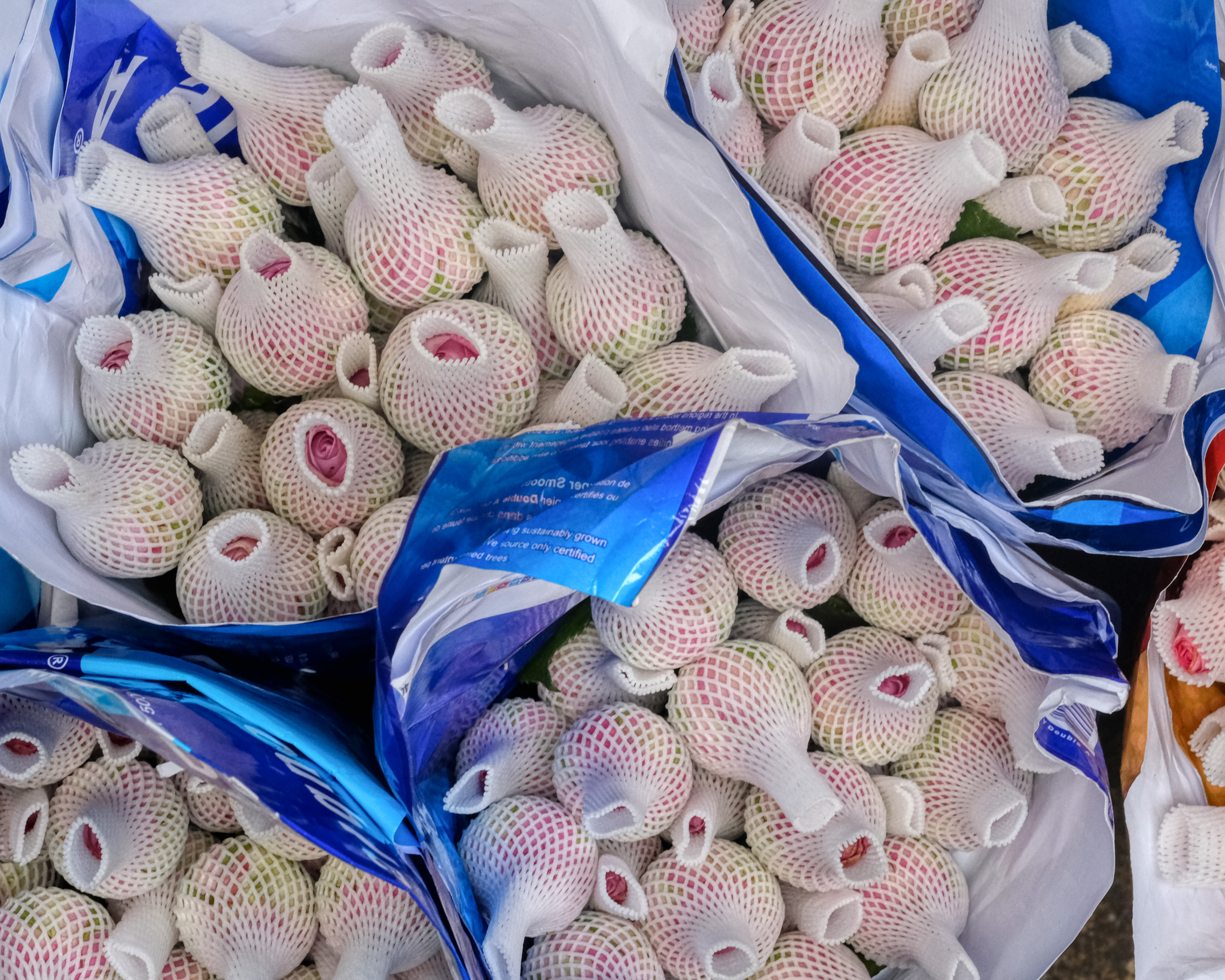 . . . and more roses. These wrapped roses were imported from Europe.
. . . and more roses. These wrapped roses were imported from Europe.
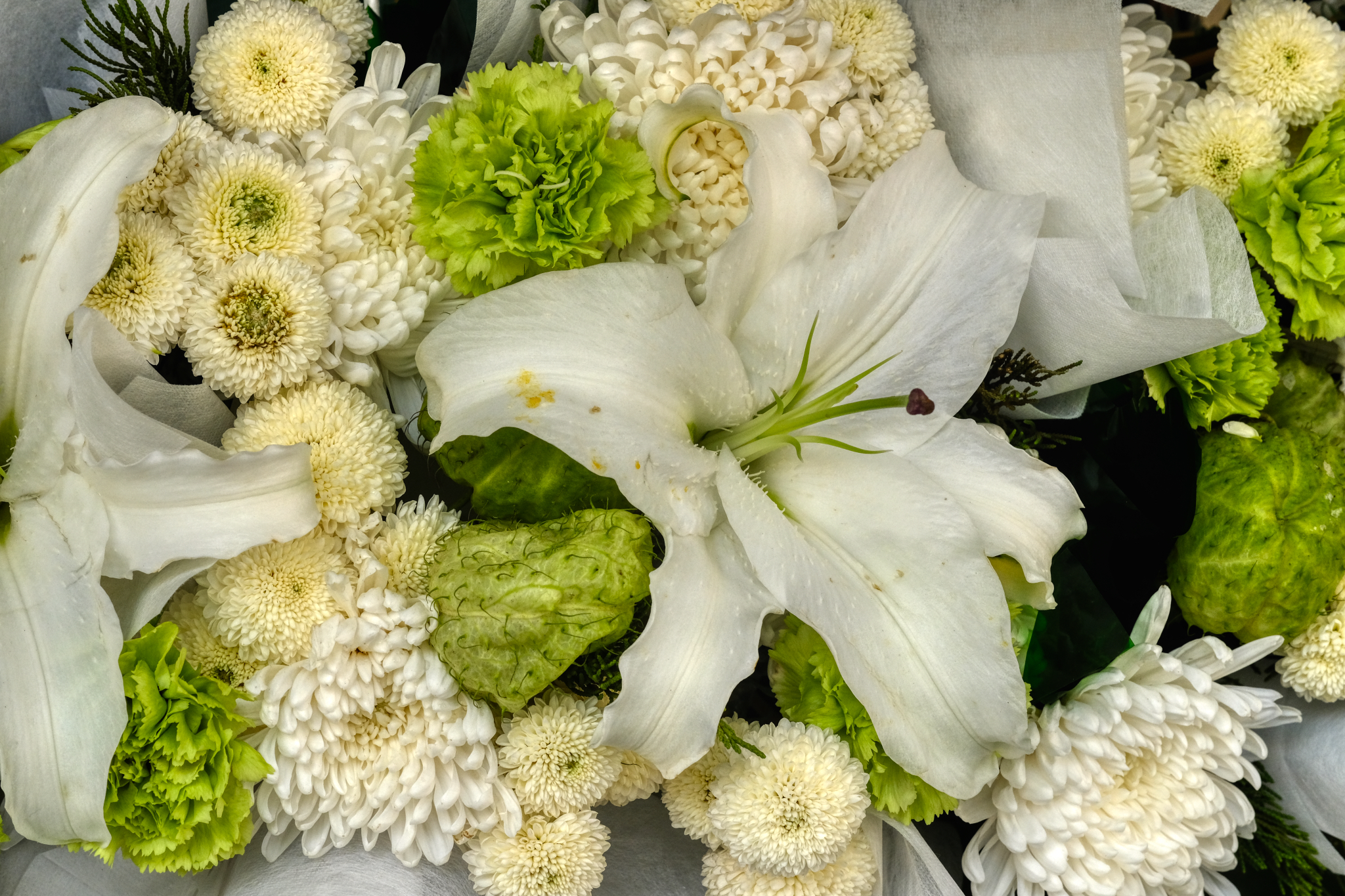 Some flowers were sold as already made arrangements, like this white lily ensemble.
Some flowers were sold as already made arrangements, like this white lily ensemble.
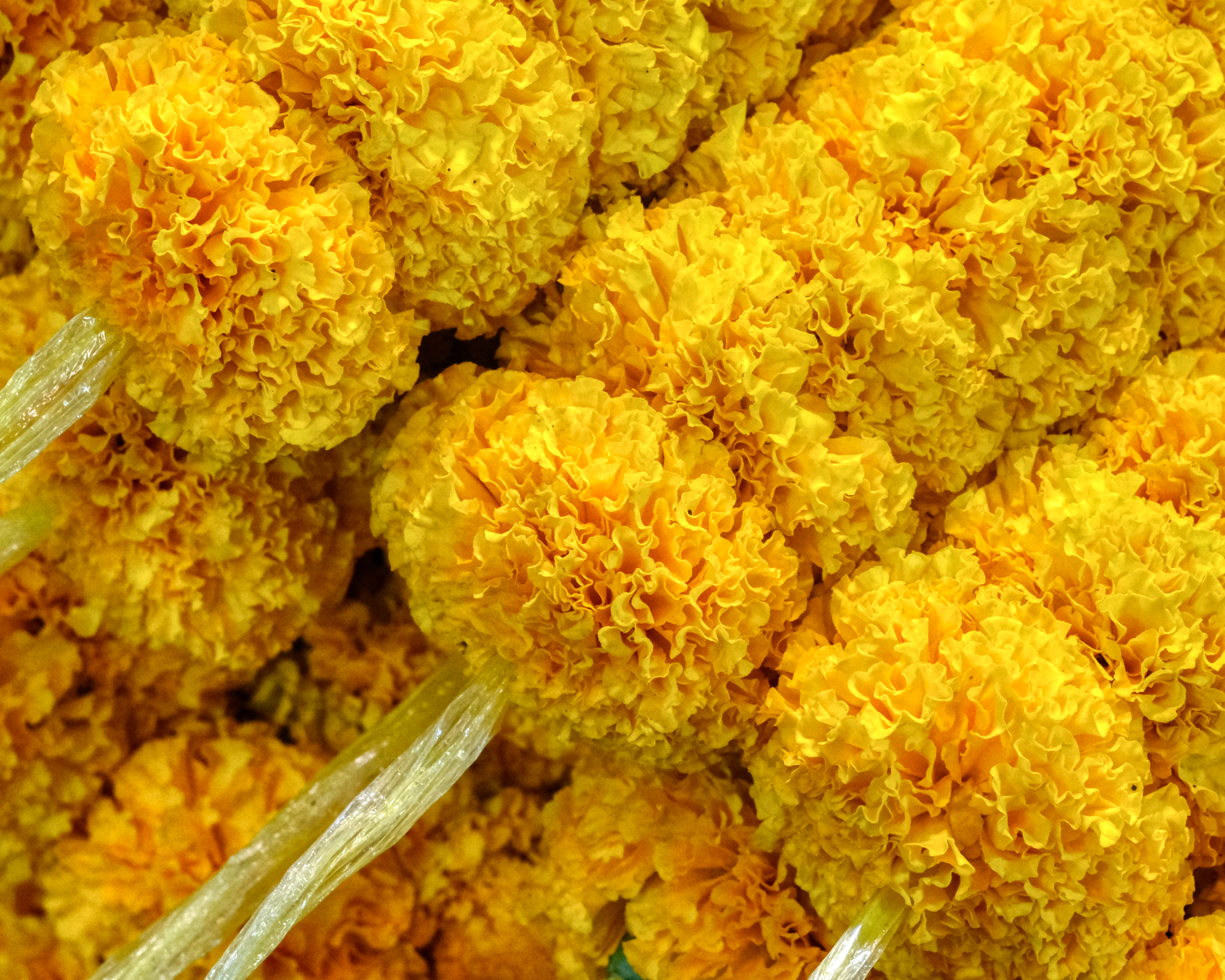 Marigold flowers sold on nylon strings.
Marigold flowers sold on nylon strings.
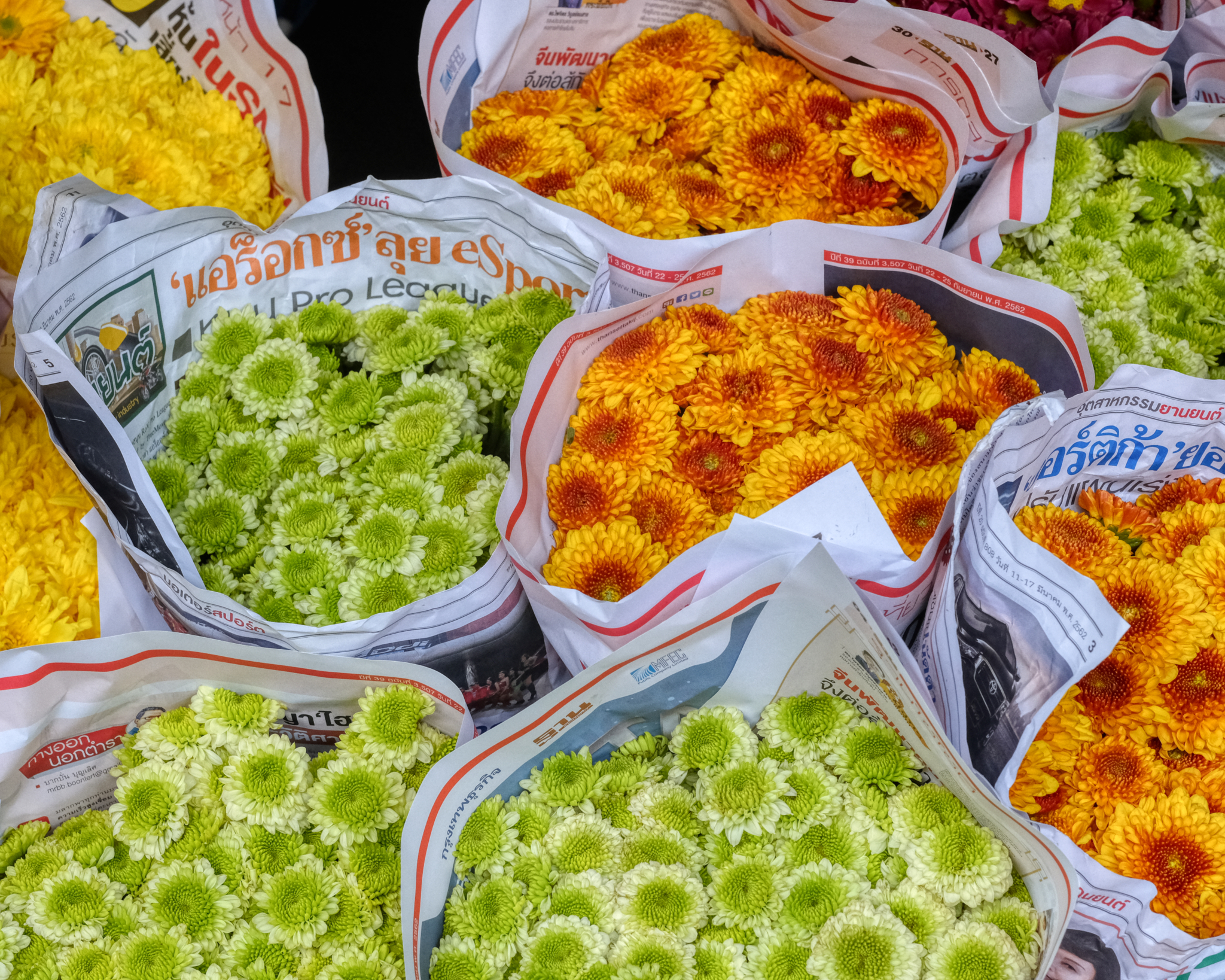 Such a beautiful and colorful array . . .
Such a beautiful and colorful array . . .
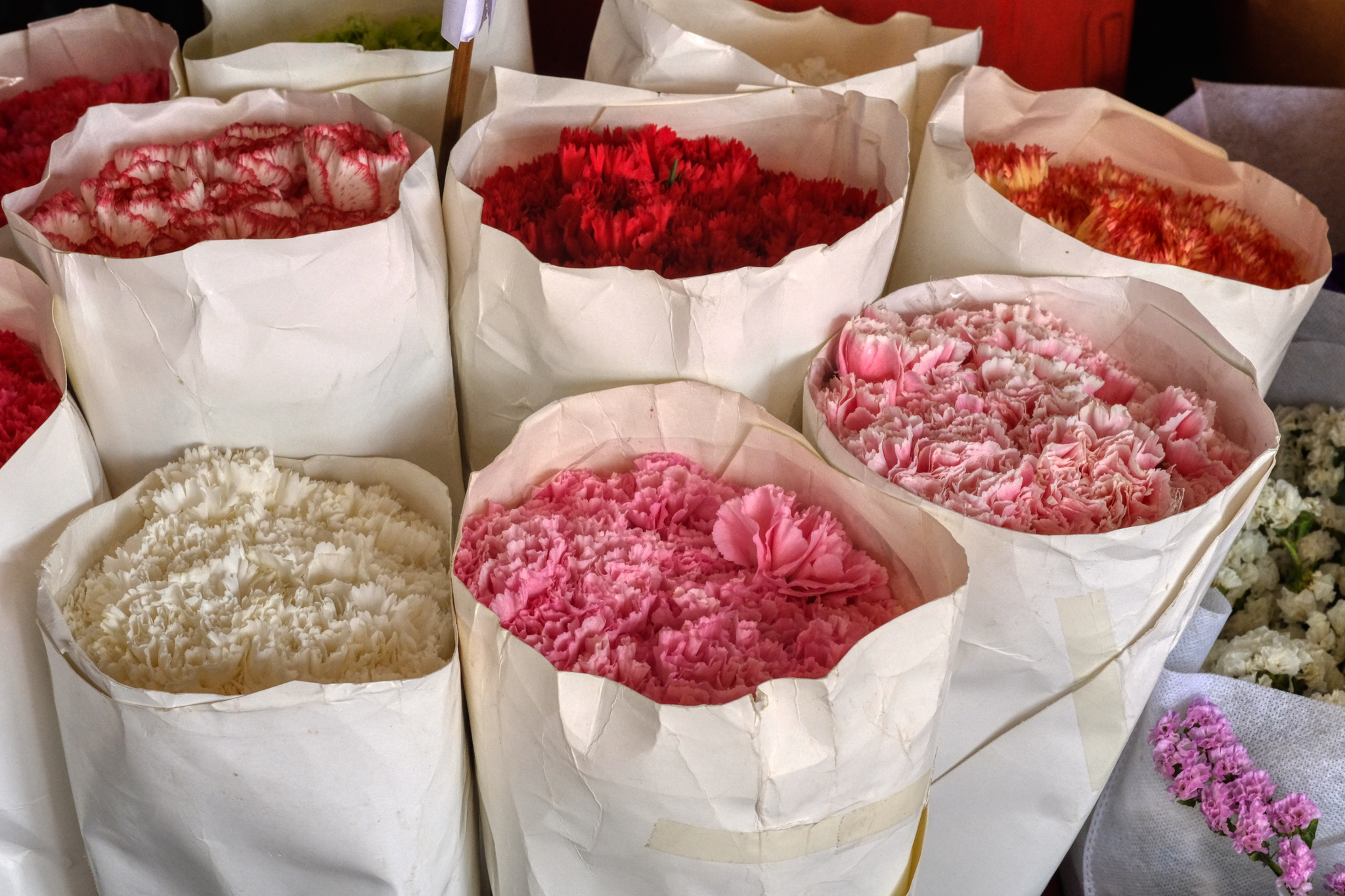 Although the light in the market was not ideal for flower photography, every once in a while there was magic light!
Although the light in the market was not ideal for flower photography, every once in a while there was magic light!
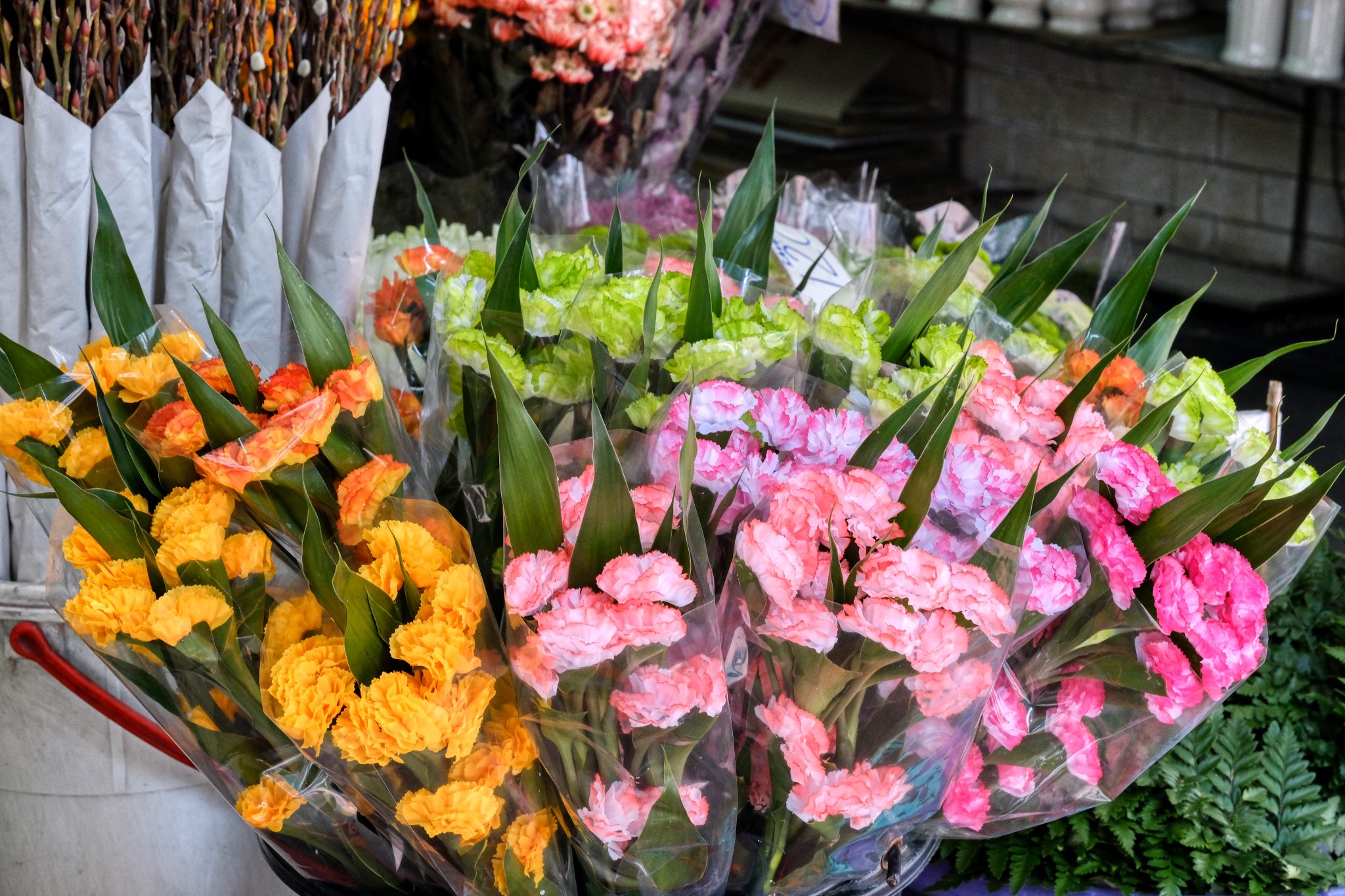 Pretty little things!
Pretty little things!
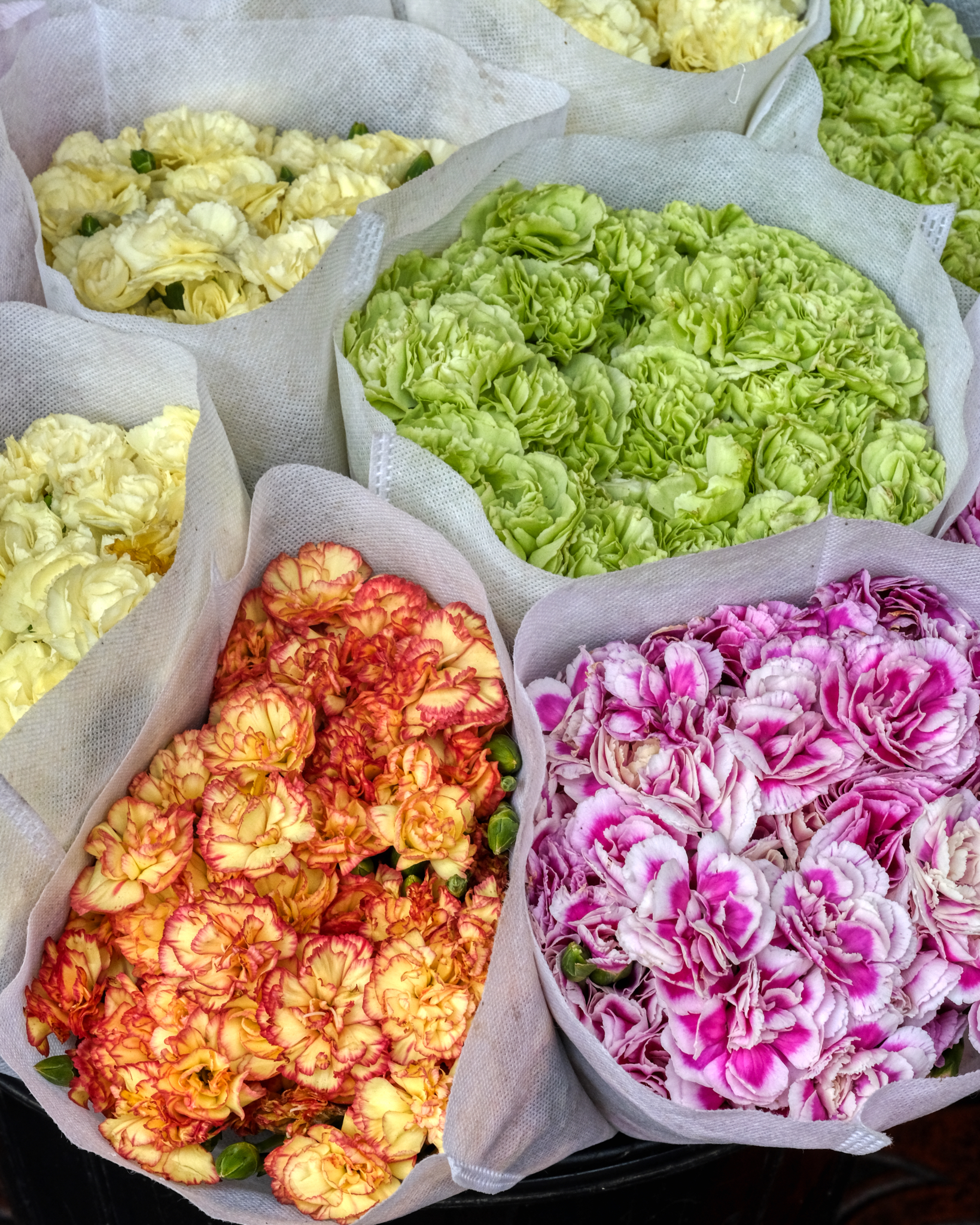 Bunches and bunches of flowers.
Bunches and bunches of flowers.
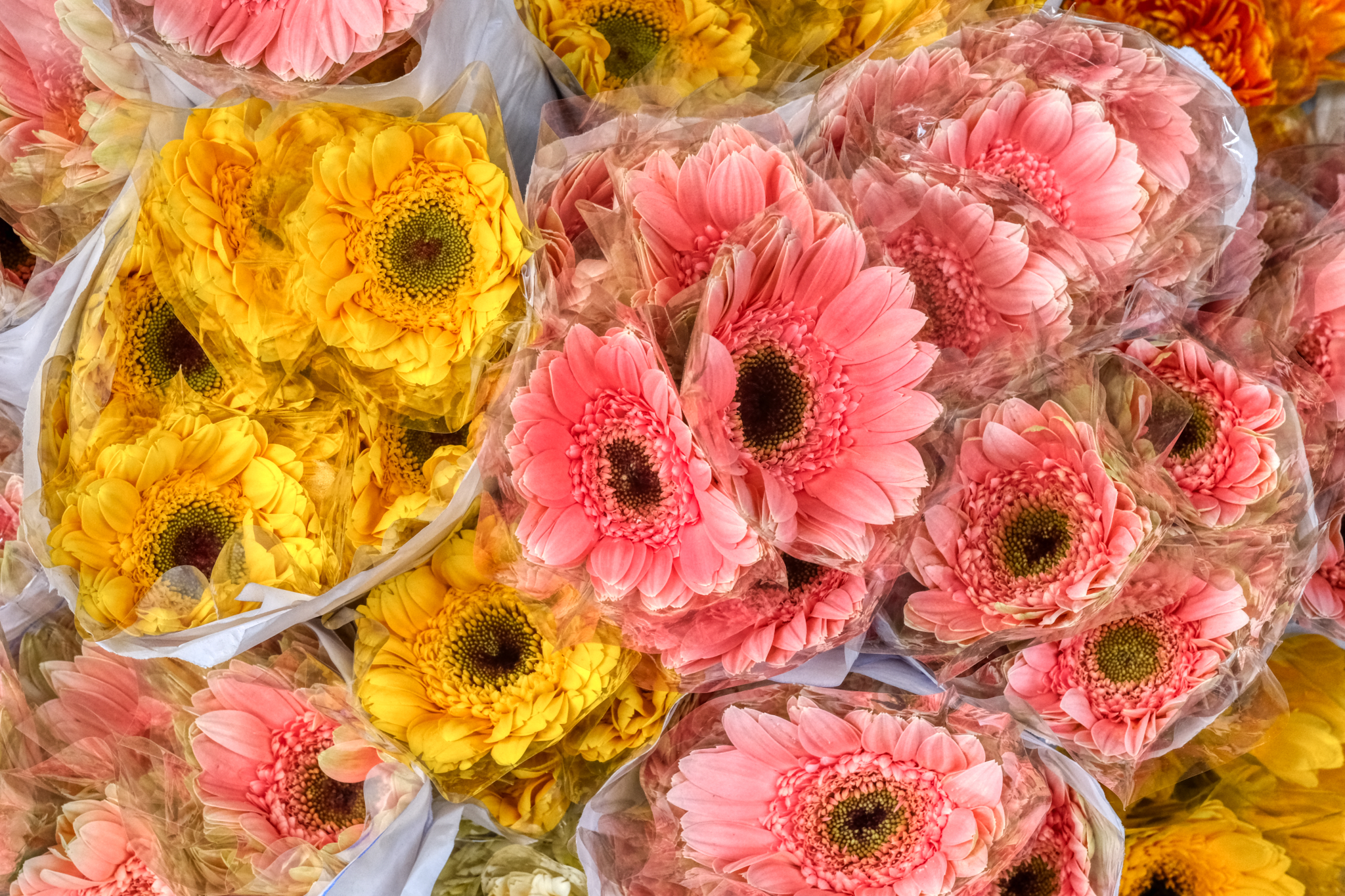 And bundles and bundles of beautiful flowers.
And bundles and bundles of beautiful flowers.
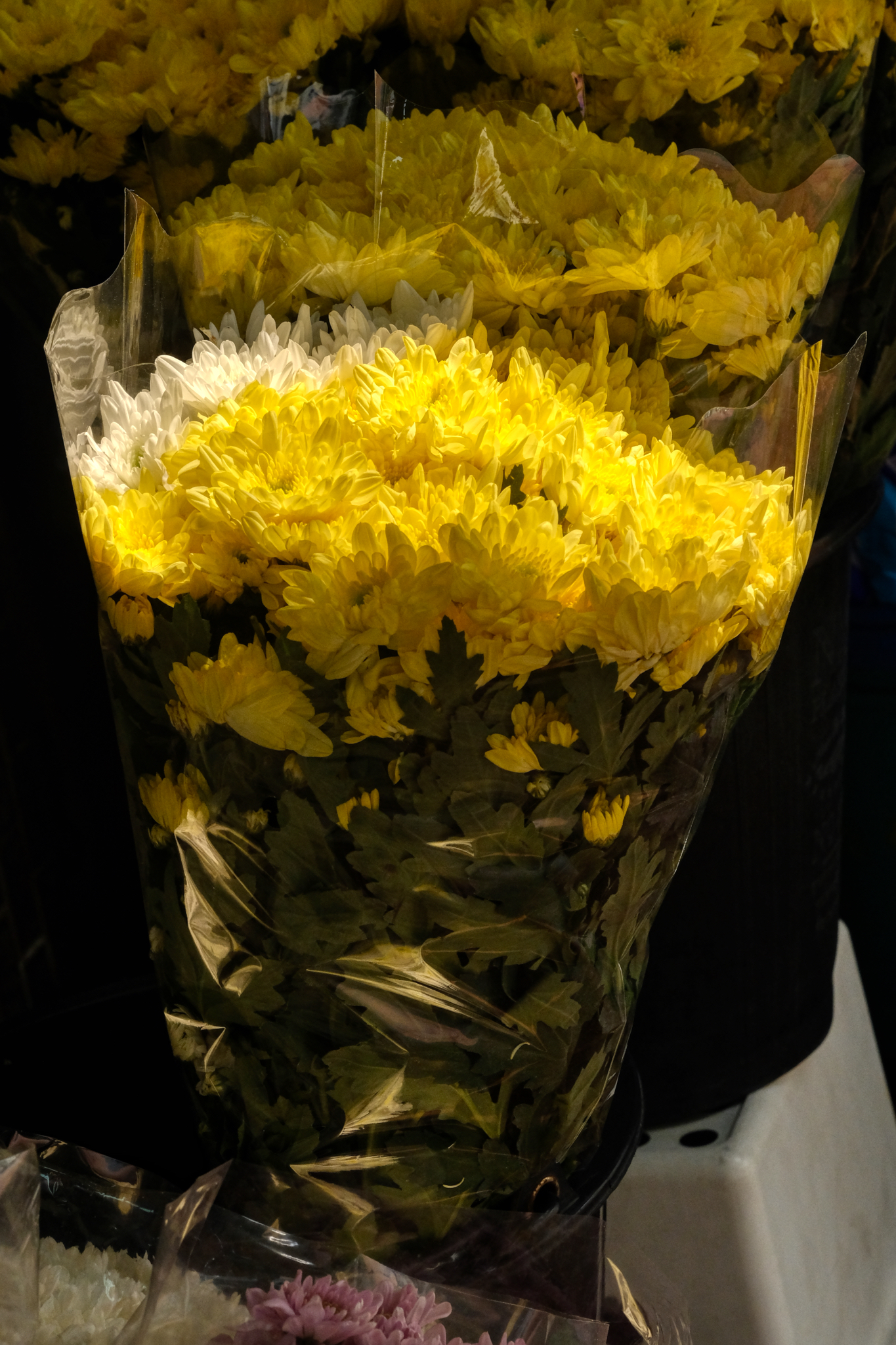 And this extraordinary bouquet!
And this extraordinary bouquet!
 Individually hand-wrapped chrysanthemums.
Individually hand-wrapped chrysanthemums.
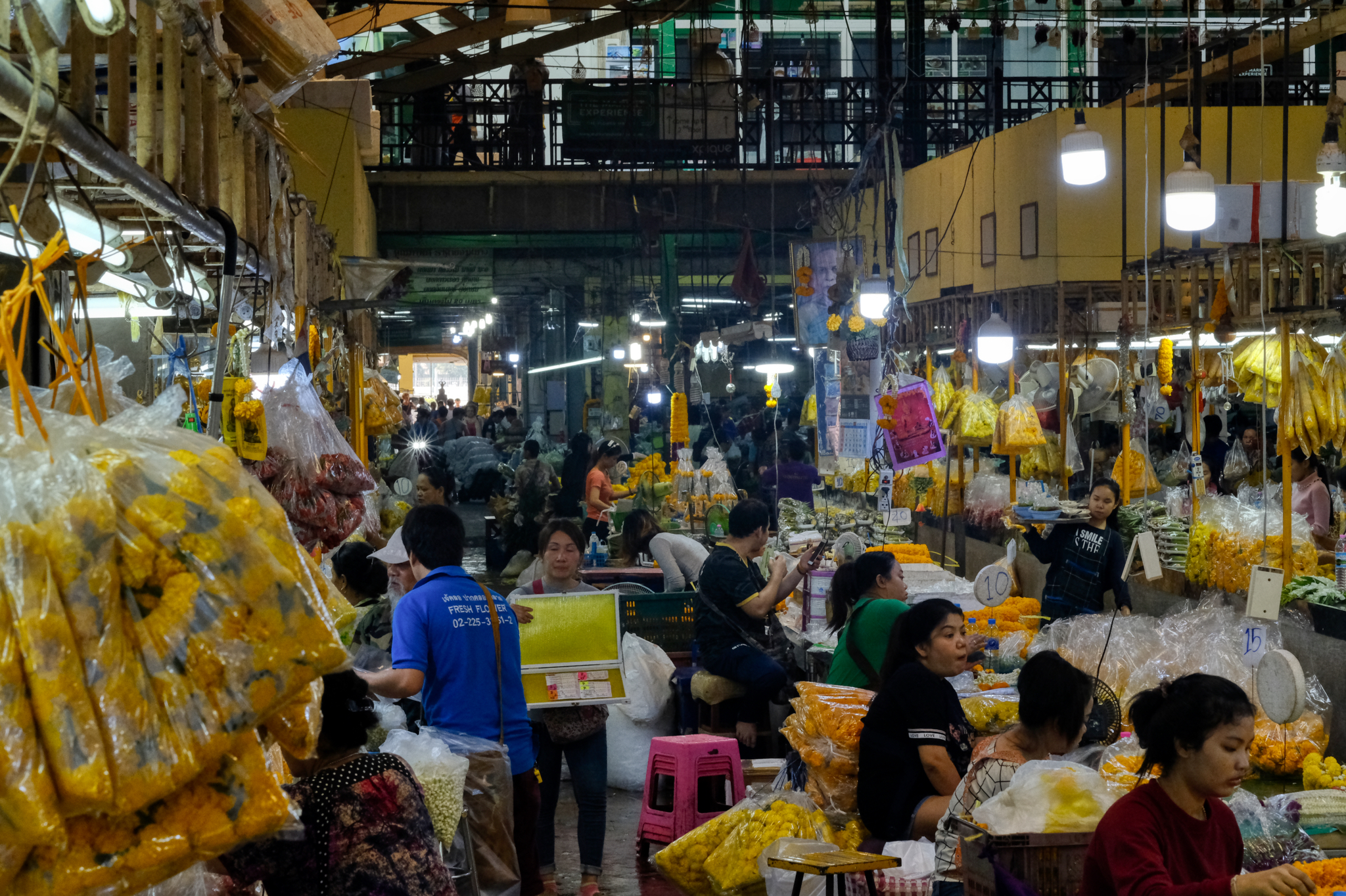 Inside the flower market. This was at around 9:30am and lots of the stalls were already closed . . . sold out.
Inside the flower market. This was at around 9:30am and lots of the stalls were already closed . . . sold out.
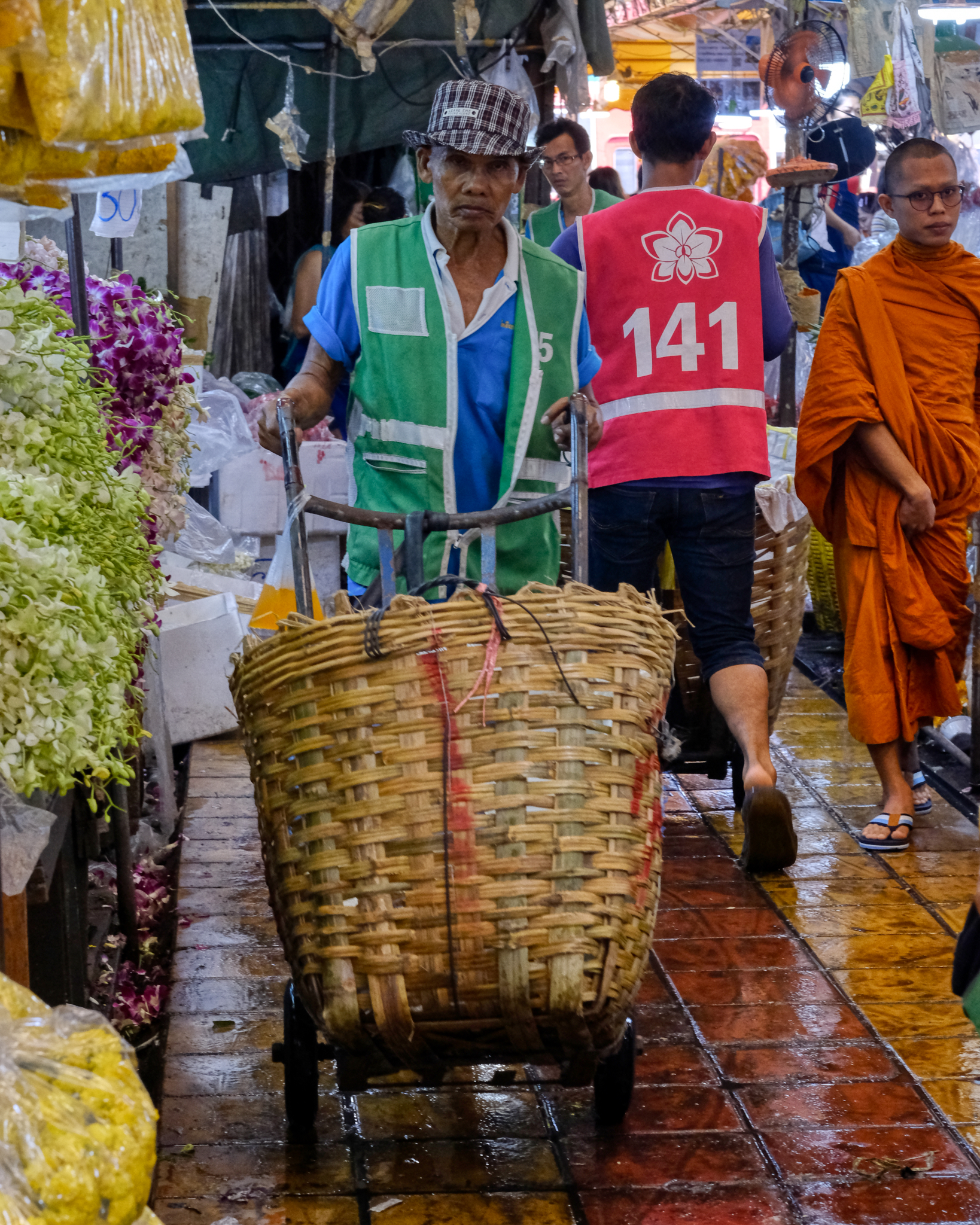 A market draymen moving purchases out of the market to waiting tuk-tuk delivery.
A market draymen moving purchases out of the market to waiting tuk-tuk delivery.
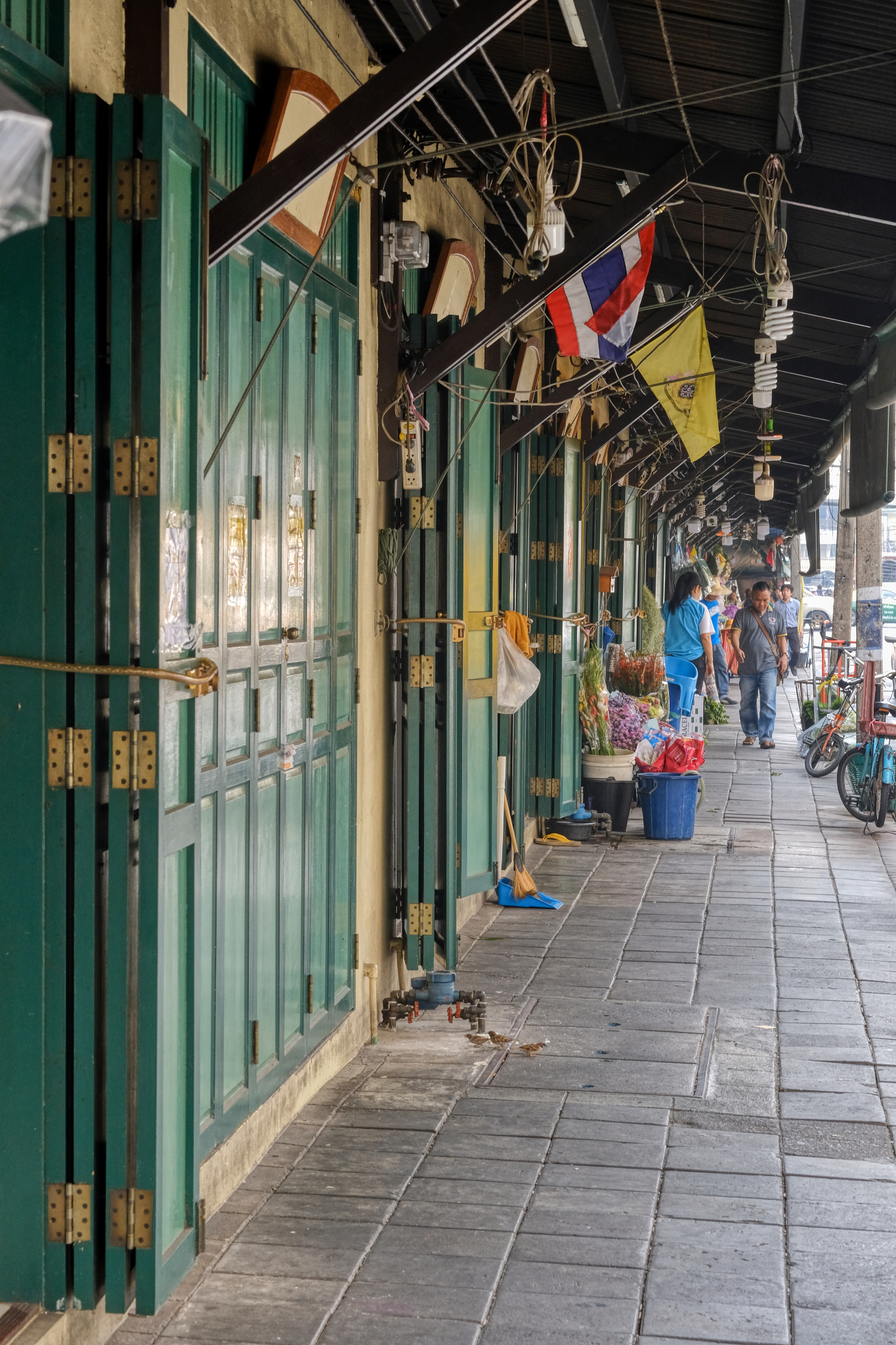 The area around the flower is made up of many rows of old shop houses.
The area around the flower is made up of many rows of old shop houses.
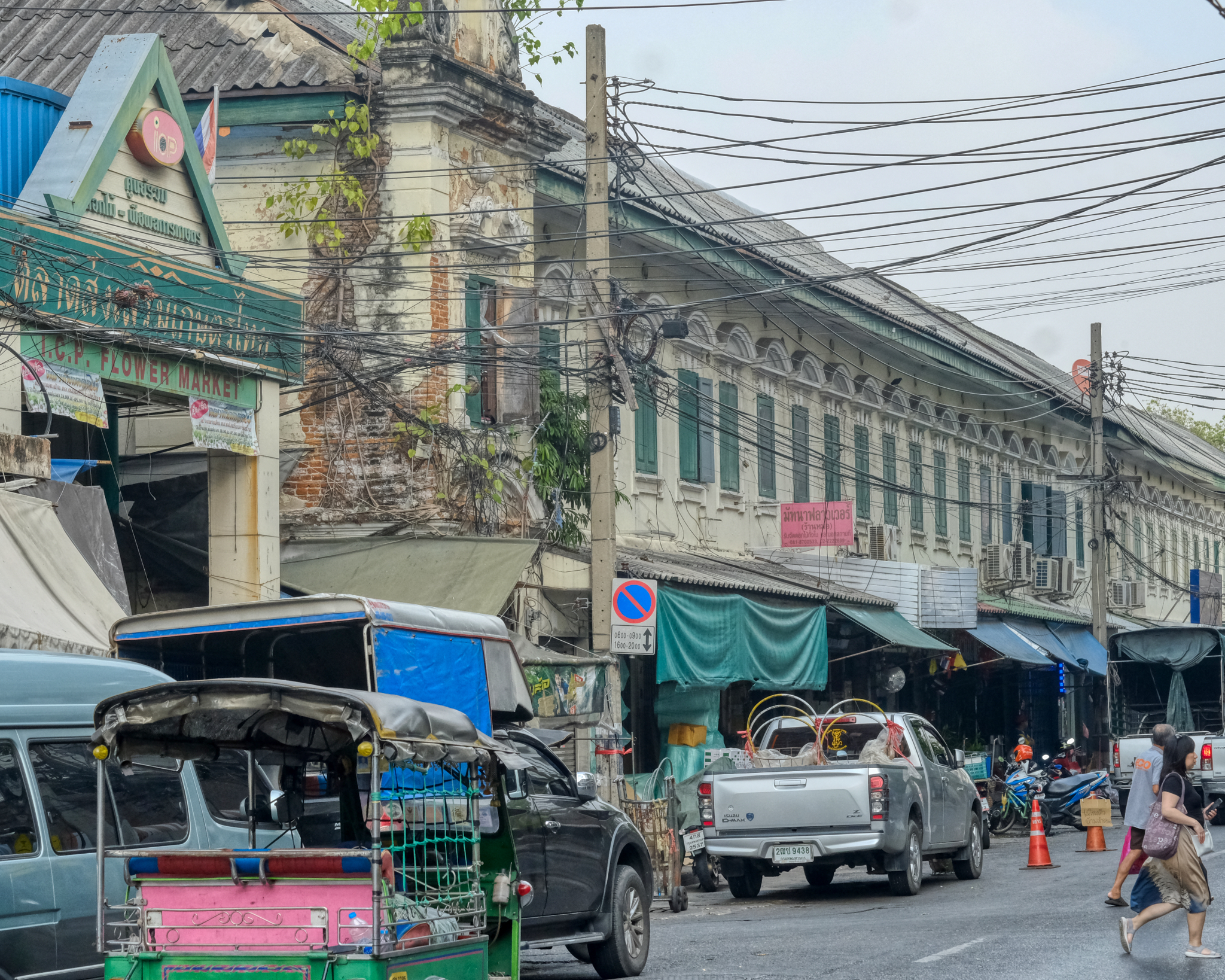 The flower market is in a very old part of Bangkok, not far from the Chao River and just north of the Chinatown district.
The flower market is in a very old part of Bangkok, not far from the Chao River and just north of the Chinatown district.
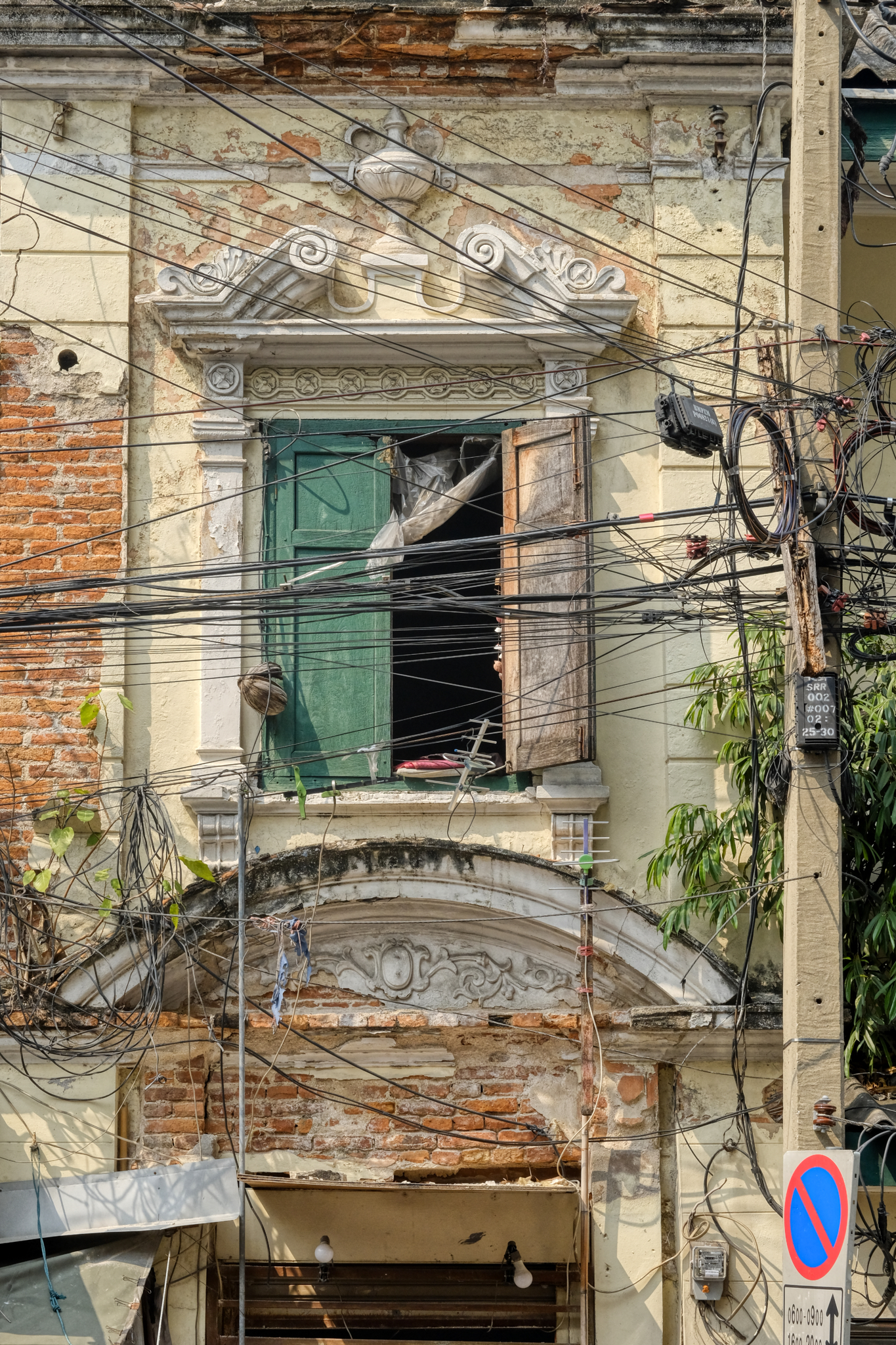 Remnants of Old Bangkok can be seen in and among the complexity of the streets.
Remnants of Old Bangkok can be seen in and among the complexity of the streets.
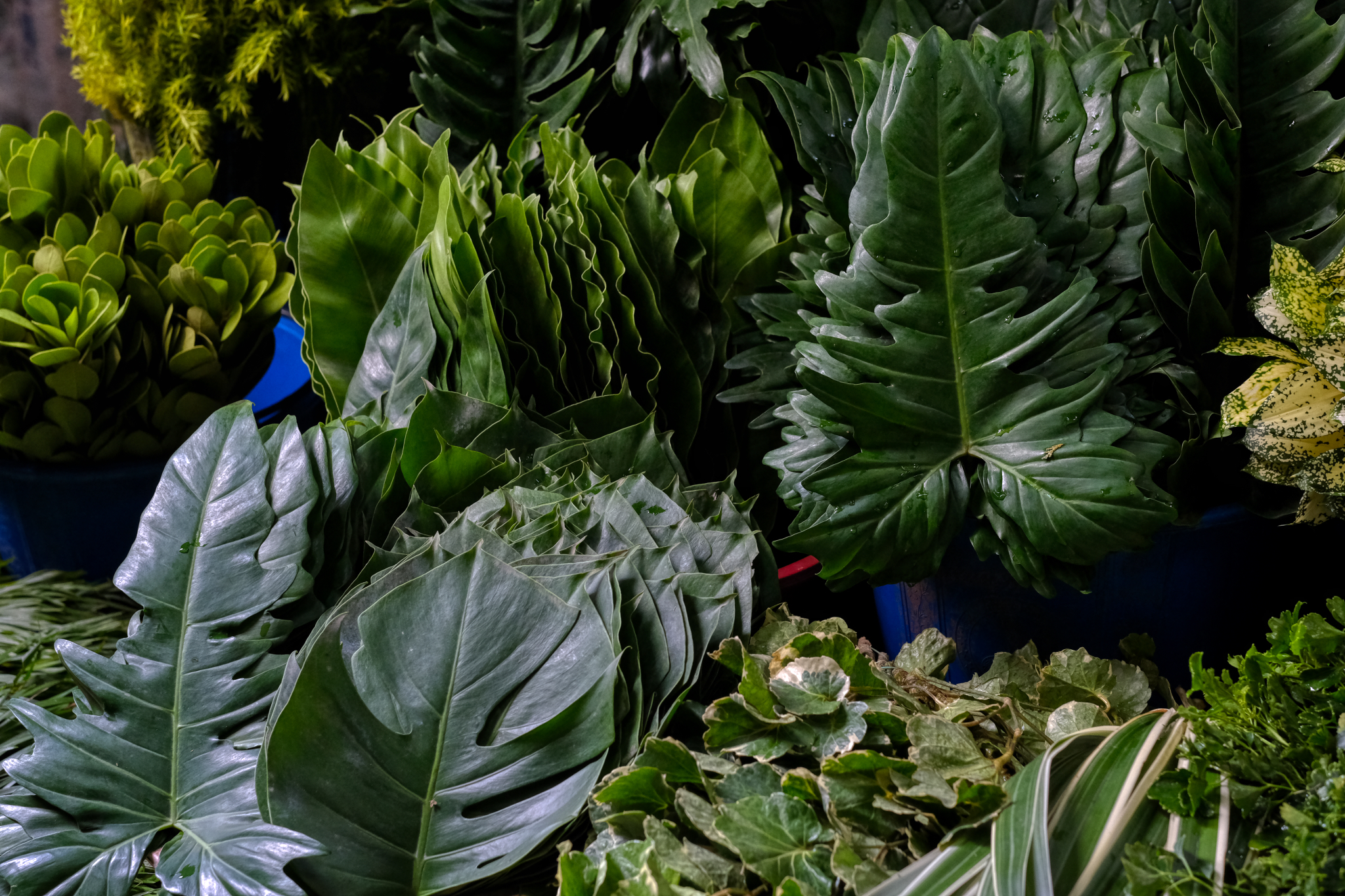 Not only flowers . . . but everything a creative flower arranger might want to employ in a tropical flower arrangement!
Not only flowers . . . but everything a creative flower arranger might want to employ in a tropical flower arrangement!
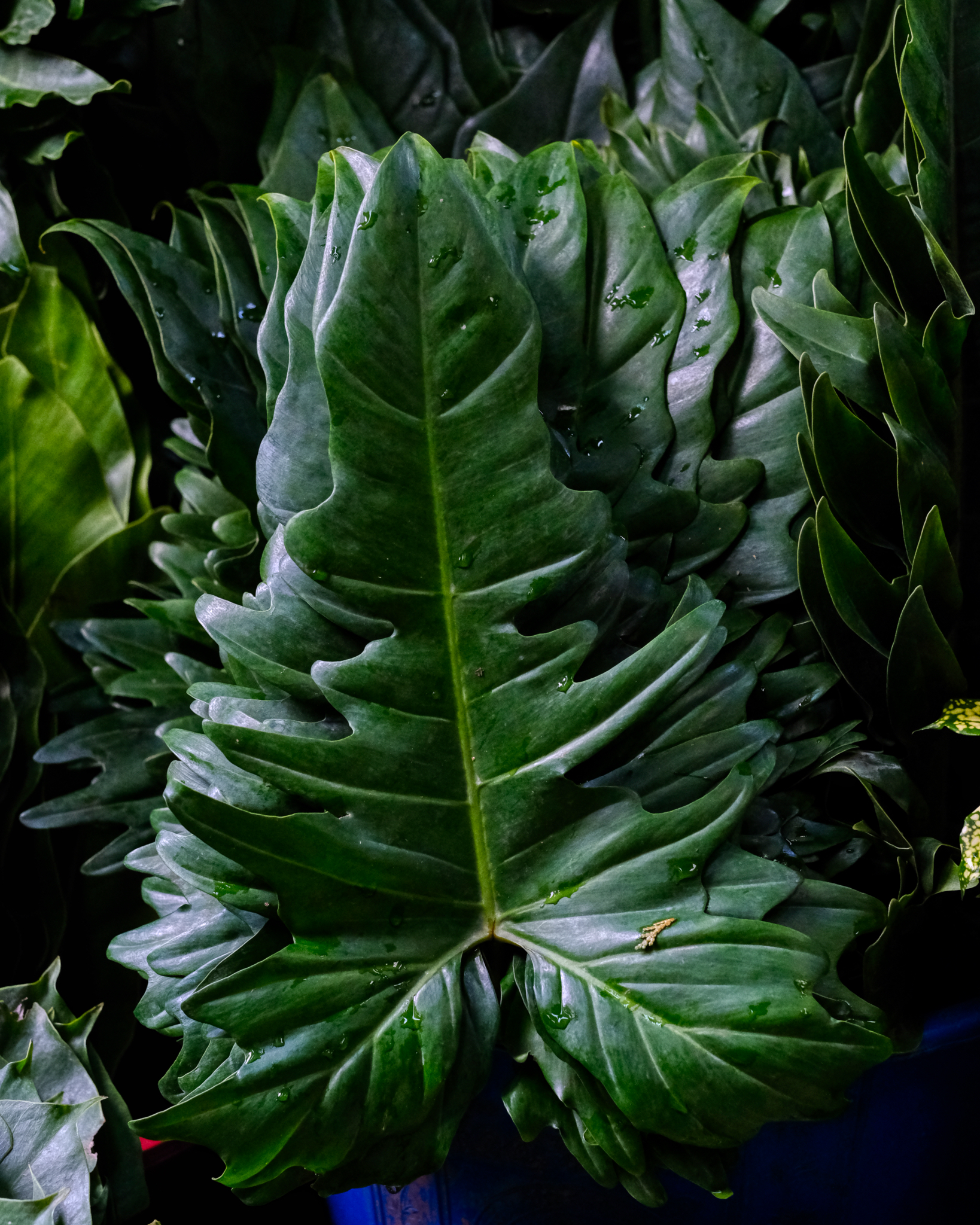 Existentially beautiful tropical leaf.
Existentially beautiful tropical leaf.
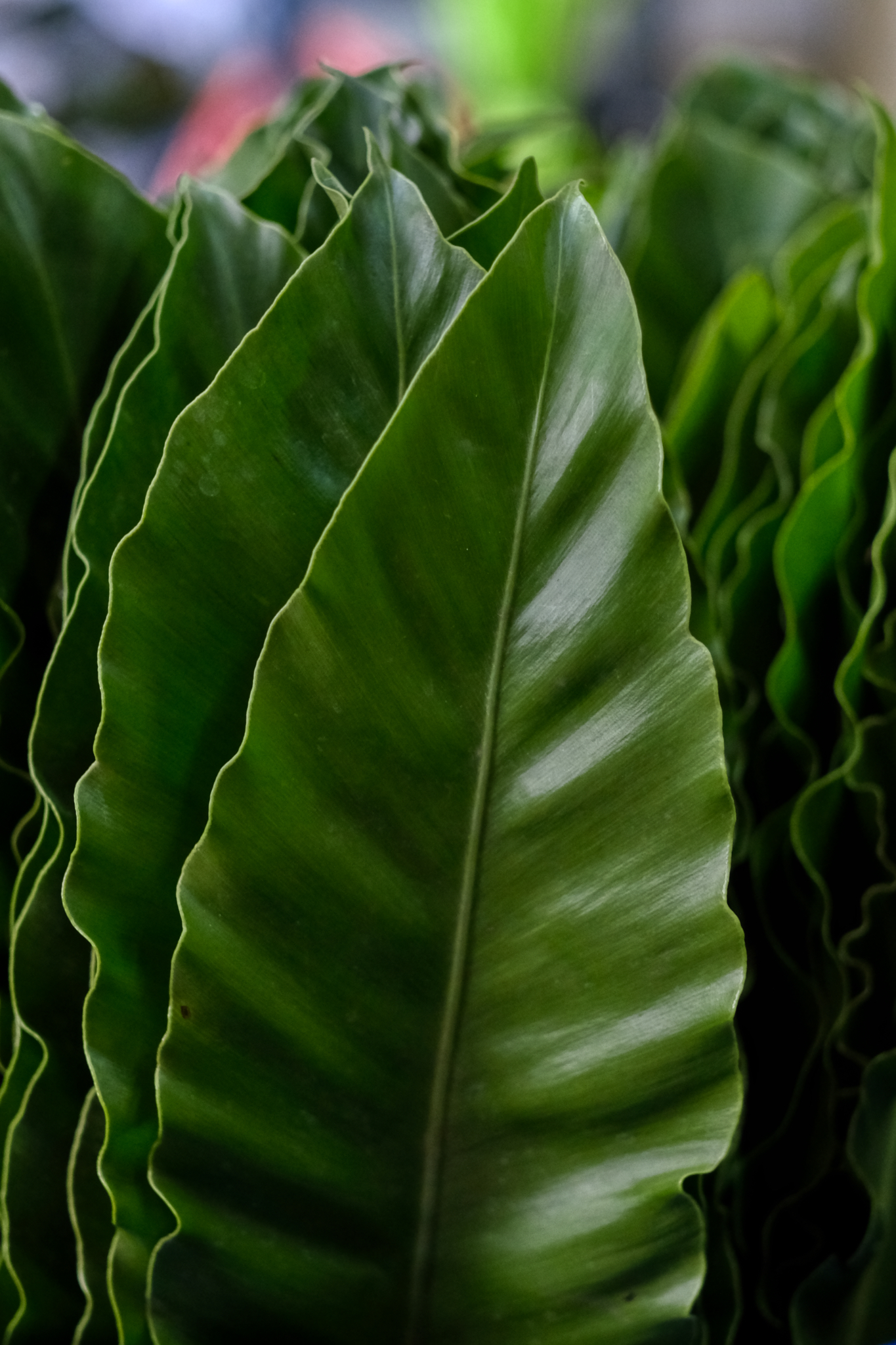 Gorgeous.
Gorgeous.
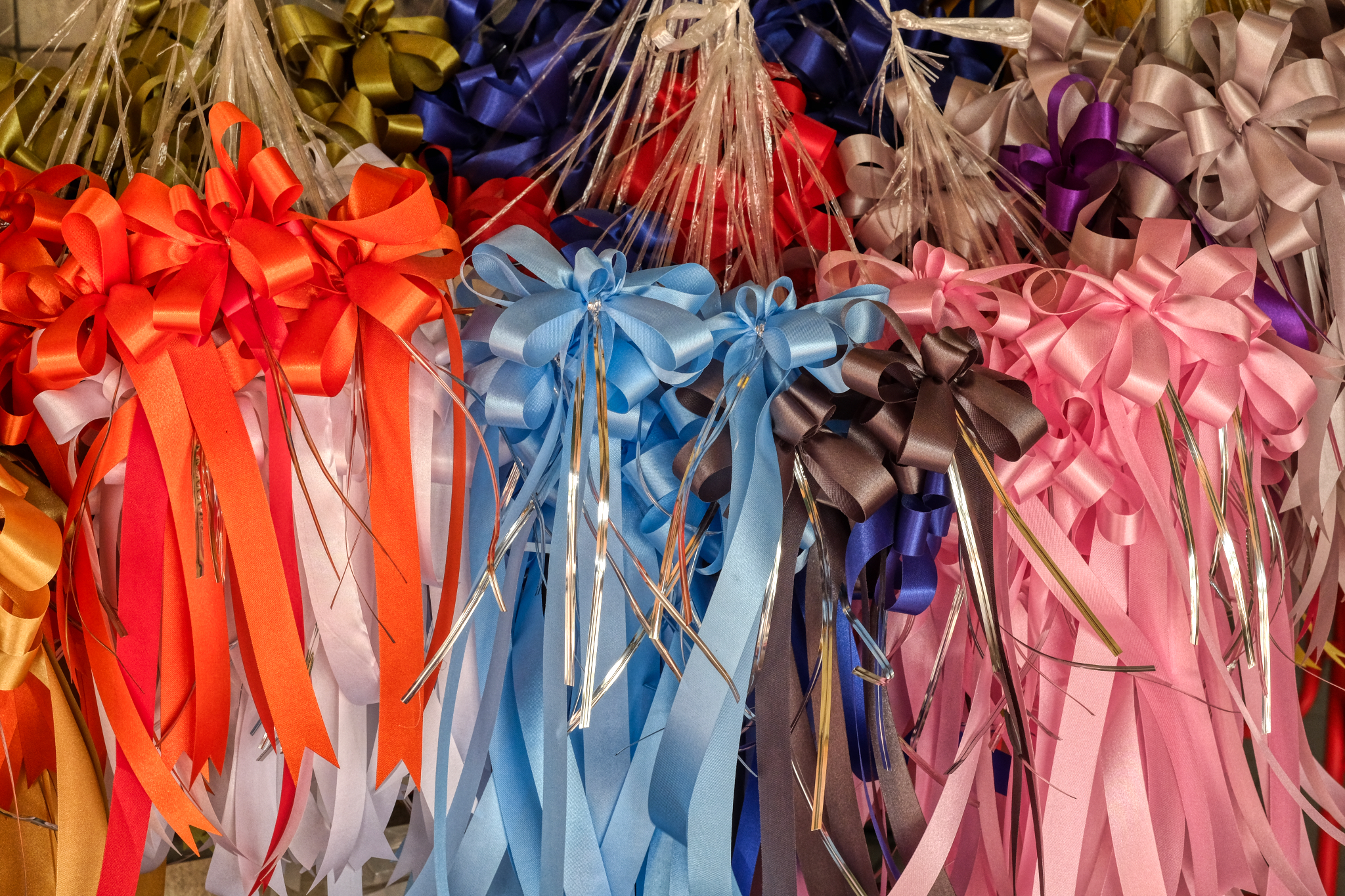 And ribbons and bows for that special wedding or graduation event.
And ribbons and bows for that special wedding or graduation event.
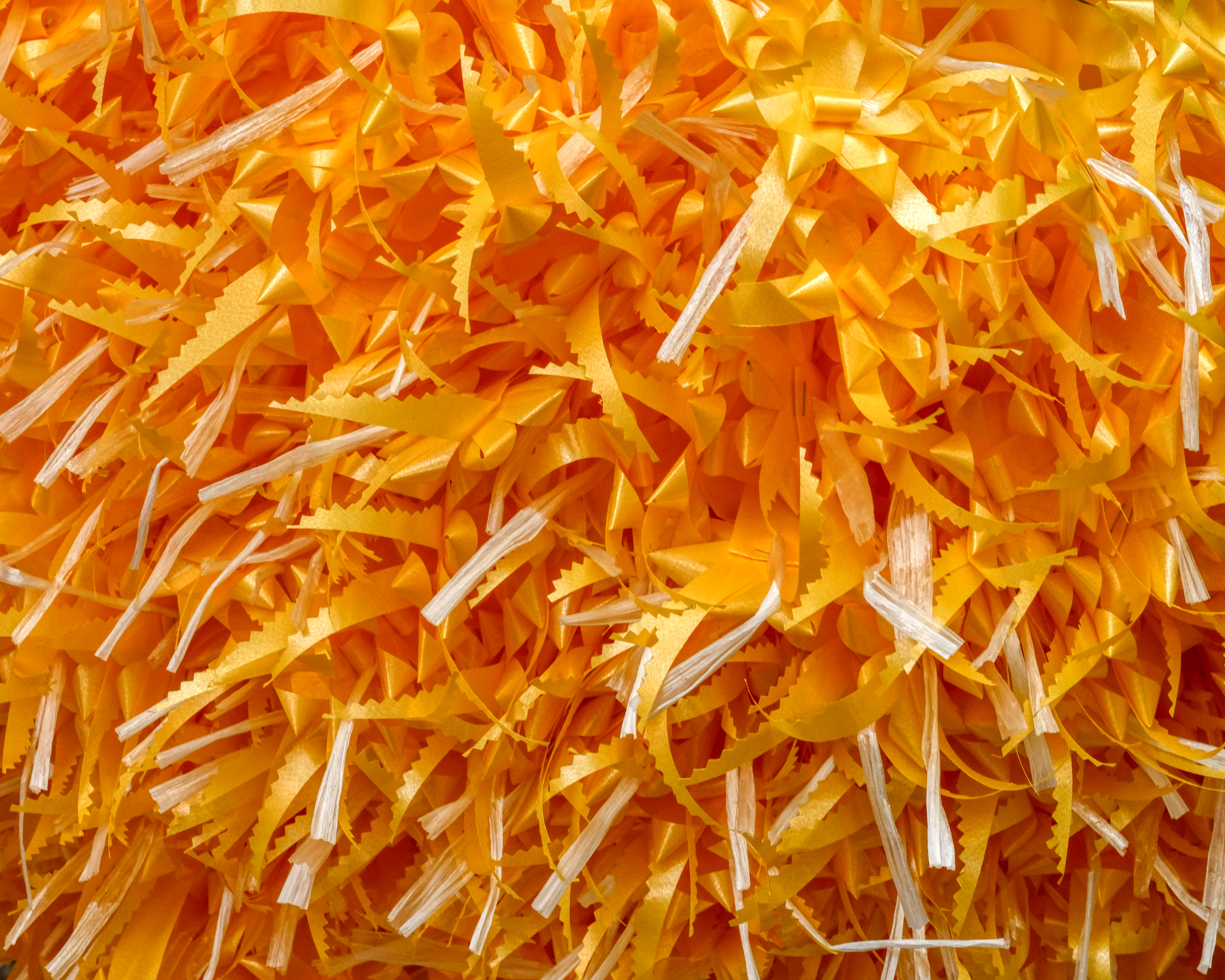 A complete flower arranger super store!
A complete flower arranger super store!
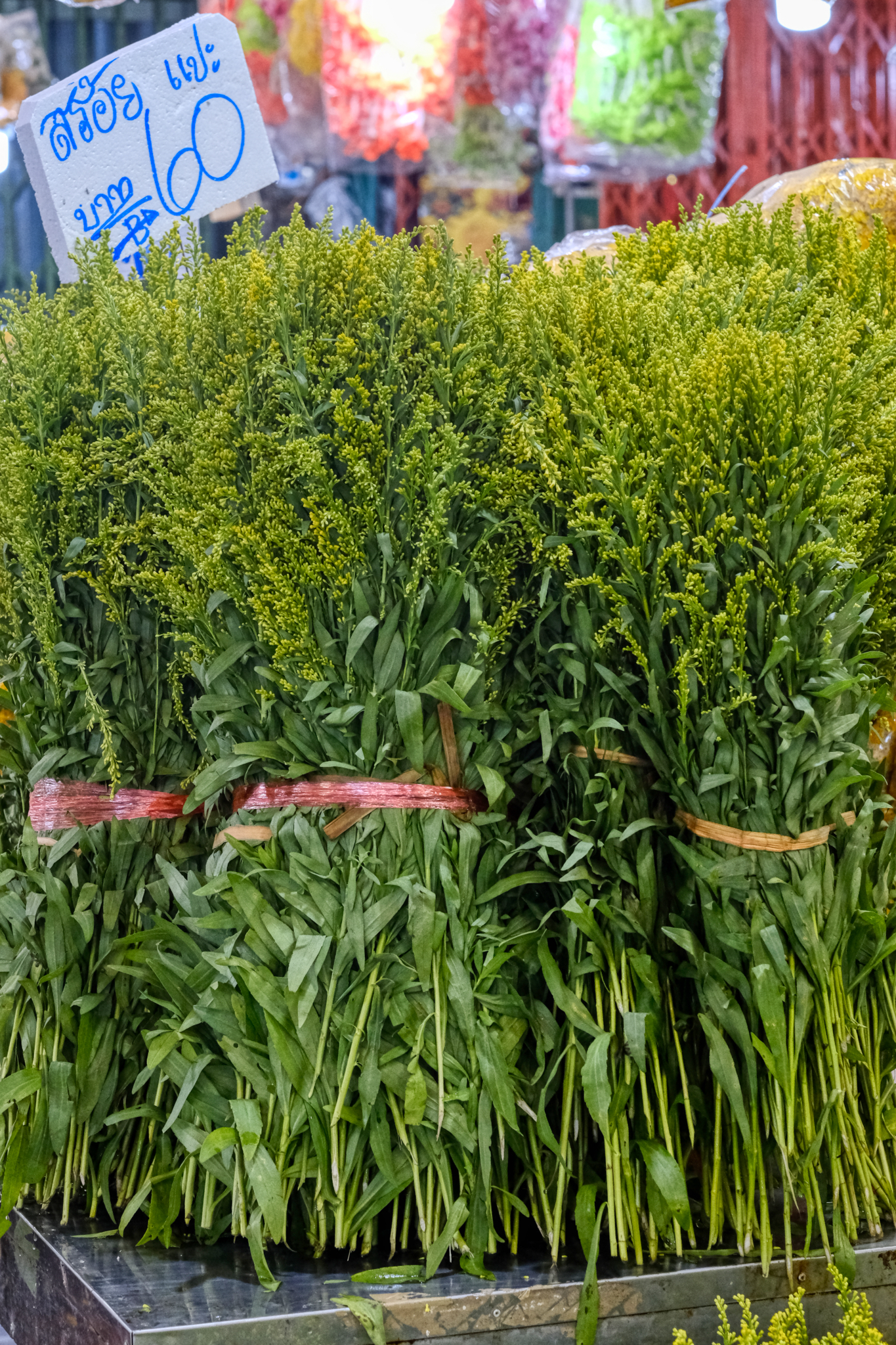 Need some green sprigs with little buds for your arrangement . . . sure, they have them.
Need some green sprigs with little buds for your arrangement . . . sure, they have them.
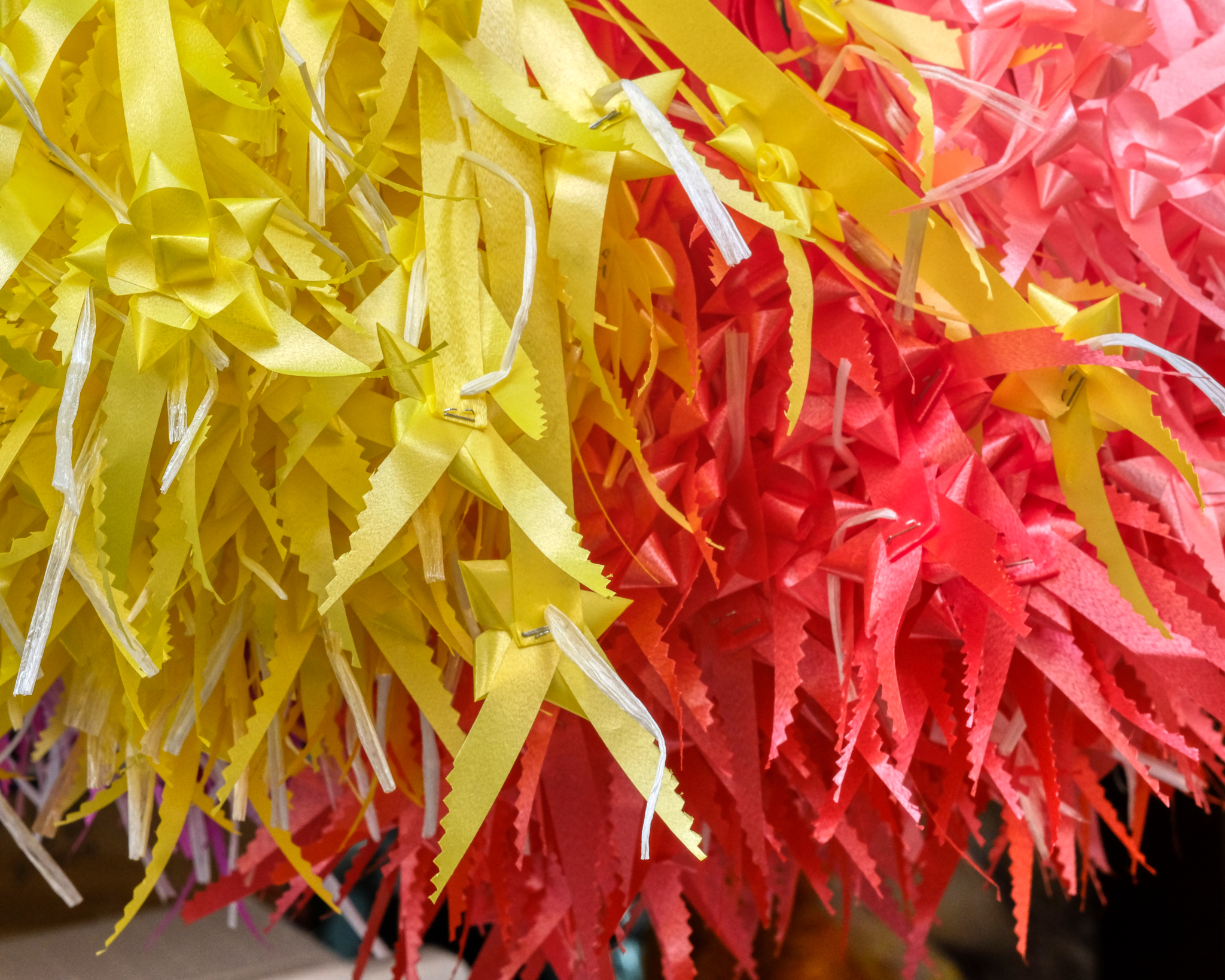 And ribbons and bows . . .
And ribbons and bows . . .
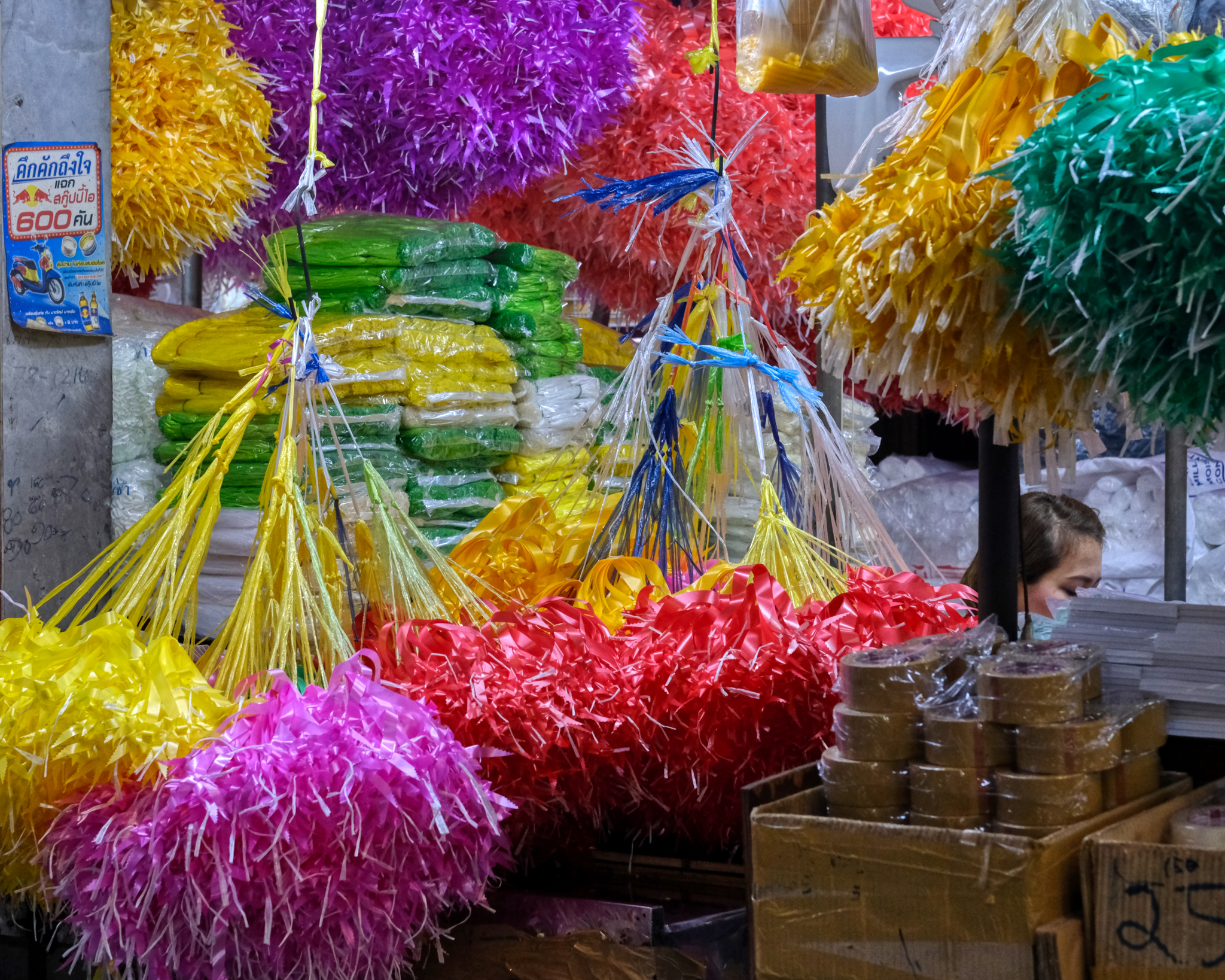 . . . bunches and bunches of ribbons and bows.
. . . bunches and bunches of ribbons and bows.
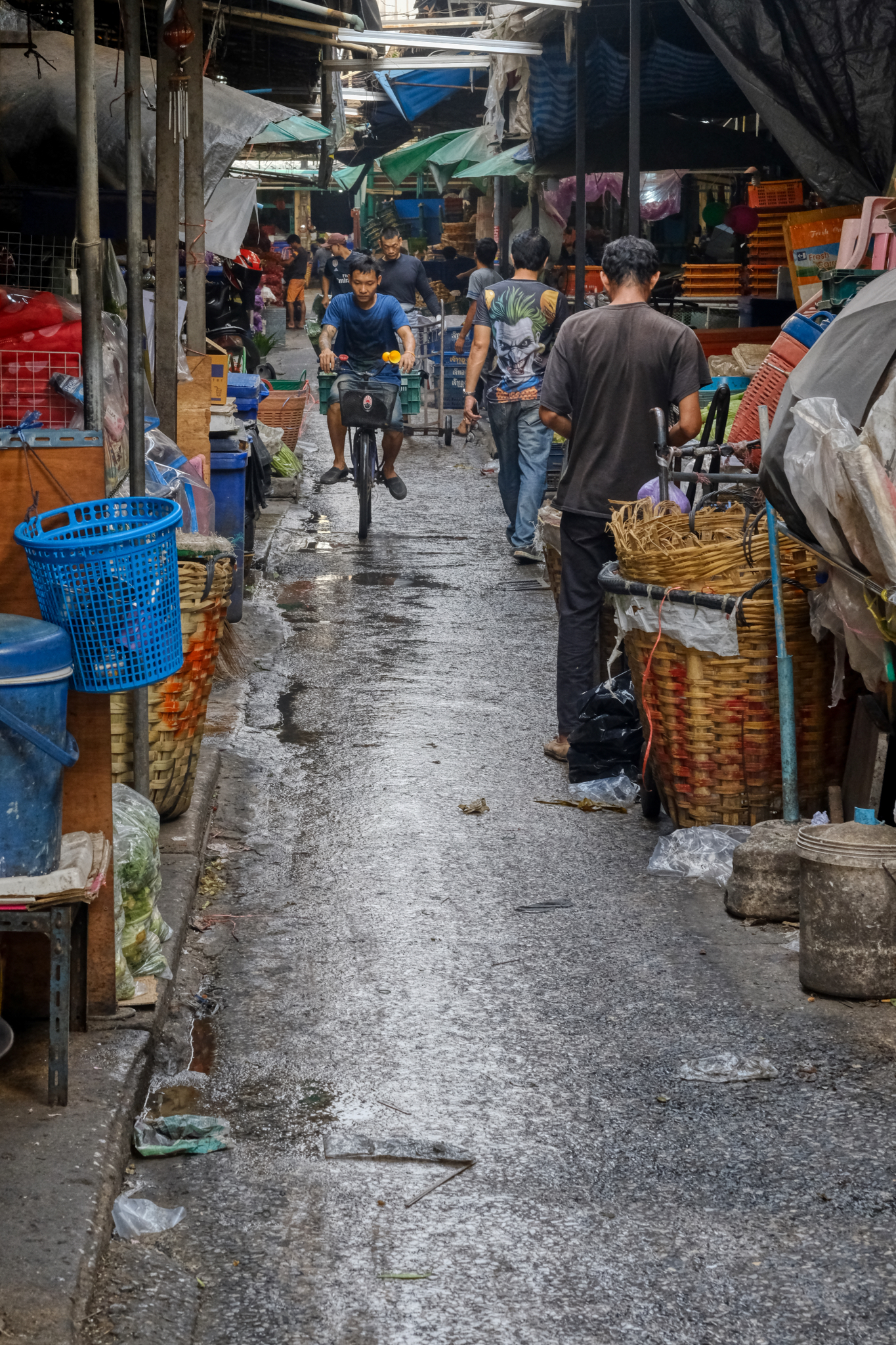 The back side of the flower market blends into a traditional, and common, Bangkok "wet market" -- a fresh fruit and vegetable market.
The back side of the flower market blends into a traditional, and common, Bangkok "wet market" -- a fresh fruit and vegetable market.
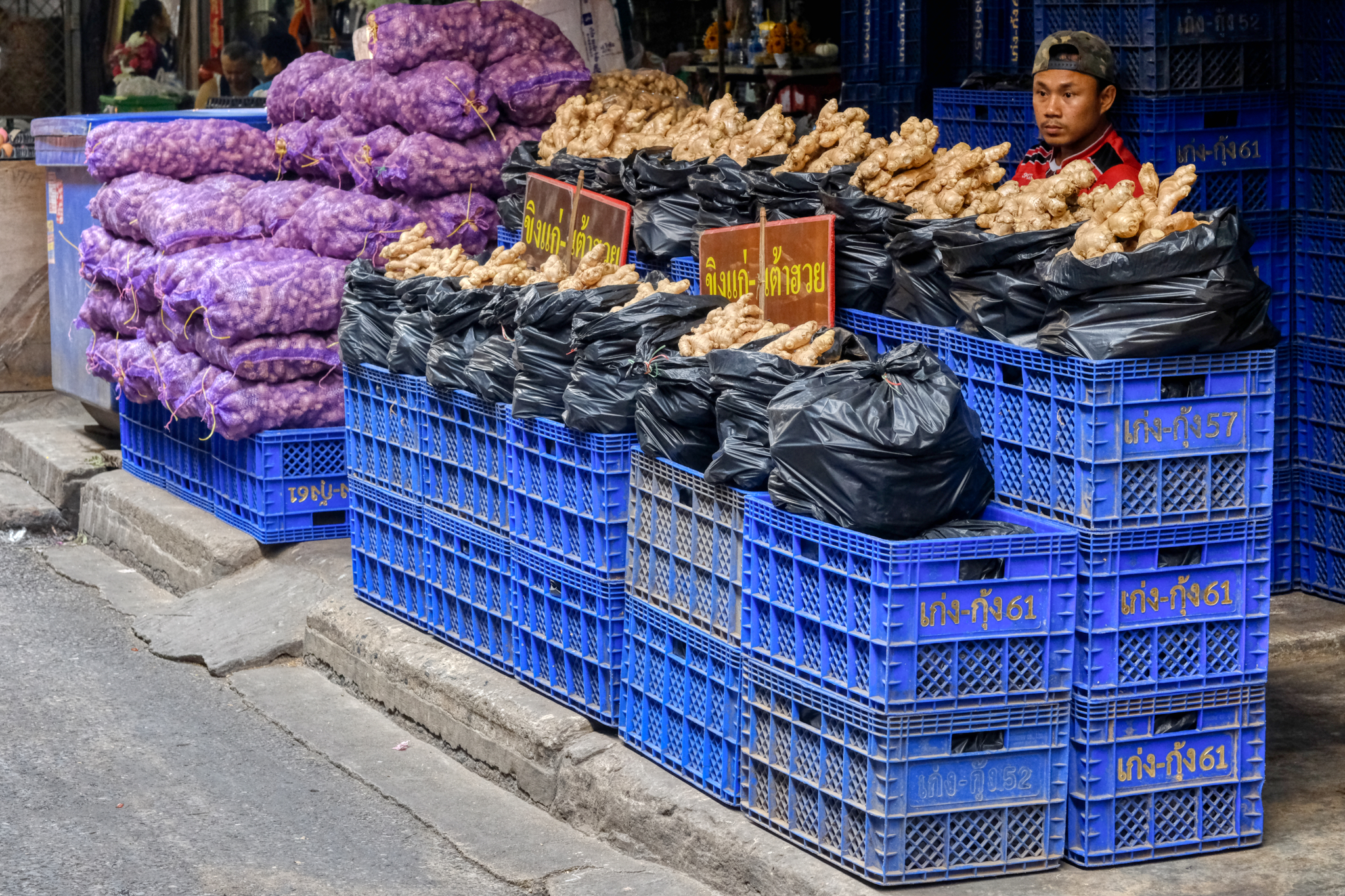 A ginger hawker's display.
A ginger hawker's display.
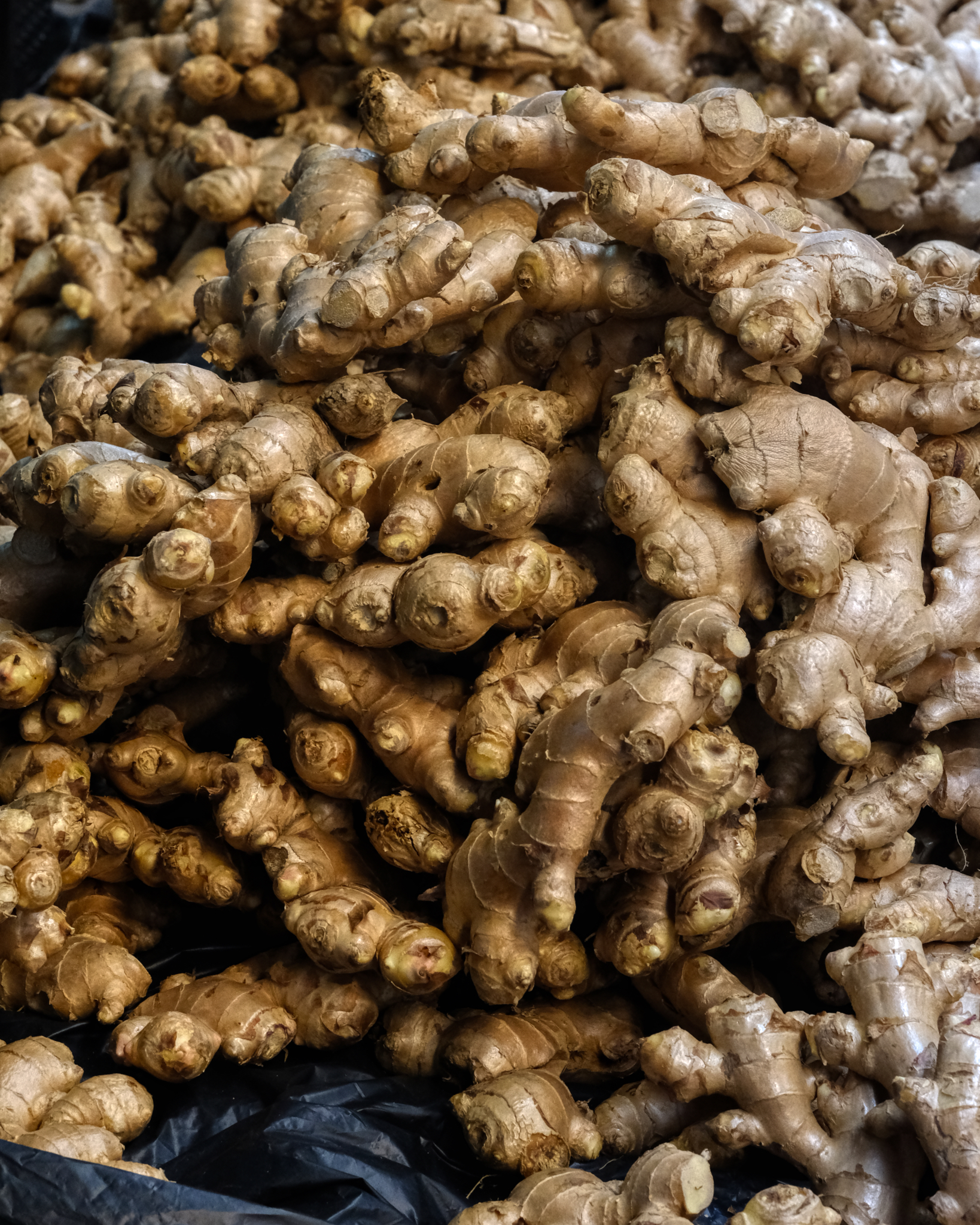 Beautiful ginger. I love ginger . . . and many Thai dishes are made with ginger . . . especially Thai desserts, my favorite.
Beautiful ginger. I love ginger . . . and many Thai dishes are made with ginger . . . especially Thai desserts, my favorite.
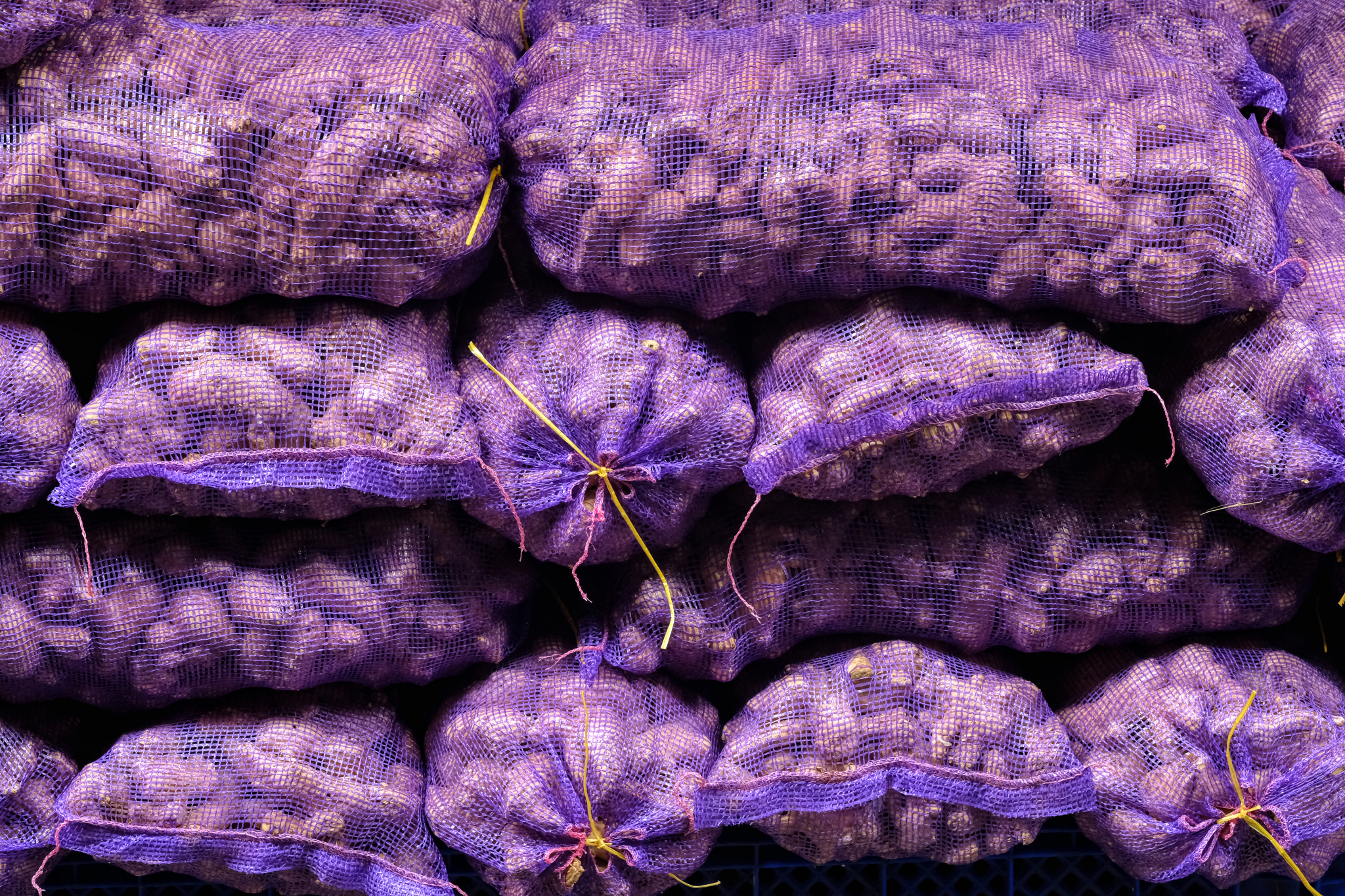 Purple net sacks full of potatoes.
Purple net sacks full of potatoes.
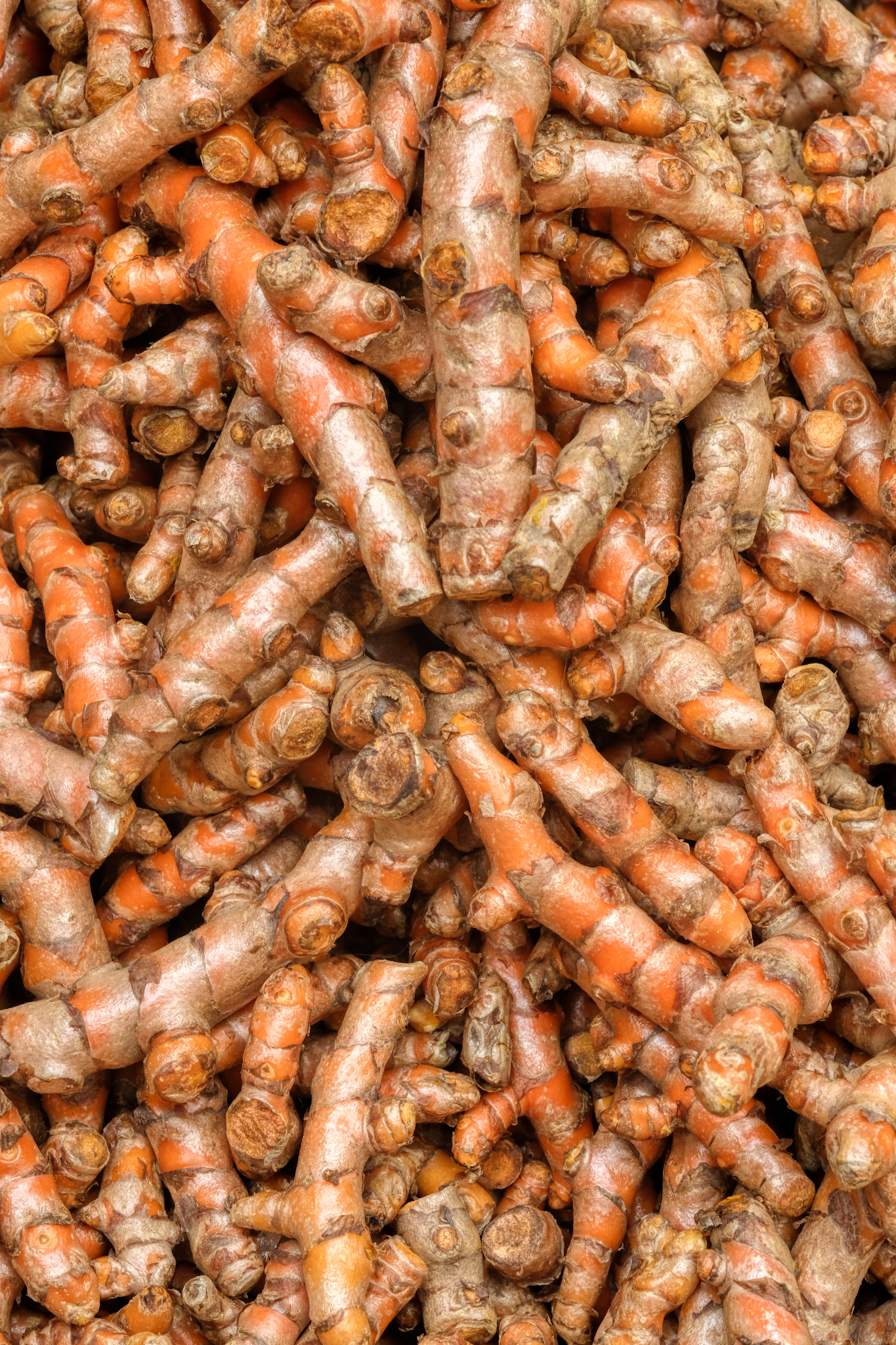 A stack of spice root.
A stack of spice root.
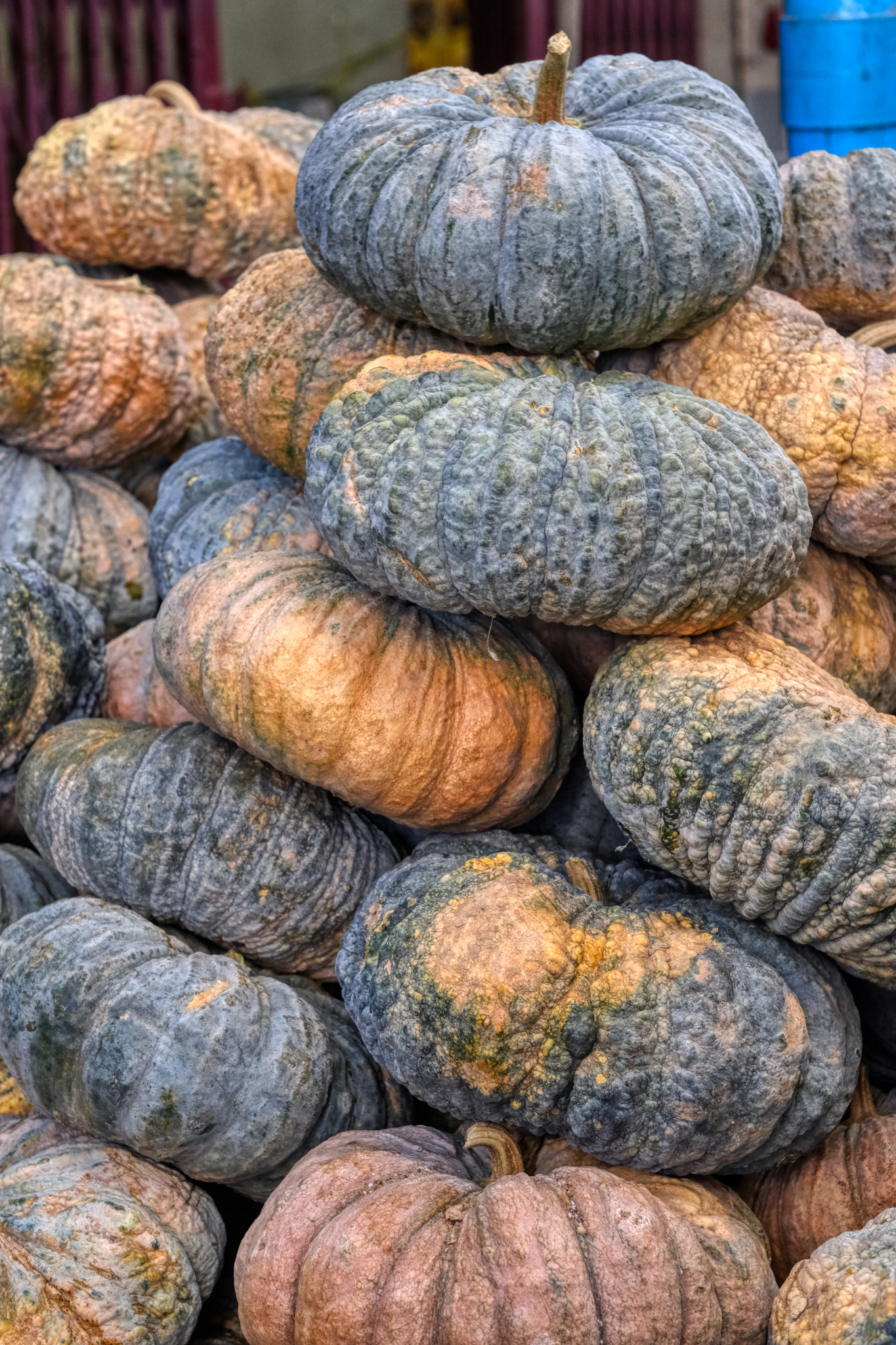 A stack of Thai squash ("fucktong" in Thai).
A stack of Thai squash ("fucktong" in Thai).
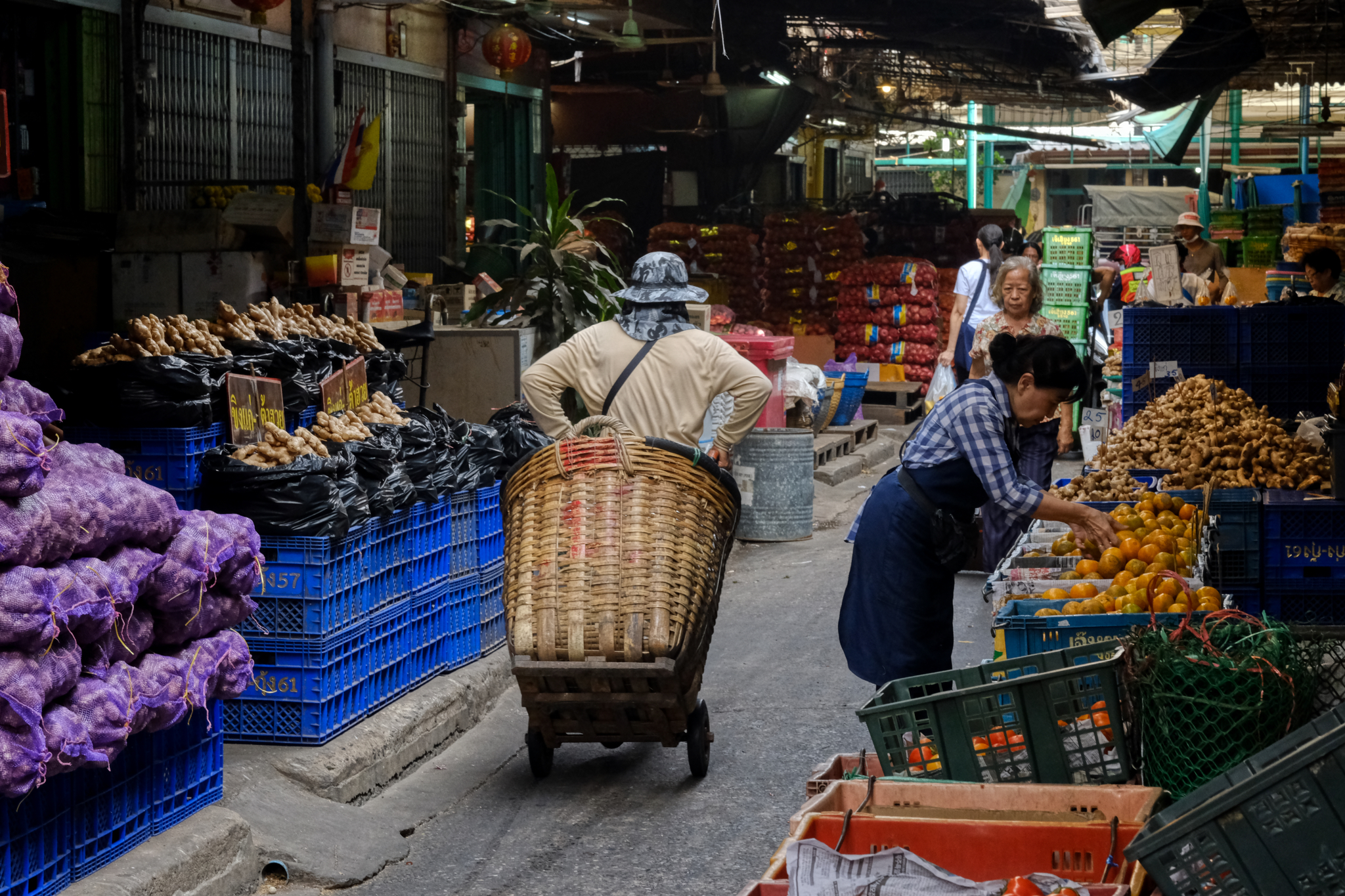 A lot of activity in the vegetable wholesale market.
A lot of activity in the vegetable wholesale market.
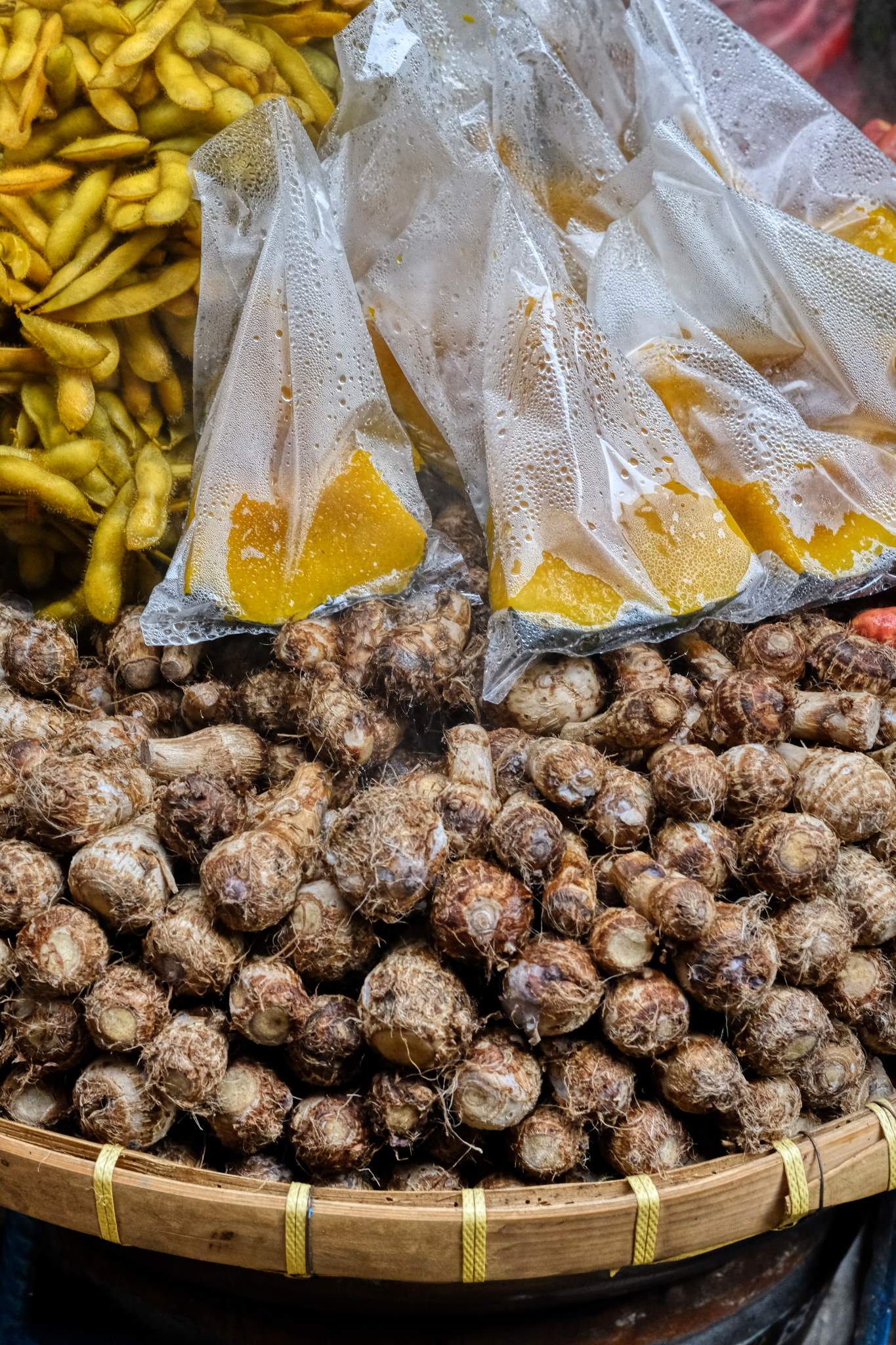 Unique ingredients are what make Thai food so tasty.
Unique ingredients are what make Thai food so tasty.
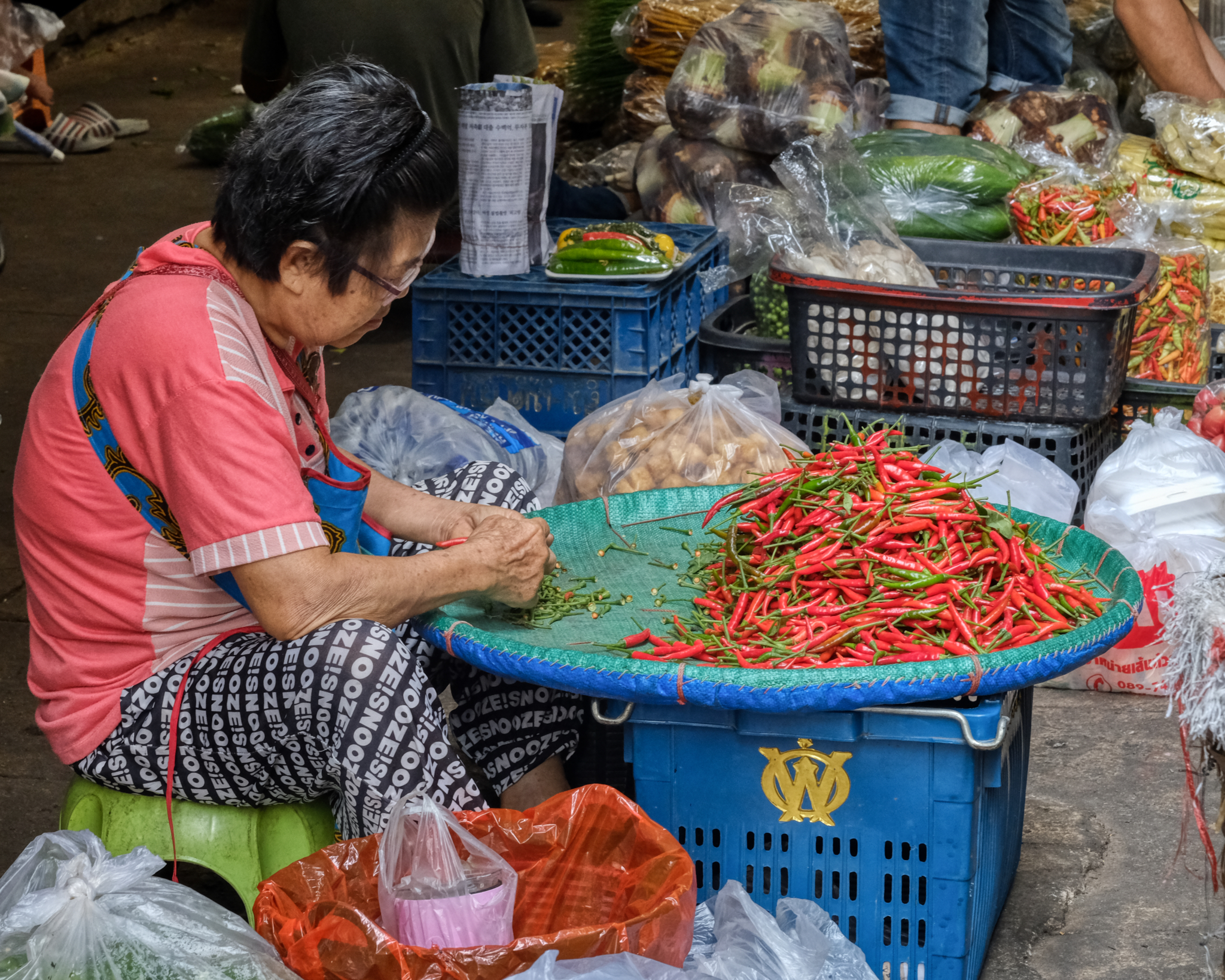 A market chili sorter . . . she did not smell like flowers!!!
A market chili sorter . . . she did not smell like flowers!!!
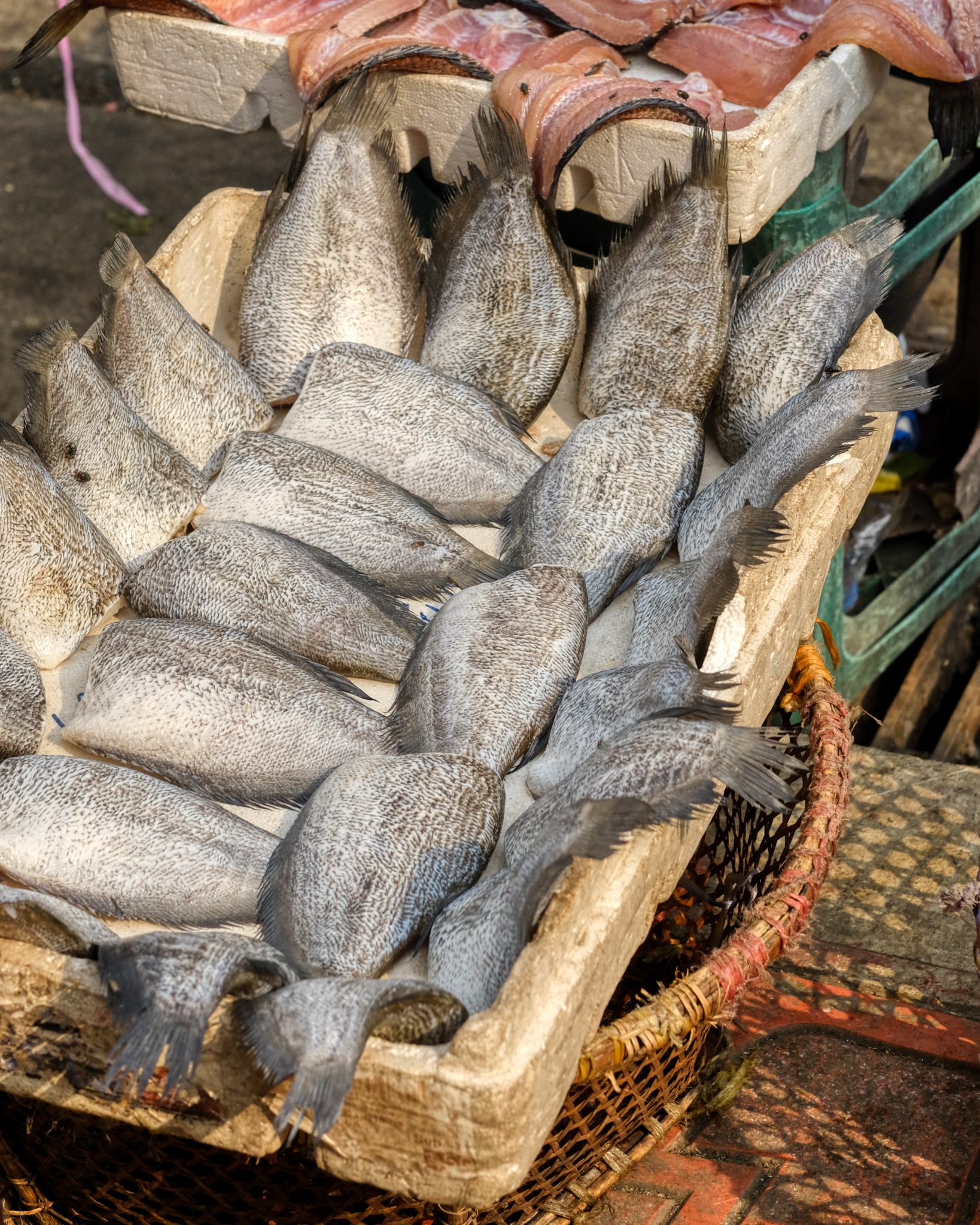 A small sale of fish . . . no doubt intended for the market workers to take home for dinner.
A small sale of fish . . . no doubt intended for the market workers to take home for dinner.
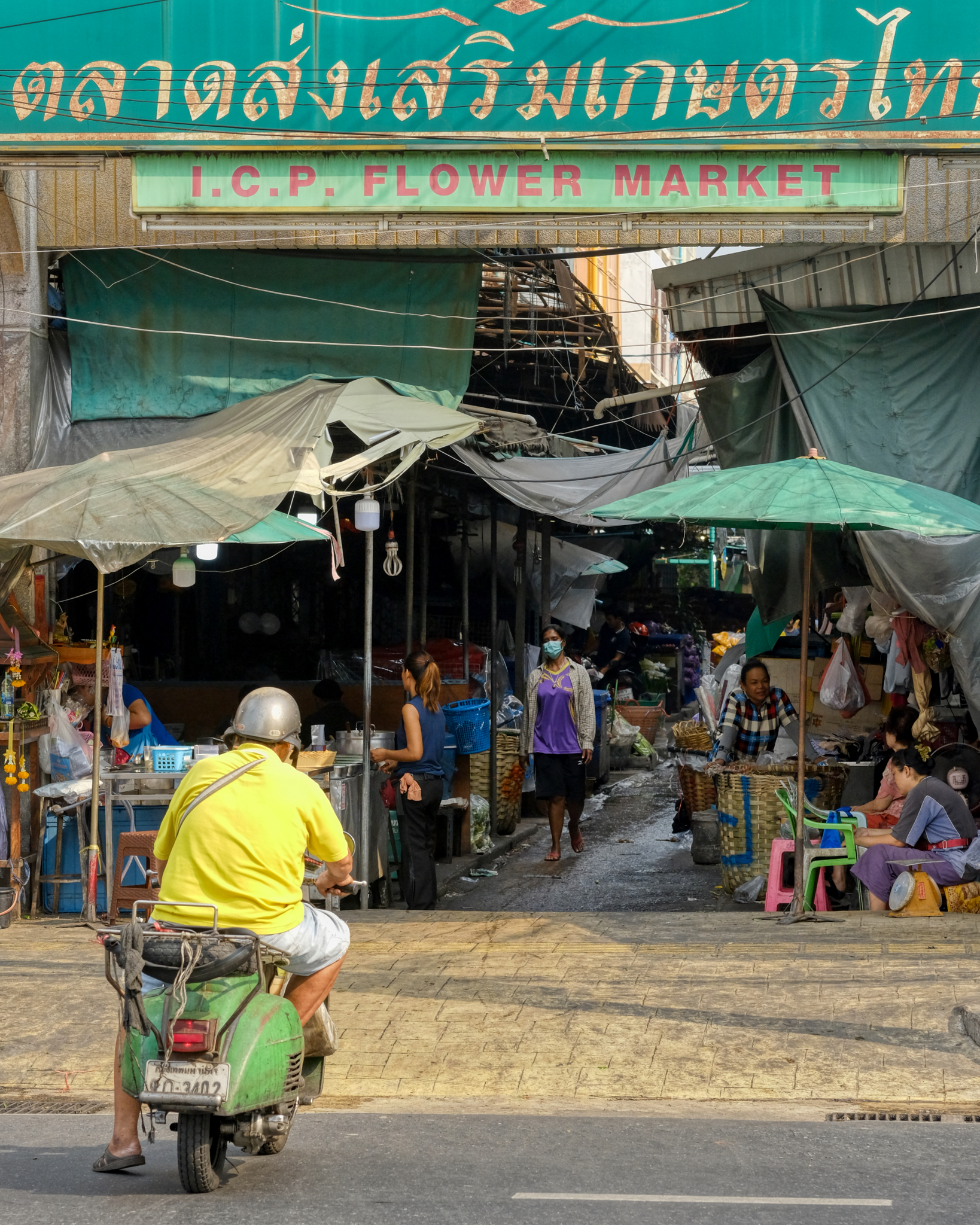 After three hours (!!) we finally stepped outside the markets.
After three hours (!!) we finally stepped outside the markets.
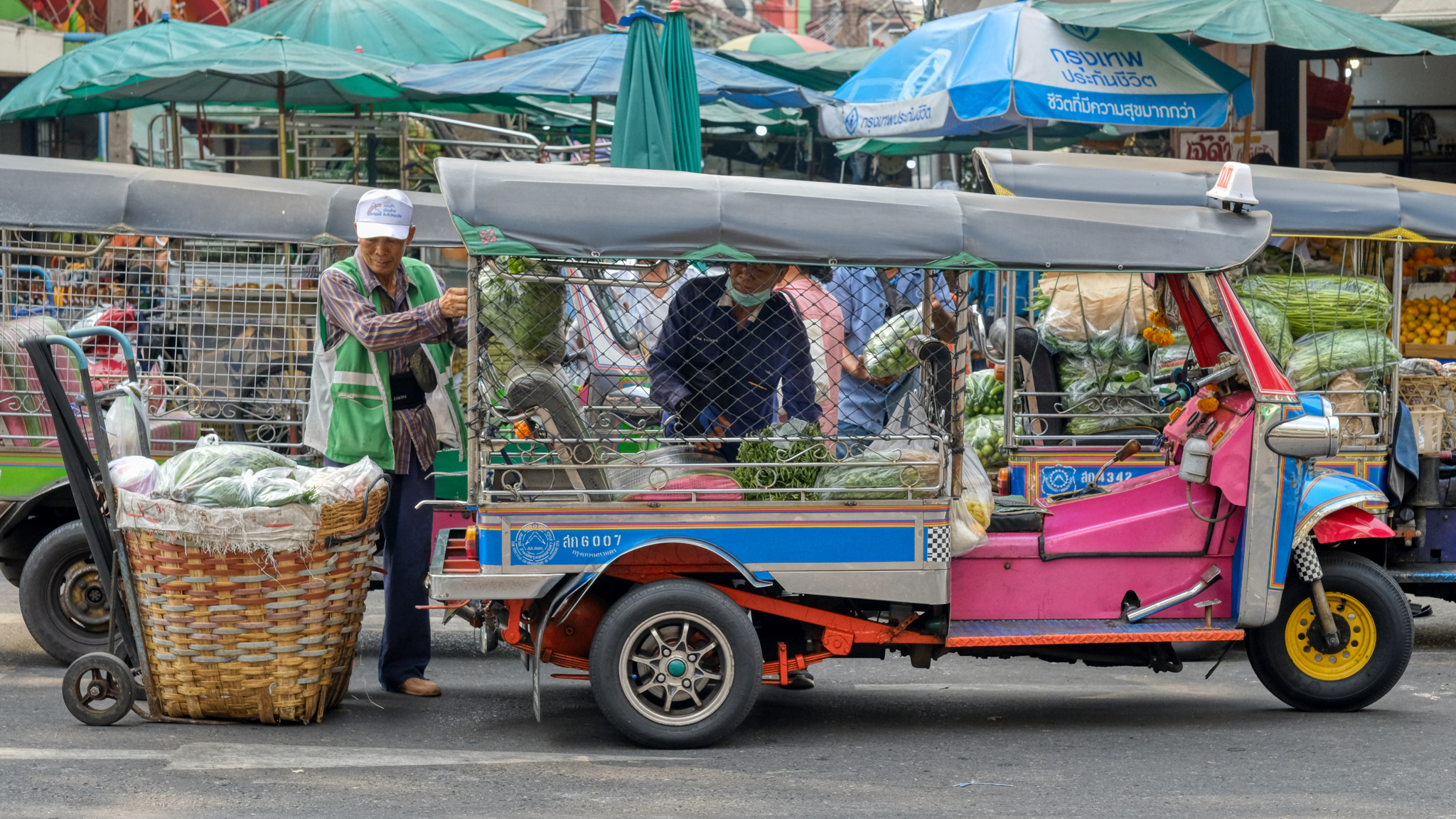 Loading up the produce . . . outside the market.
Loading up the produce . . . outside the market.
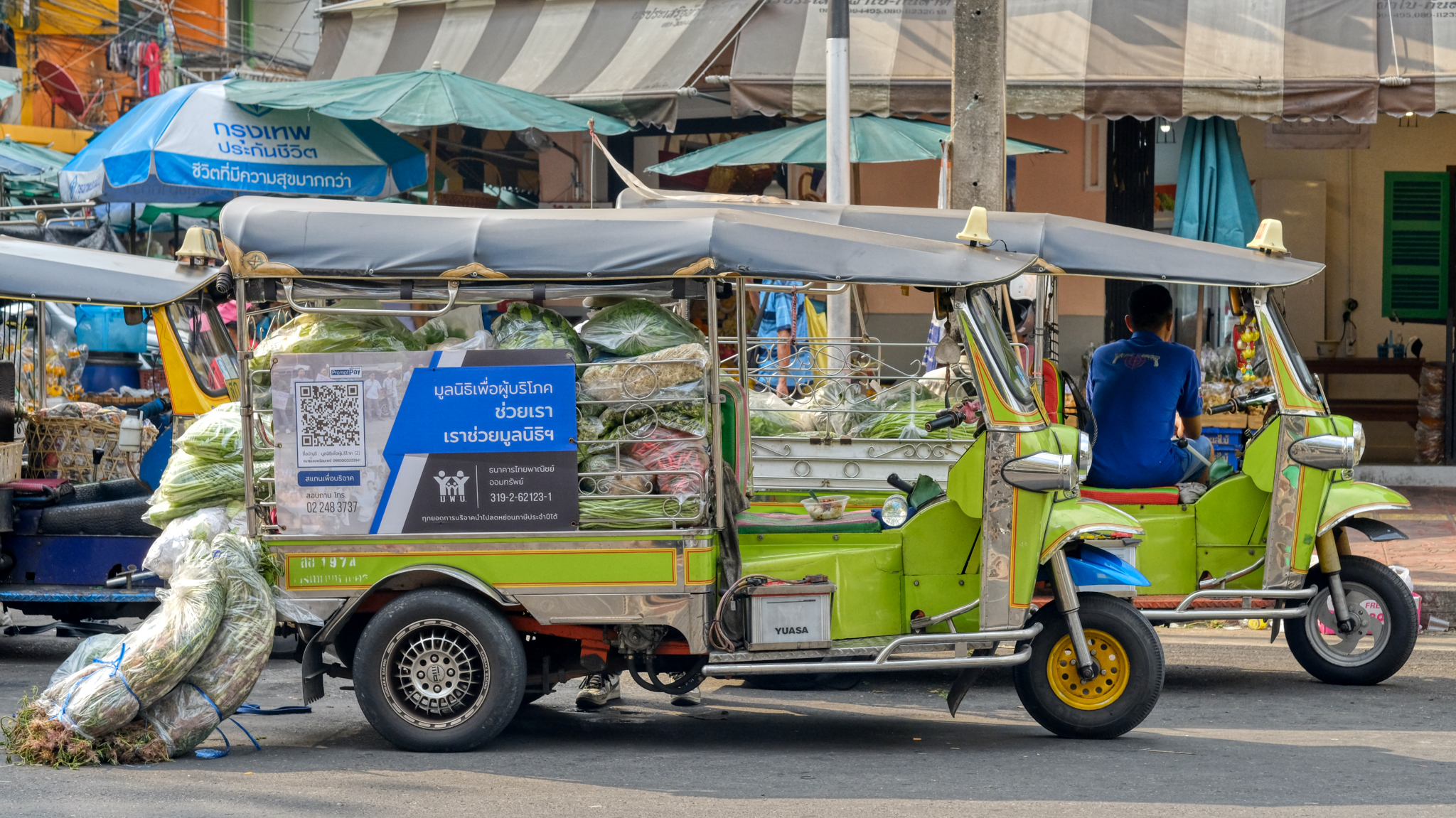 Produce all loaded in the tuk-tuk bound for a restaurent or small market somewhere in the city.
Produce all loaded in the tuk-tuk bound for a restaurent or small market somewhere in the city.
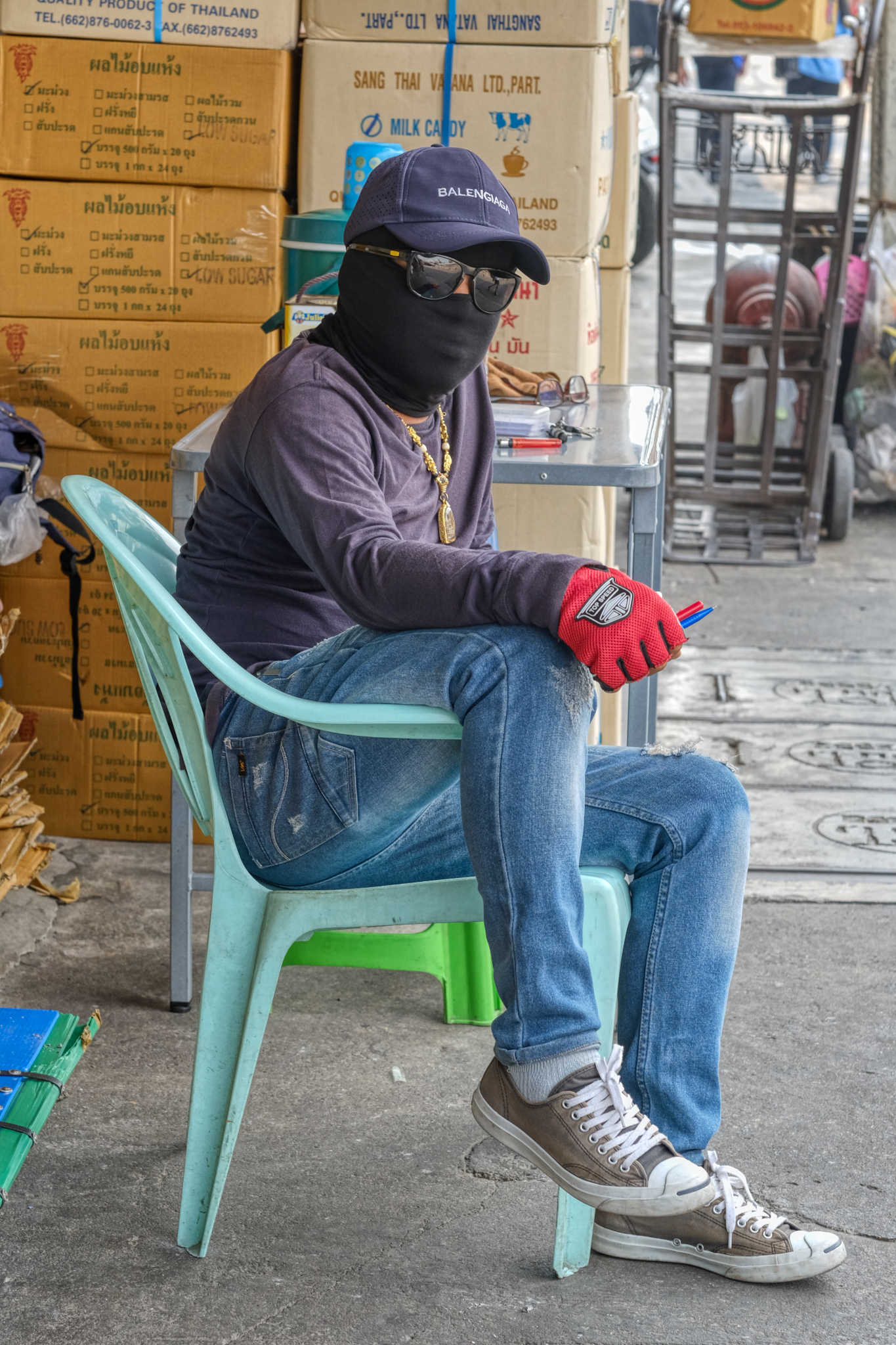 Who was that masked man? A flower market worker taking a break.
Who was that masked man? A flower market worker taking a break.
-------------------------------------------------
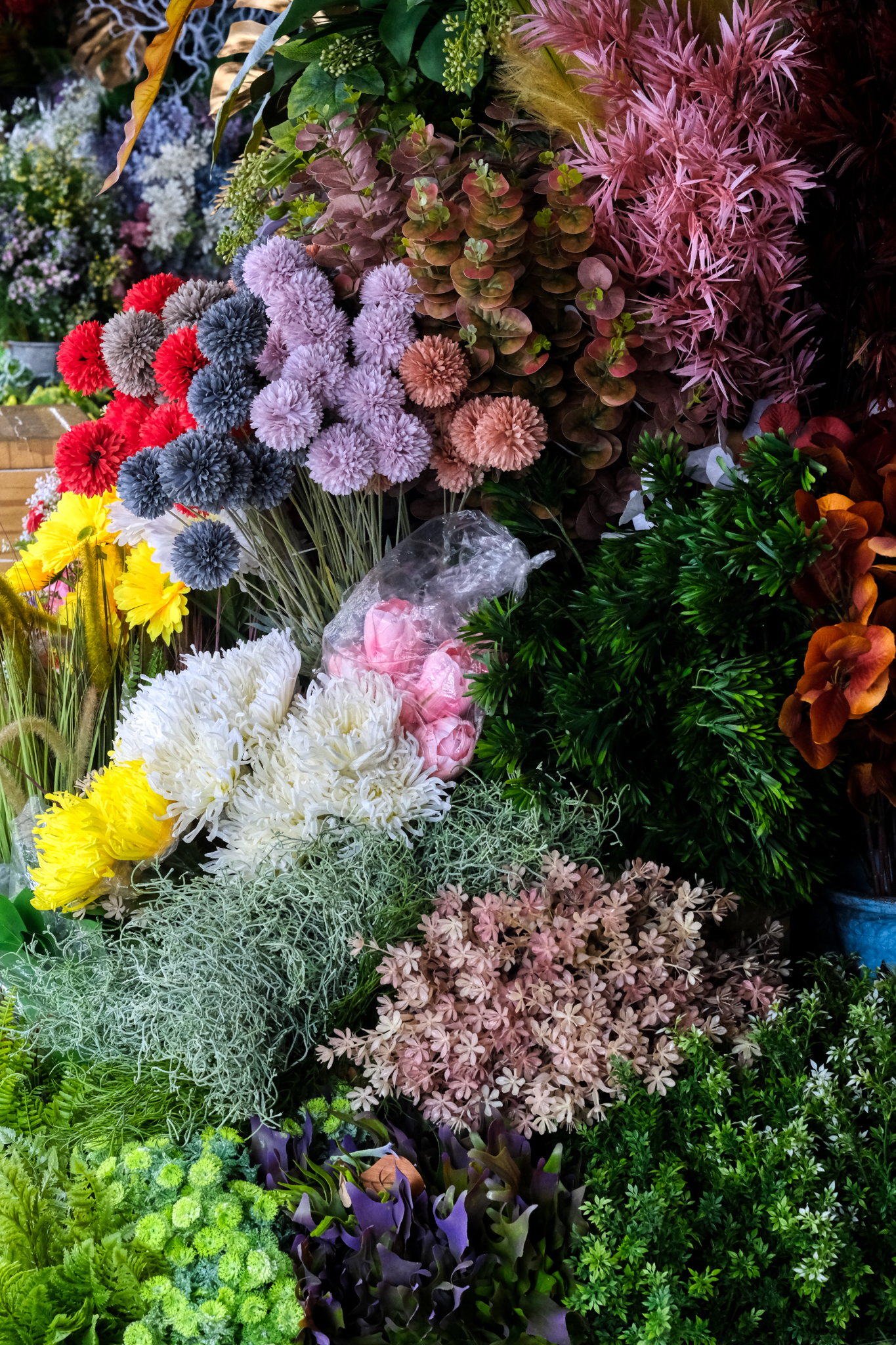 We walked a few blocks from the flower market to find a very good cup of coffee . . . and stumbled upon this shop selling "fake" plastic flowers: incredibly realistic plastic flowers. I guess some people get tired of having to buy fresh flowers over and over . . .
We walked a few blocks from the flower market to find a very good cup of coffee . . . and stumbled upon this shop selling "fake" plastic flowers: incredibly realistic plastic flowers. I guess some people get tired of having to buy fresh flowers over and over . . .
Visitors From Abroad . . . Another Hua Hin Area Ramble!
 Wednesday, March 25, 2020 at 5:15PM
Wednesday, March 25, 2020 at 5:15PM All in a day . . . all within 20 miles . . .
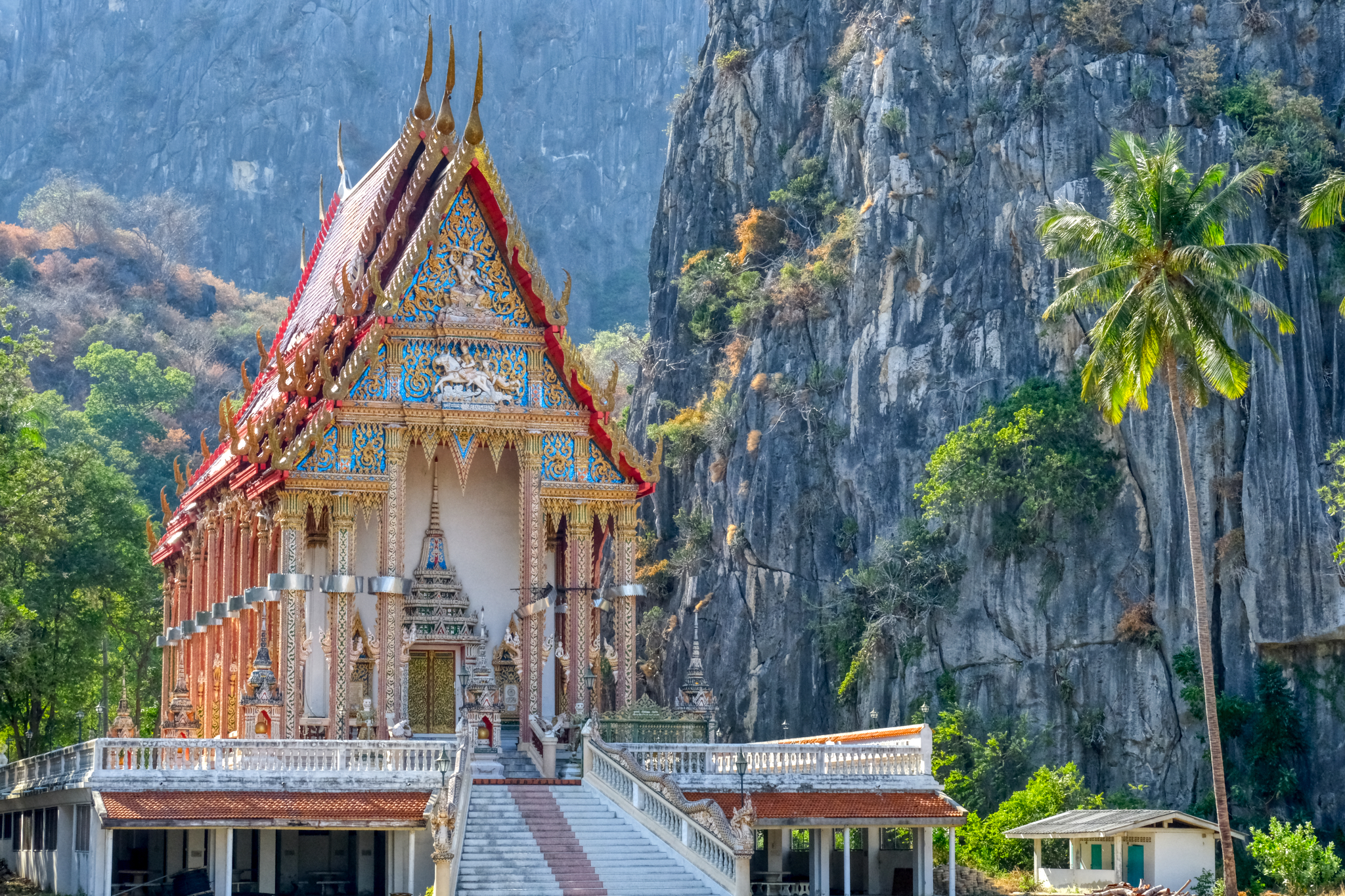 It's always great to have visitors from abroad come to Thailand . . . I get to take day trips out and about . . . usually to places I have never been, so we can explore together.
It's always great to have visitors from abroad come to Thailand . . . I get to take day trips out and about . . . usually to places I have never been, so we can explore together.
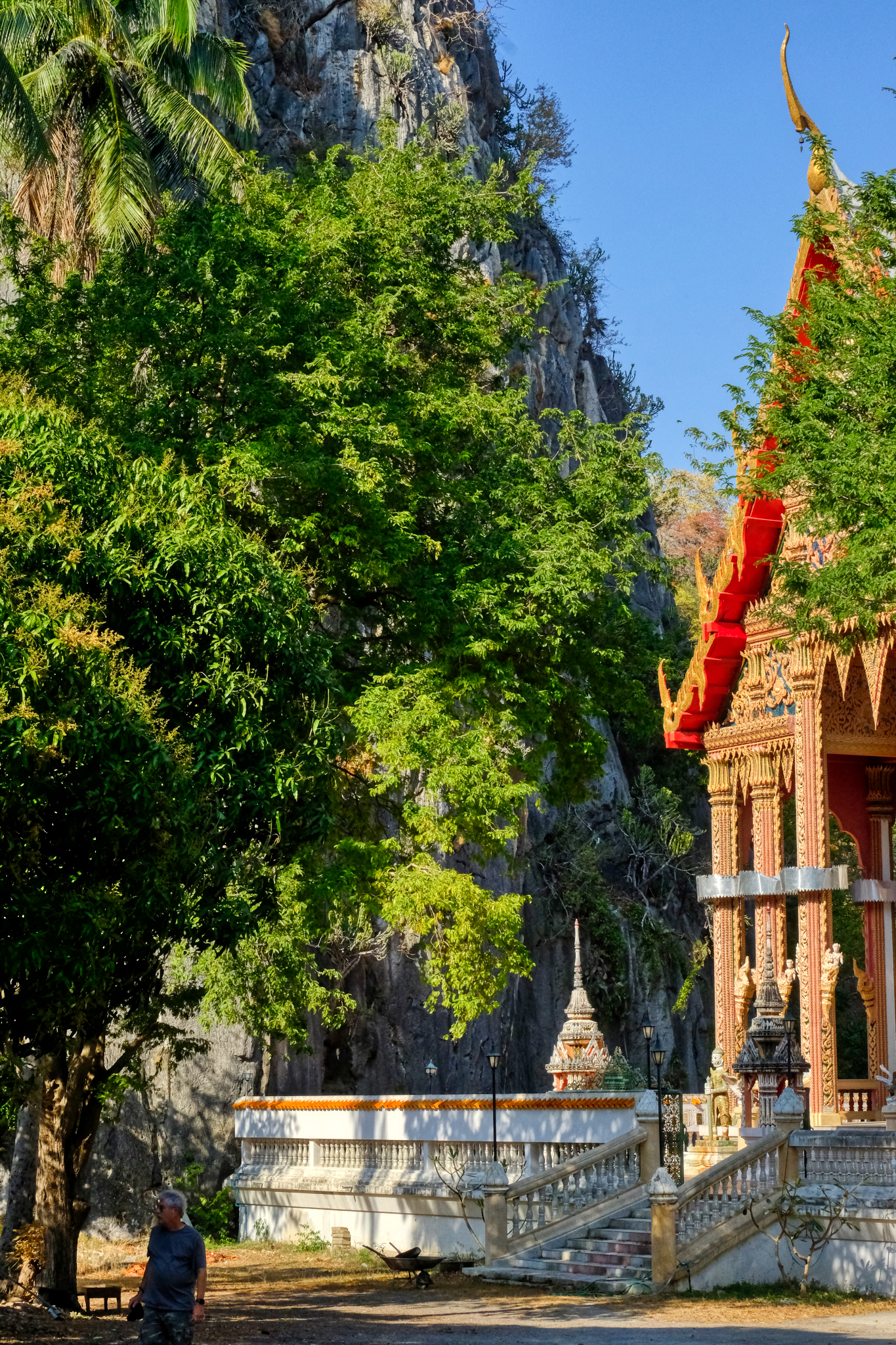 This Buddhist temple (wat) up against steep cliffs is one of my favorites. I pass it often when I am down Hua Hin way . . . but decided to stop and take a look again. Glad we did.
This Buddhist temple (wat) up against steep cliffs is one of my favorites. I pass it often when I am down Hua Hin way . . . but decided to stop and take a look again. Glad we did.
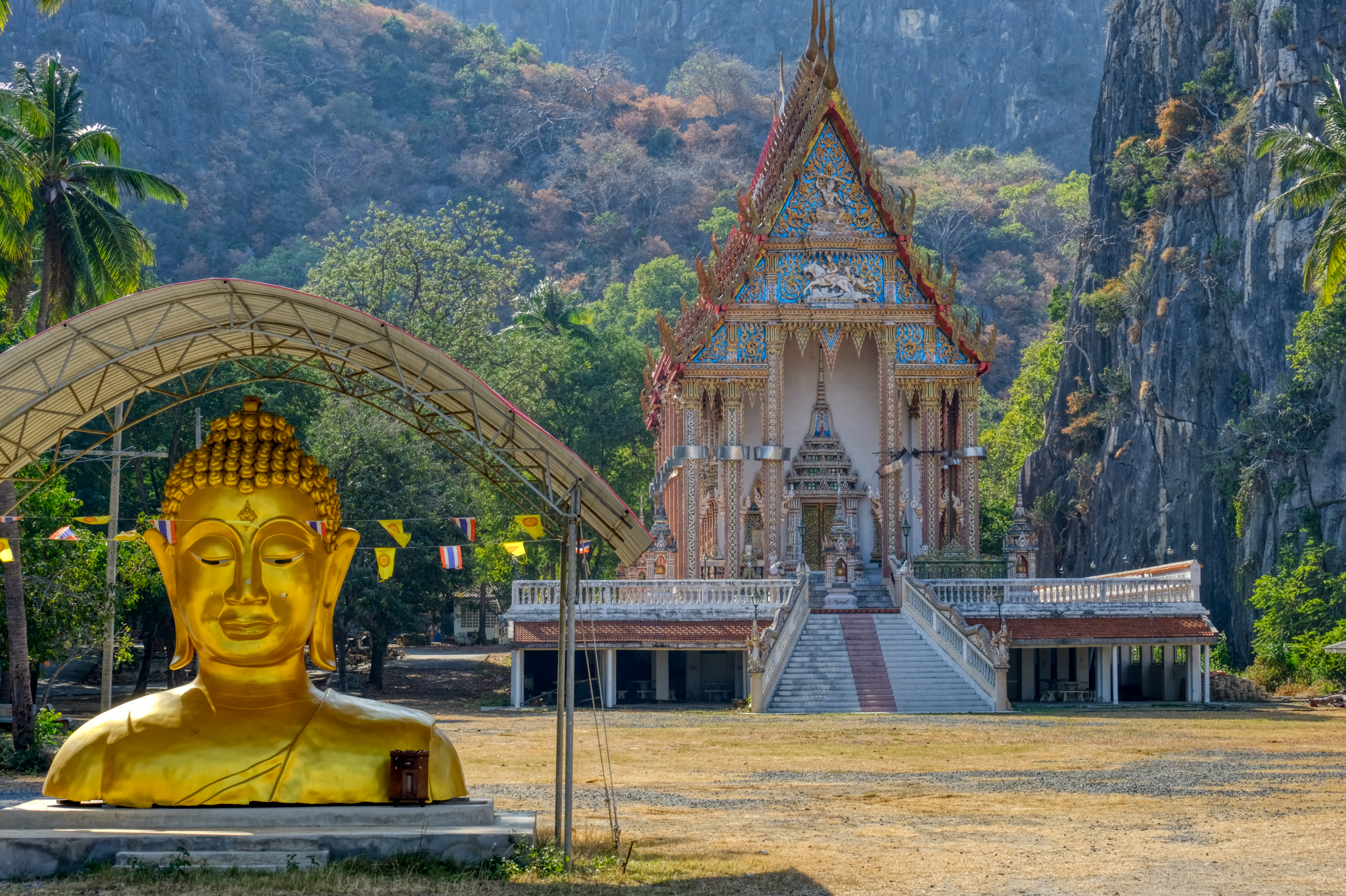
Such a lovely wat . . . looks like they are going to assemble a new giant Buddha image soon.
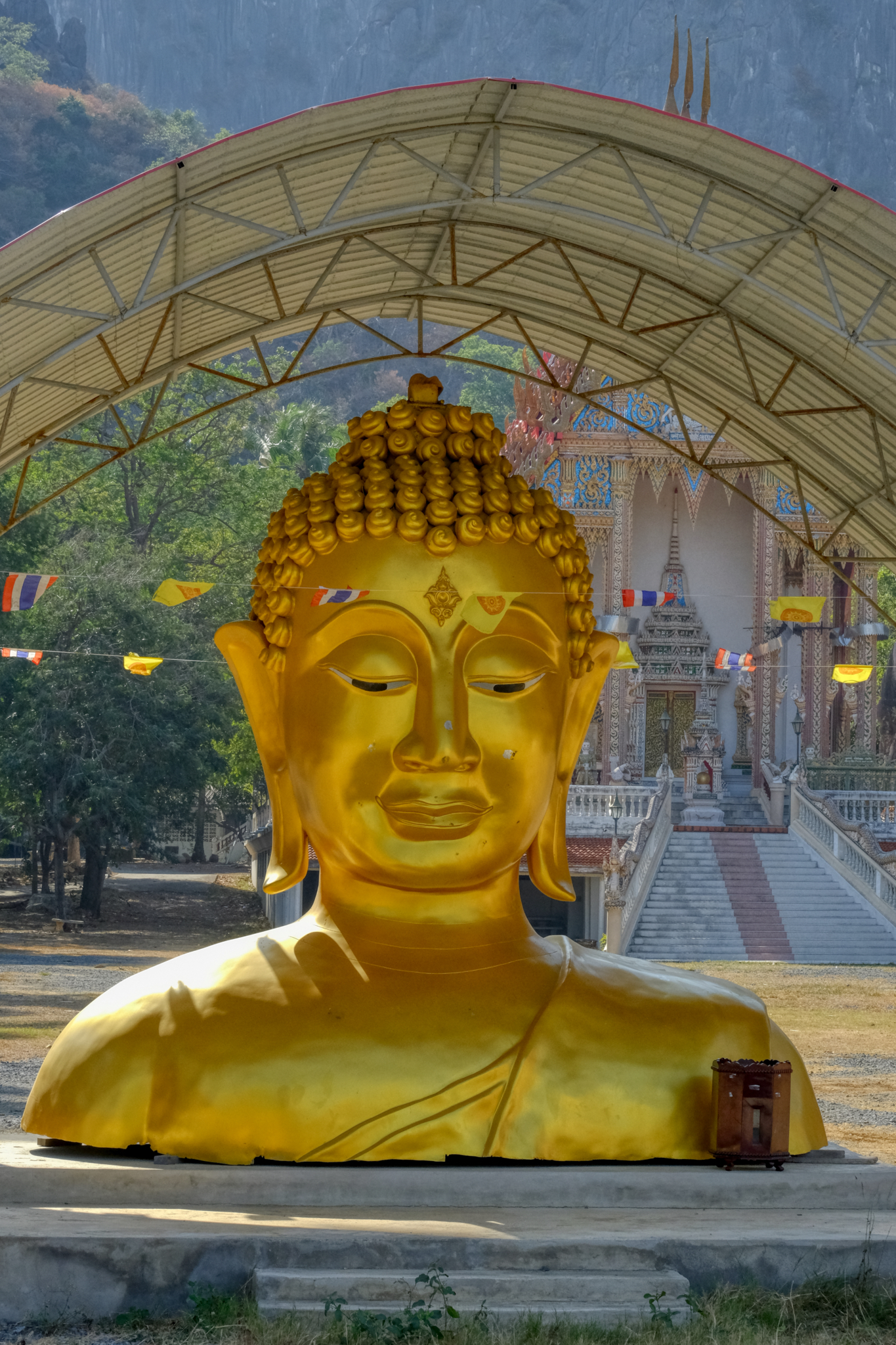
Beautiful workmanship . . . .
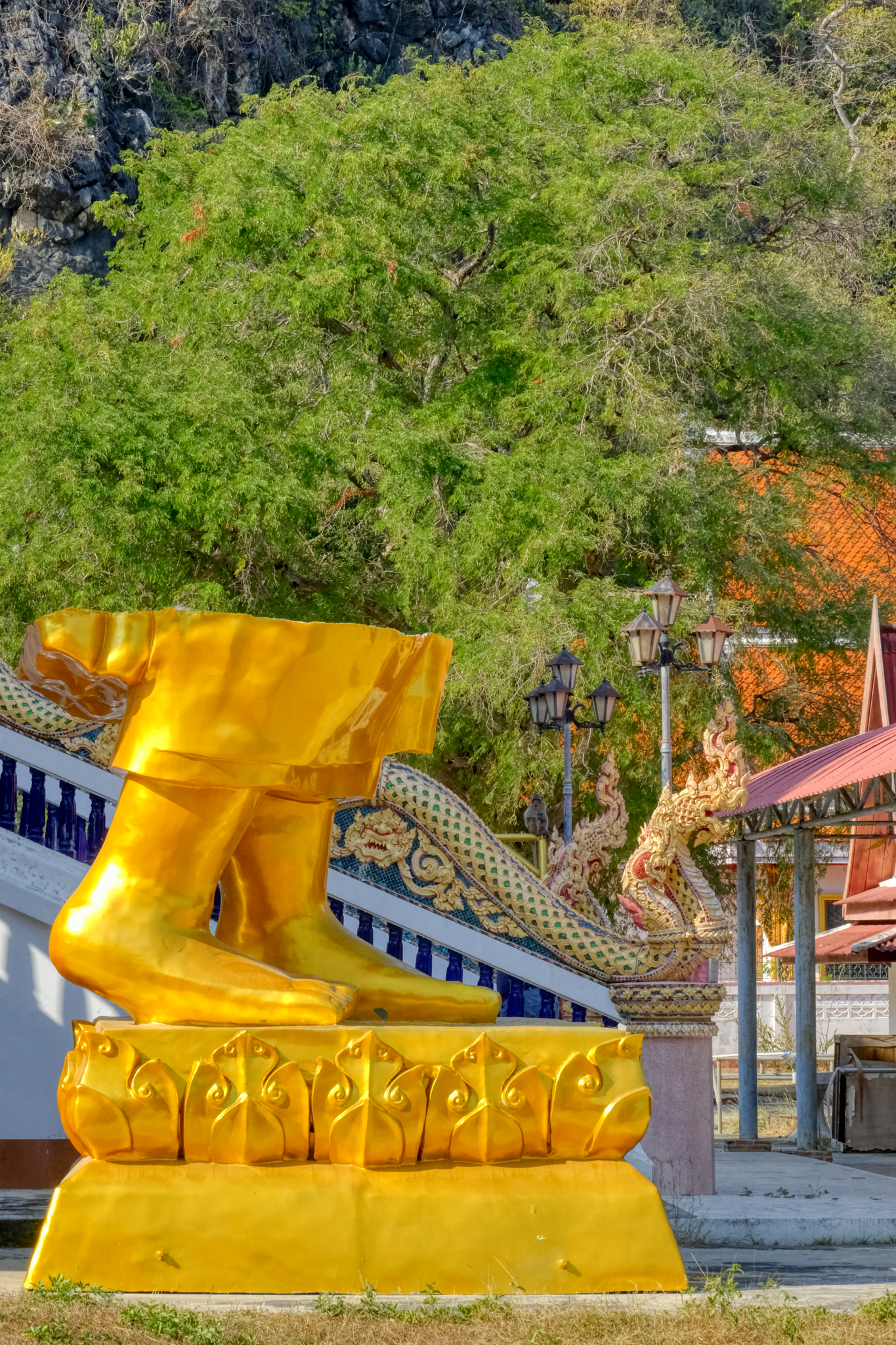
Ah! Looks like a standing Buddha image going up.
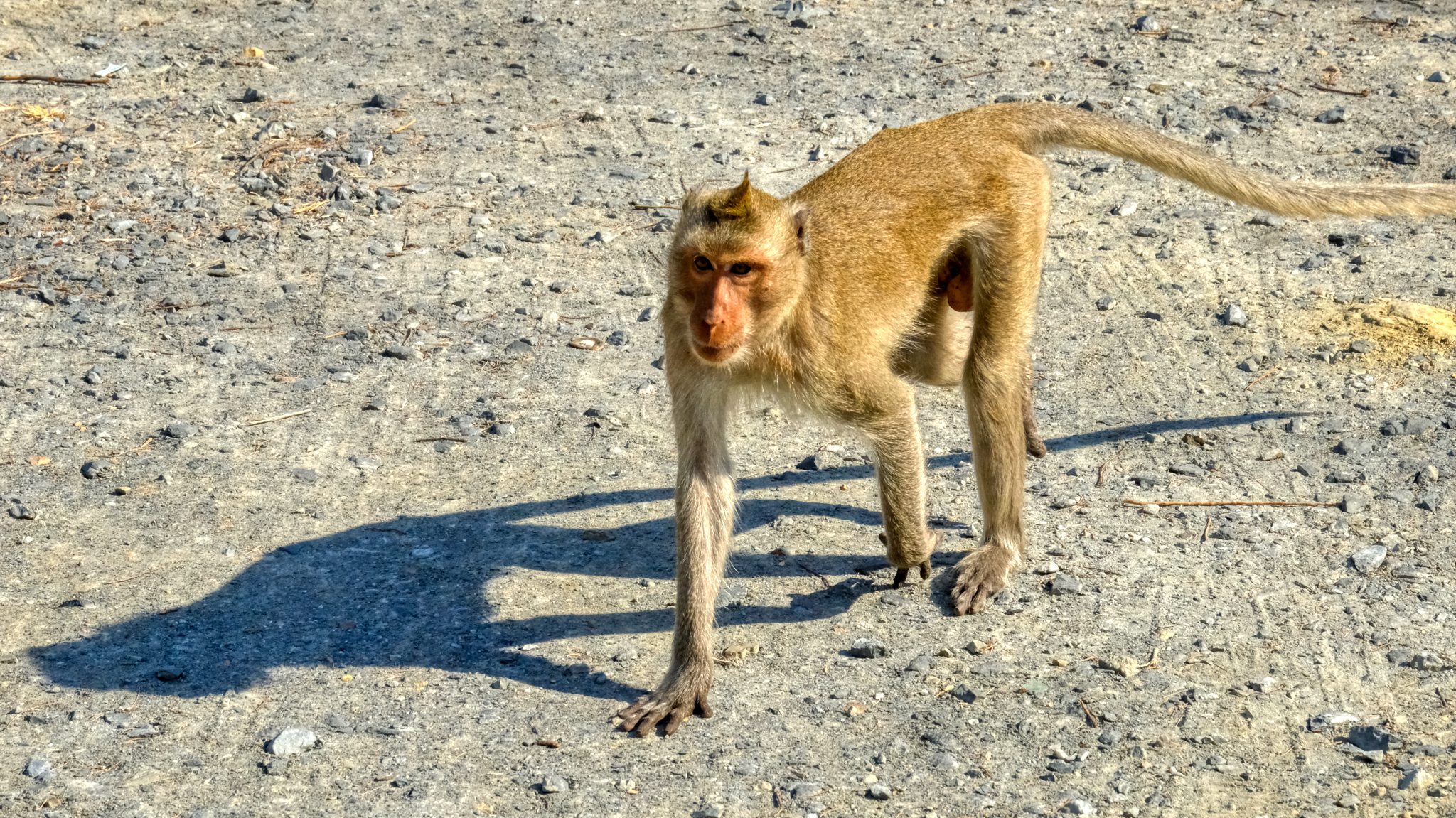 This such an interesting wat . . . lots to see here . . . including a pack of very curious monkeys.
This such an interesting wat . . . lots to see here . . . including a pack of very curious monkeys.
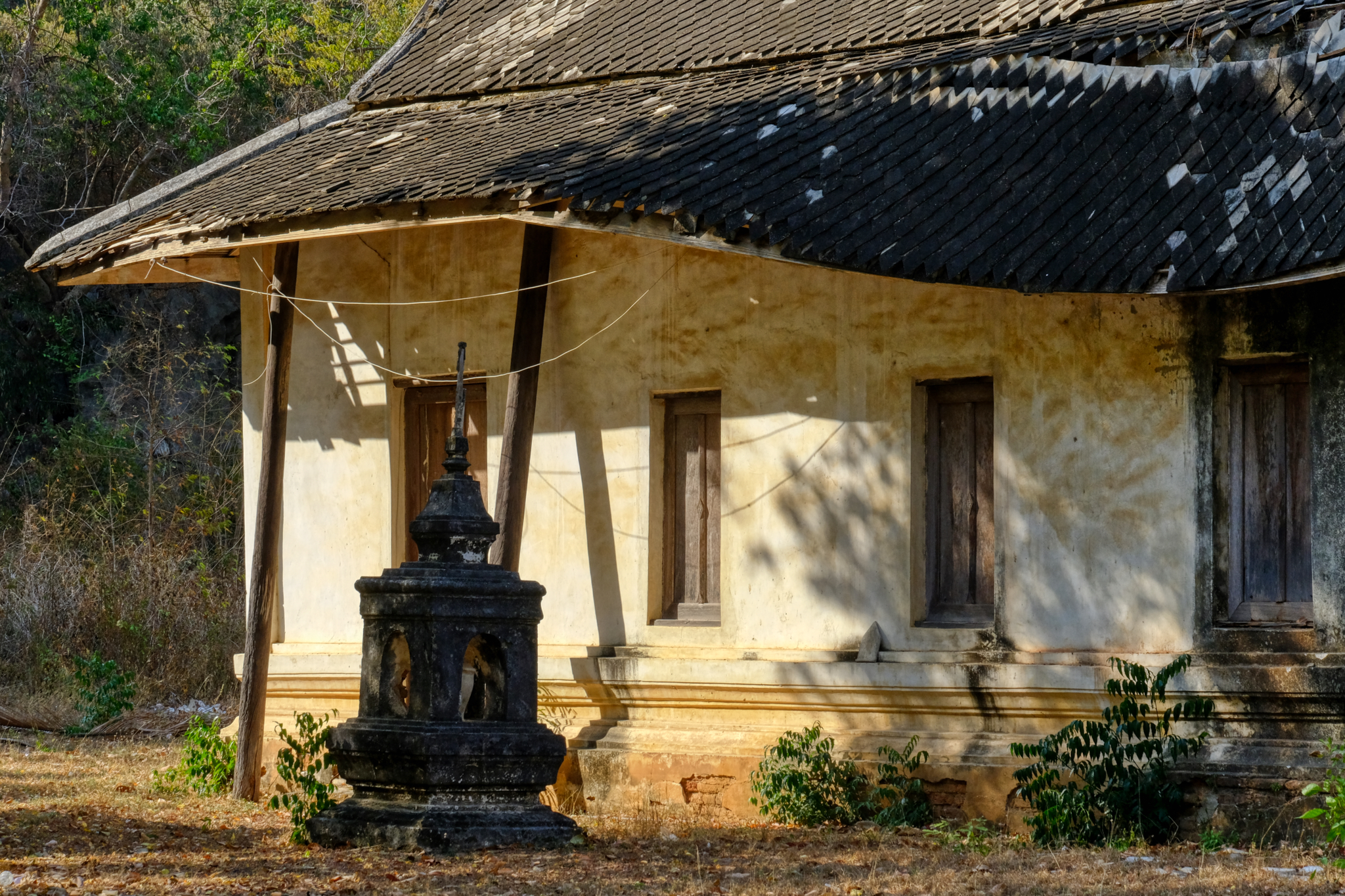 As is often the case at Thai wats, the new buildings are built in front of the older, perhaps original temple structures.
As is often the case at Thai wats, the new buildings are built in front of the older, perhaps original temple structures.
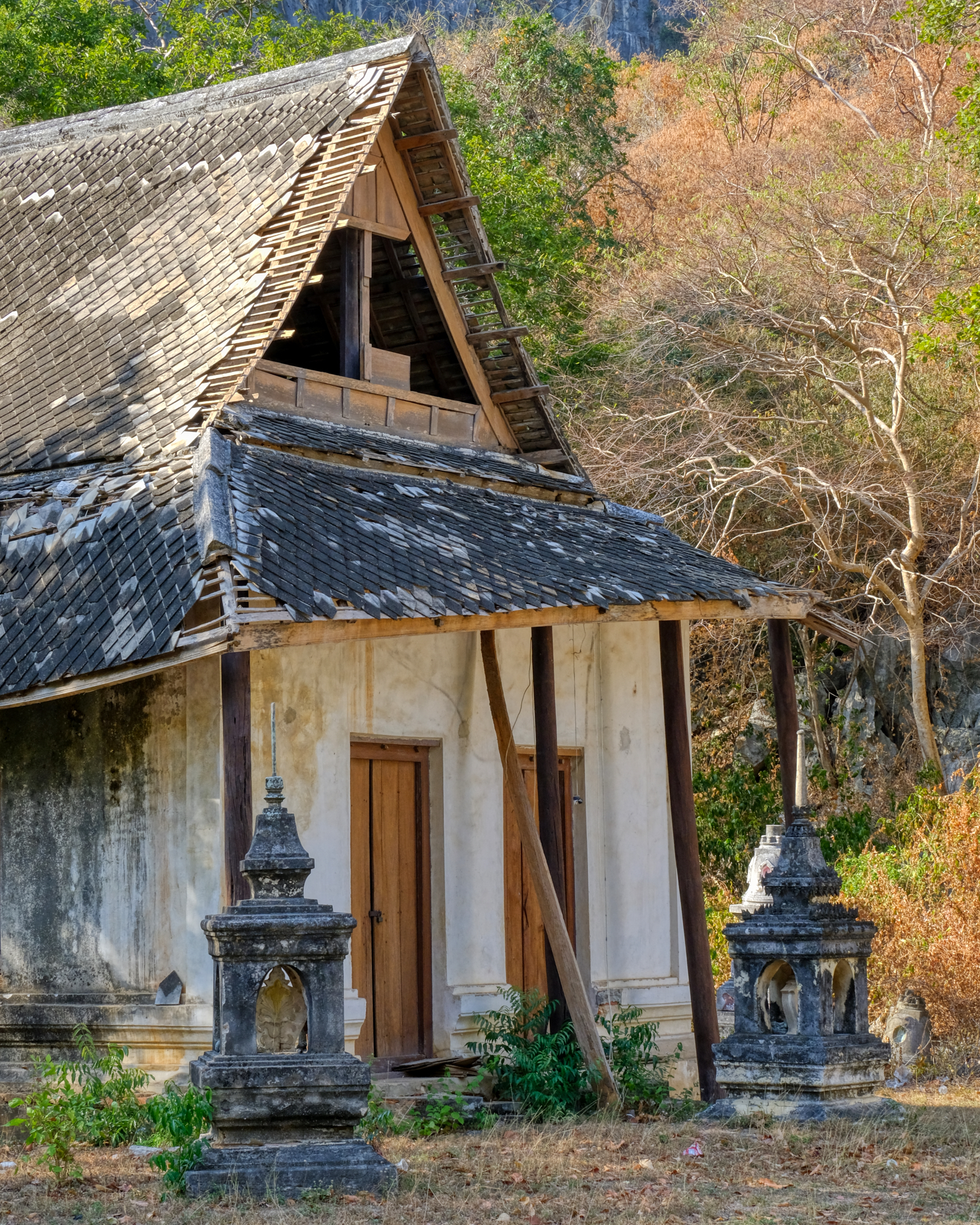 The patina!
The patina!
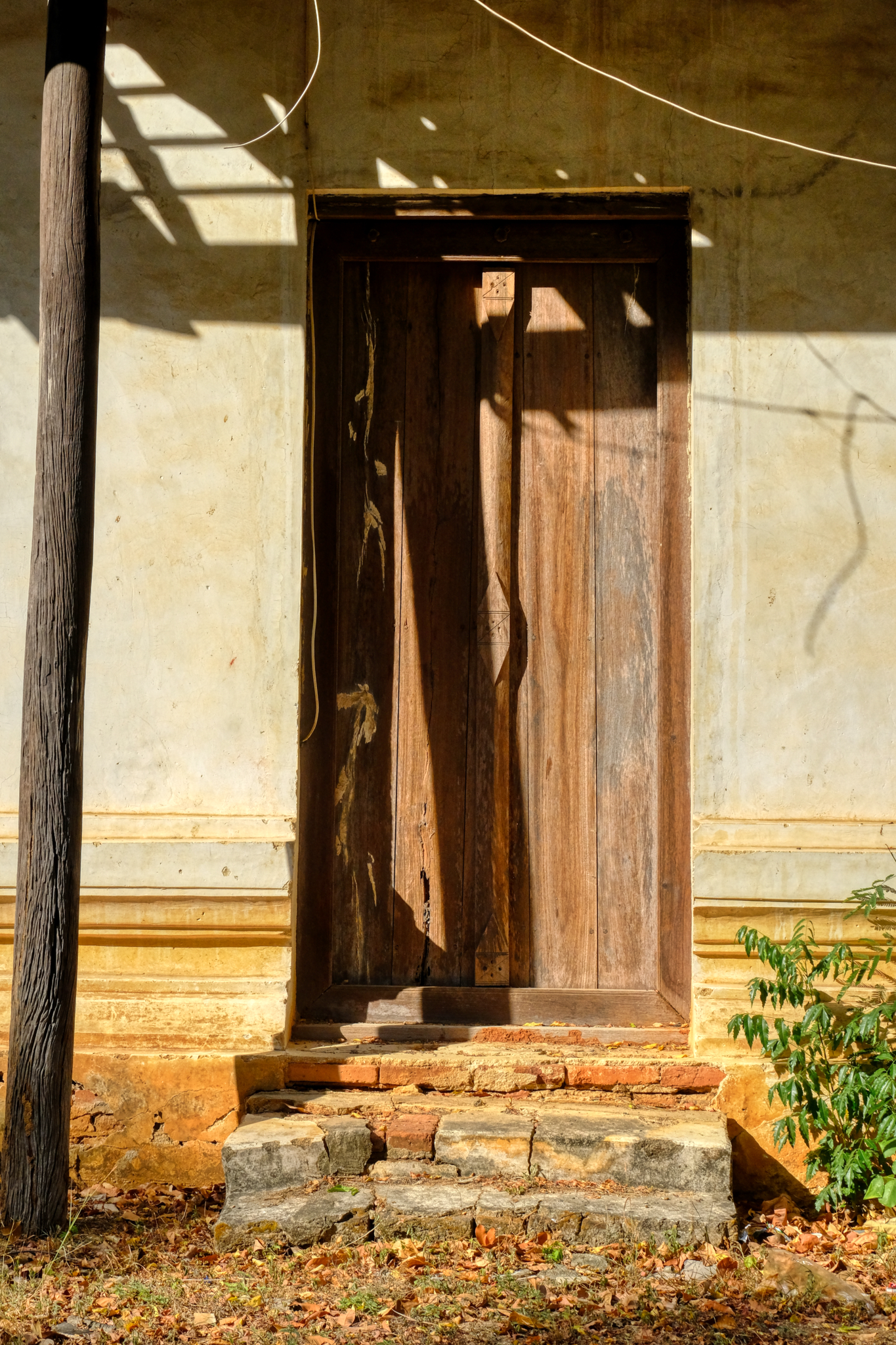 Lovely textures in the filtered afternoon light.
Lovely textures in the filtered afternoon light.
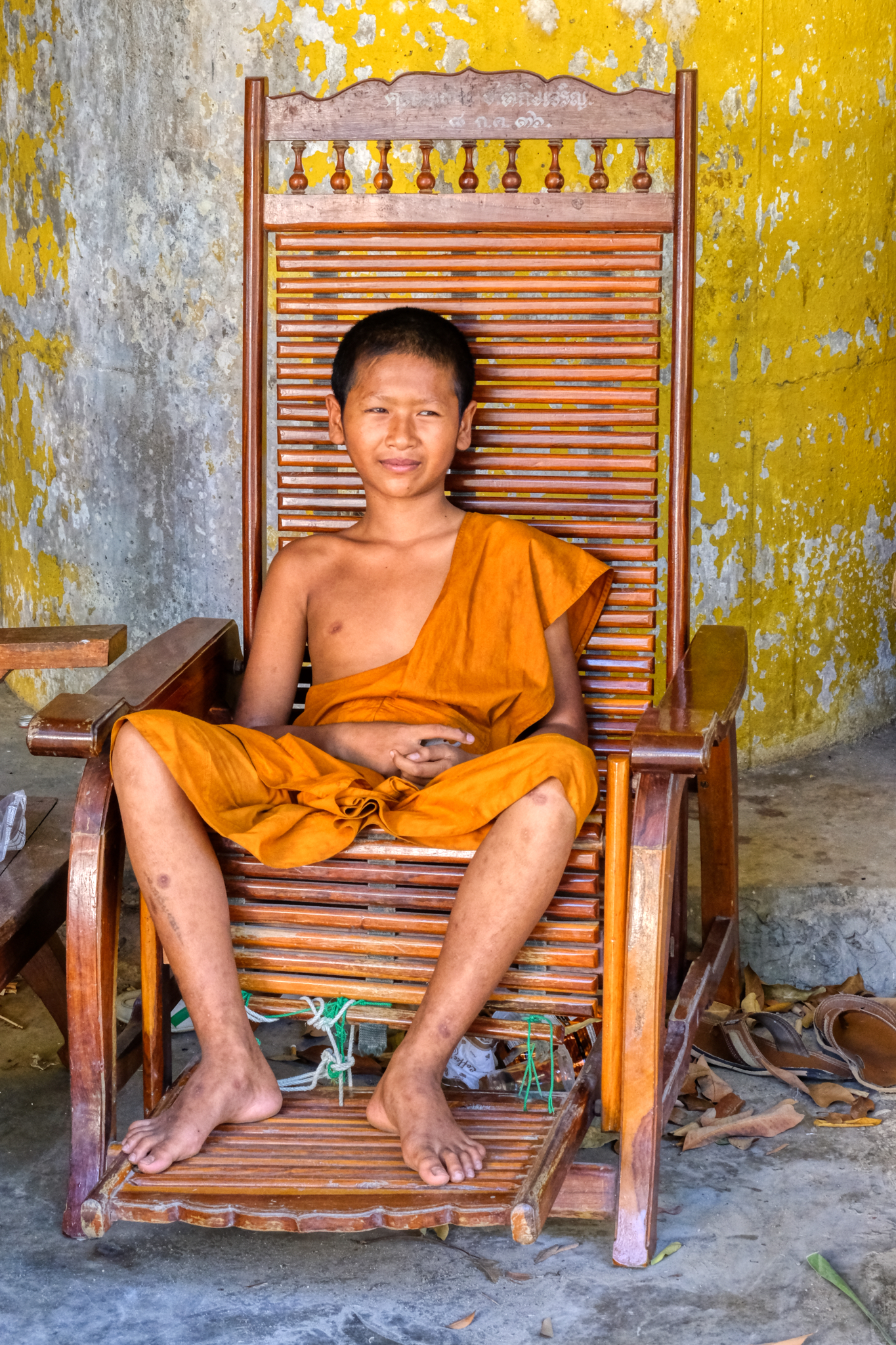 I was surprised to see this young monk! There weren't any other monks at this wat. He kindly gave me permission for so photos. I made sure he saw me put money in the donation box.
I was surprised to see this young monk! There weren't any other monks at this wat. He kindly gave me permission for so photos. I made sure he saw me put money in the donation box.
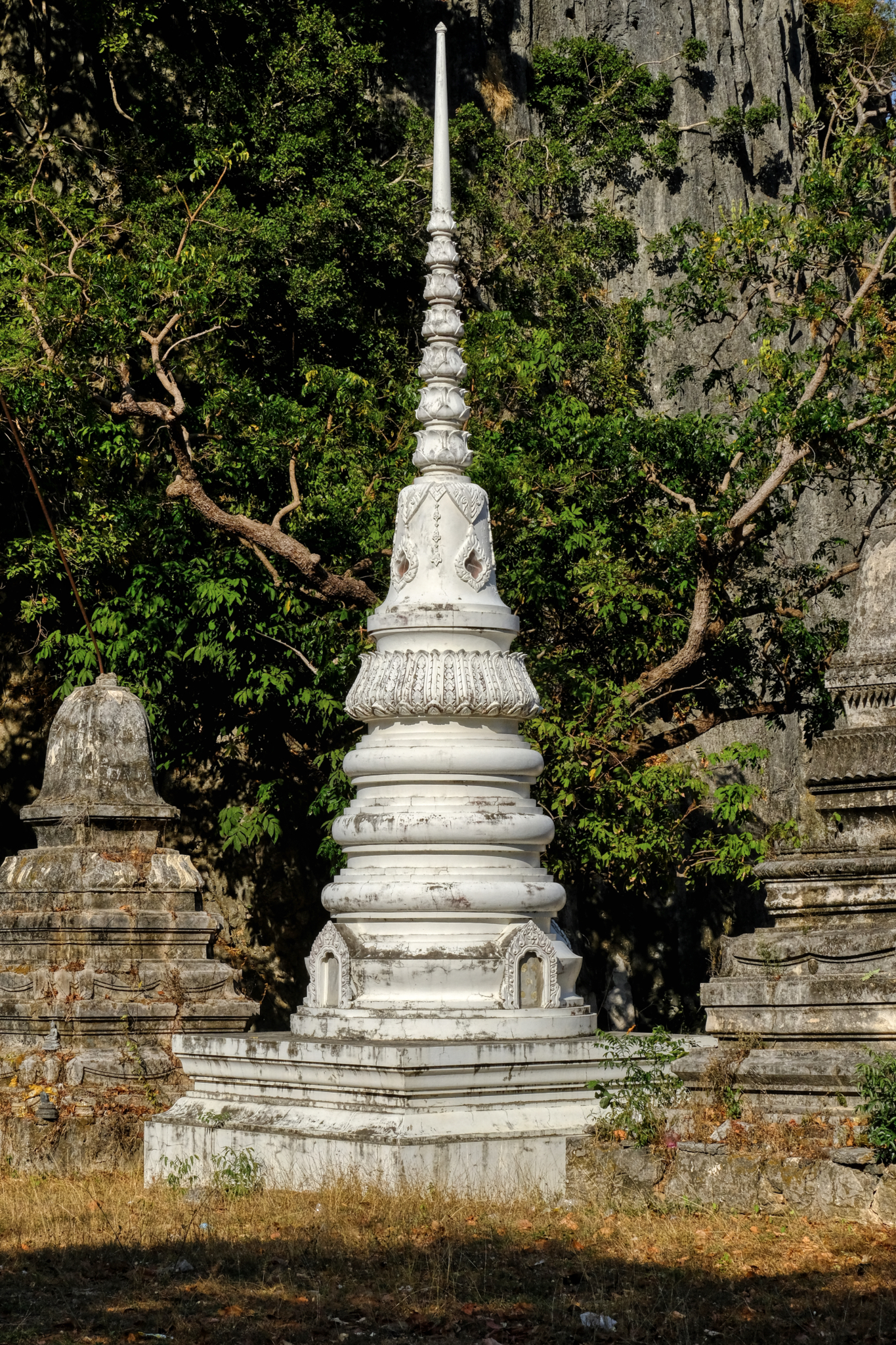 A large, old chedi on the temple grounds. Perhaps a previous revered head monk's final resting place.
A large, old chedi on the temple grounds. Perhaps a previous revered head monk's final resting place.
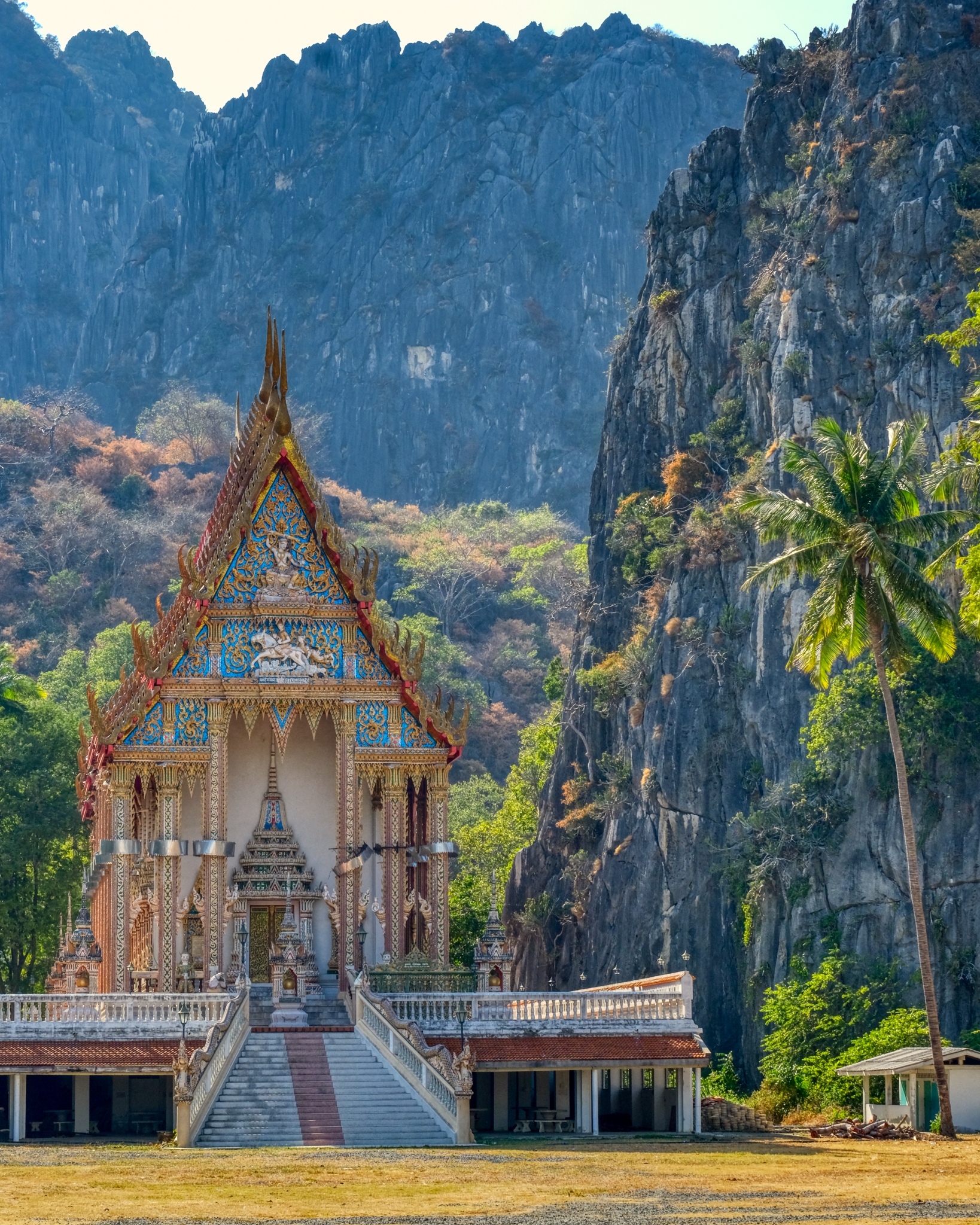 One last look at this fantastic cliff side wat.
One last look at this fantastic cliff side wat.
----------------------------------------------------------------
Wat Huai Sai Tai Temple
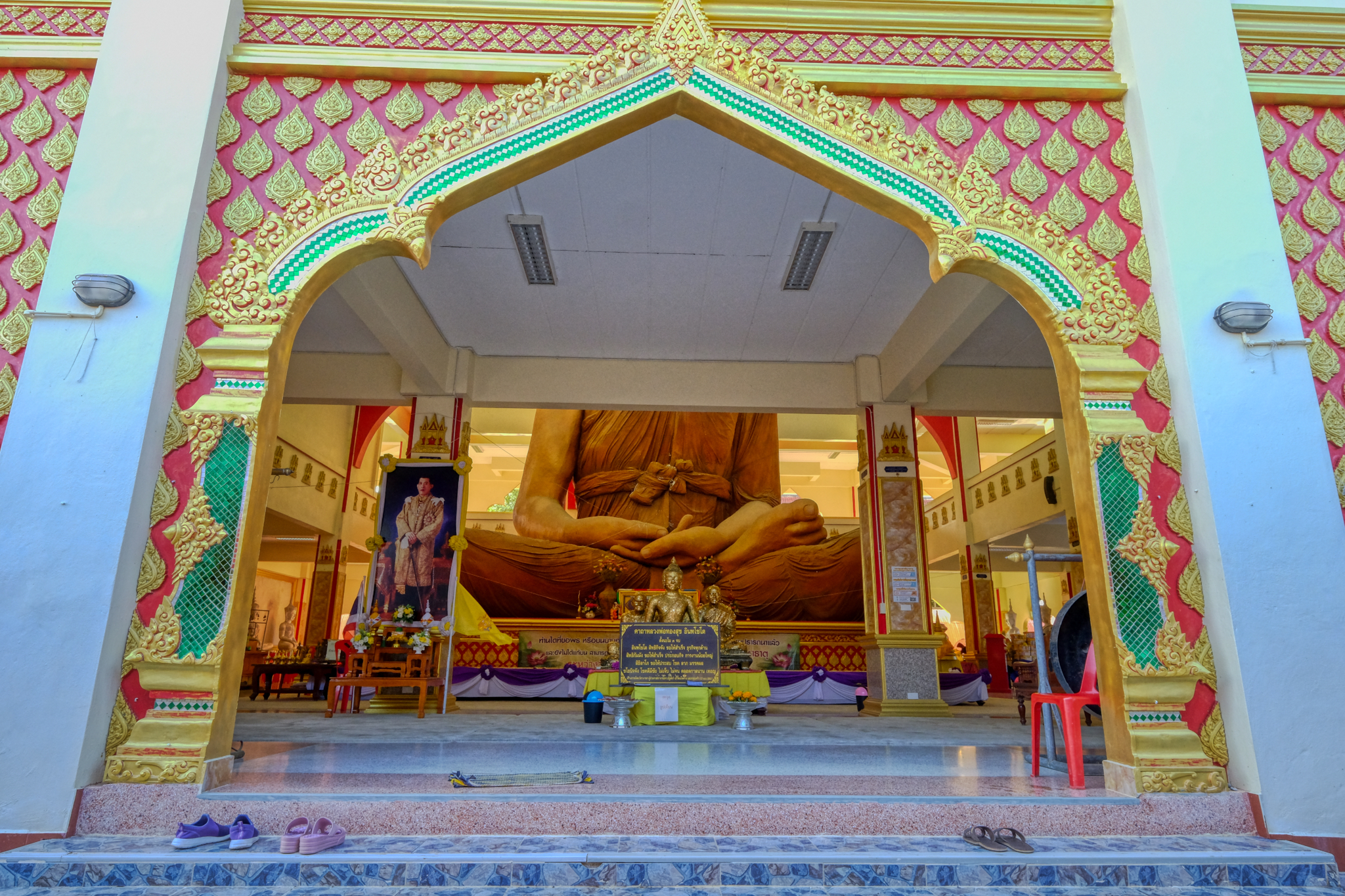 On the way back from our hilltop chedi, I wanted to stop and show my friend the Colossus of Hua Hin at Wat Hui Sai Tai!
On the way back from our hilltop chedi, I wanted to stop and show my friend the Colossus of Hua Hin at Wat Hui Sai Tai!
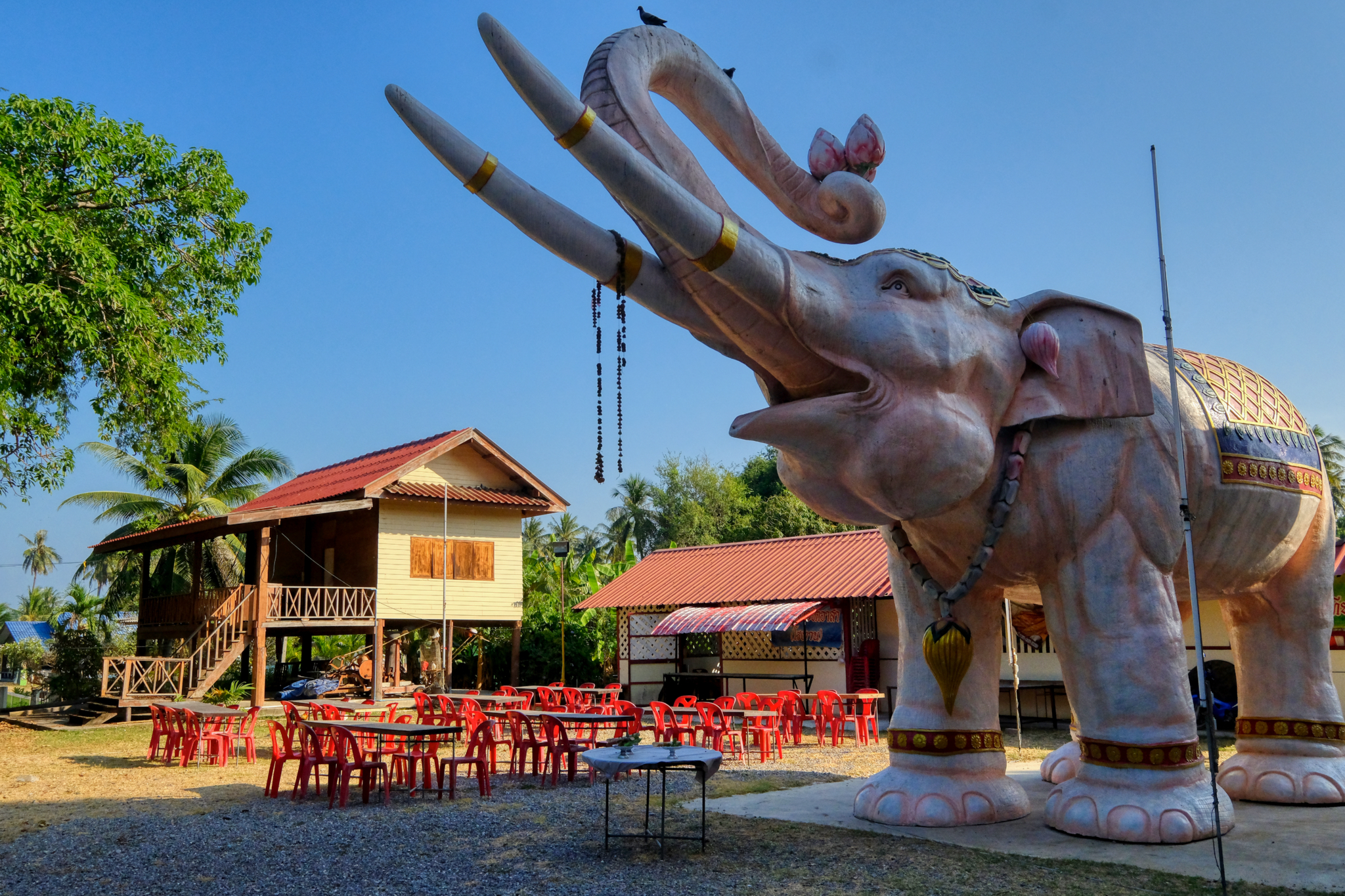 Such a lovely and strange place . . .
Such a lovely and strange place . . .
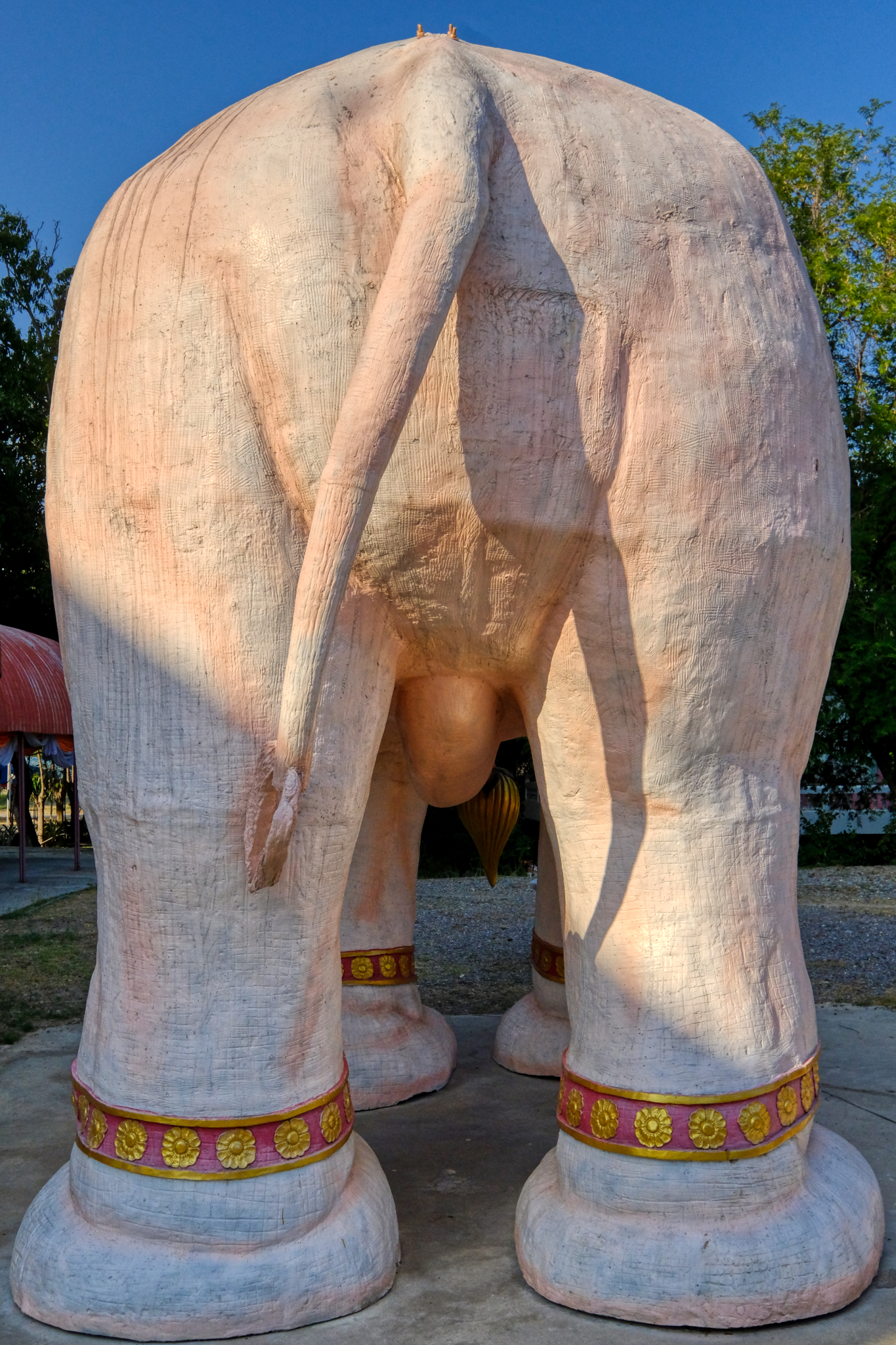 Yep . . . a cement elephant's butt.
Yep . . . a cement elephant's butt.
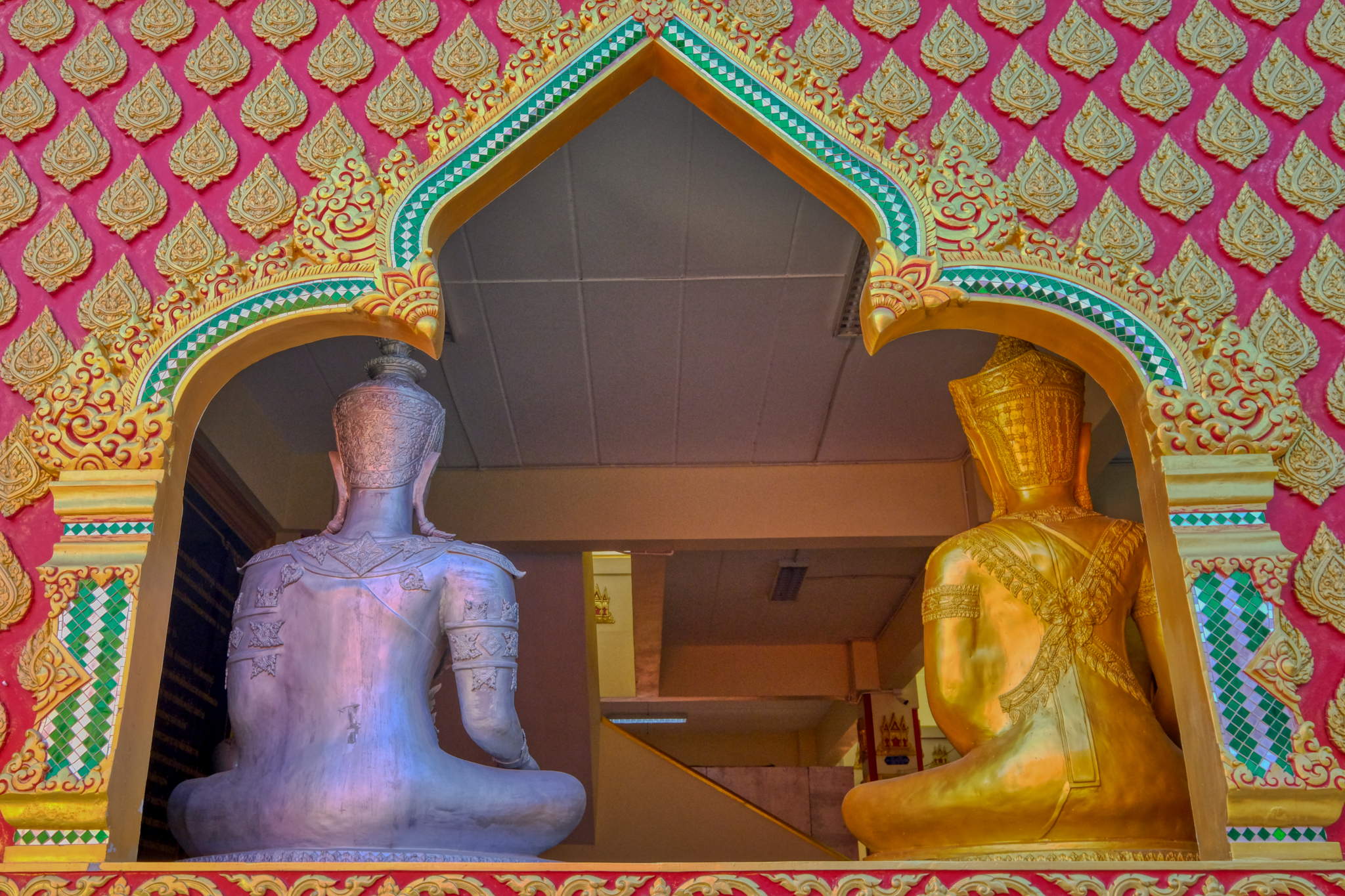 The spaces and surfaces around the outside of the temple were beautifully decorated.
The spaces and surfaces around the outside of the temple were beautifully decorated.
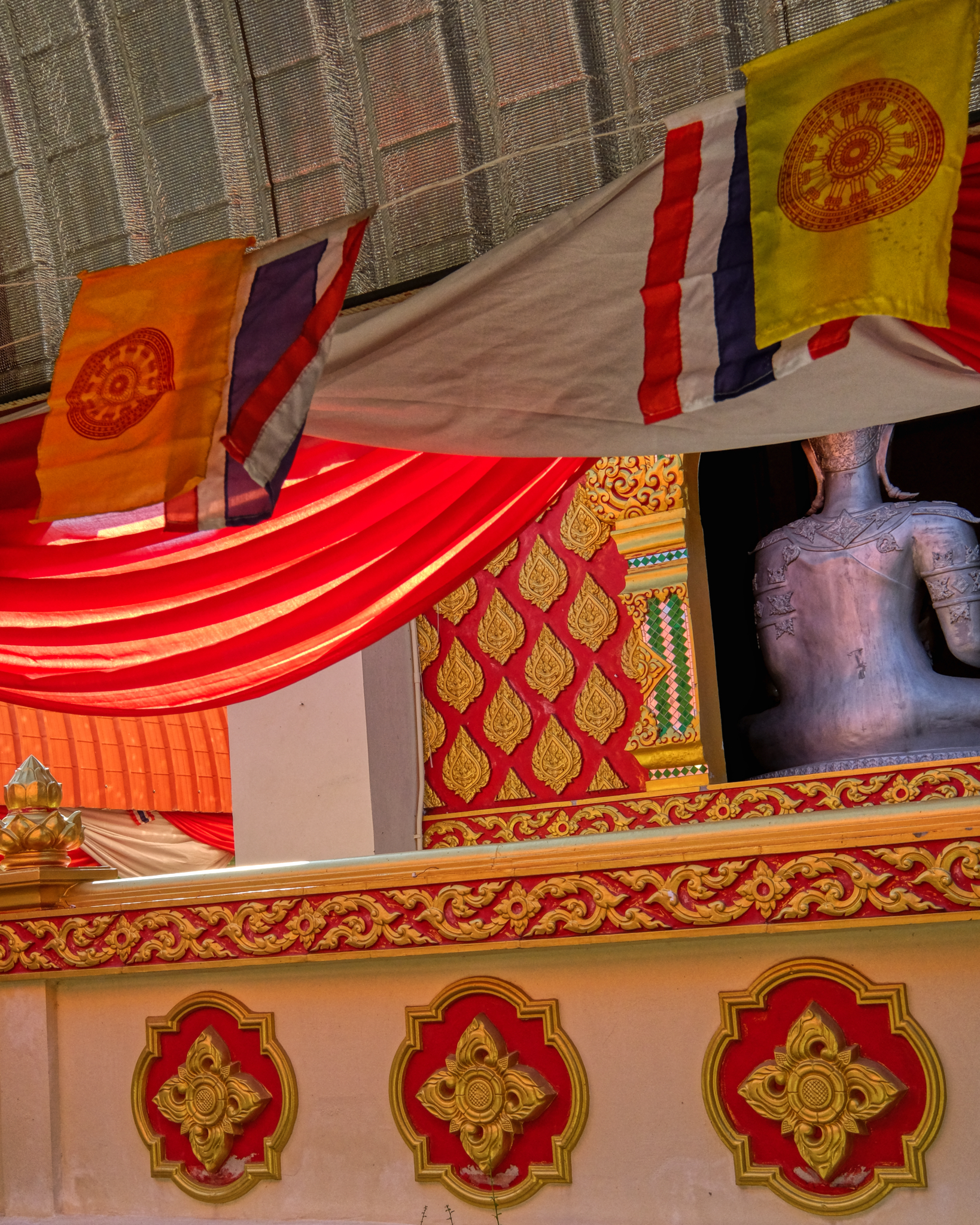 The exterior details were aesthetically very pleasing.
The exterior details were aesthetically very pleasing.
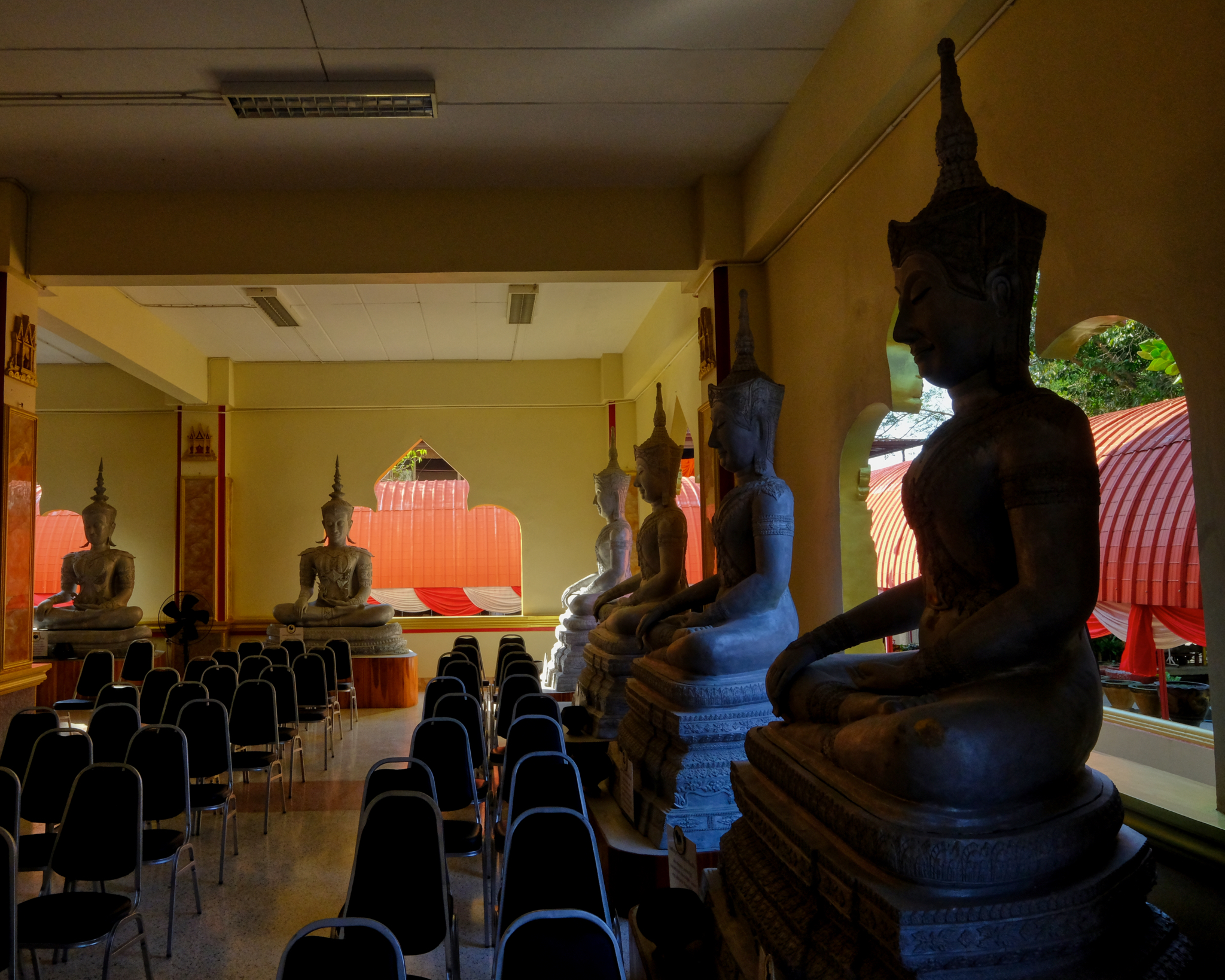 Of course, we had not come to just admire the exterior decor . . . it was what was inside that attracted us . . .
Of course, we had not come to just admire the exterior decor . . . it was what was inside that attracted us . . .
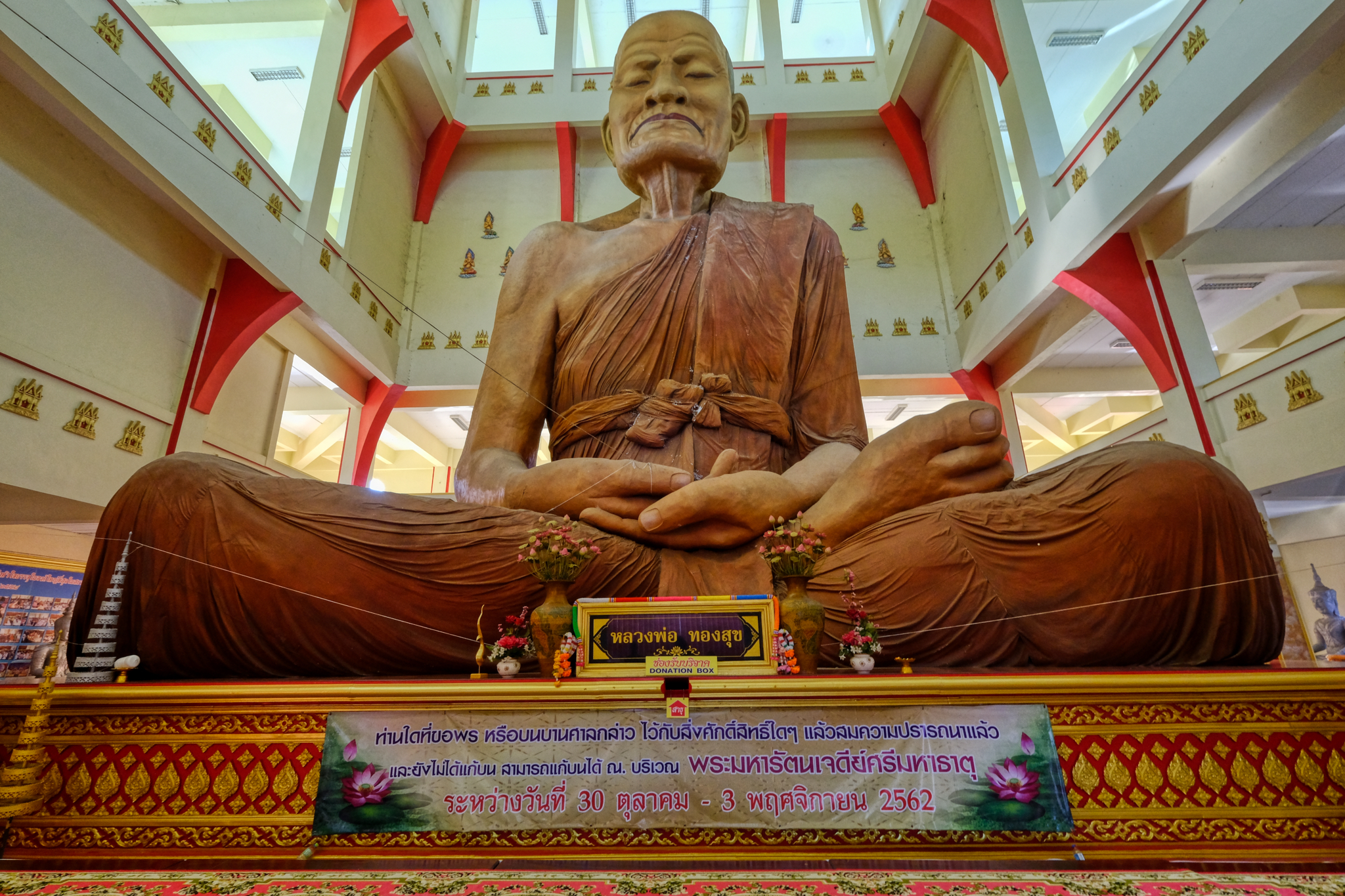 What attracted us was the colossal statue of the venerated monk, Luong Phor Thongsuk!
What attracted us was the colossal statue of the venerated monk, Luong Phor Thongsuk!
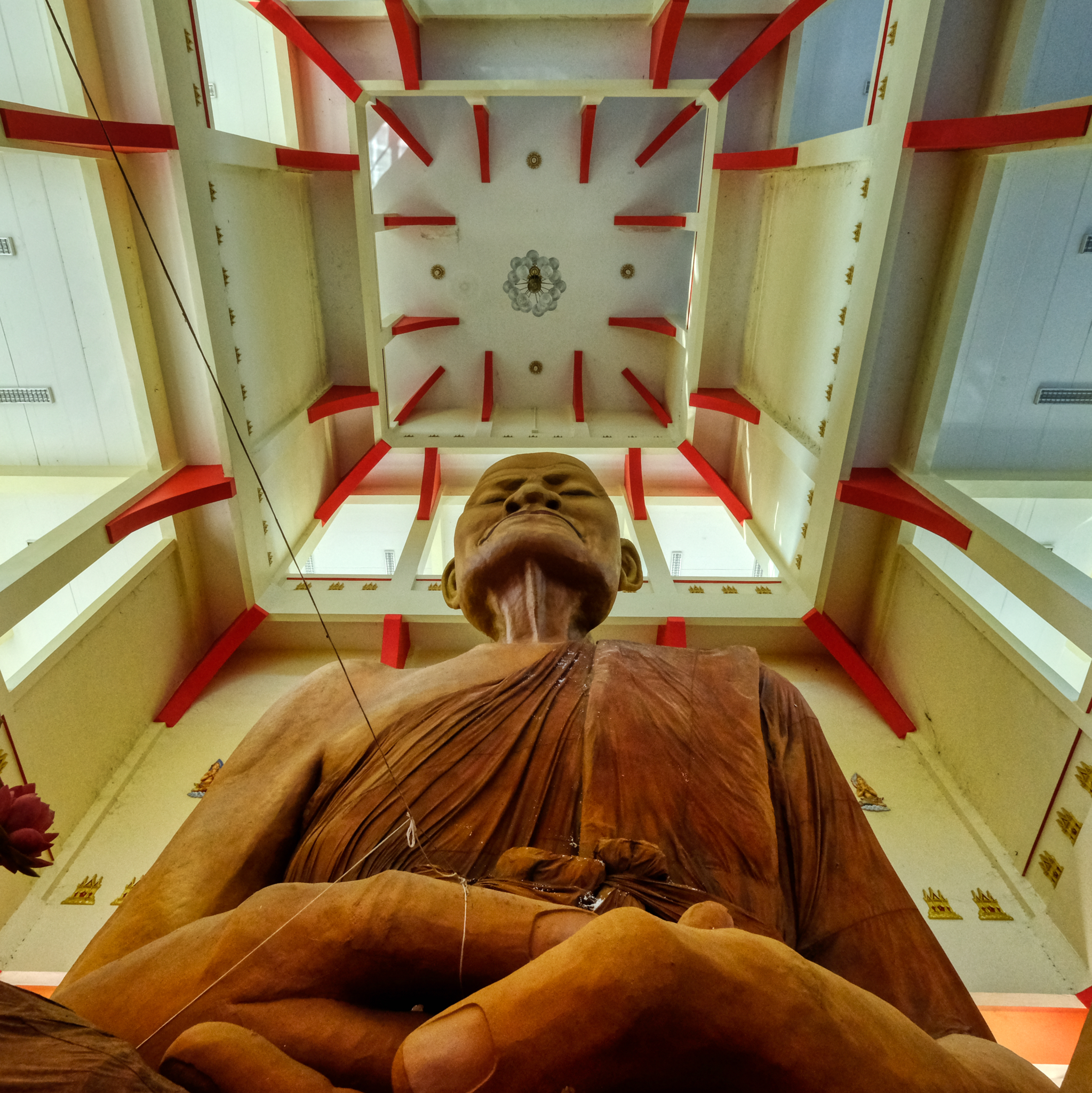 The giant Luang Phor Thongsuk in all his revered glory.
The giant Luang Phor Thongsuk in all his revered glory.
 The scale of this statue is incredible!
The scale of this statue is incredible!
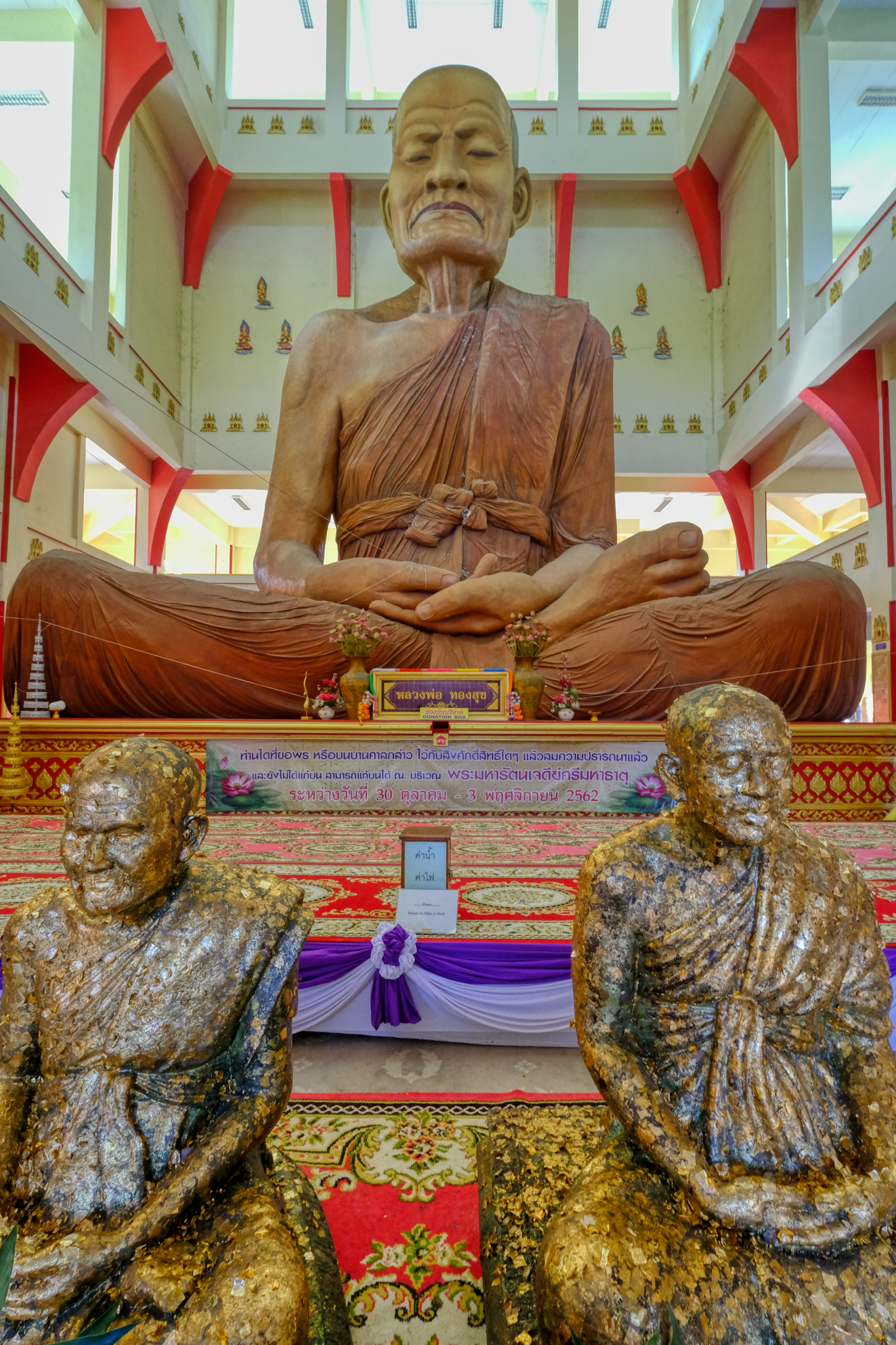 During our short visit here, many people came to pay their respects.
During our short visit here, many people came to pay their respects.
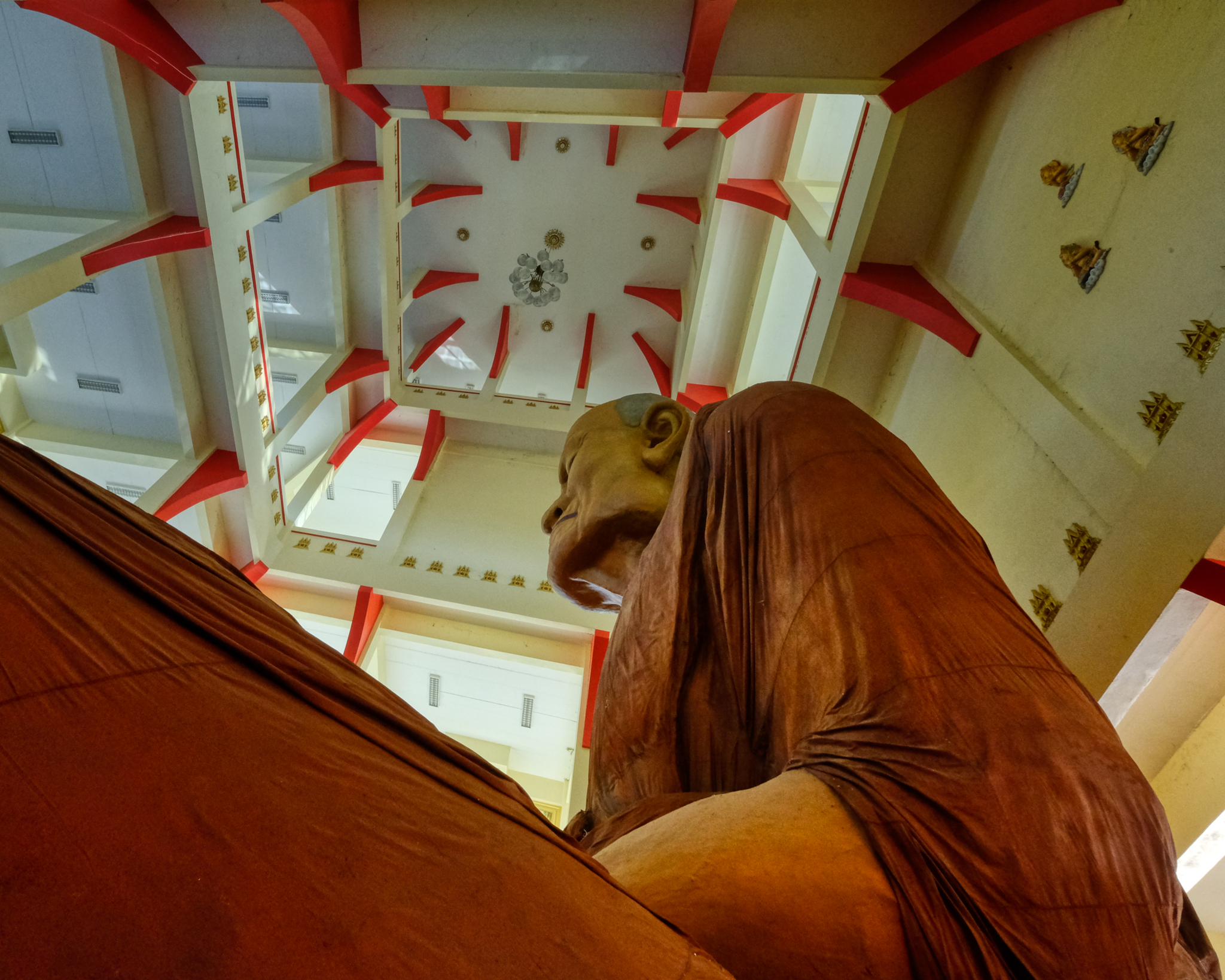 Our last look at the colossus!
Our last look at the colossus!
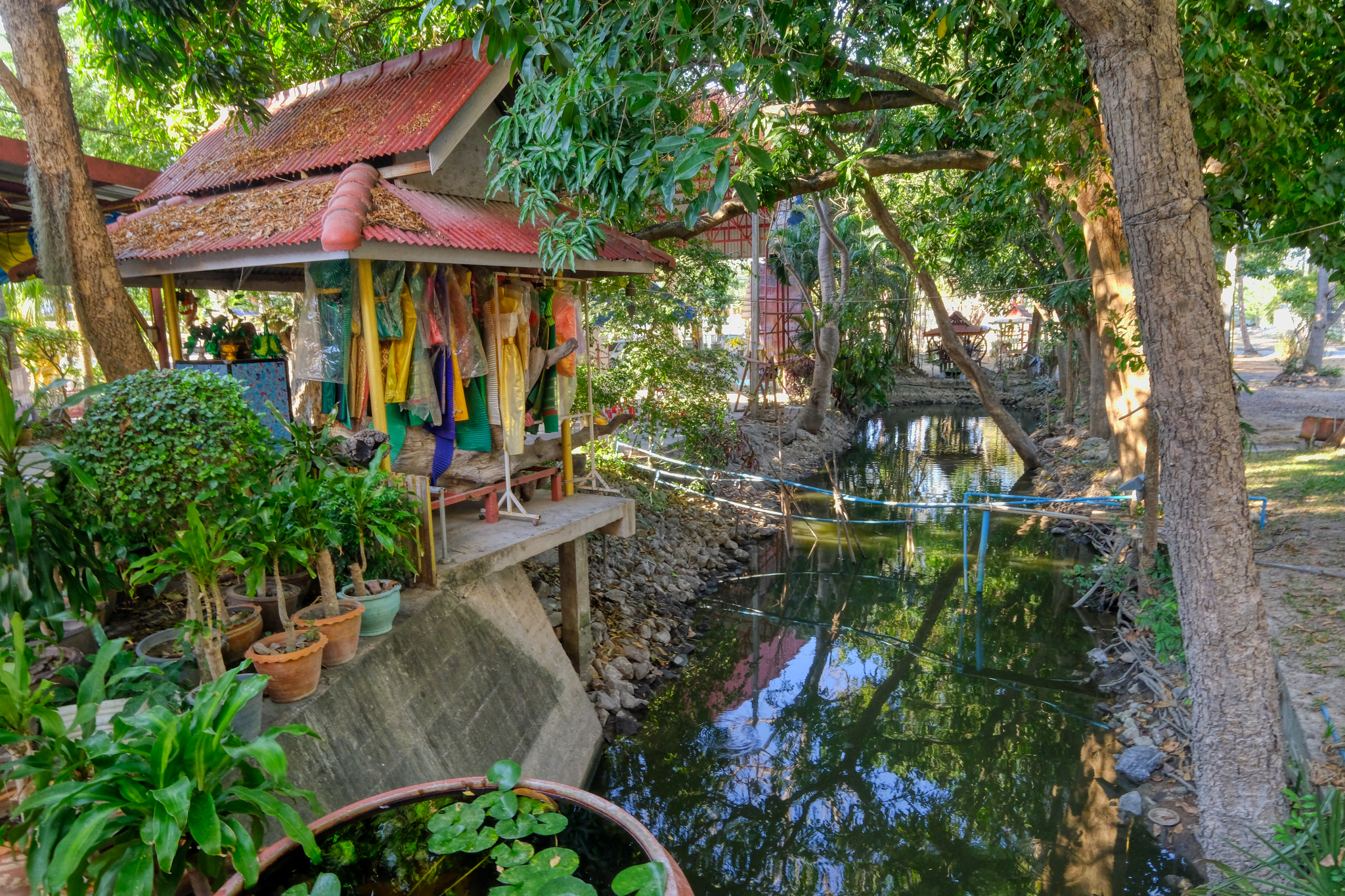 A marvelous spirit house on the grounds of Wat Hui Sai Tai.
A marvelous spirit house on the grounds of Wat Hui Sai Tai.
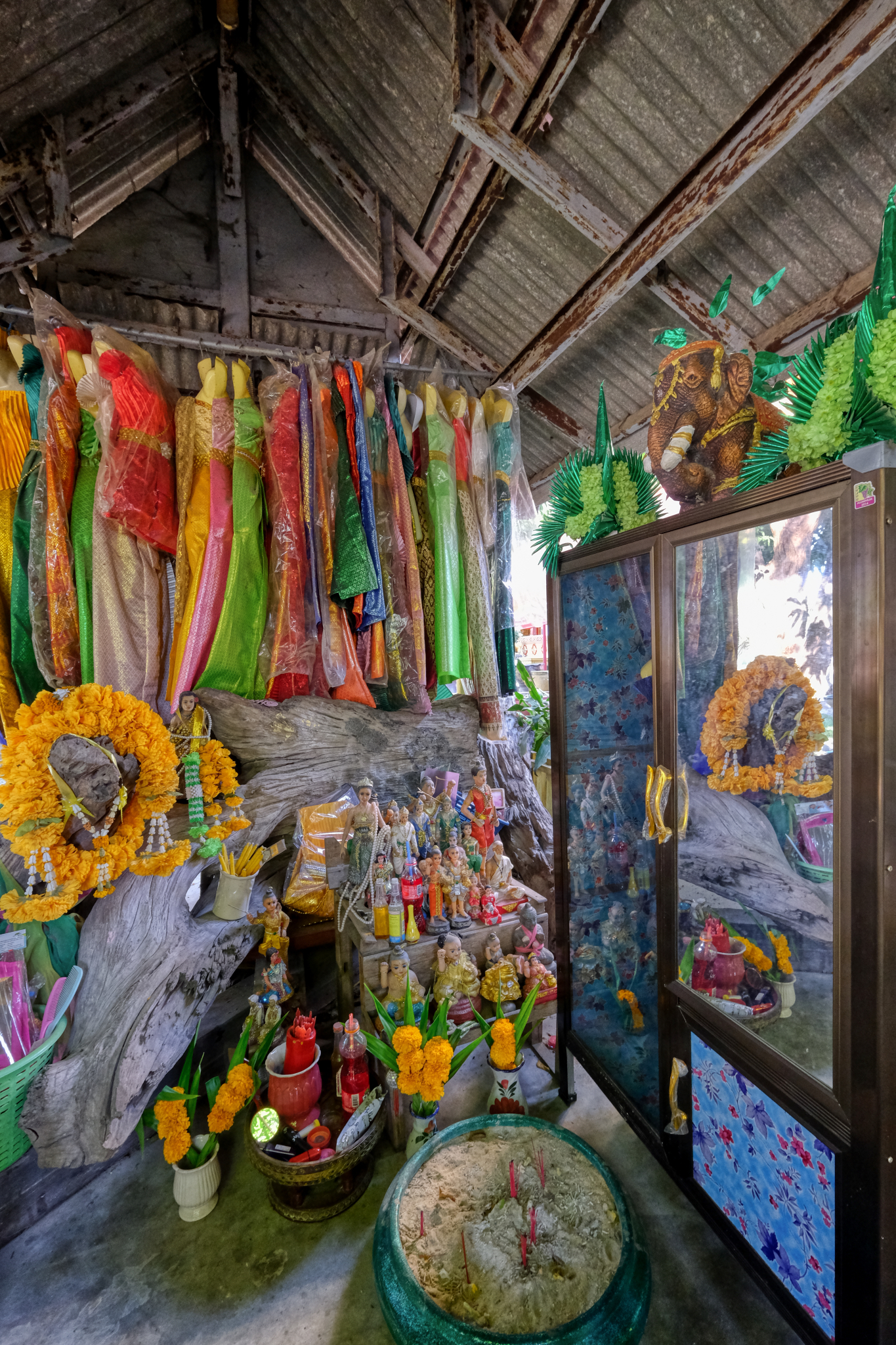 The inside of the wat spirit house . . . very well tended by the pilgrims.
The inside of the wat spirit house . . . very well tended by the pilgrims.
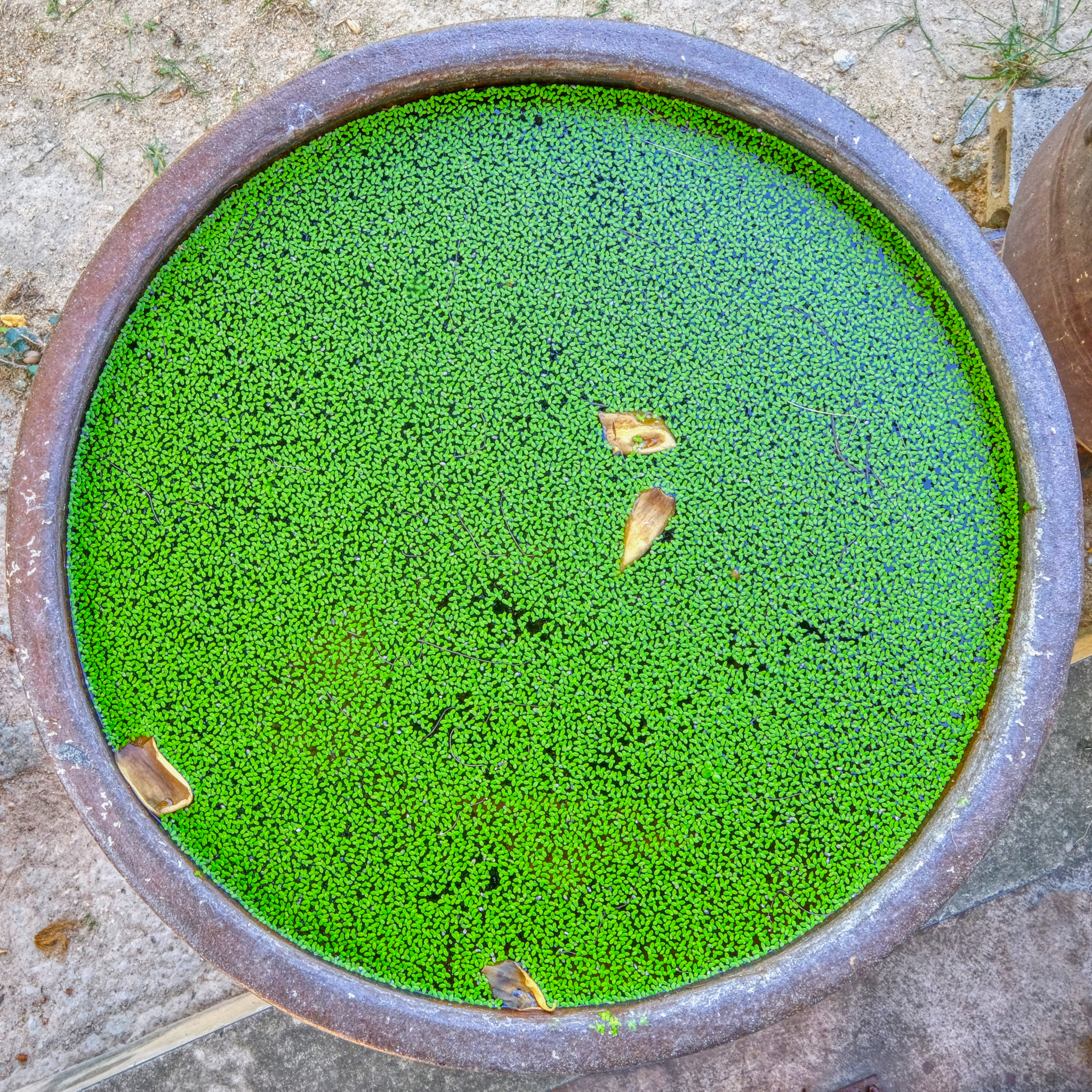 Beauty everywhere we pointed our cameras . . .
Beauty everywhere we pointed our cameras . . .
-----------------------------------------------------
An Old Fishing Village
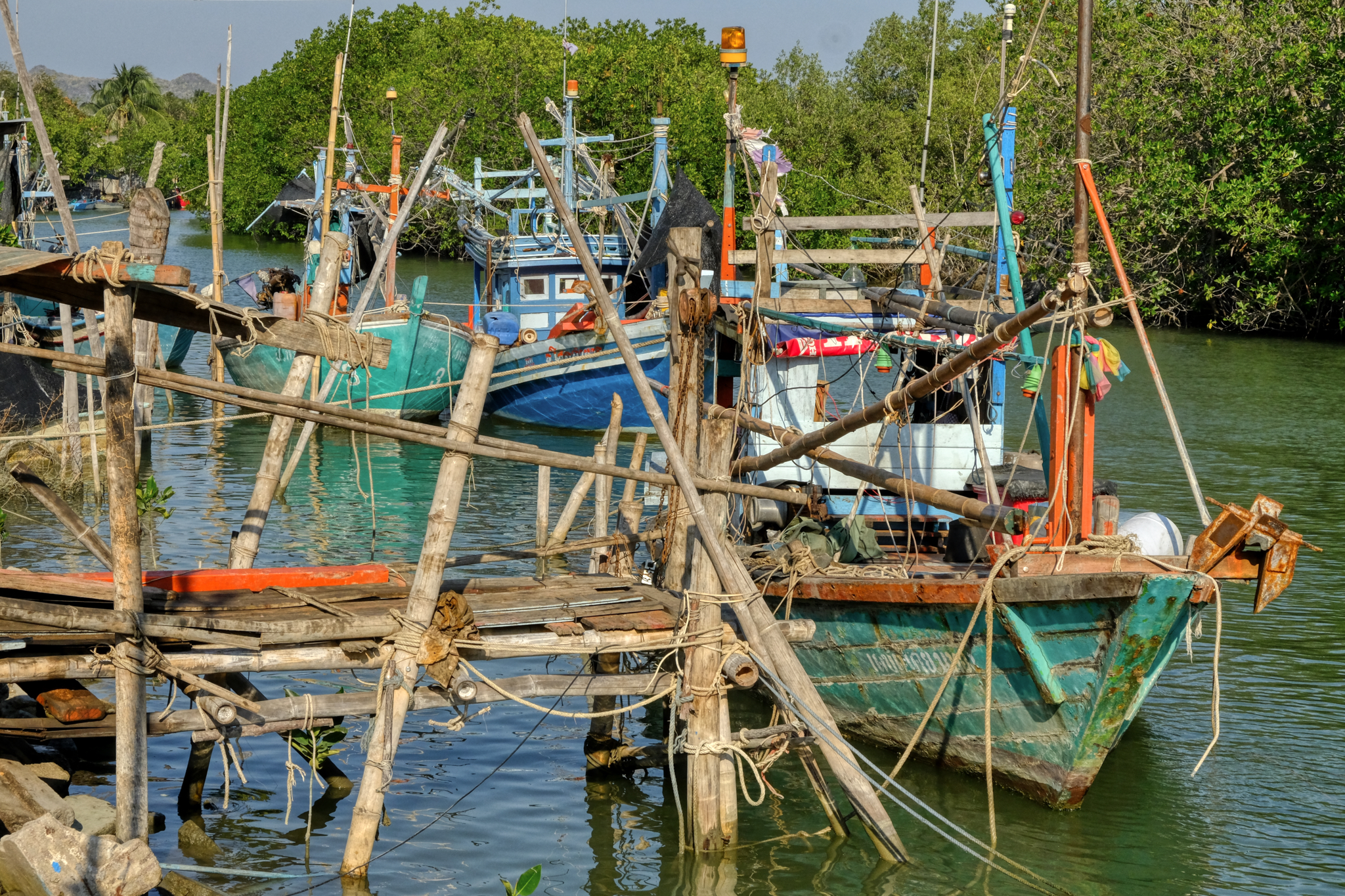 We headed up the road to our next destination, a beach about 20km away . . . but a quick glance on the GPS map showed a small village on an inlet . . . maybe a fishing village? YES!
We headed up the road to our next destination, a beach about 20km away . . . but a quick glance on the GPS map showed a small village on an inlet . . . maybe a fishing village? YES!
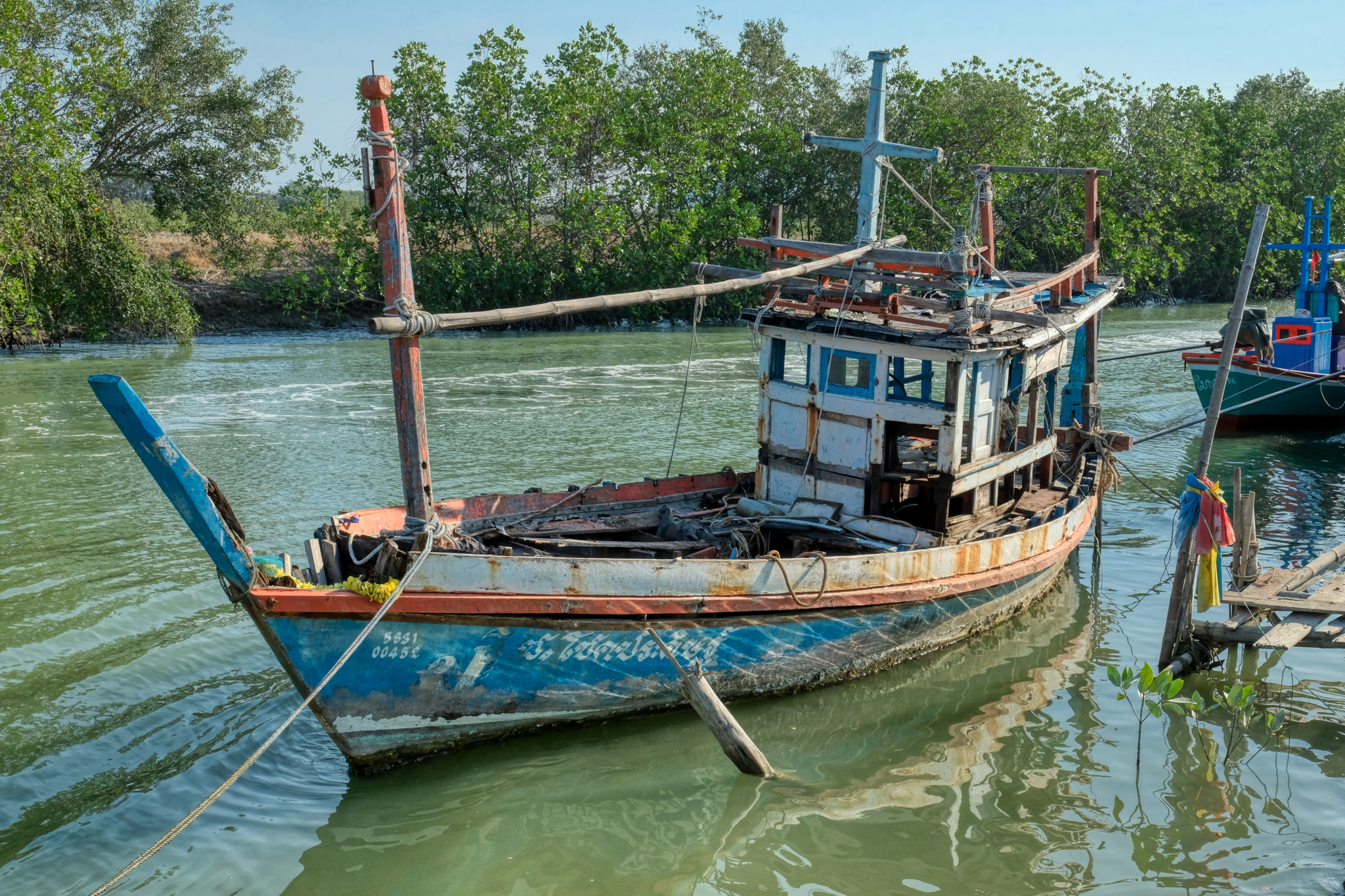 It was a very old fishing village . . . with a few very photogenic derelict old boats still dockside.
It was a very old fishing village . . . with a few very photogenic derelict old boats still dockside.
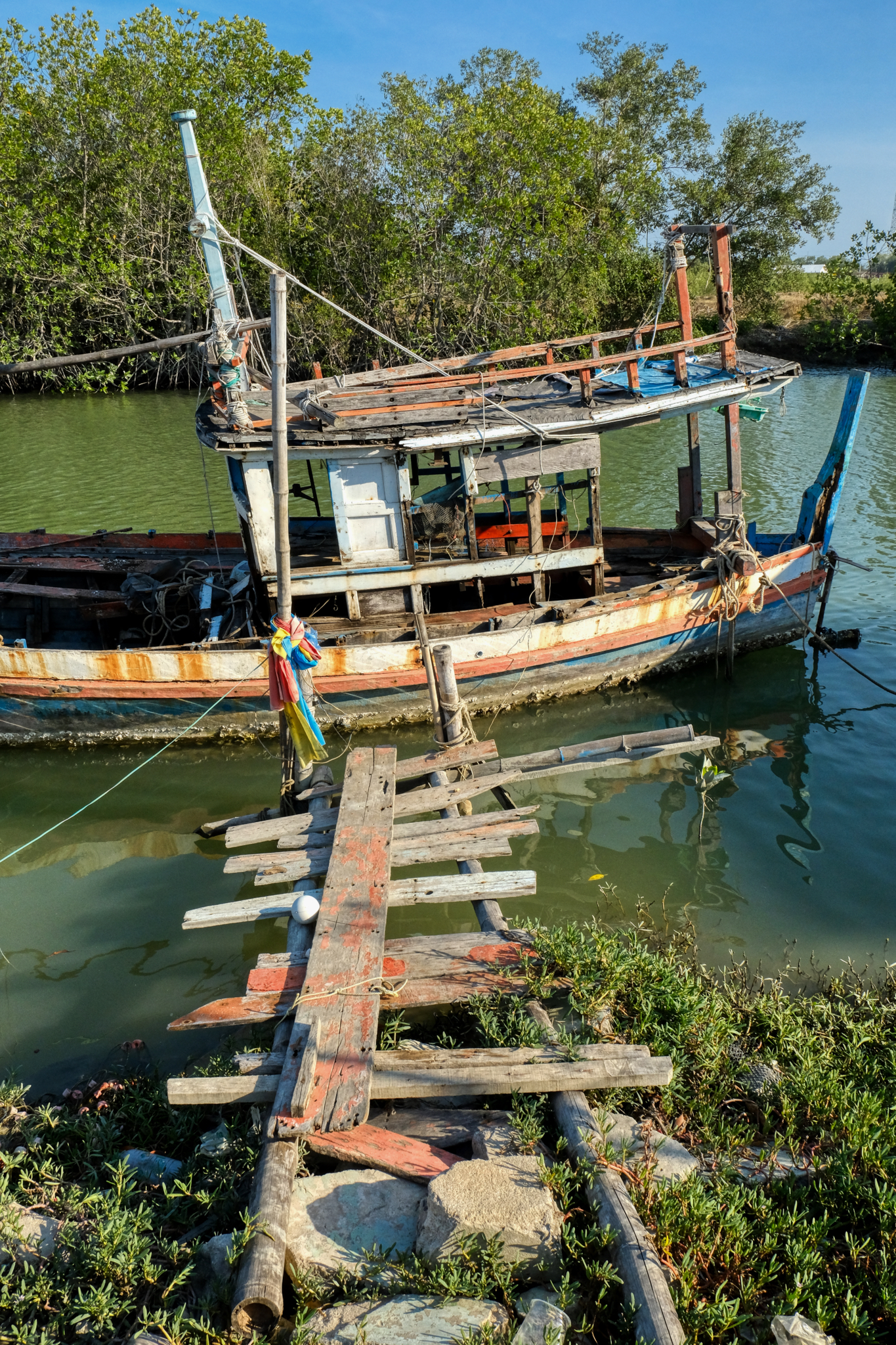 Did I say "old boat and old pier"? I meant to say "dilapidated pier and ghost ship"!
Did I say "old boat and old pier"? I meant to say "dilapidated pier and ghost ship"!
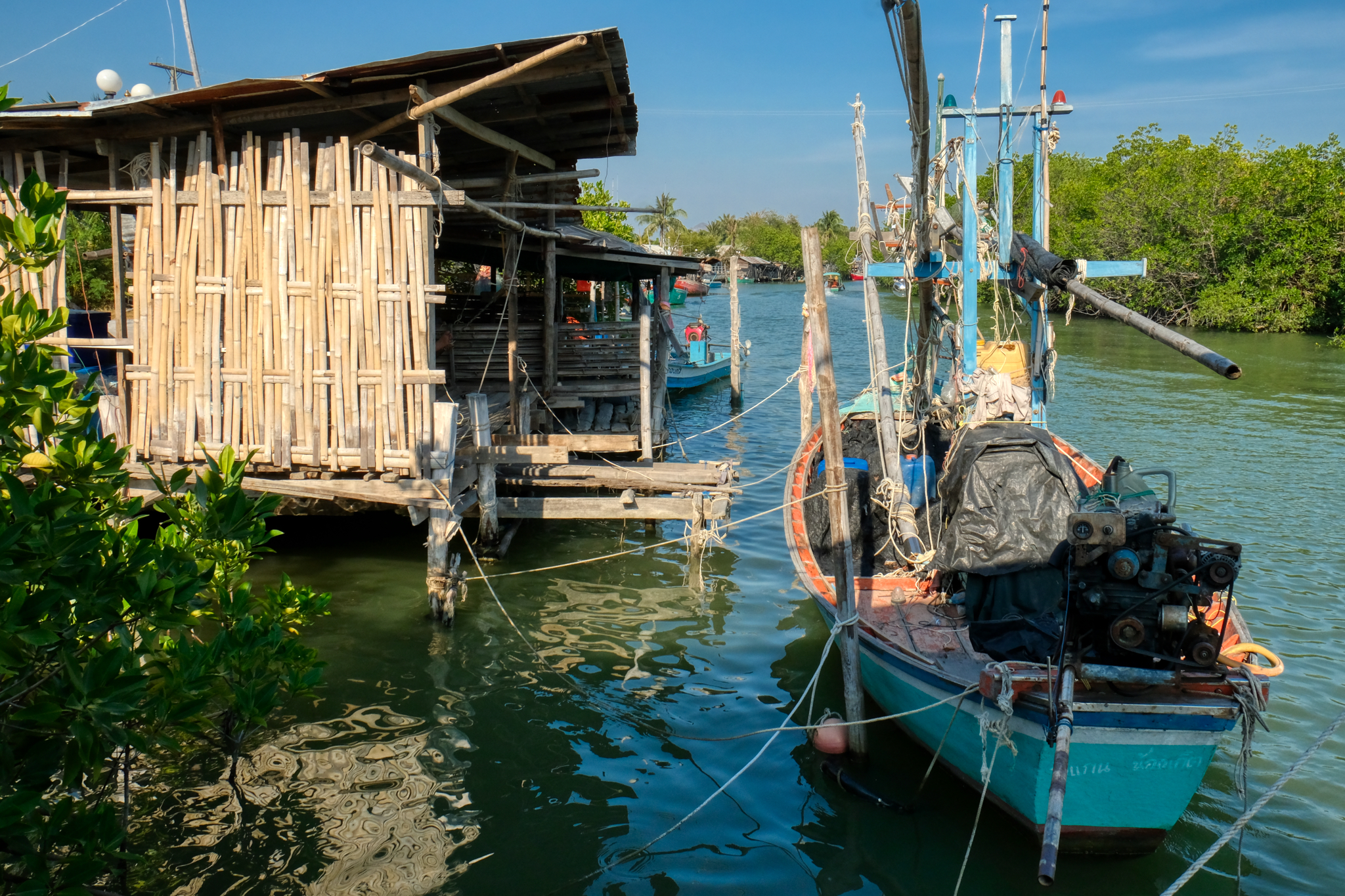 There were newer and older parts of this fishing village.
There were newer and older parts of this fishing village.
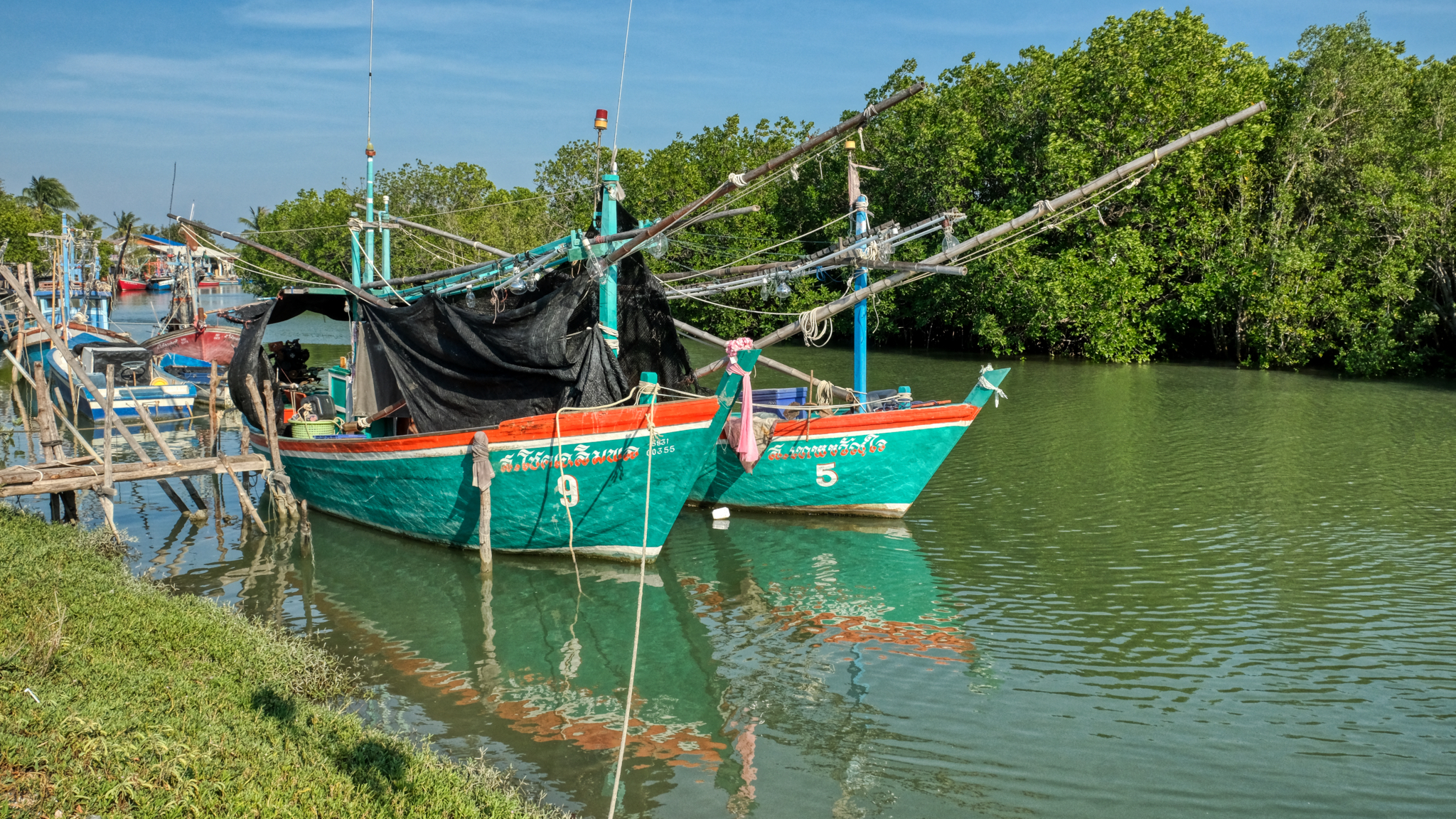 The village was very quiet this afternoon. These boats are rigged to catch squid . . . at night.
The village was very quiet this afternoon. These boats are rigged to catch squid . . . at night.
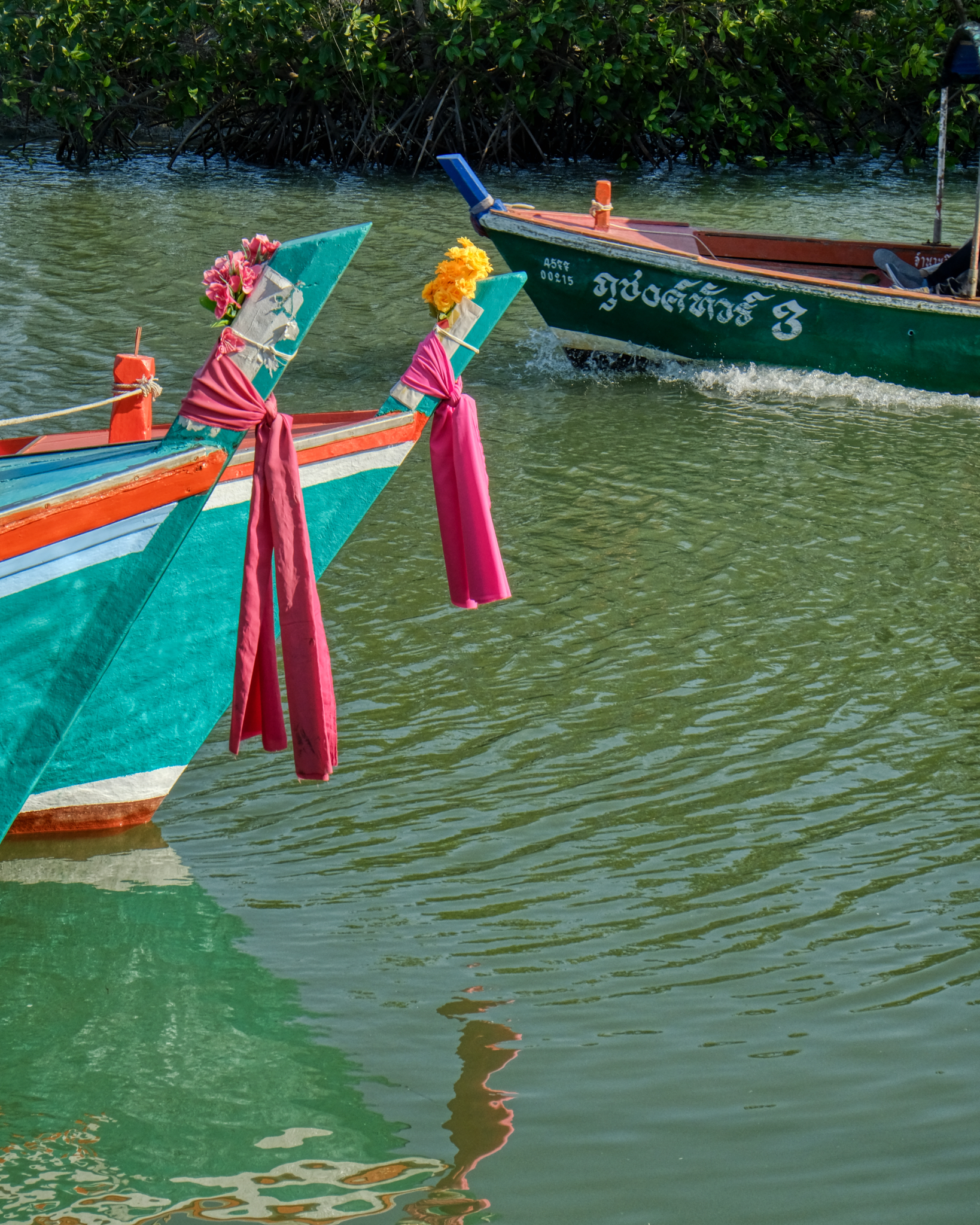 I love how the Thai fishermen decorate their boats . . . with these colorful votive blessings.
I love how the Thai fishermen decorate their boats . . . with these colorful votive blessings.
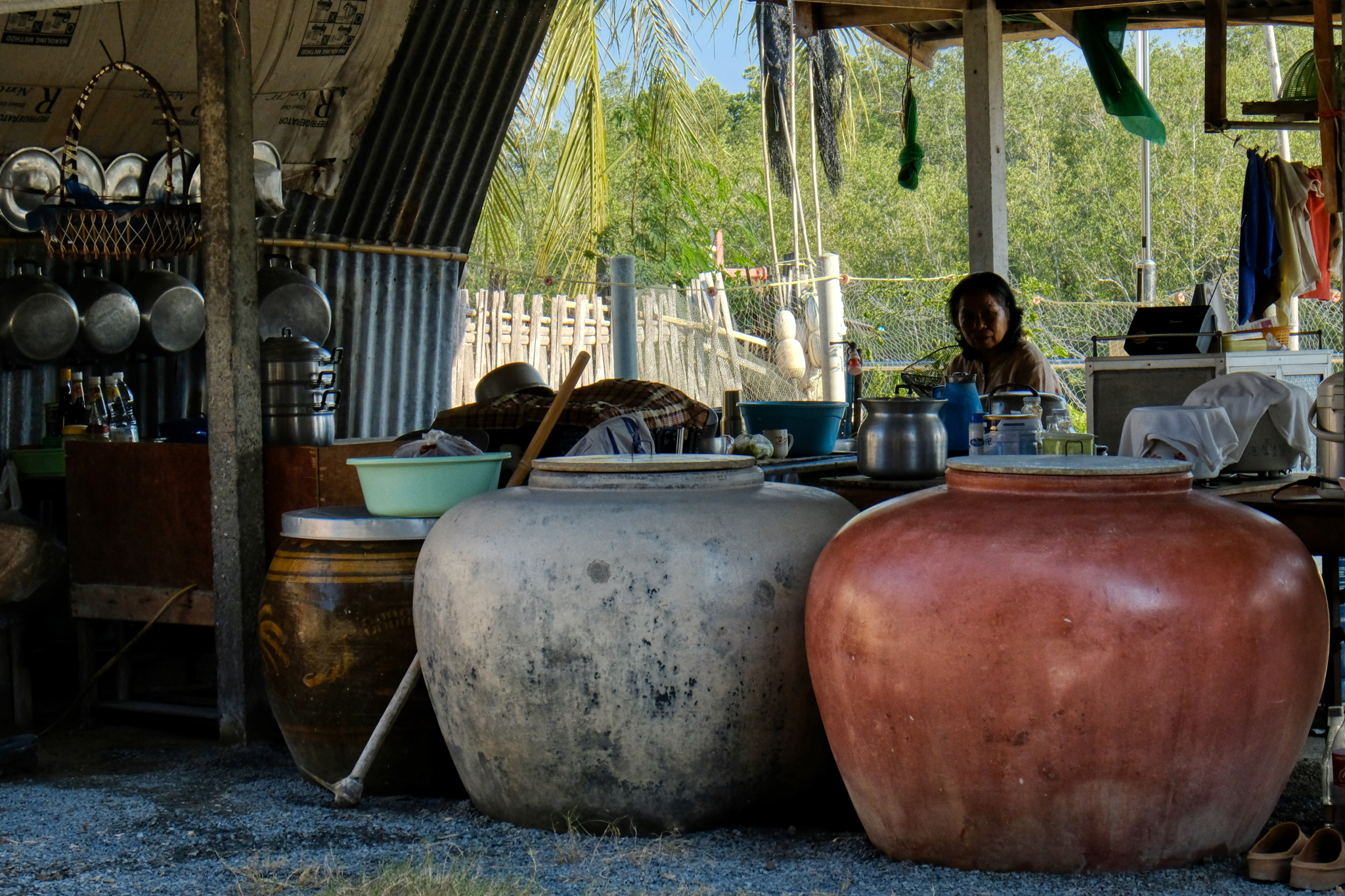 A village restaurateur. The large pots catch and hold rainwater.
A village restaurateur. The large pots catch and hold rainwater.
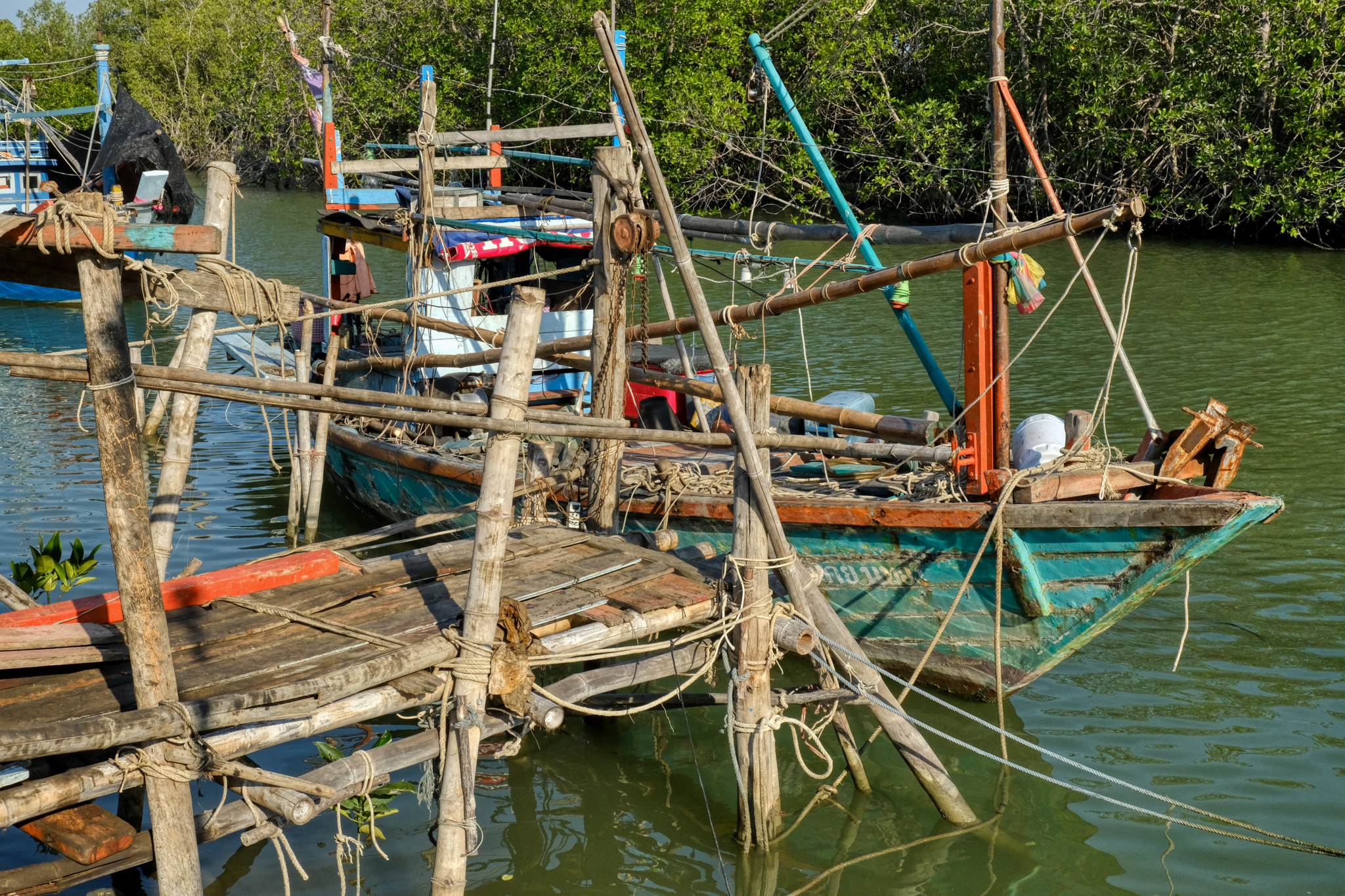 Such rich and complex images to capture here!
Such rich and complex images to capture here!
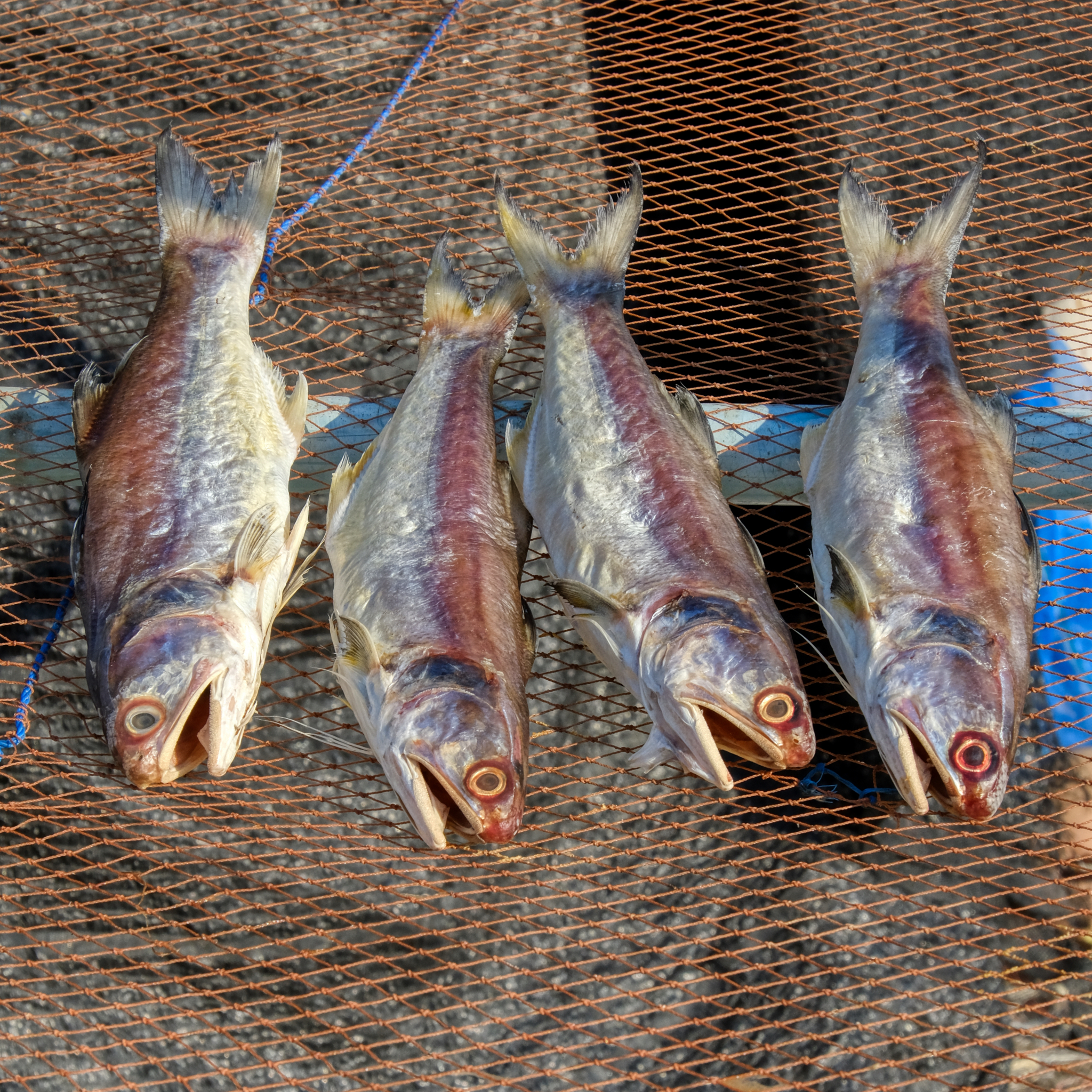 We saw this catch of the day in one of the fishermen's sheds.
We saw this catch of the day in one of the fishermen's sheds.
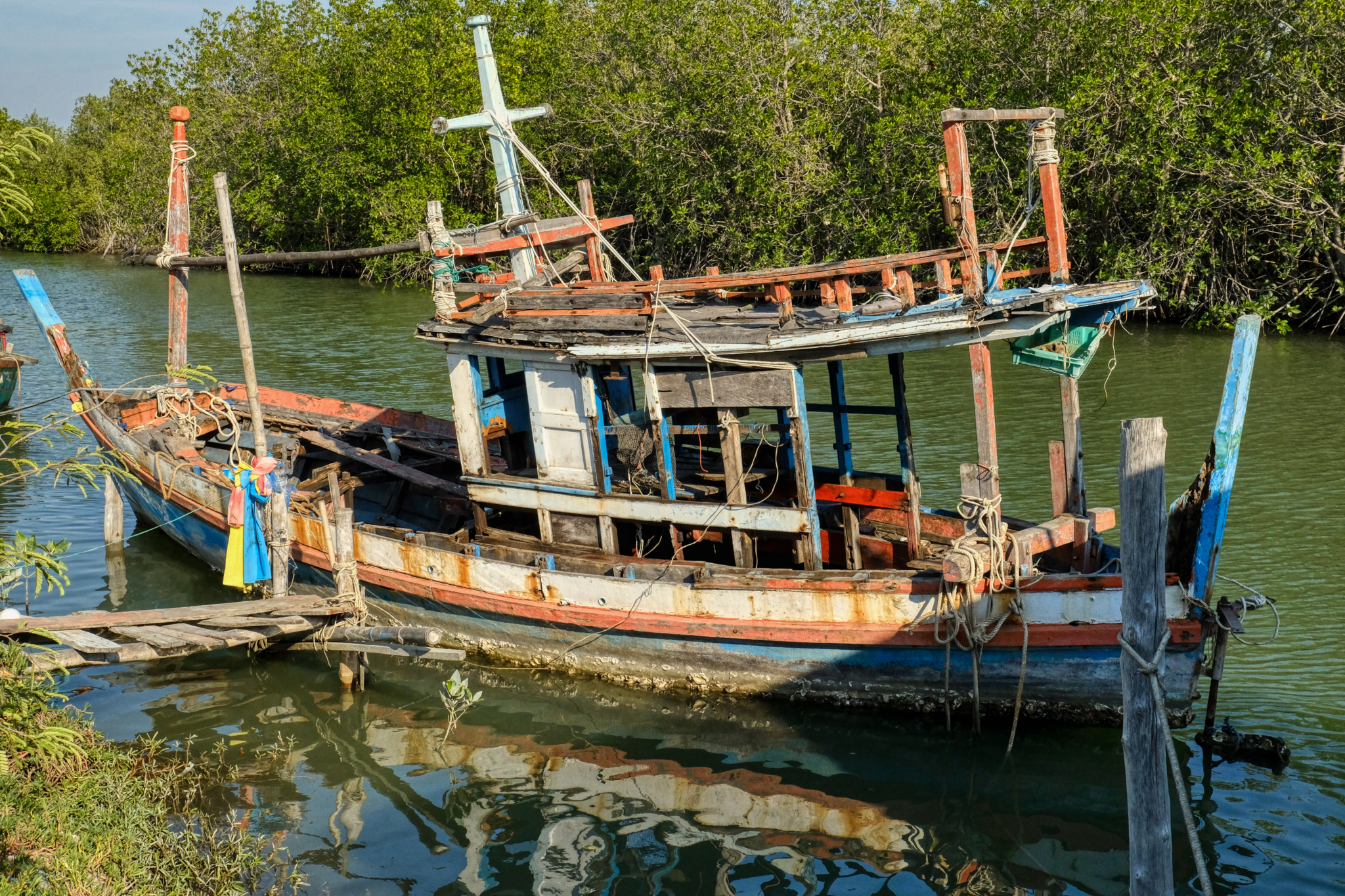 We could have stayed all day here . . . just taking photos . . . but there were other adventures in store for us on that day.
We could have stayed all day here . . . just taking photos . . . but there were other adventures in store for us on that day.
-------------------------------------------------
A Mangrove Forest Swamp Park
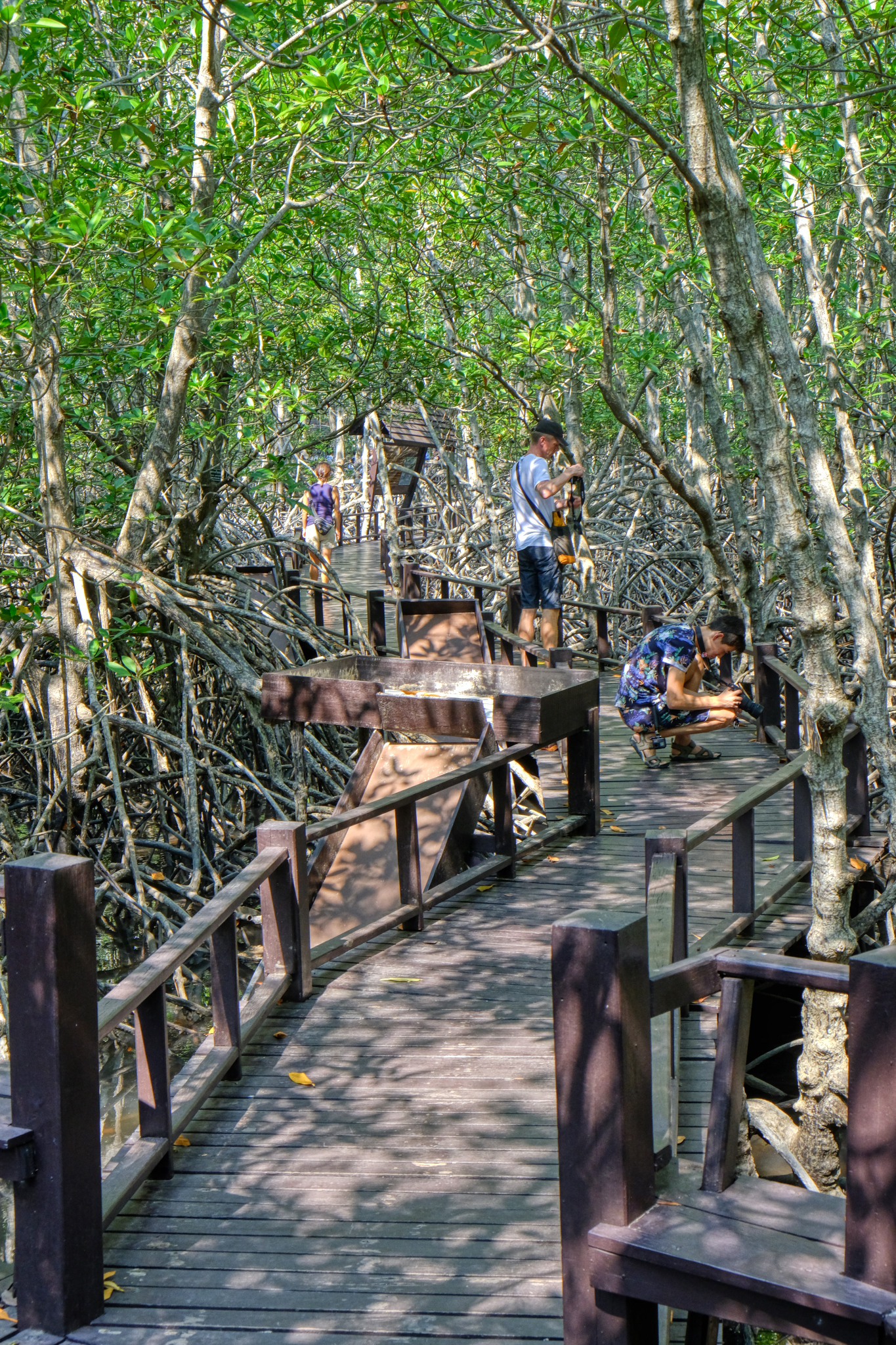 Our next stop was the beautifully developed, and very educational, Pran Buri Forest Park and Nature Reserve.
Our next stop was the beautifully developed, and very educational, Pran Buri Forest Park and Nature Reserve.
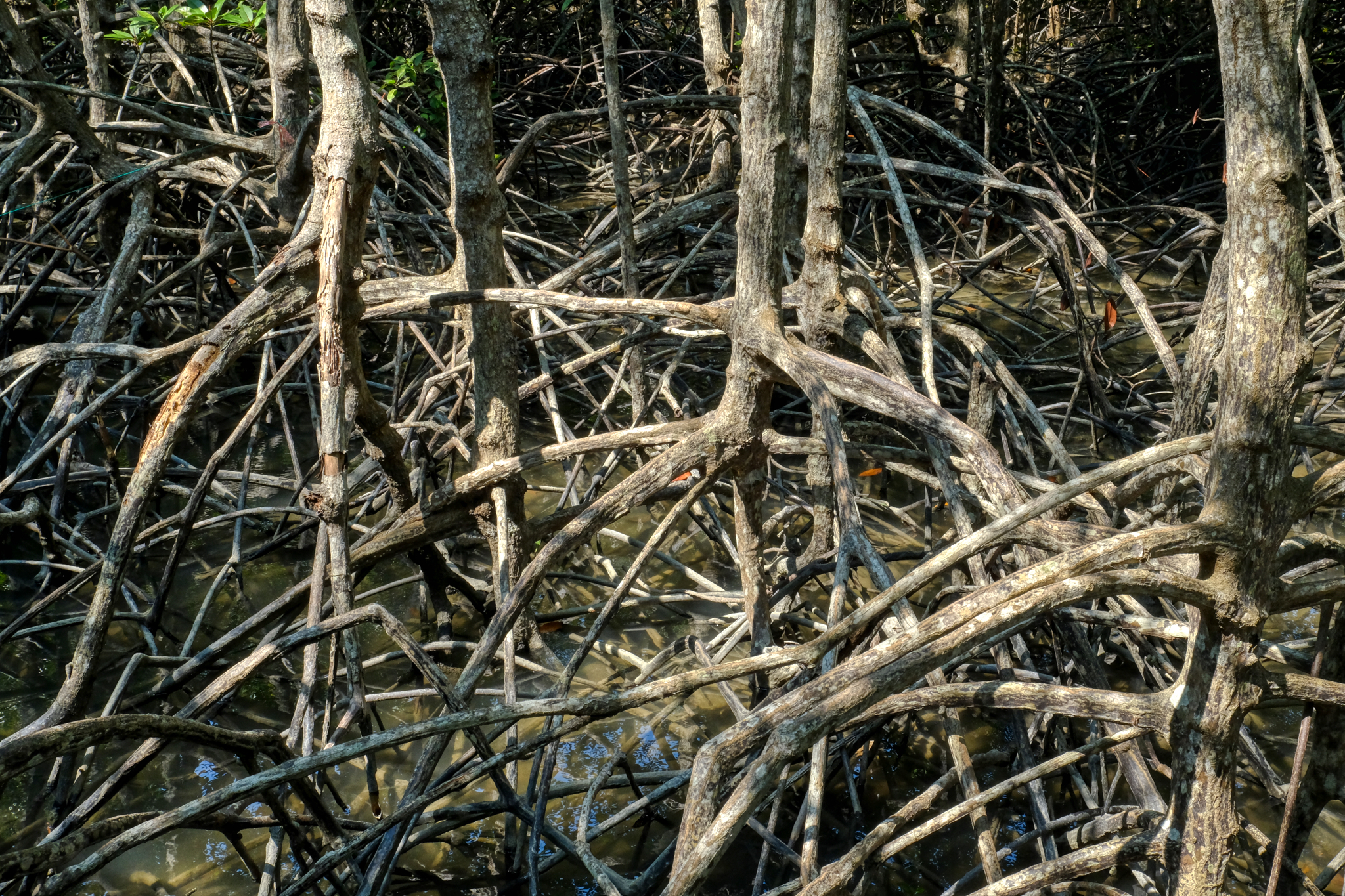 Mangrove forests are completely unique ecological environments.
Mangrove forests are completely unique ecological environments.
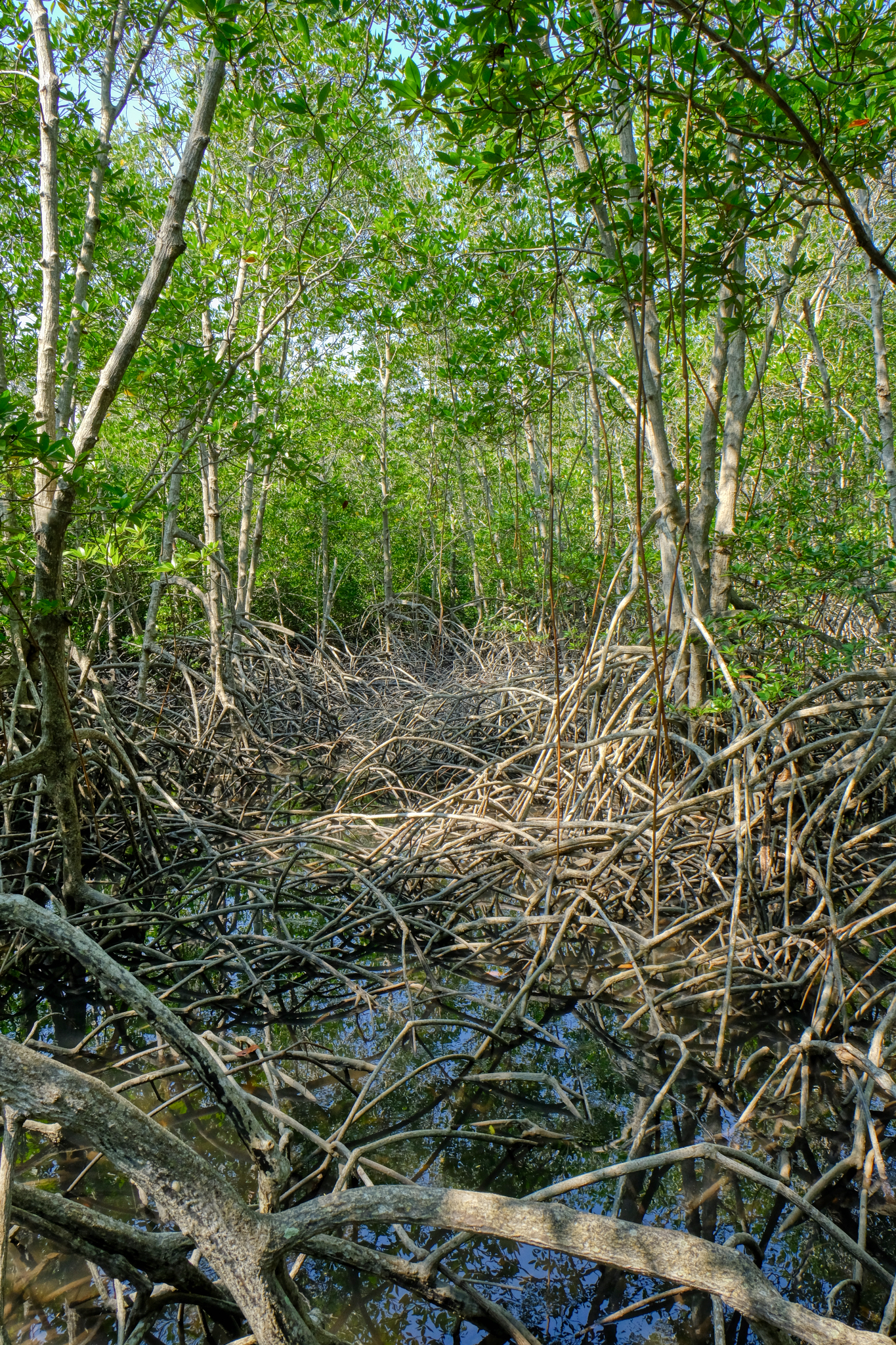 Mangroves grow in salt water estuarial swamps.
Mangroves grow in salt water estuarial swamps.
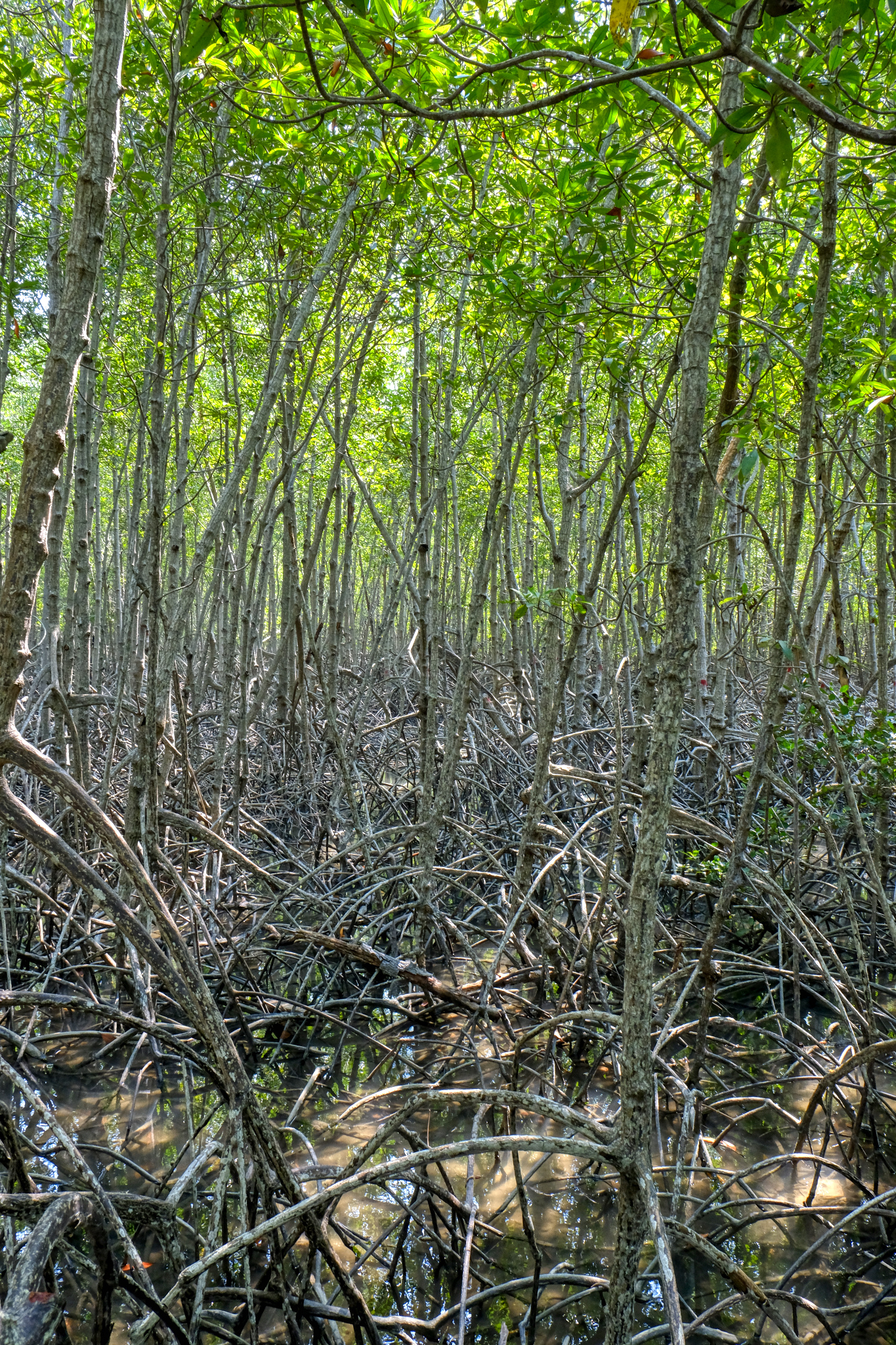 A phantasmagoria of twisted and gnarled complexity. Wonderful Nature.
A phantasmagoria of twisted and gnarled complexity. Wonderful Nature.
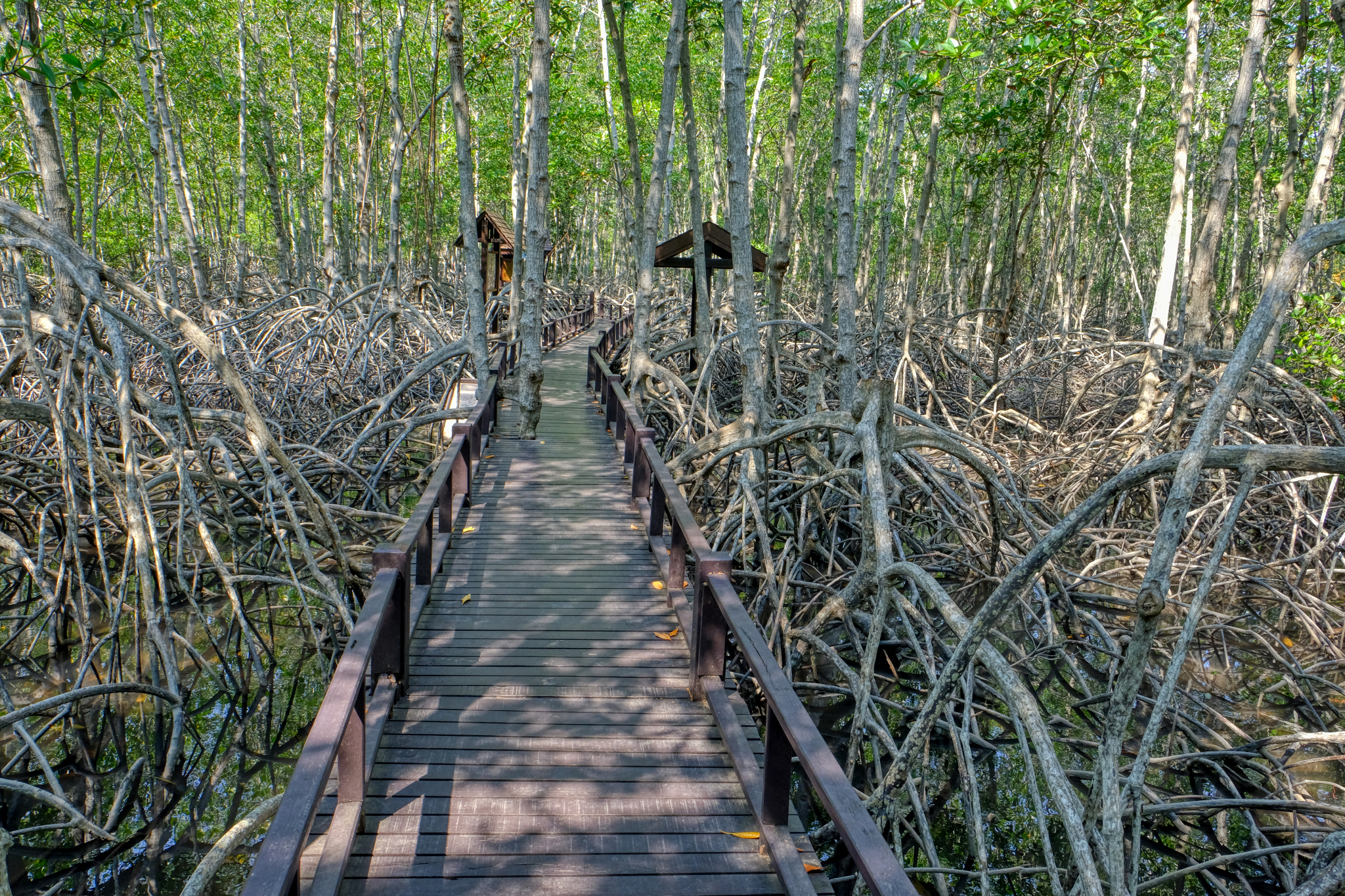 The park positioned bulletin boards (in Thai and English) along the way with informative graphics.
The park positioned bulletin boards (in Thai and English) along the way with informative graphics.
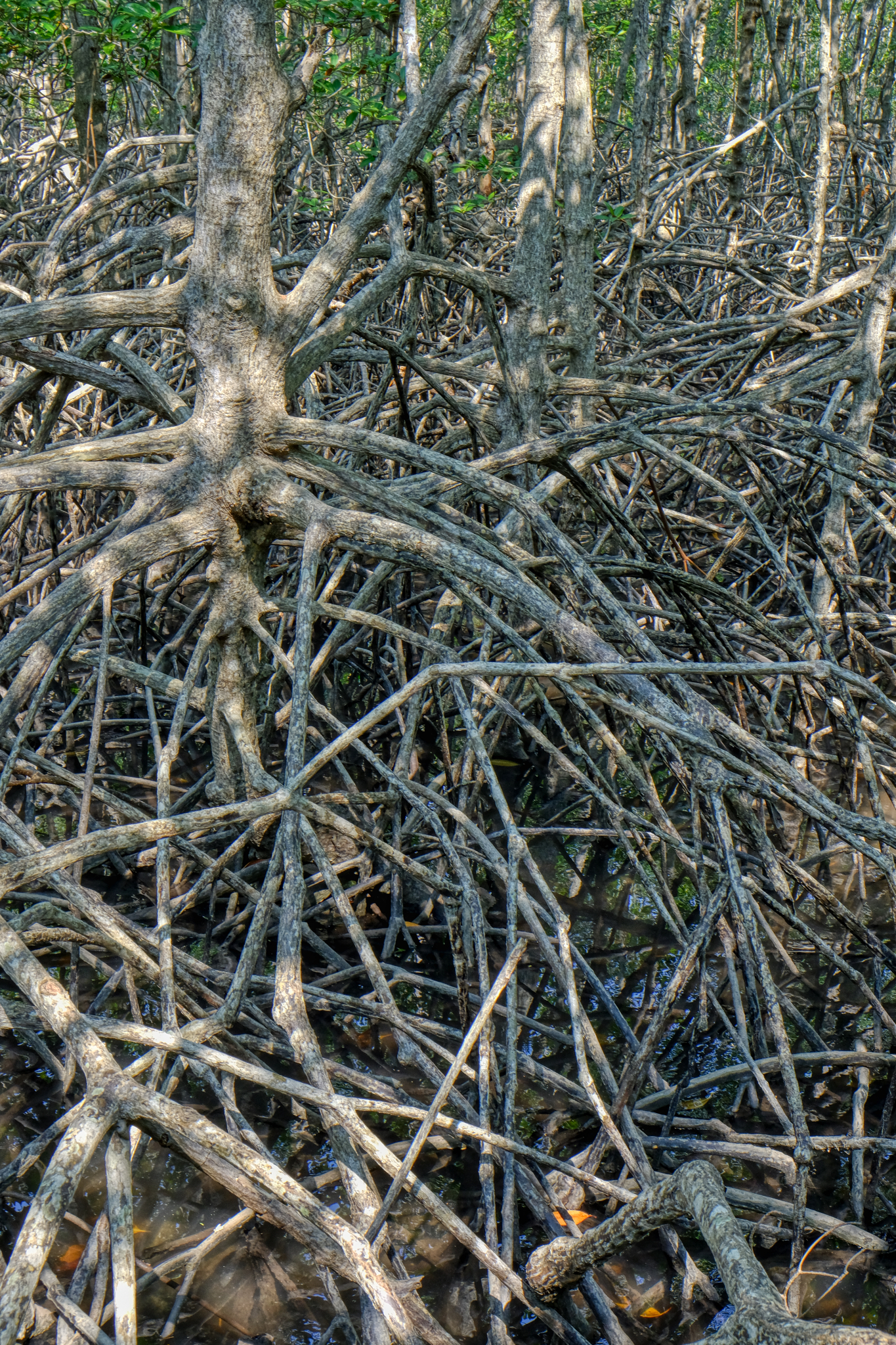 Mangrove roots grow in the transition between wet (at high tide) and exposed to the air (at low tide). The mangrove grows in salt water but has the ability to filter out the salt and deposit it on the root 'knees' to be dissolved off when the tide comes in. Amazing.
Mangrove roots grow in the transition between wet (at high tide) and exposed to the air (at low tide). The mangrove grows in salt water but has the ability to filter out the salt and deposit it on the root 'knees' to be dissolved off when the tide comes in. Amazing.
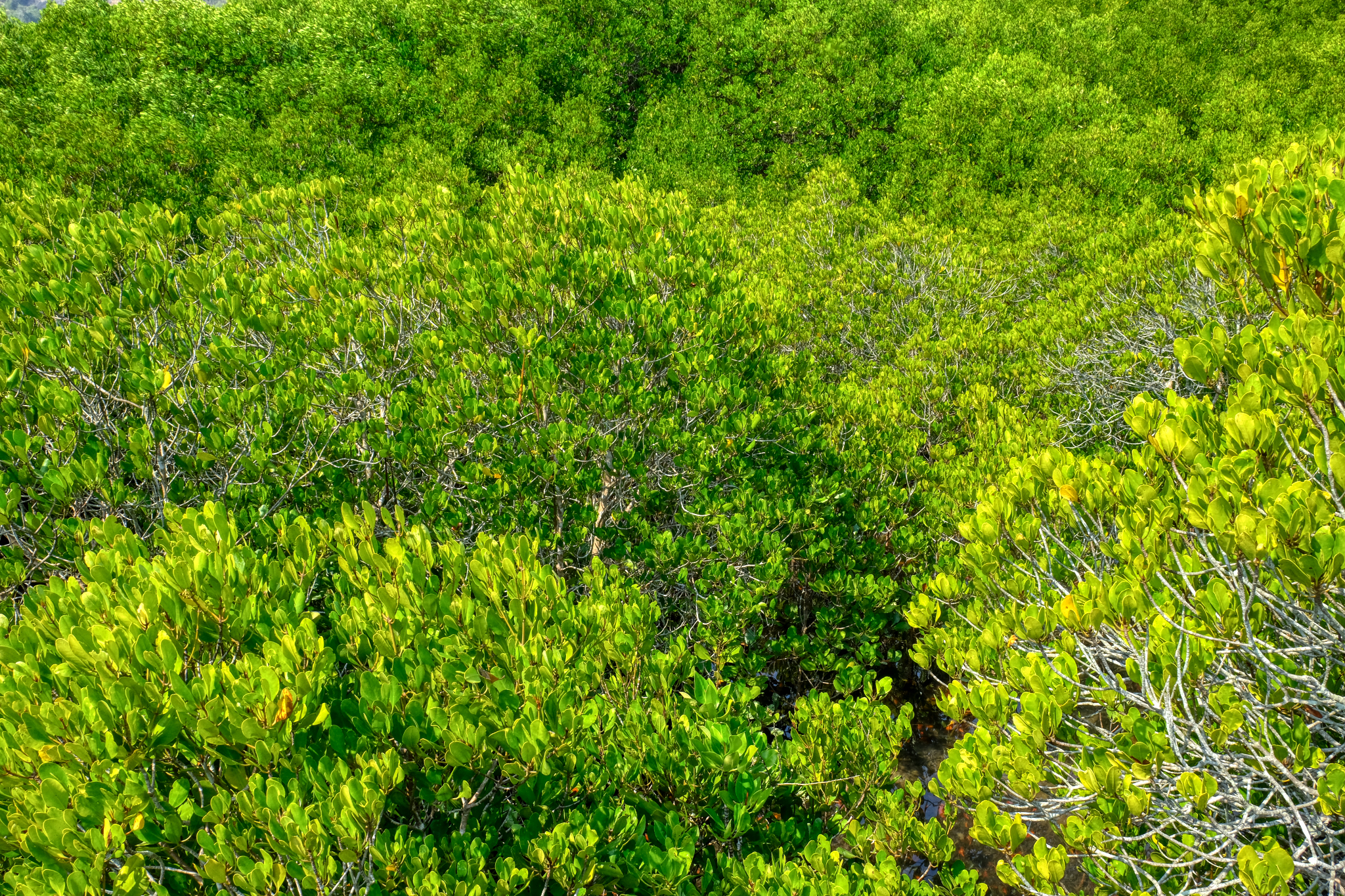 The park managers built a tall tower so that the mangrove forest could be seen from above.
The park managers built a tall tower so that the mangrove forest could be seen from above.
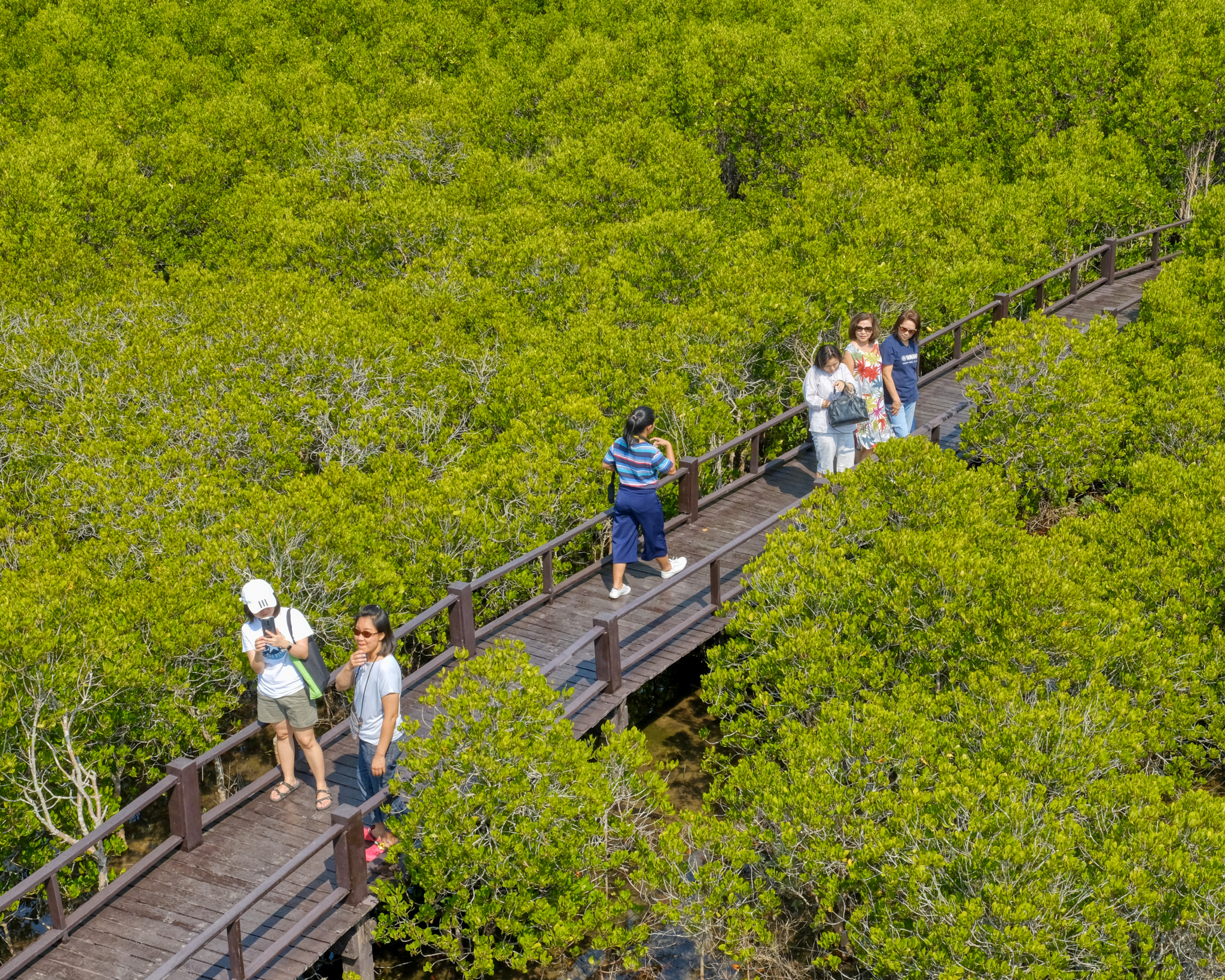 It was New Years' Eve, so there were quite a few day trippers from nearby Hua Hin.
It was New Years' Eve, so there were quite a few day trippers from nearby Hua Hin.
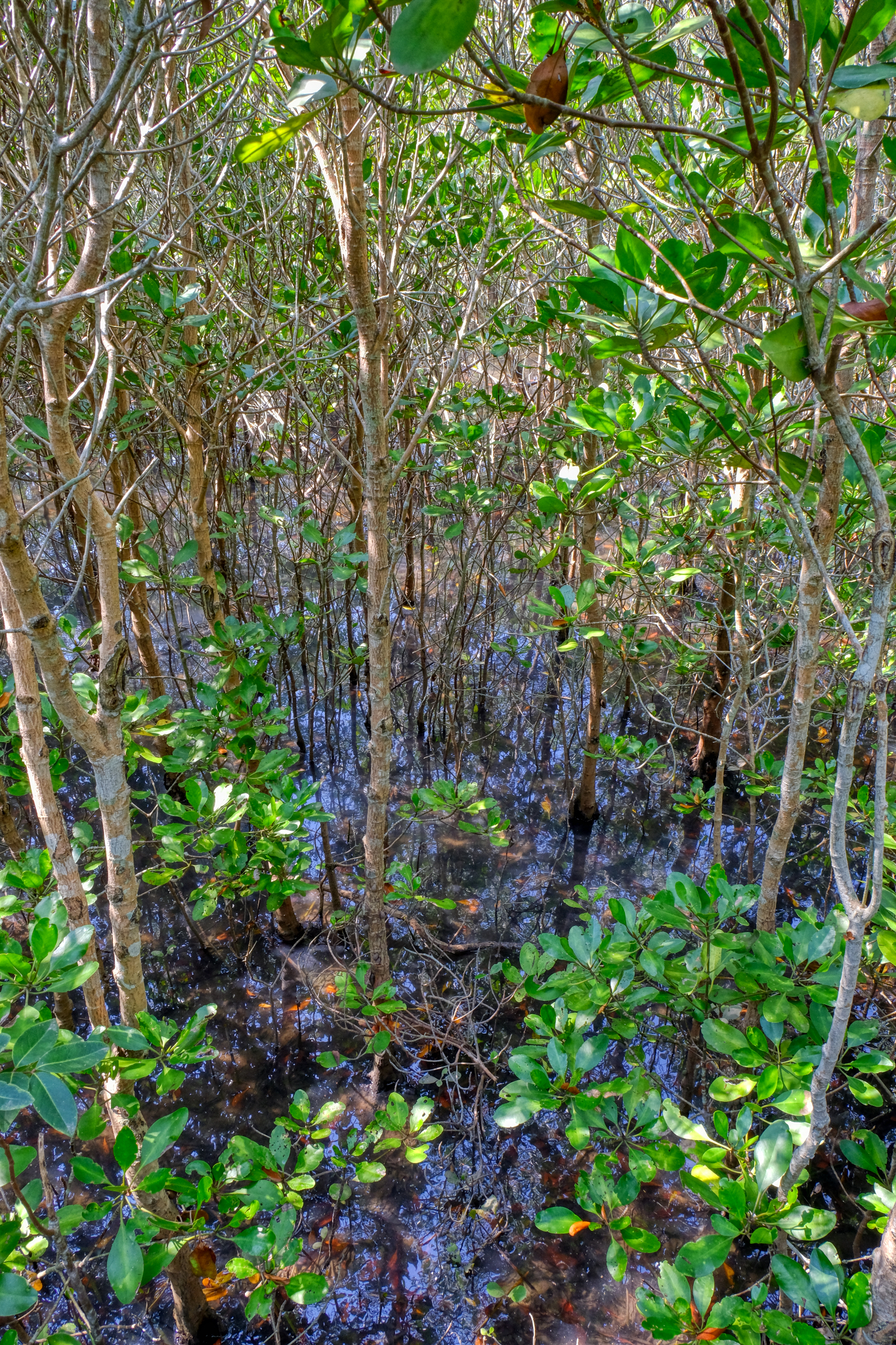 We wandered on along the elevated walkway. There seemed to be a change in the nature of the trees in the swamp.
We wandered on along the elevated walkway. There seemed to be a change in the nature of the trees in the swamp.
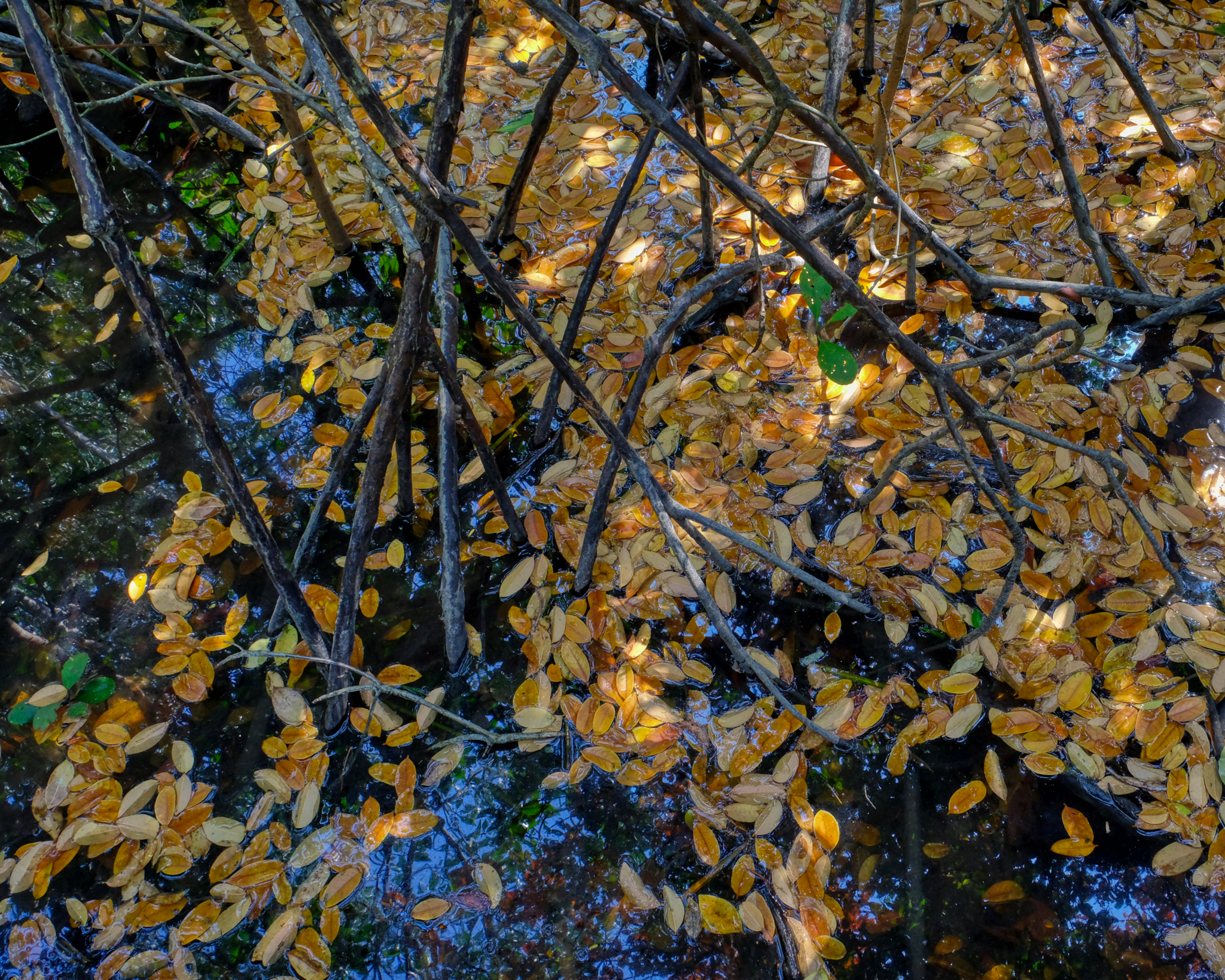 "Autumn" colors in the swamp. A blue sky reflected in the brackish waters.
"Autumn" colors in the swamp. A blue sky reflected in the brackish waters.
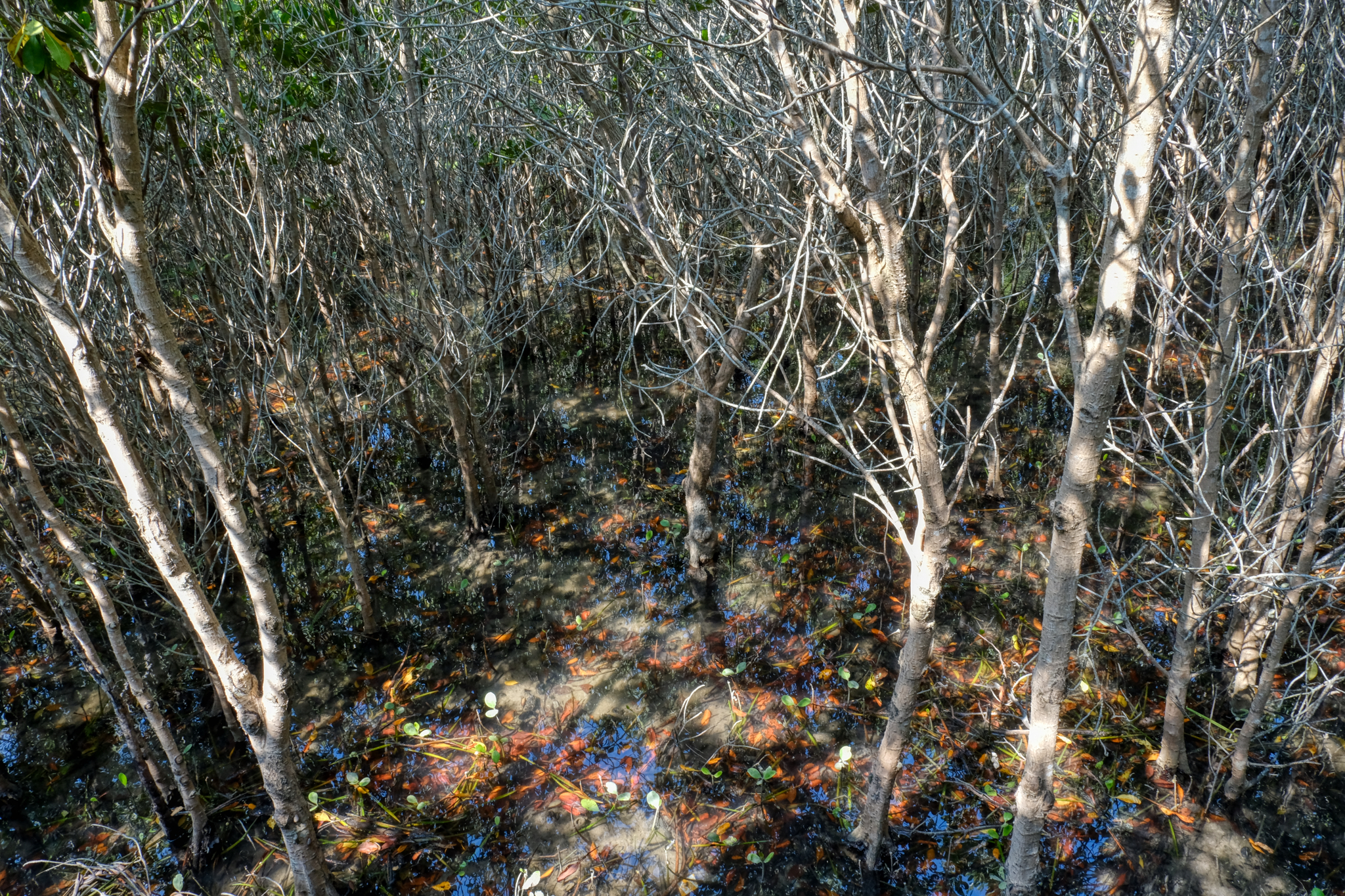 Beautiful complicated light on the complicated forest . . . truly marvelous.
Beautiful complicated light on the complicated forest . . . truly marvelous.
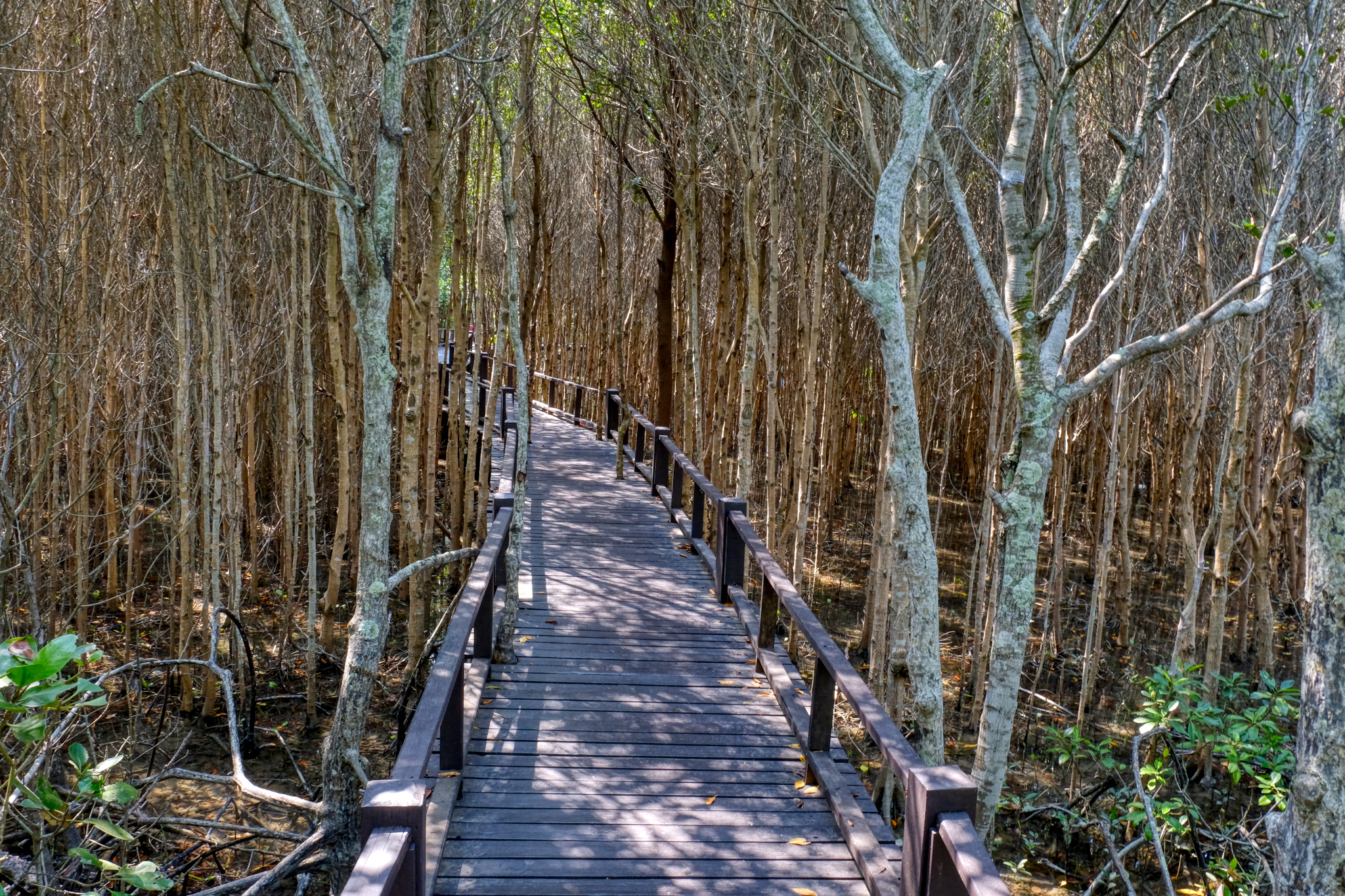 We walked on into a stand of densely packed trees . . . not mangrove, but growing in the salty water.
We walked on into a stand of densely packed trees . . . not mangrove, but growing in the salty water.
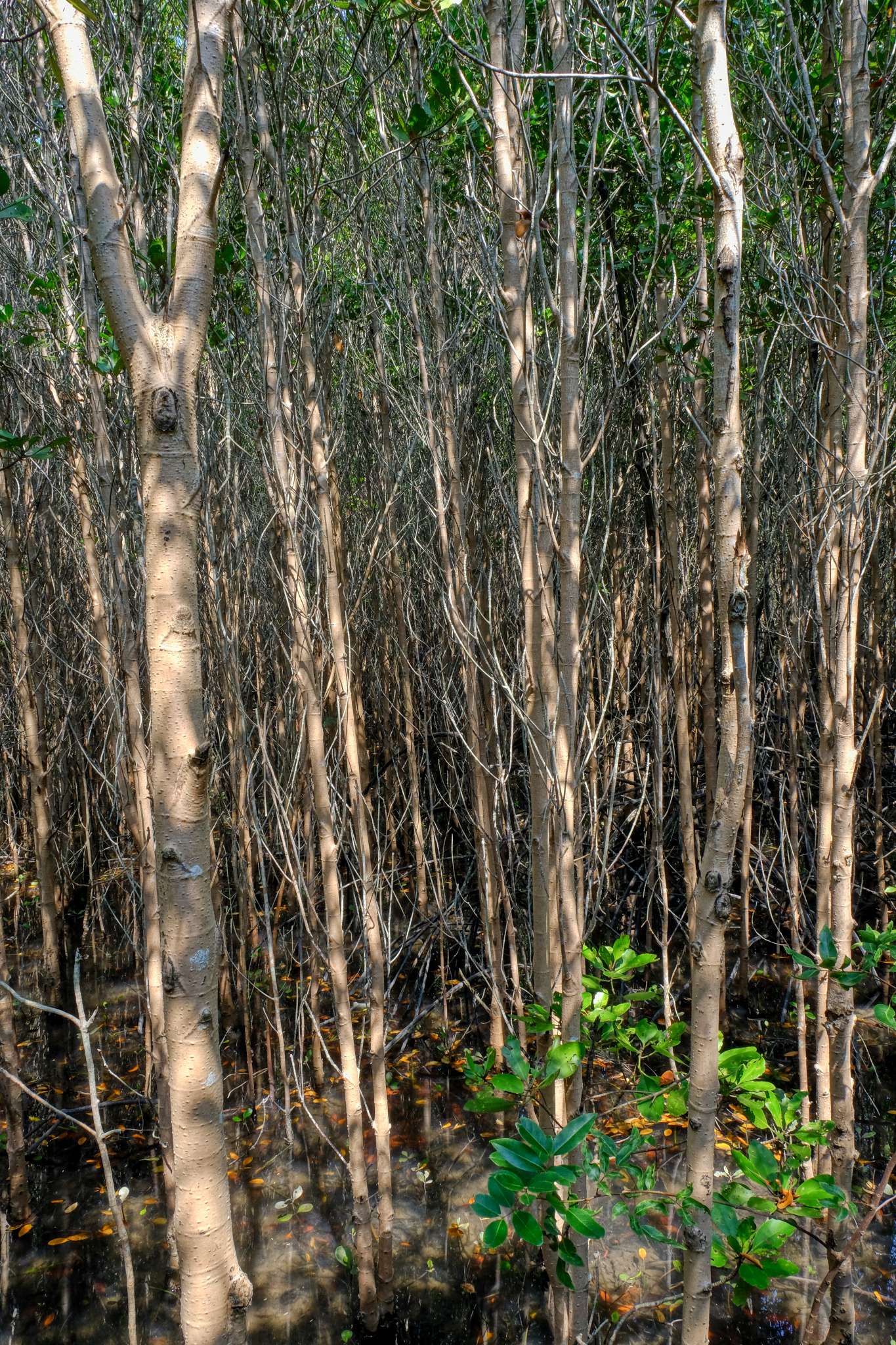 Ever-changing scenes . . .
Ever-changing scenes . . .
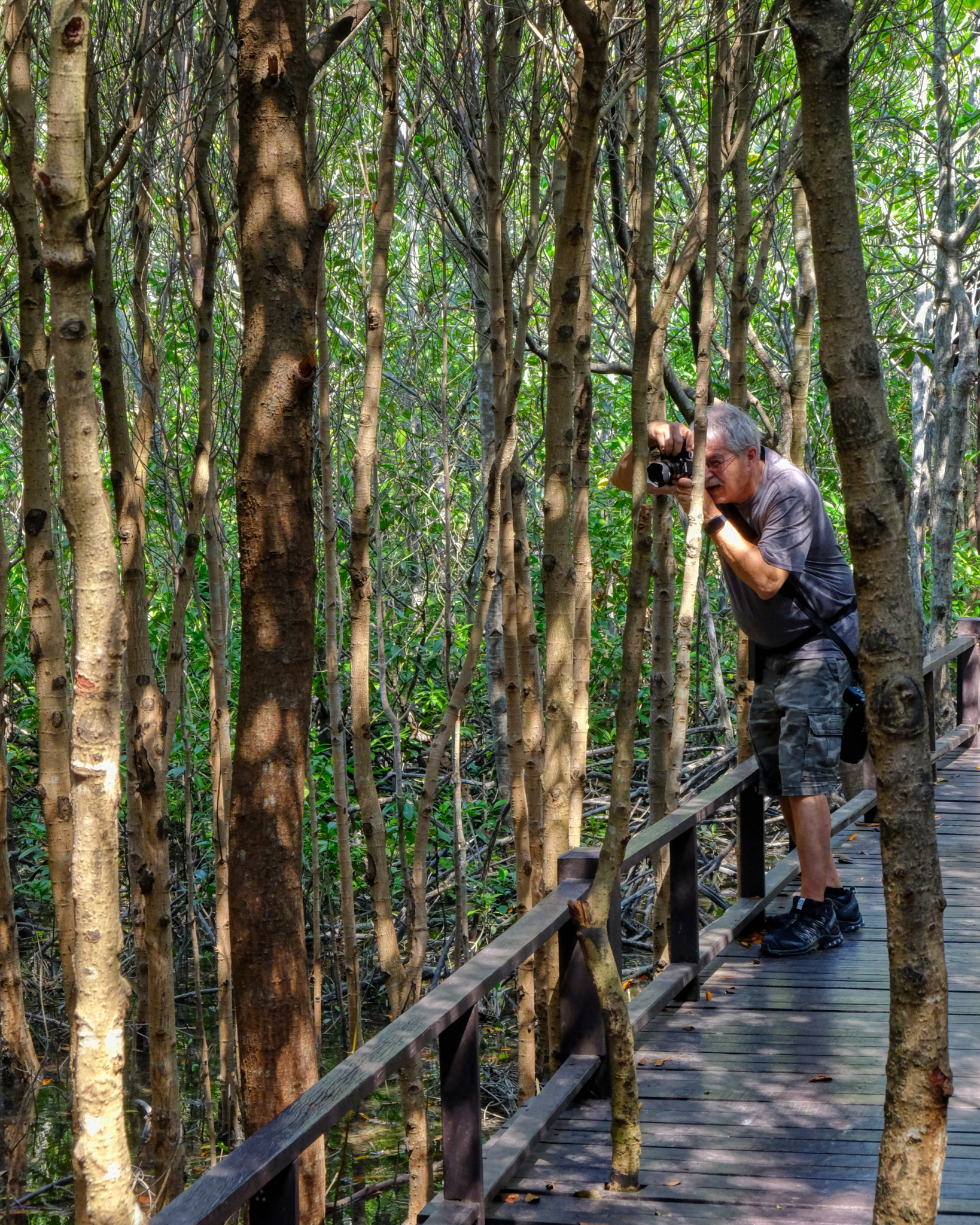 My friend enjoying the photographic opportunities.
My friend enjoying the photographic opportunities.
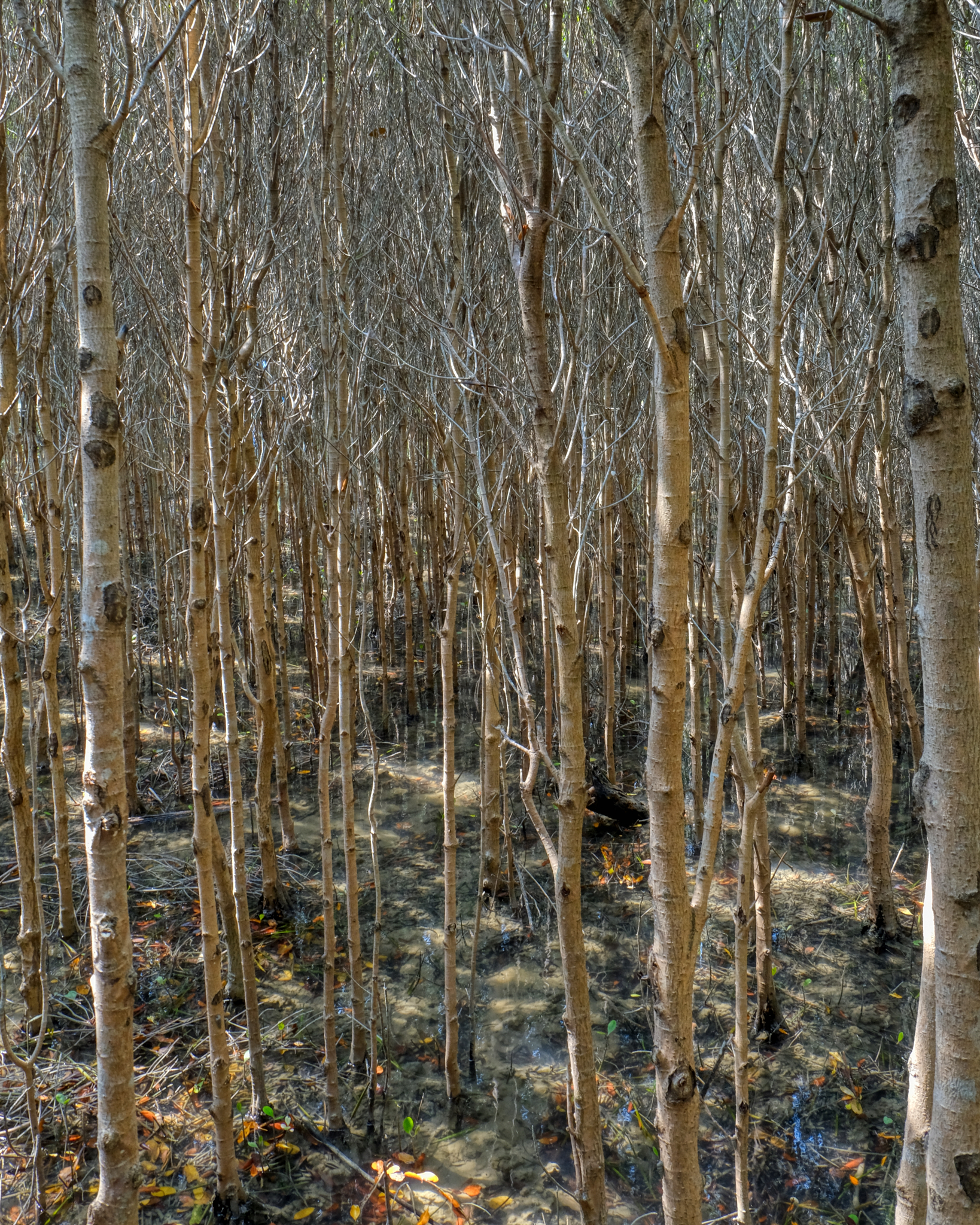 I do not know how these particular trees shed the salt.
I do not know how these particular trees shed the salt.
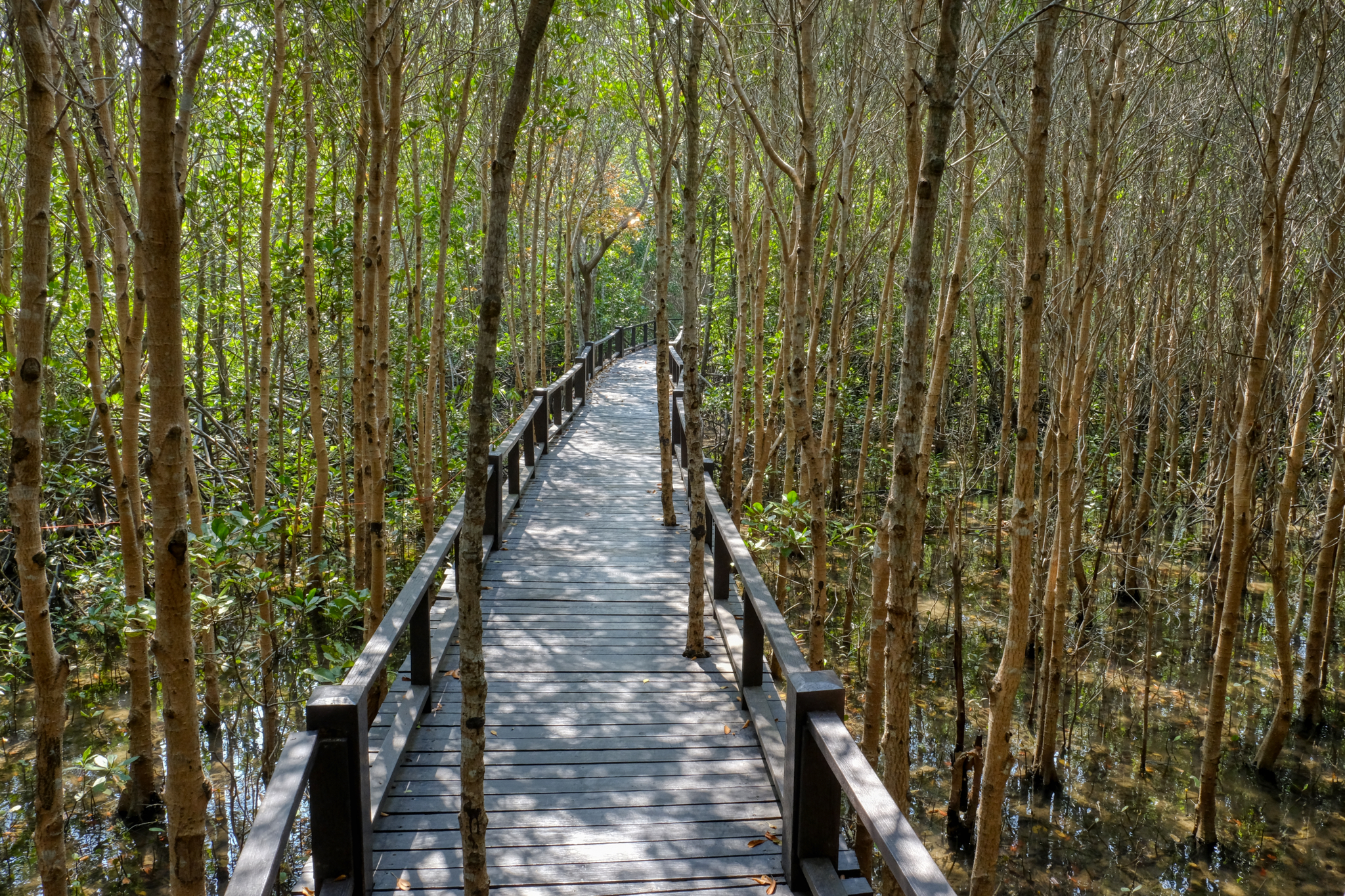 On we walked through a forest of thin trees growing in the saltwater marsh.
On we walked through a forest of thin trees growing in the saltwater marsh.
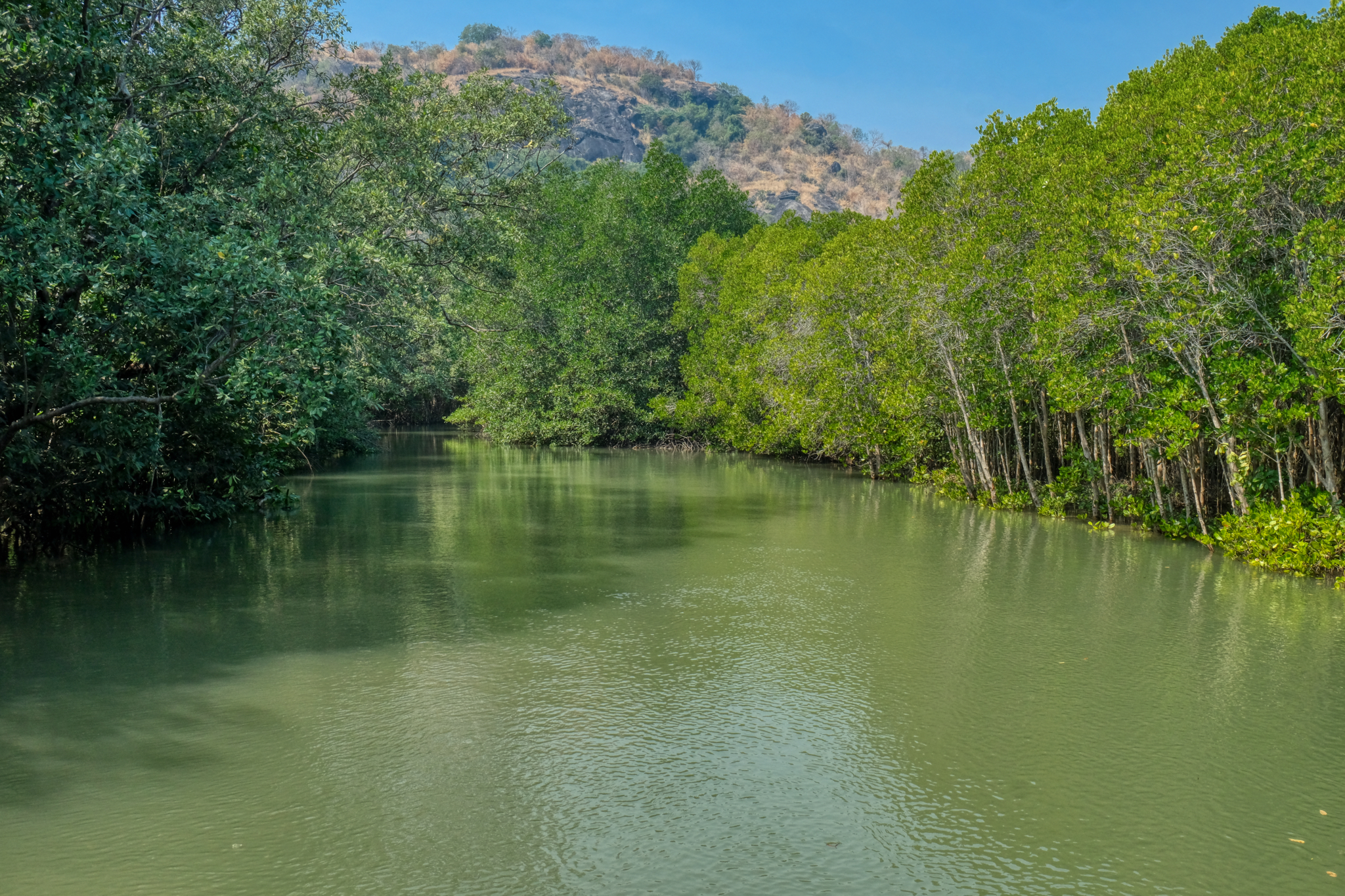 We came to a saltwater inlet. There was a pier offering boat rides, but there was a line of people waiting. We walked on . . . more [visual] adventures in store.
We came to a saltwater inlet. There was a pier offering boat rides, but there was a line of people waiting. We walked on . . . more [visual] adventures in store.
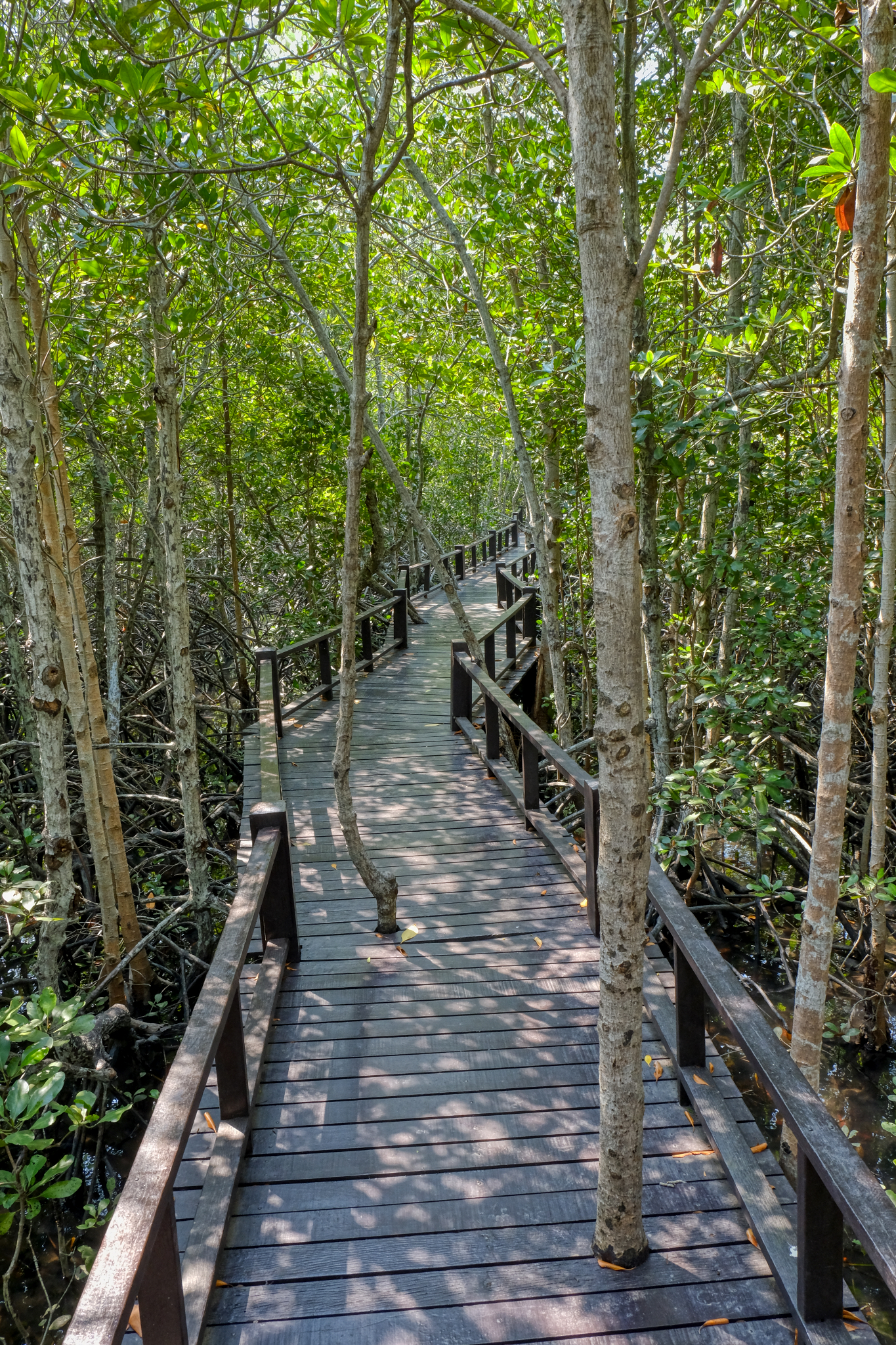 We walked the rest of the 2km walkway loop to the car . . .
We walked the rest of the 2km walkway loop to the car . . .
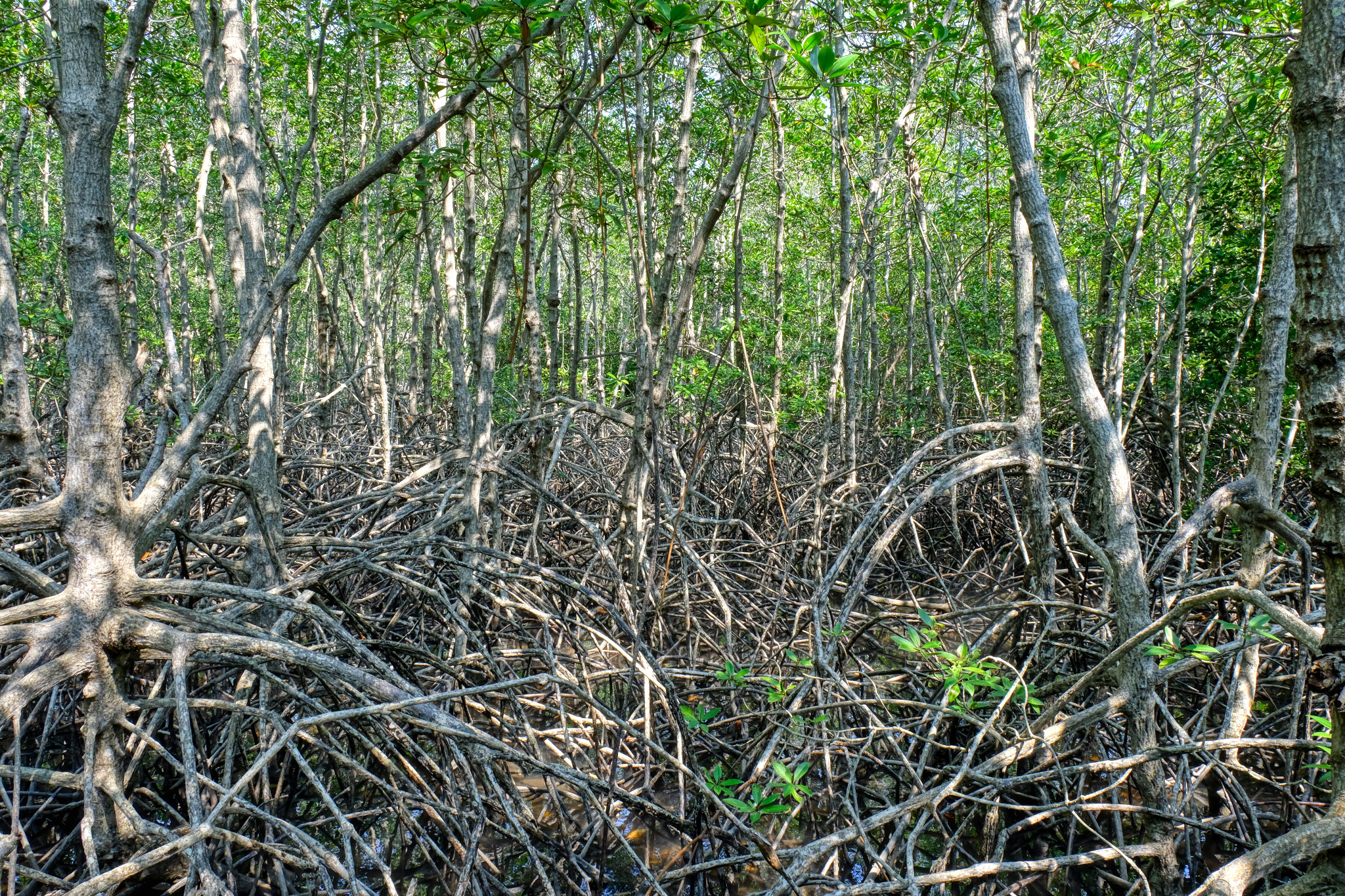 . . . and back through the tangled web of the mangrove knees.
. . . and back through the tangled web of the mangrove knees.
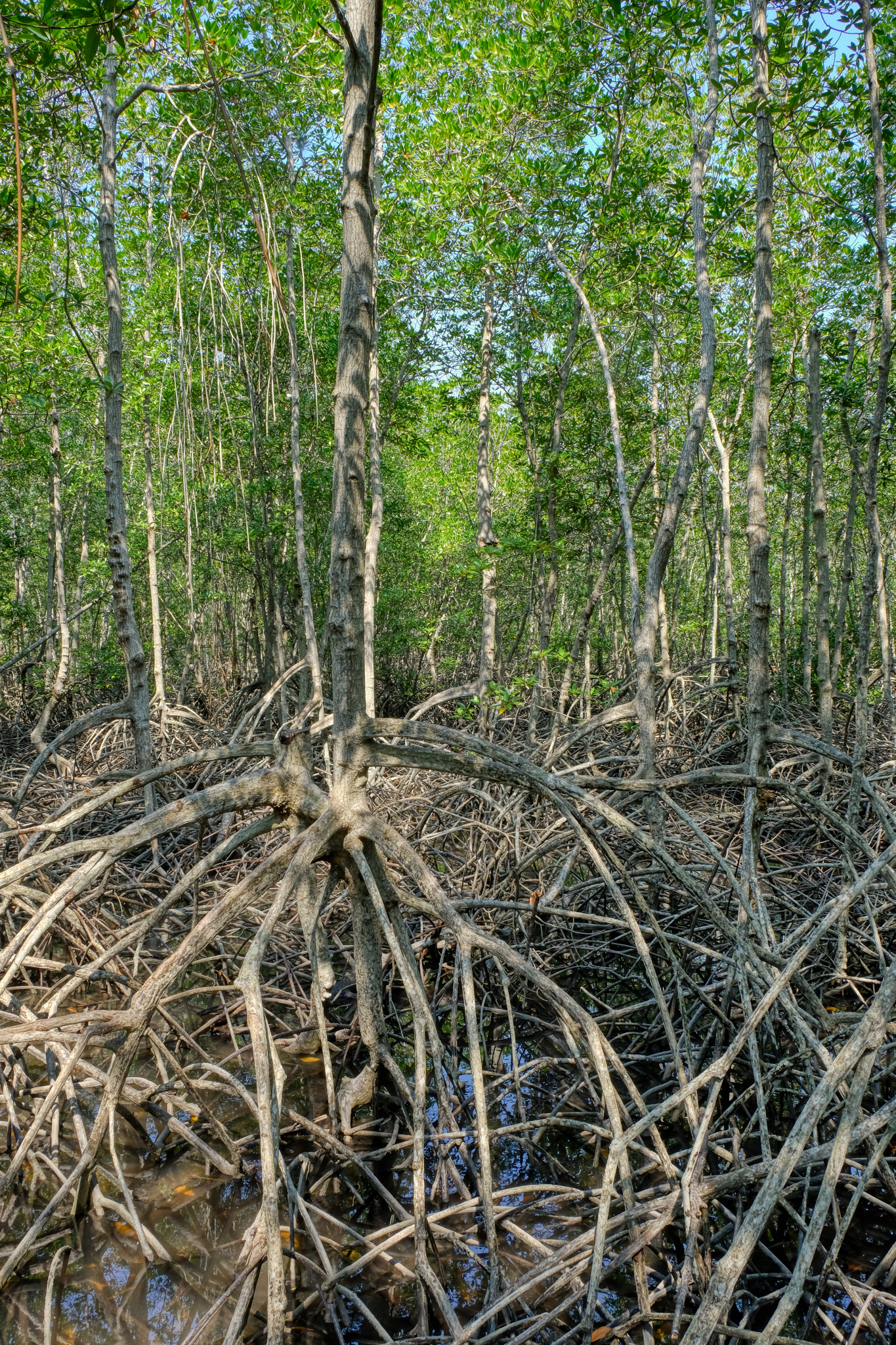 We spent a wonderful couple of hours being amazed by this fantastic environment . . and taking photographs to our hearts content.
We spent a wonderful couple of hours being amazed by this fantastic environment . . and taking photographs to our hearts content.
-----------------------------------------------------
A Fishing Port Village
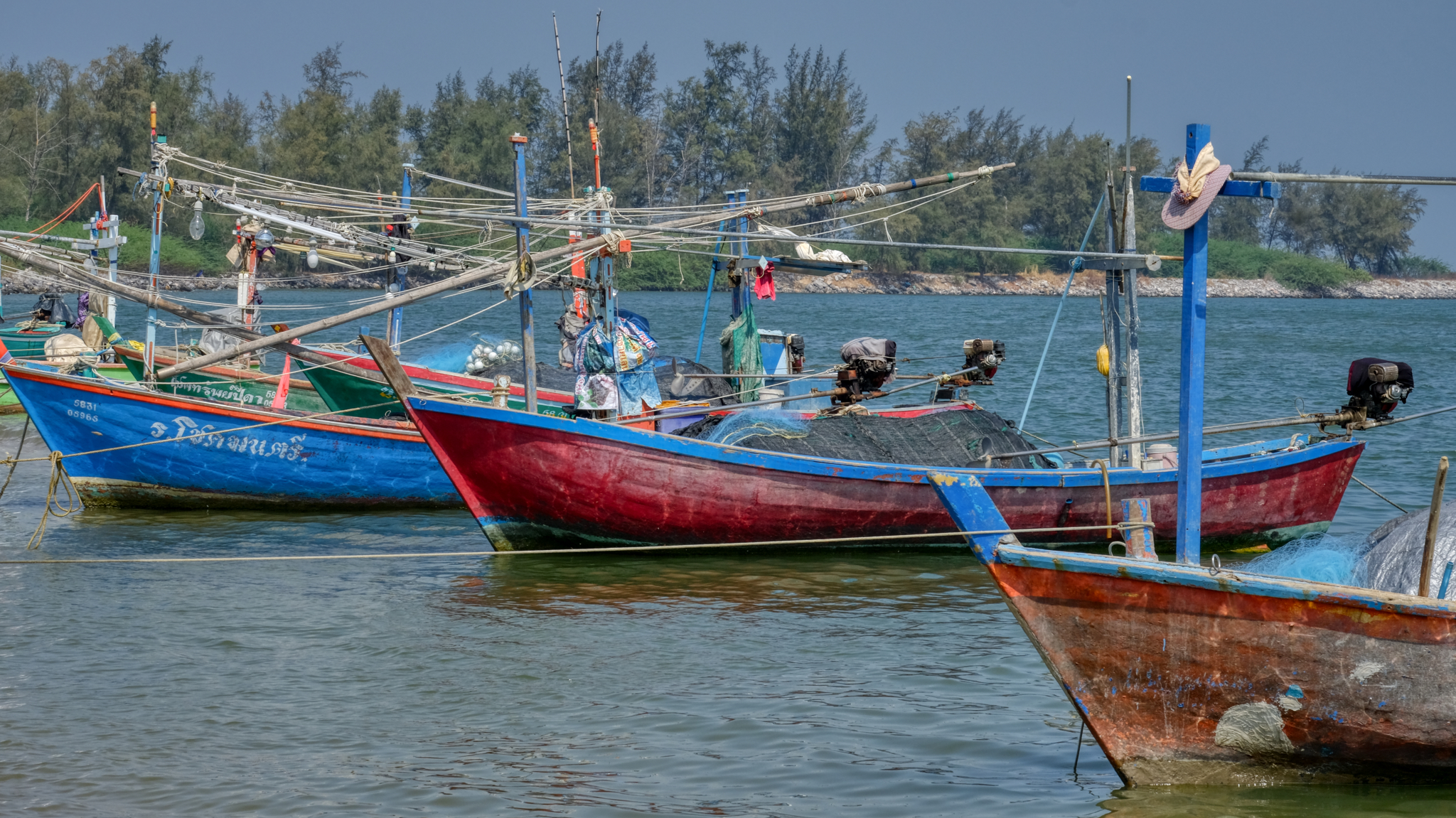 About a mile away from the mangrove forest park was another small fishing port.
About a mile away from the mangrove forest park was another small fishing port.
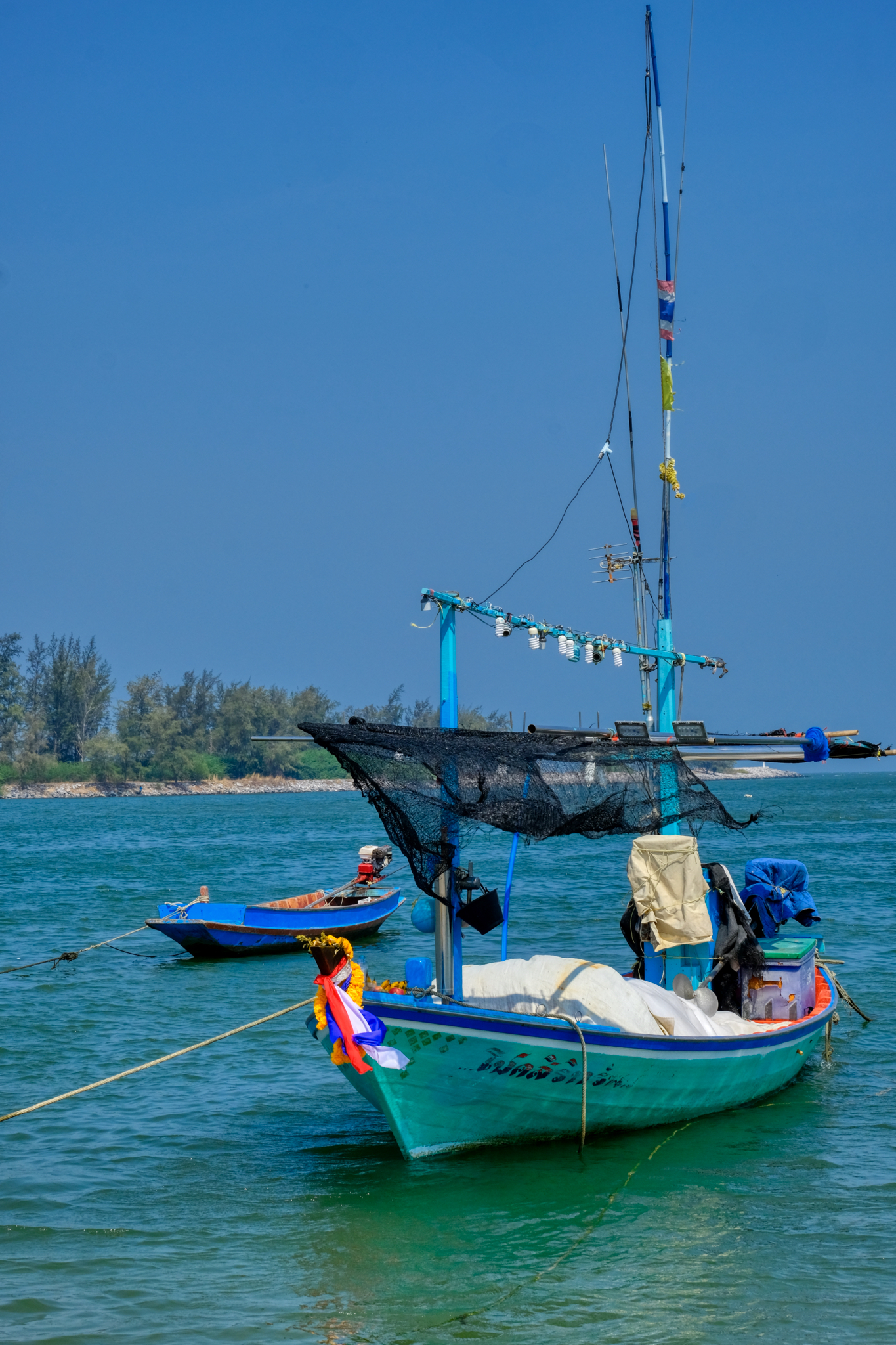 A beautiful day with colorful boats . . . what's not to like?
A beautiful day with colorful boats . . . what's not to like?
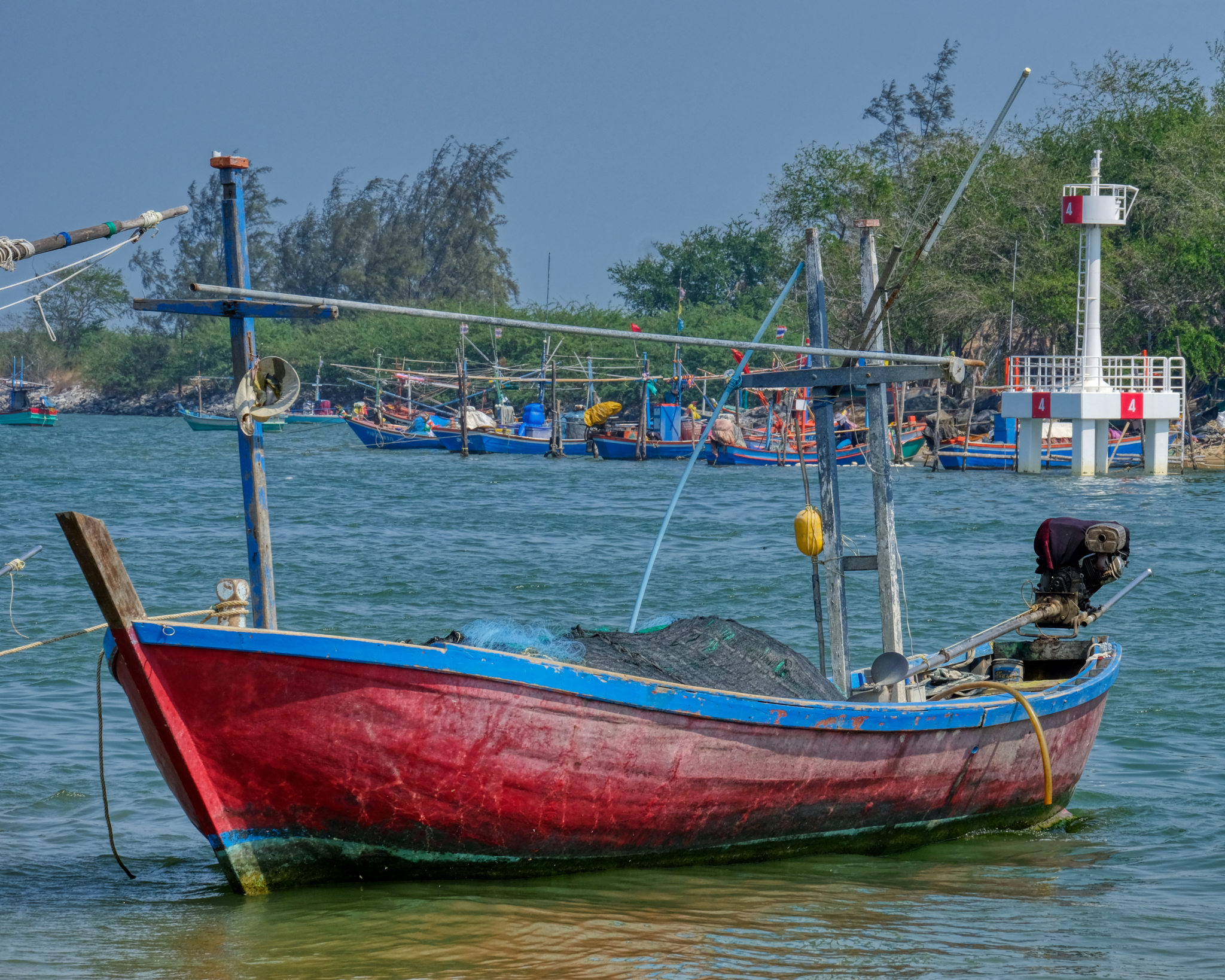 Small squid boats and large 'company boats" . . .
Small squid boats and large 'company boats" . . .
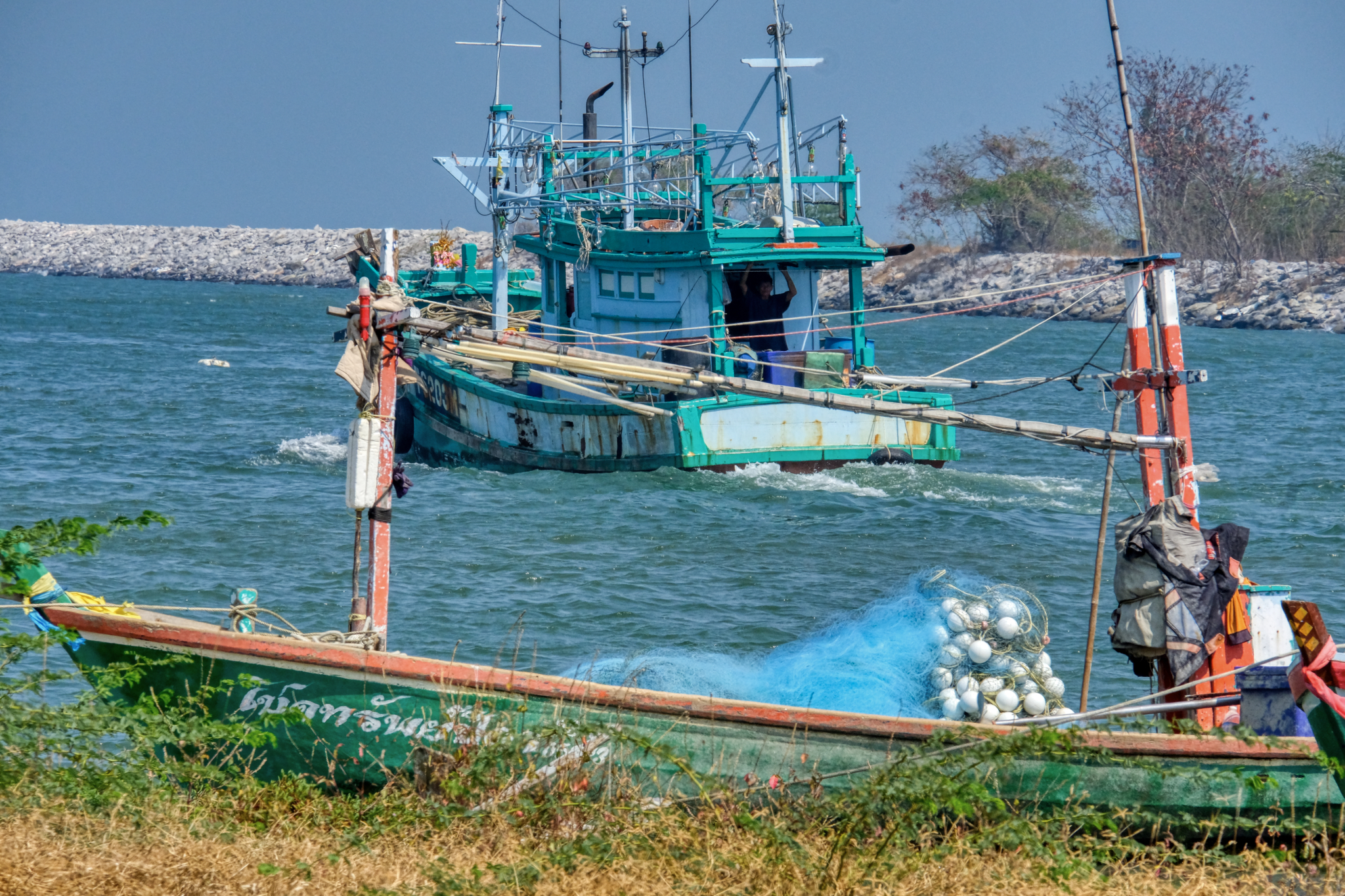 A 'company boat' heading out early for night squidding . . . they must be going far out into the Gulf of Thailand.
A 'company boat' heading out early for night squidding . . . they must be going far out into the Gulf of Thailand.
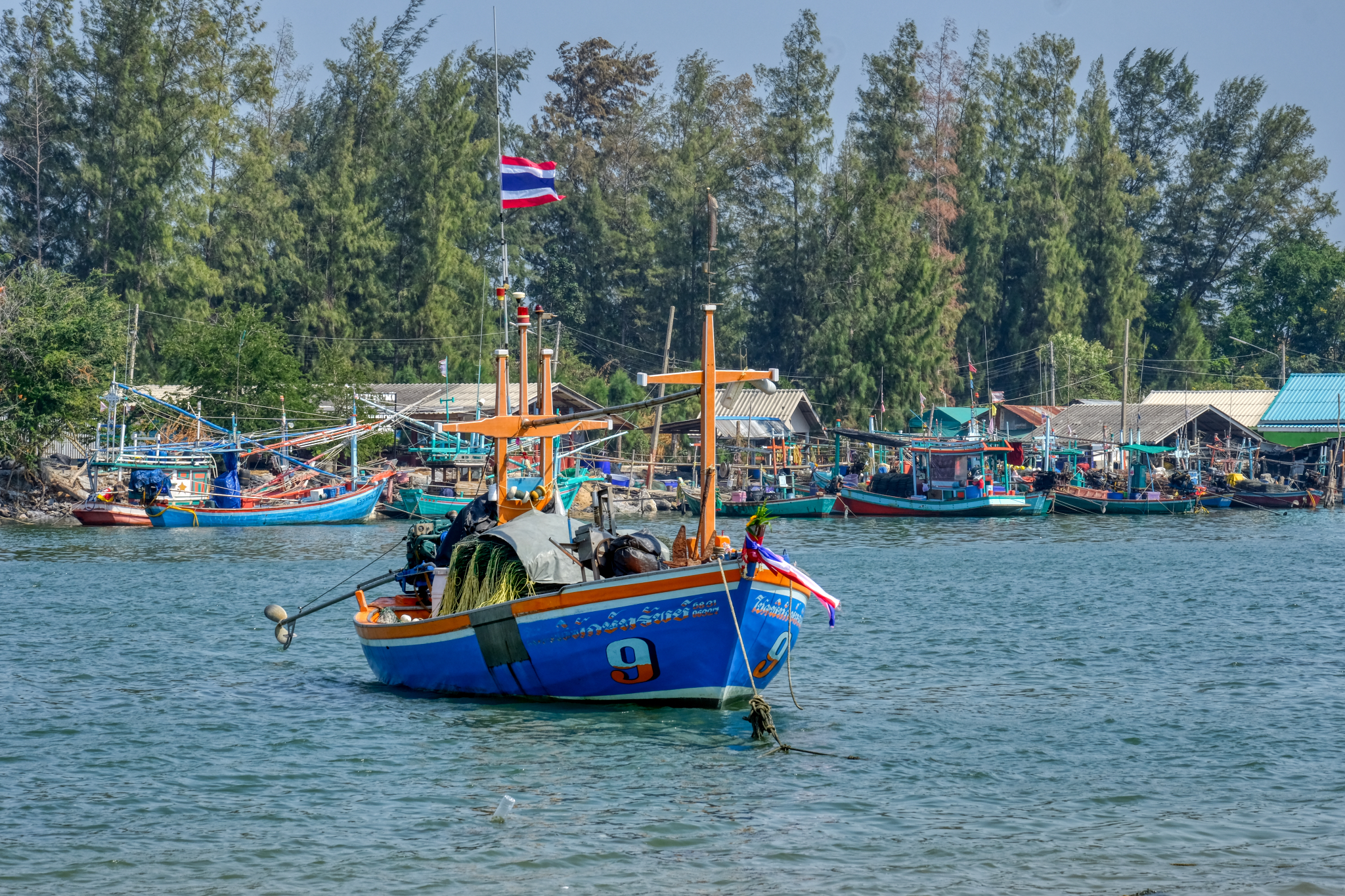 A busy Thai commercial fishing port.
A busy Thai commercial fishing port.
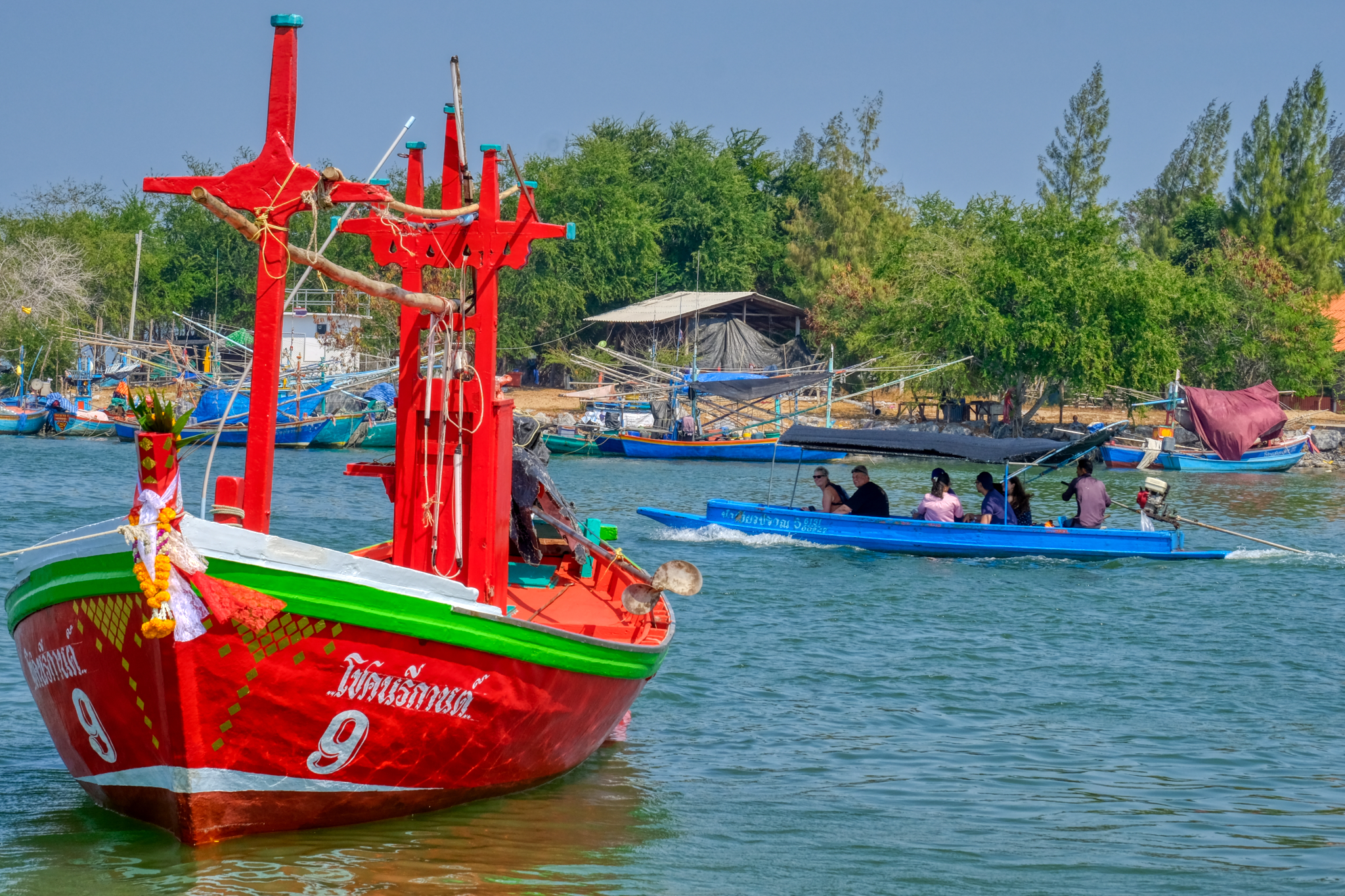 Yep . . . a tourist tour boat! This is actually the tourist boat from the mangrove forest park nearby . . . we all waved at each other.
Yep . . . a tourist tour boat! This is actually the tourist boat from the mangrove forest park nearby . . . we all waved at each other.
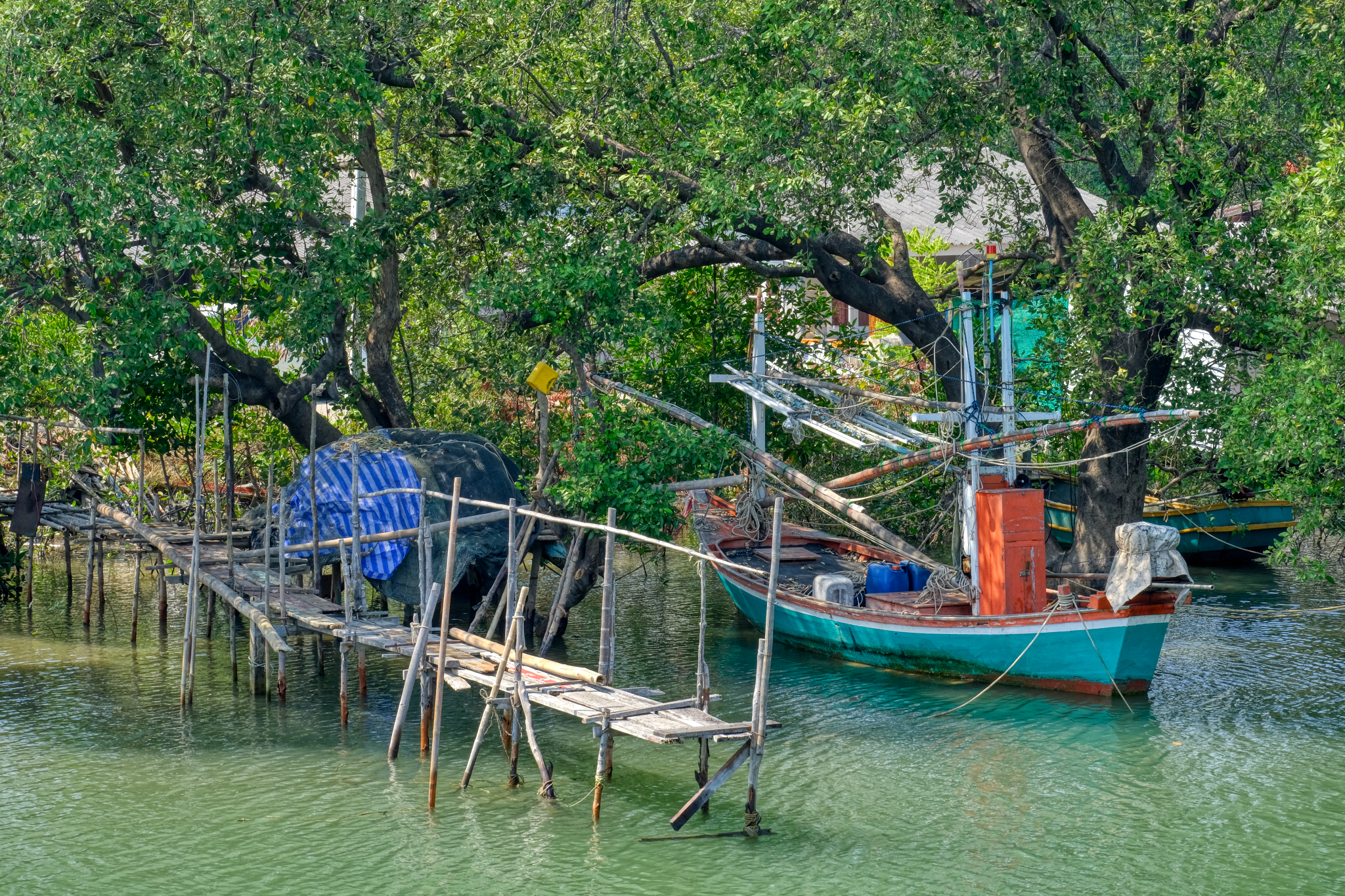 We walked along the road near the fishing port and came across a picturesque little slough.
We walked along the road near the fishing port and came across a picturesque little slough.
 Life along the slough.
Life along the slough.
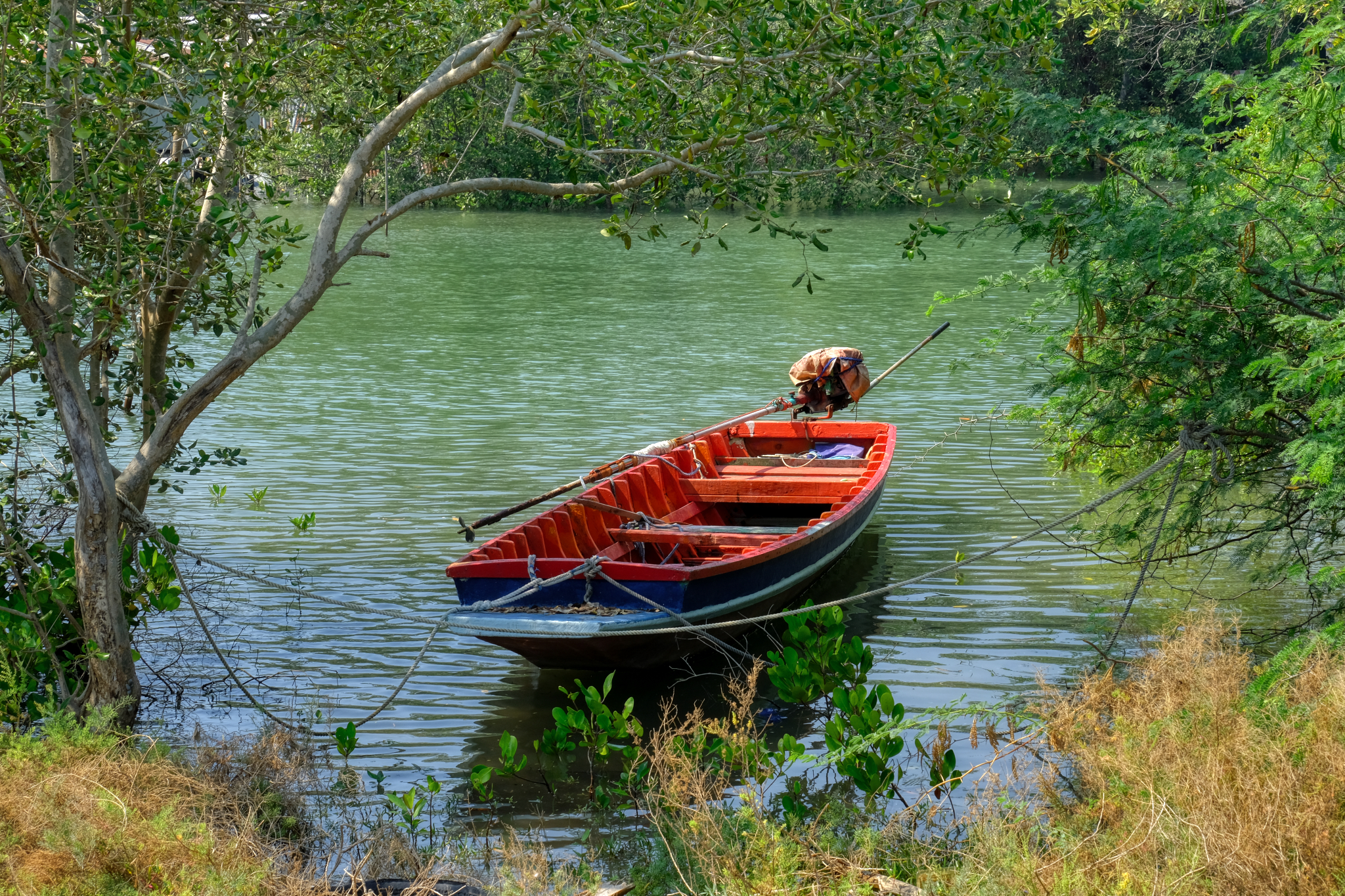 Picturesque . . . indeed!
Picturesque . . . indeed!
---------------------------------------------------------
Happy New Year 2020 From Hua Hin Thailand!!!
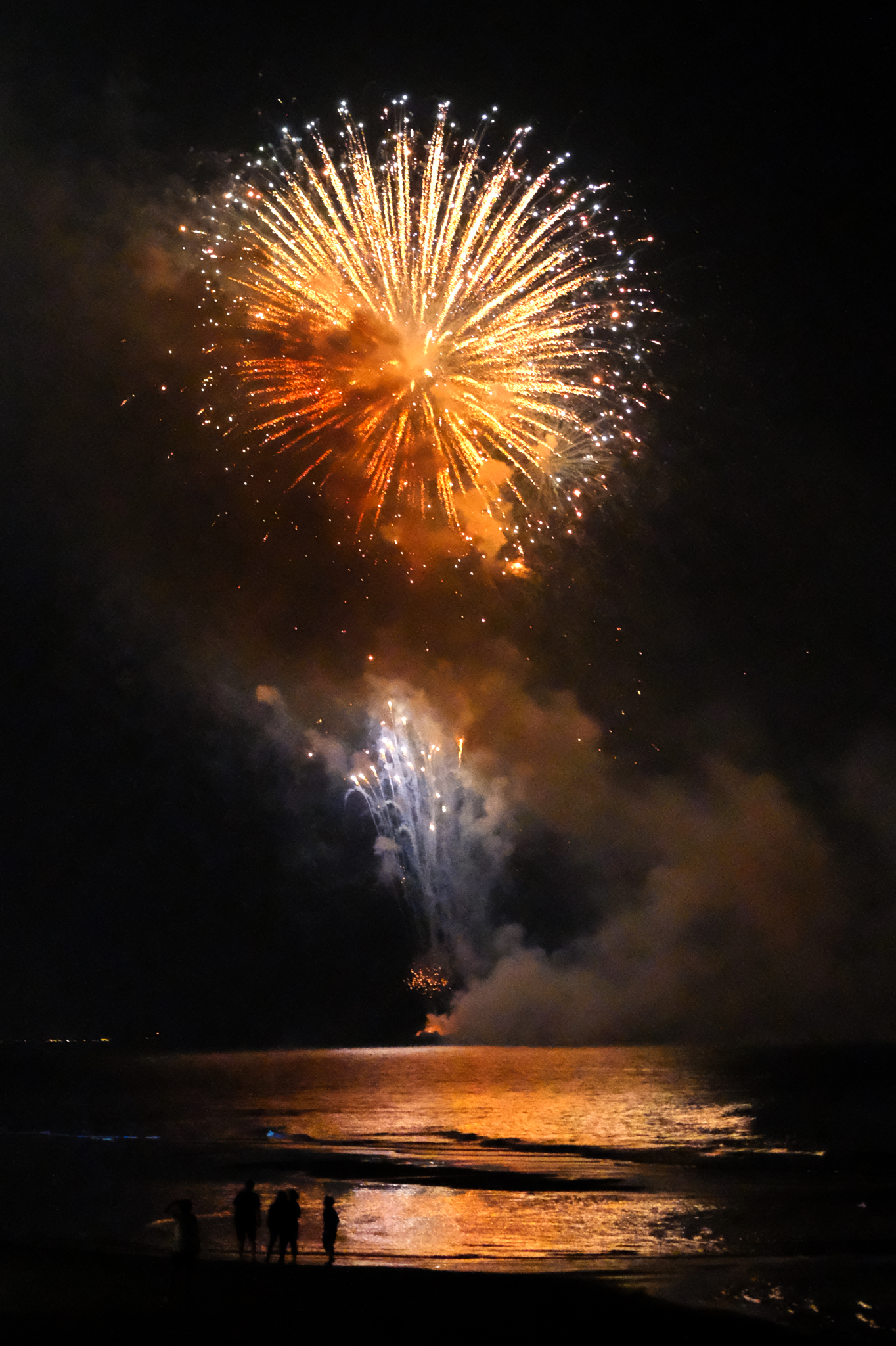 We went out to dinner at our usual favorite restaurant . . . . but we were not satisfied with the meal . . . it was a buffet, not the usual excellent food from the menu. Afterward we went to a friend's beach house . . . then out on to the beach for the BIG fireworks display.
We went out to dinner at our usual favorite restaurant . . . . but we were not satisfied with the meal . . . it was a buffet, not the usual excellent food from the menu. Afterward we went to a friend's beach house . . . then out on to the beach for the BIG fireworks display.
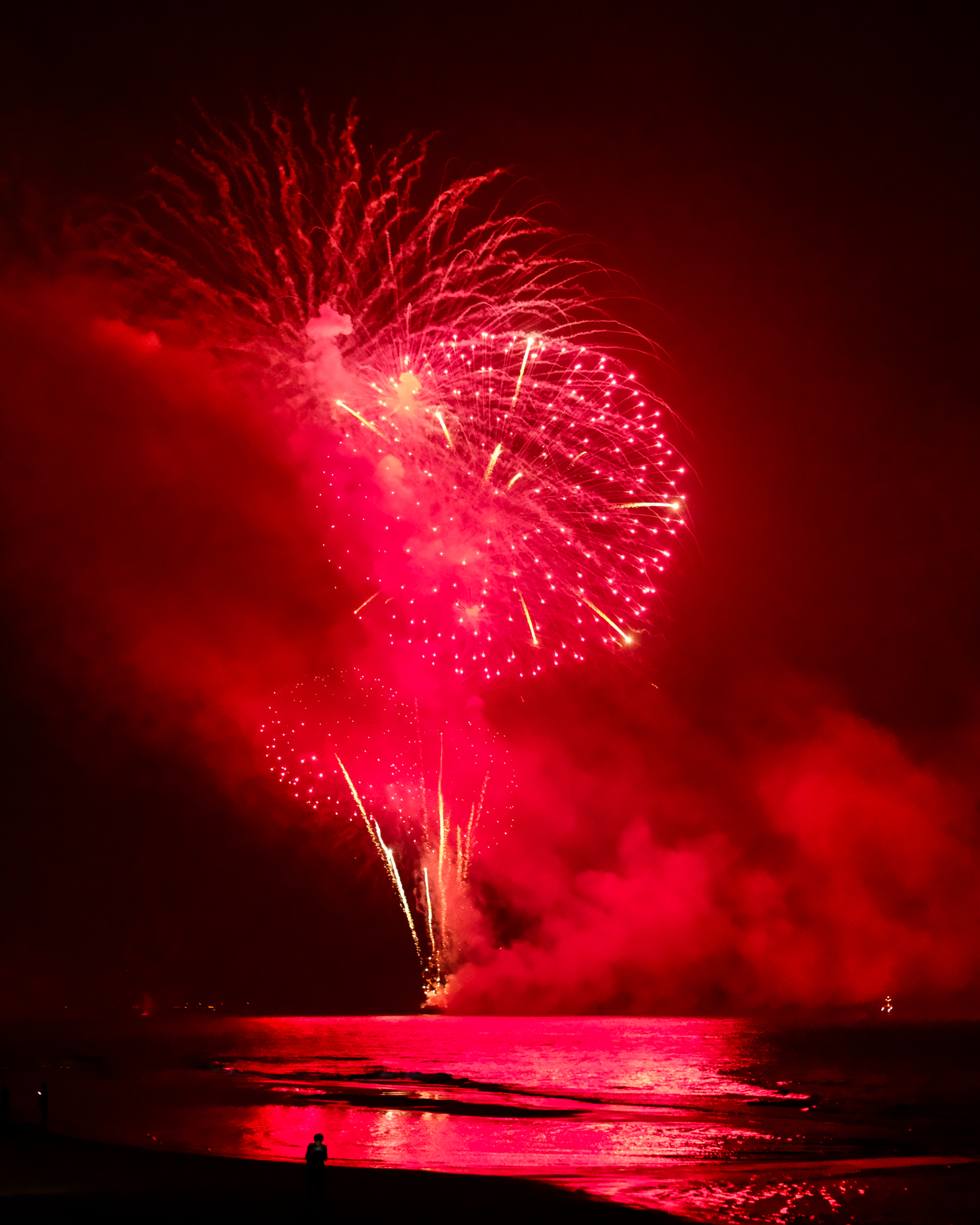 Down along the beach . . . fantastic fireworks display for 20-25 minutes.
Down along the beach . . . fantastic fireworks display for 20-25 minutes.
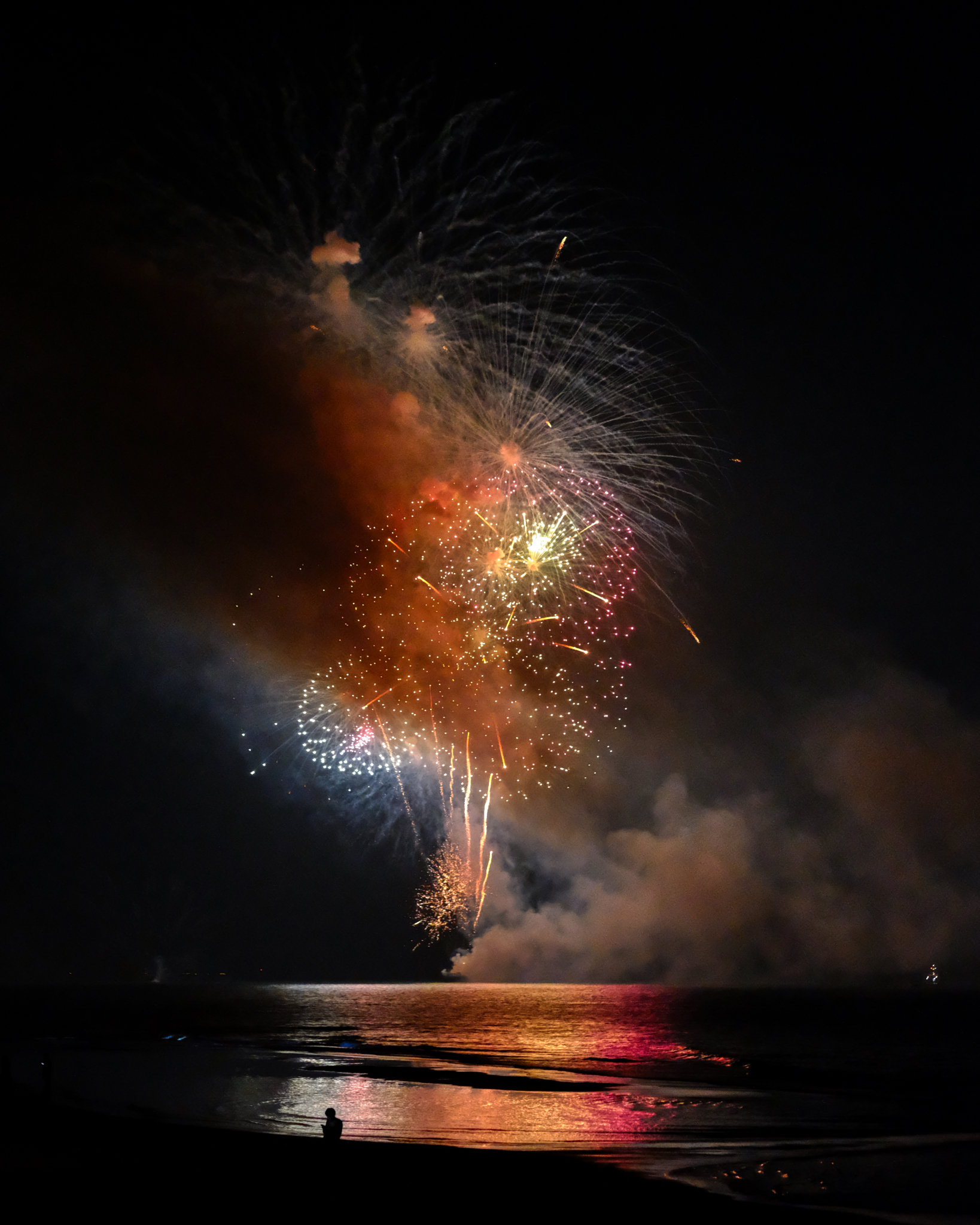 Fireworks across the bay . . .
Fireworks across the bay . . .
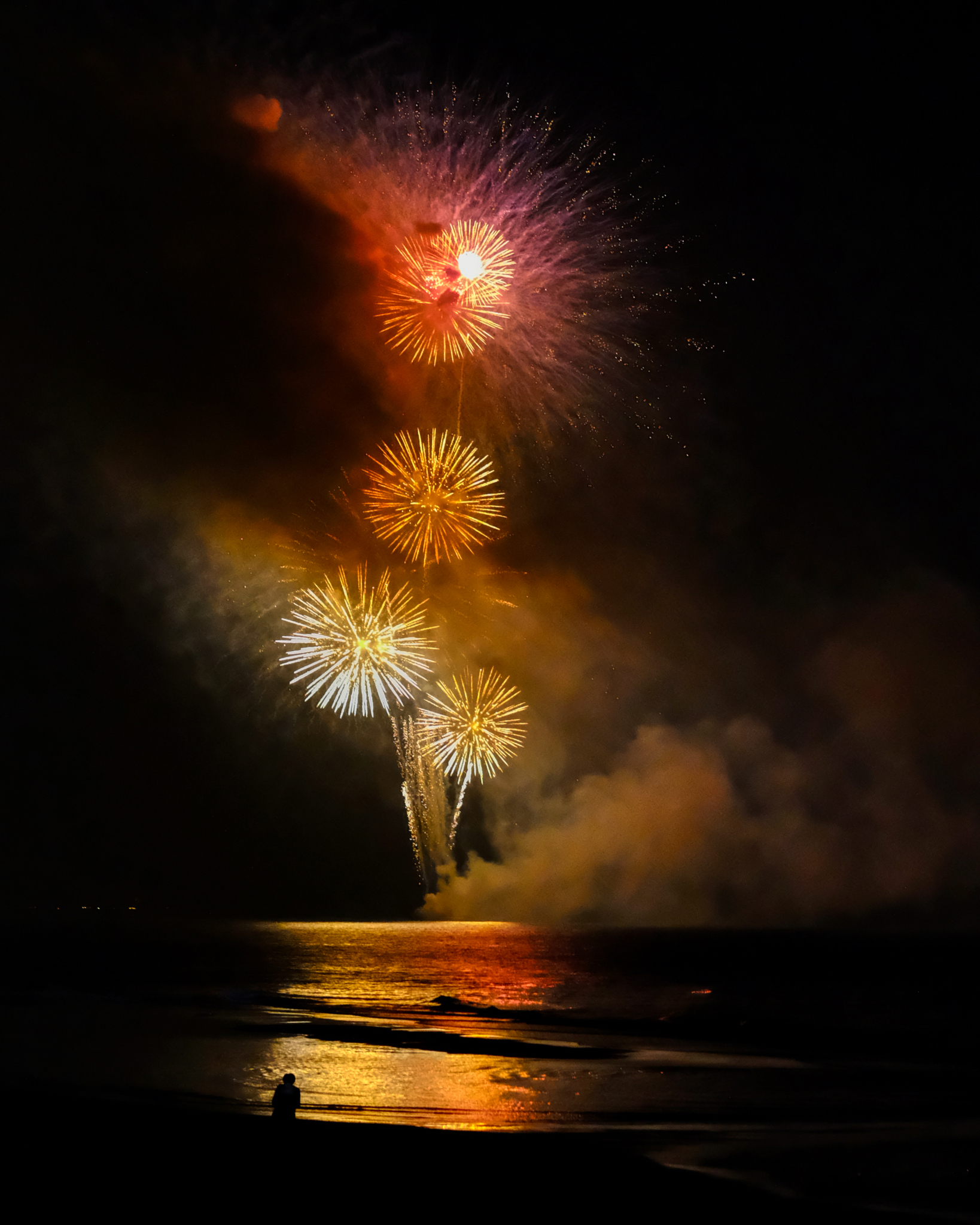 Once I figured out my camera settings . . .
Once I figured out my camera settings . . .
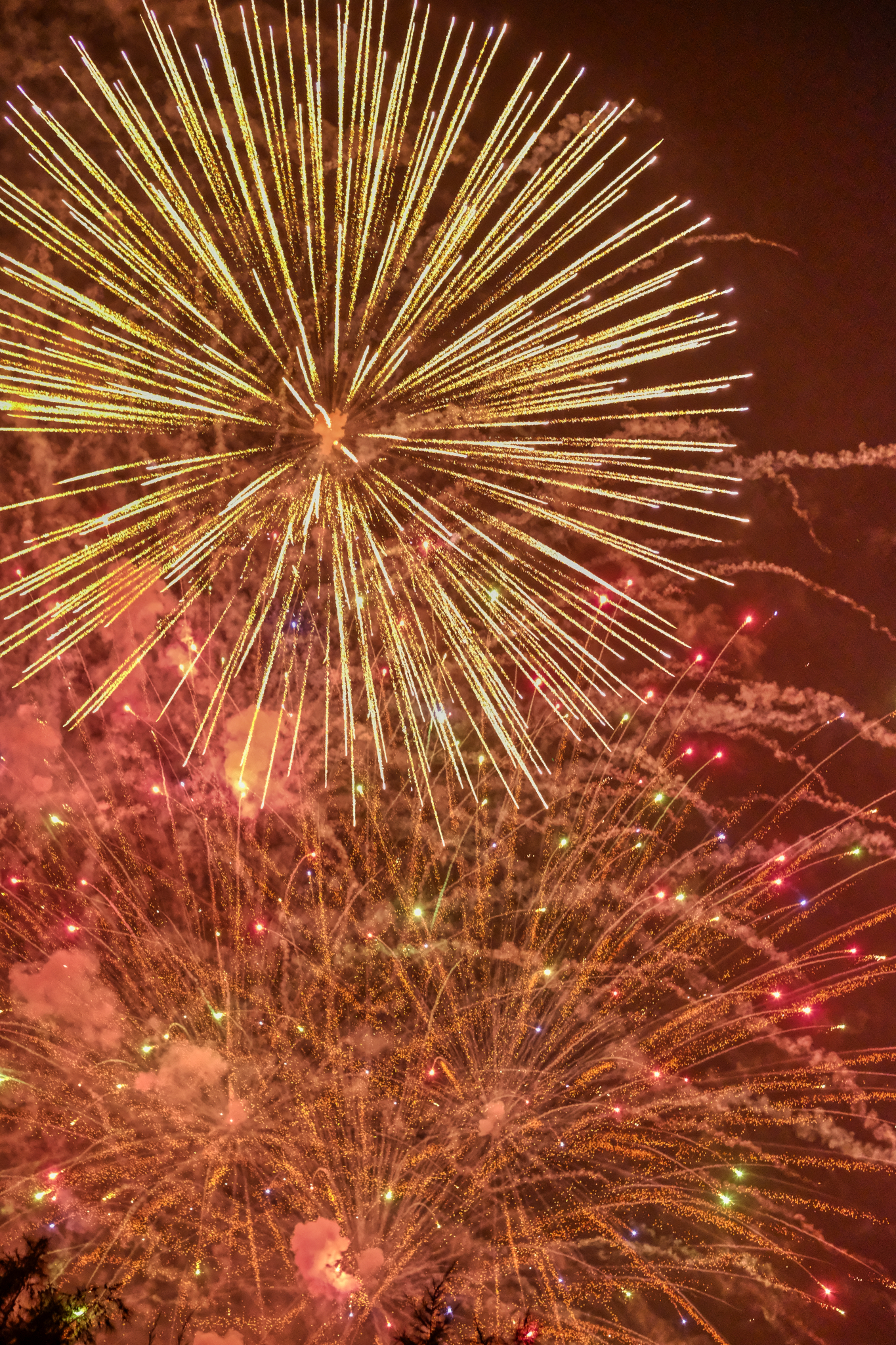 Right overhead!
Right overhead!
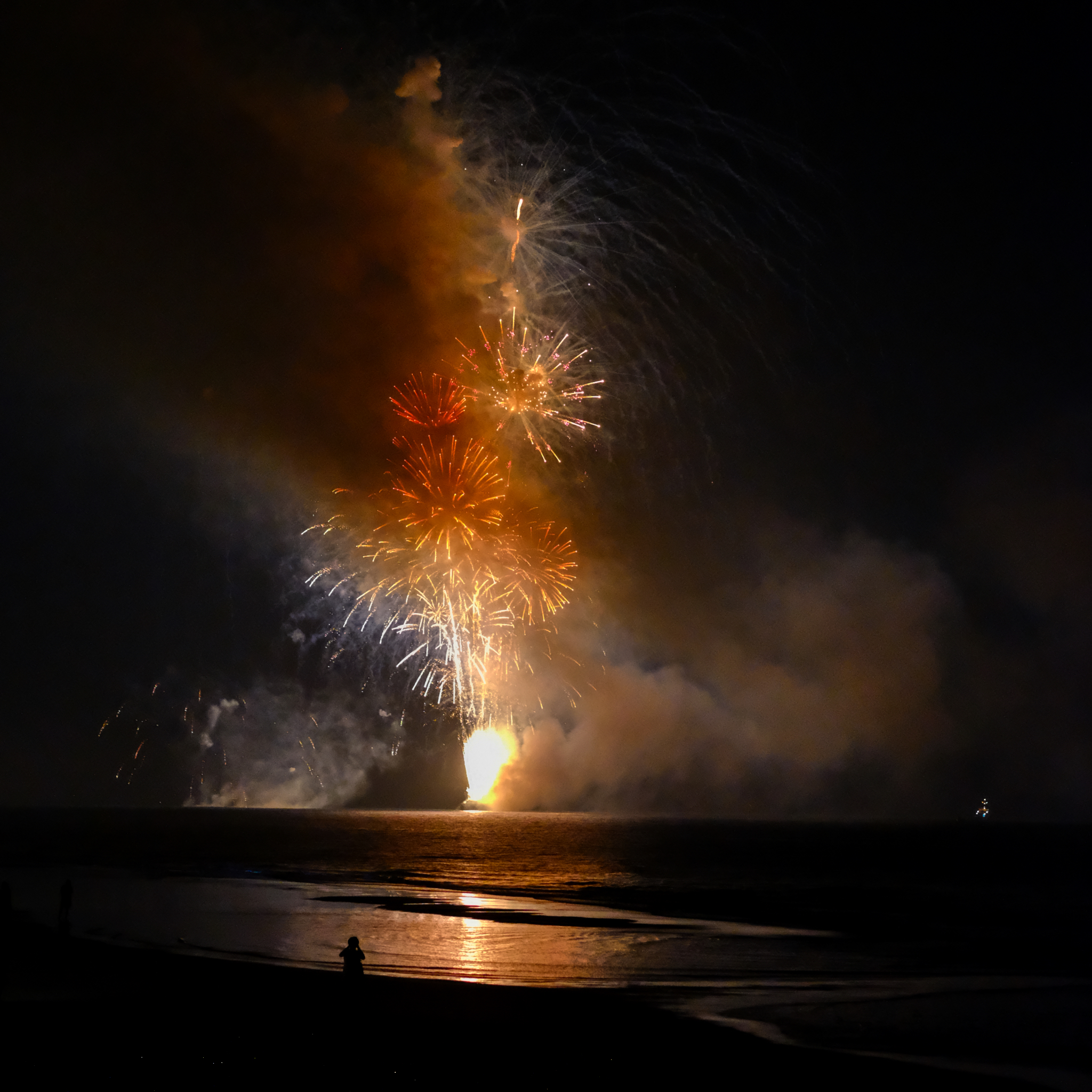 I hope you all had a New Years' Eve as colorful and interesting as I did!
I hope you all had a New Years' Eve as colorful and interesting as I did!
YES! All in a day! All within 20 miles!
Working From Home . . . Missing My River Commute
 Saturday, March 21, 2020 at 6:46PM
Saturday, March 21, 2020 at 6:46PM I work as a director and professor at a Thai public university. On most days I take an express boat 40 minutes to and from my office on the Chao Phraya River . . . but due to the COVID-19 virus, I am now working from home as my university has closed the campus.
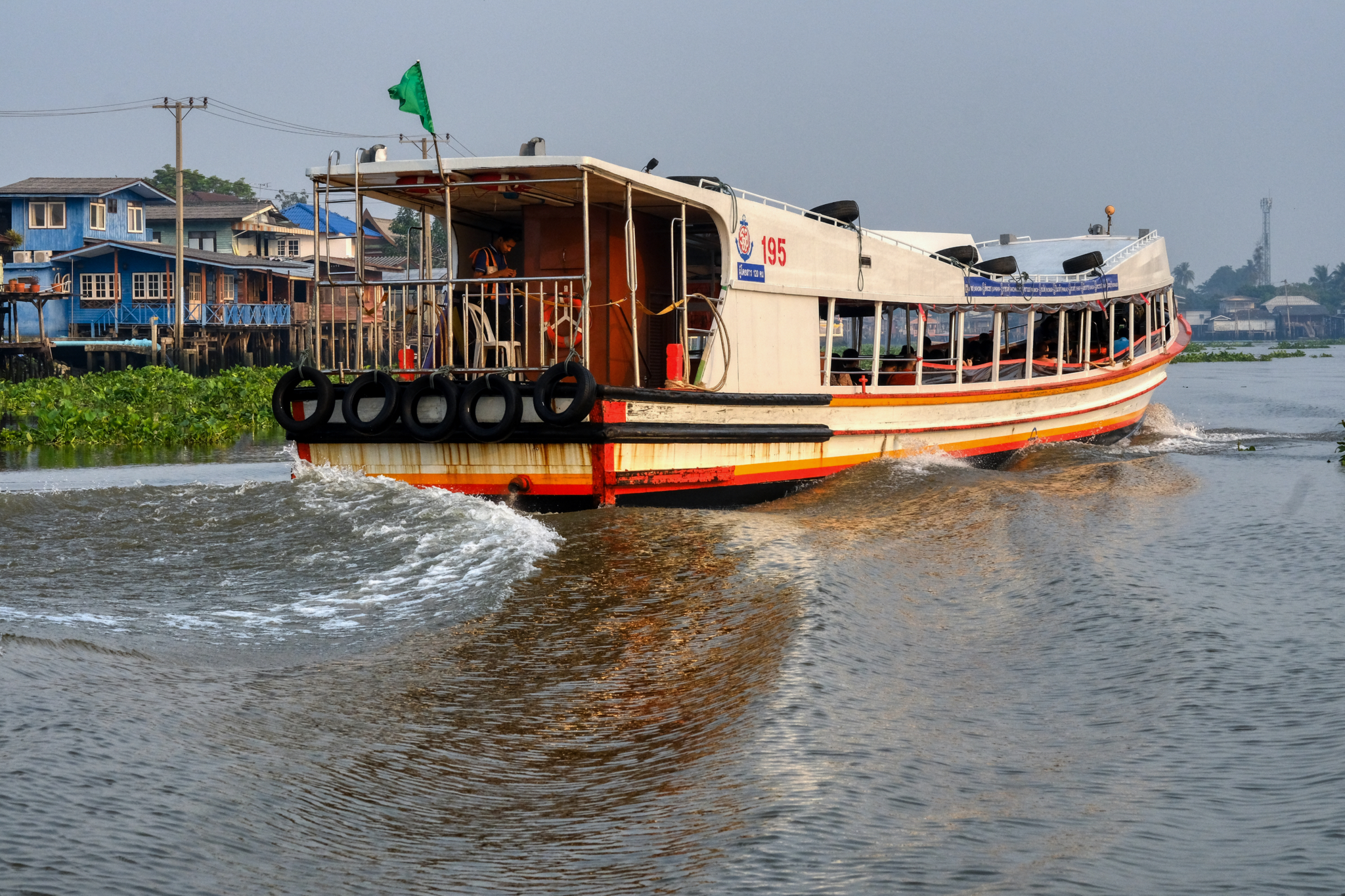 After a short public bus ride, I catch this Chao Phraya River Express Boat (green flag) for the 40 minute ride down the fascinating and picturesque river to my office.
After a short public bus ride, I catch this Chao Phraya River Express Boat (green flag) for the 40 minute ride down the fascinating and picturesque river to my office.
 These are the docks where I catch my commuter boat. Pakkret Pier.
These are the docks where I catch my commuter boat. Pakkret Pier.
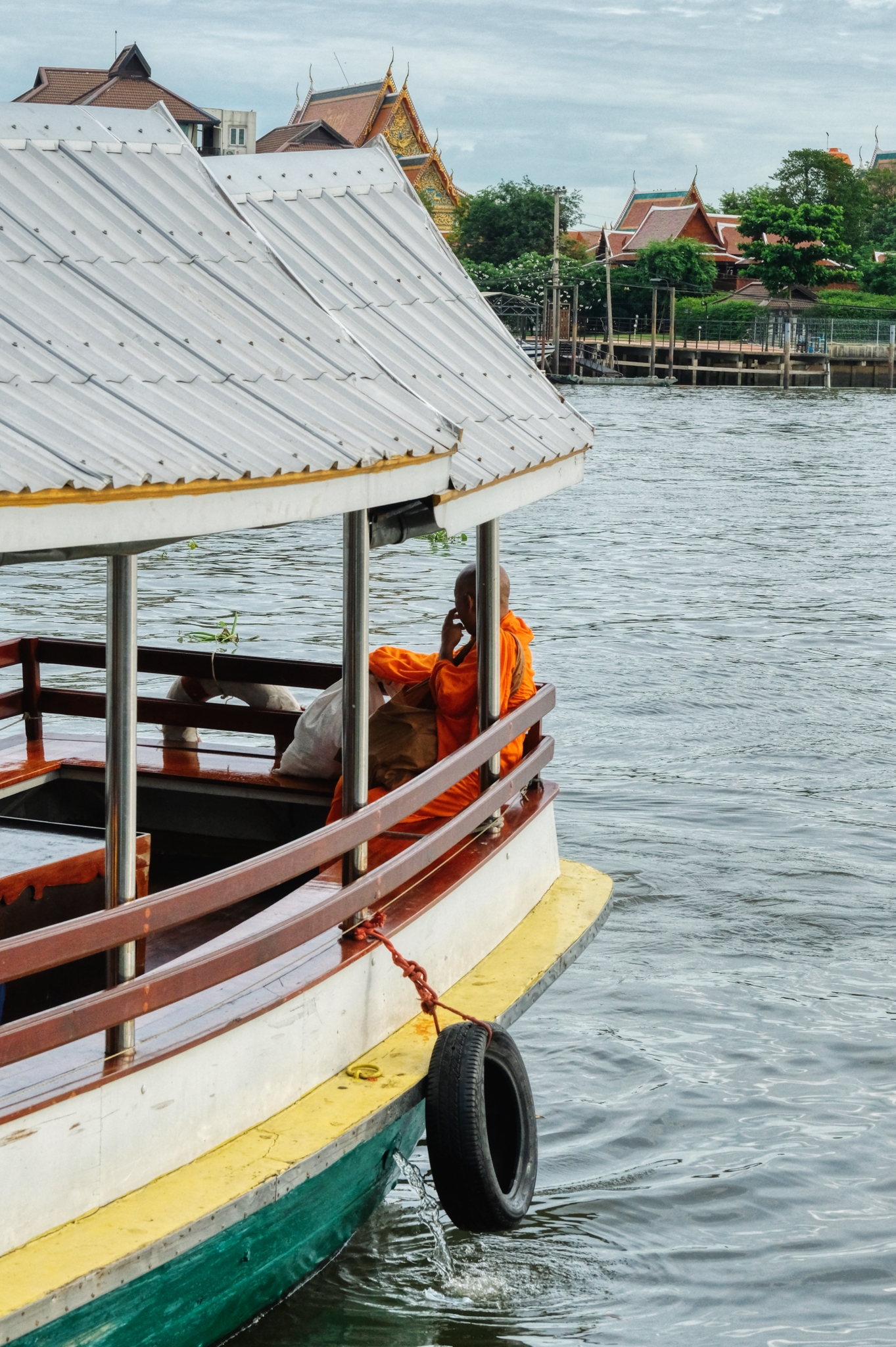 I am not the only person out on my morning commute and rounds . . . .
I am not the only person out on my morning commute and rounds . . . .
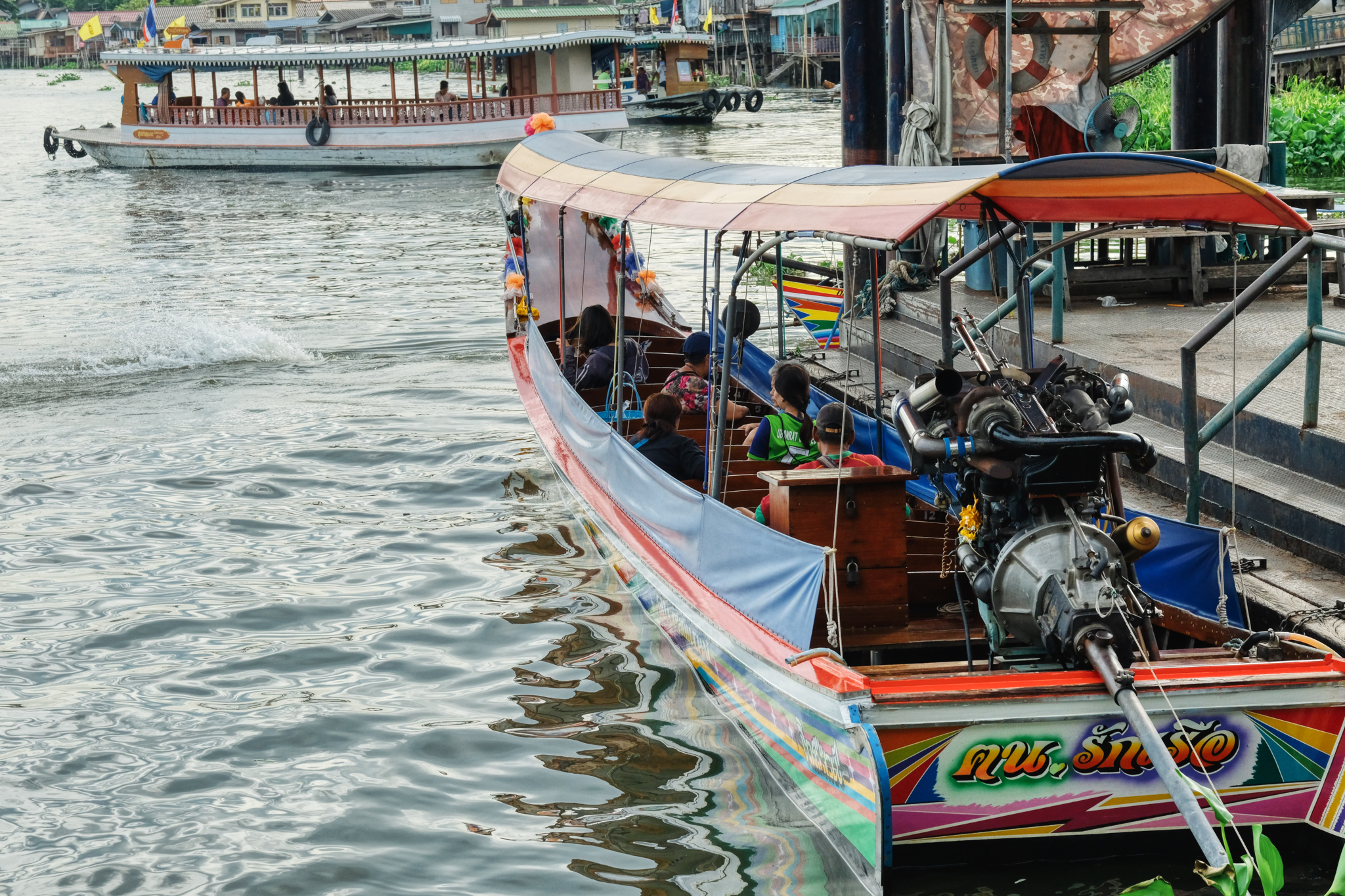 Many long-tail river taxi boats lined up taking merchants back to their small businesses after visiting the morning wet market.
Many long-tail river taxi boats lined up taking merchants back to their small businesses after visiting the morning wet market.
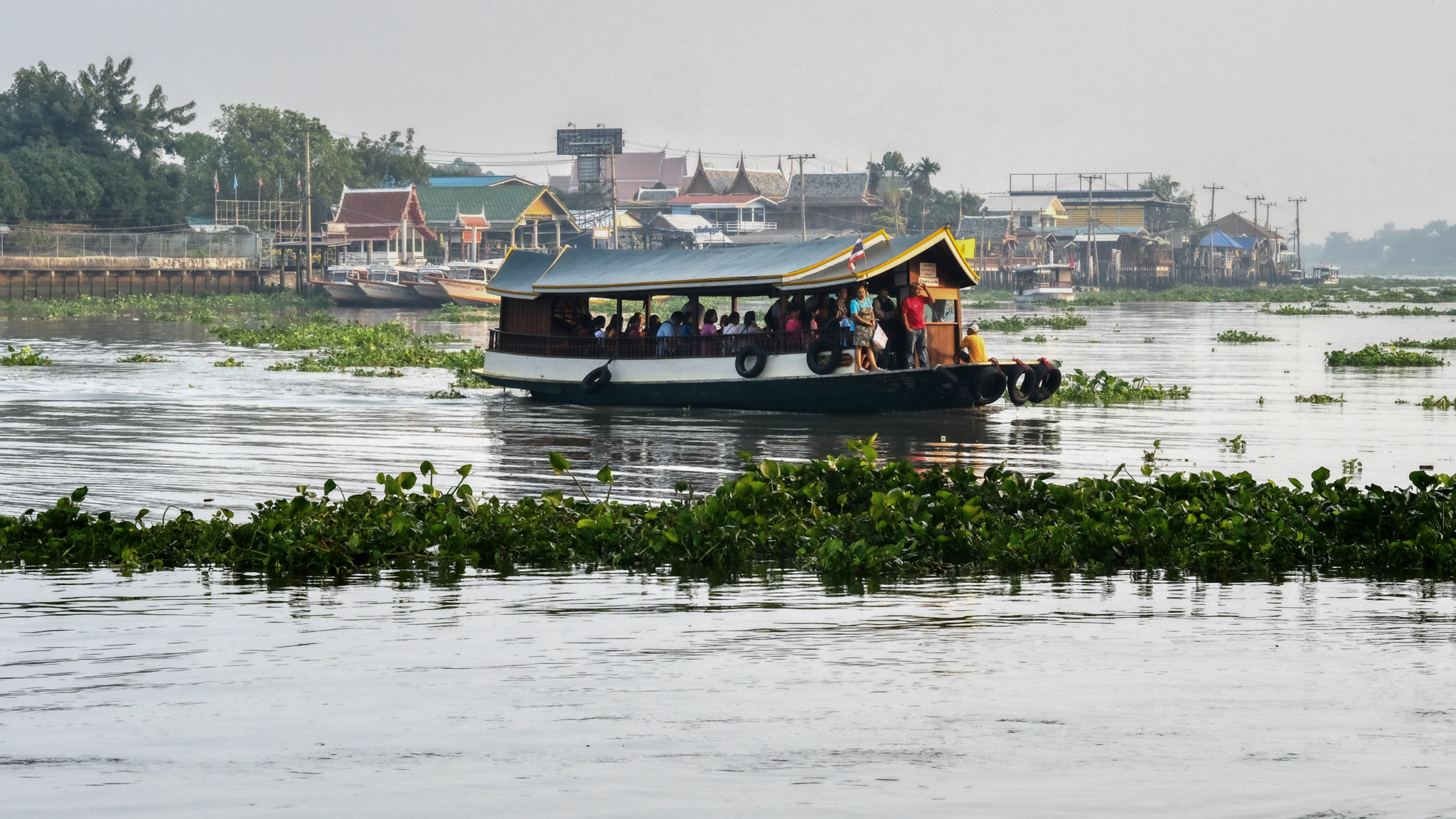 I join in a mass movement of people on their way to work along, on, and across the Chao Phraya River. Here a 3 baht ferry.
I join in a mass movement of people on their way to work along, on, and across the Chao Phraya River. Here a 3 baht ferry.
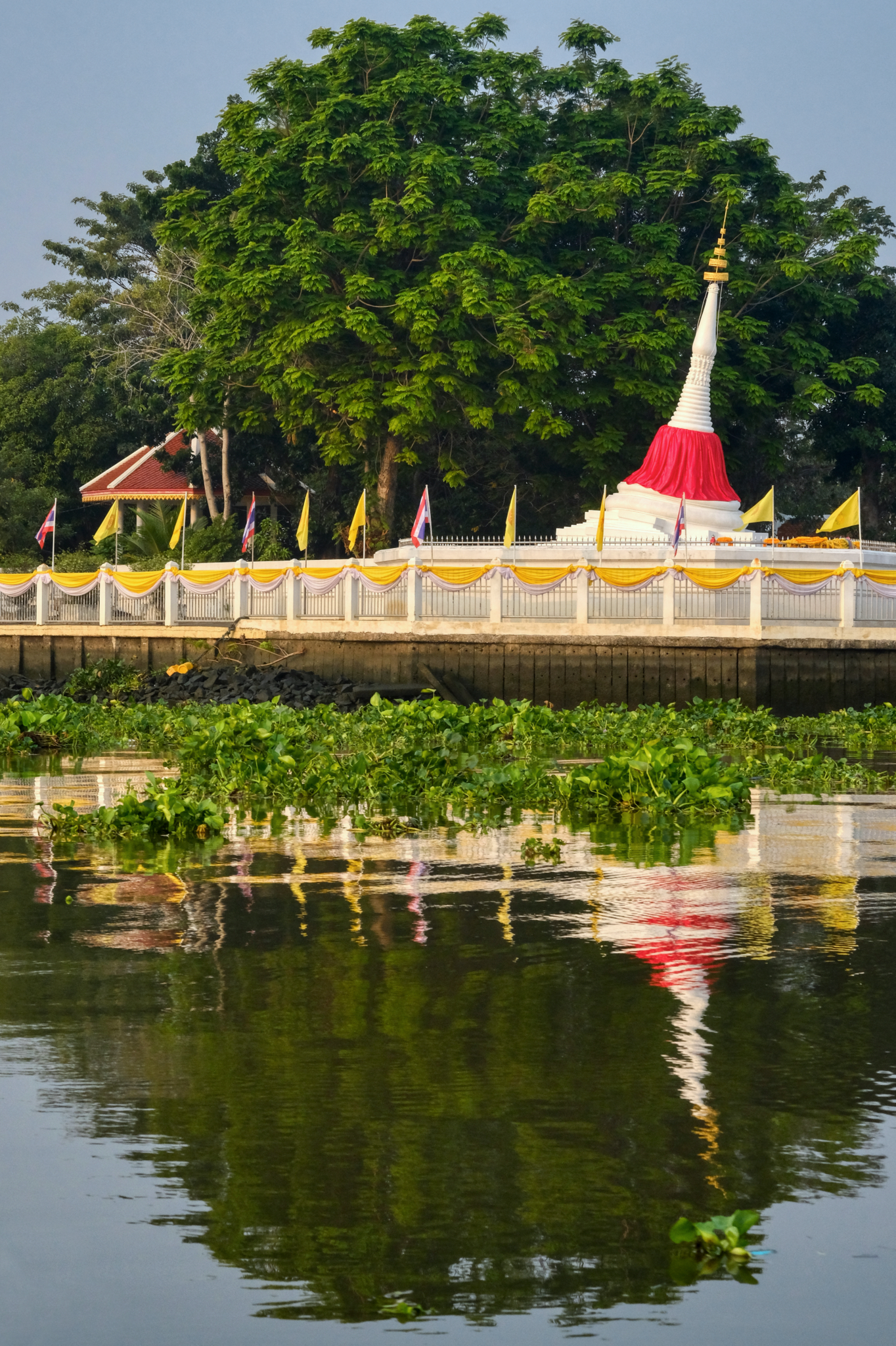 The journey down river begins by passing through a narrow 'cut' canal in the river that passes a beautiful, and sacred, tilted chedi on the point of Koh Kret (island) at Wat Poramai Yikawat.
The journey down river begins by passing through a narrow 'cut' canal in the river that passes a beautiful, and sacred, tilted chedi on the point of Koh Kret (island) at Wat Poramai Yikawat.
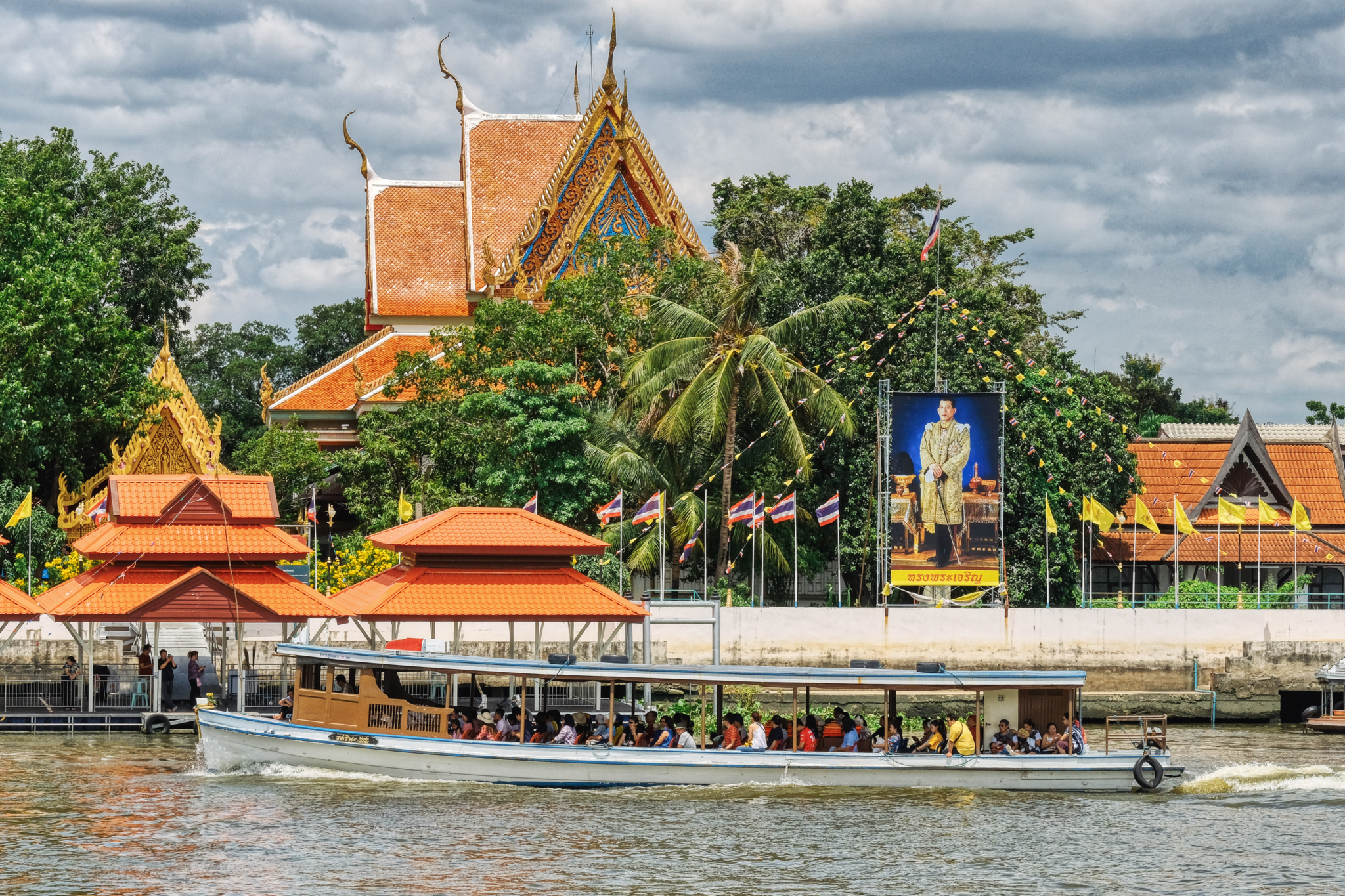 Facing Koh Kret is the magnificent Wat Sanam Nuea and a ferry terminal . . . the main way to get to the island.
Facing Koh Kret is the magnificent Wat Sanam Nuea and a ferry terminal . . . the main way to get to the island.
 There is a continuous line of houses up on stilts along the Koh Kret cut. This is what my daily mundane life looks like . . . my supramundane.
There is a continuous line of houses up on stilts along the Koh Kret cut. This is what my daily mundane life looks like . . . my supramundane.
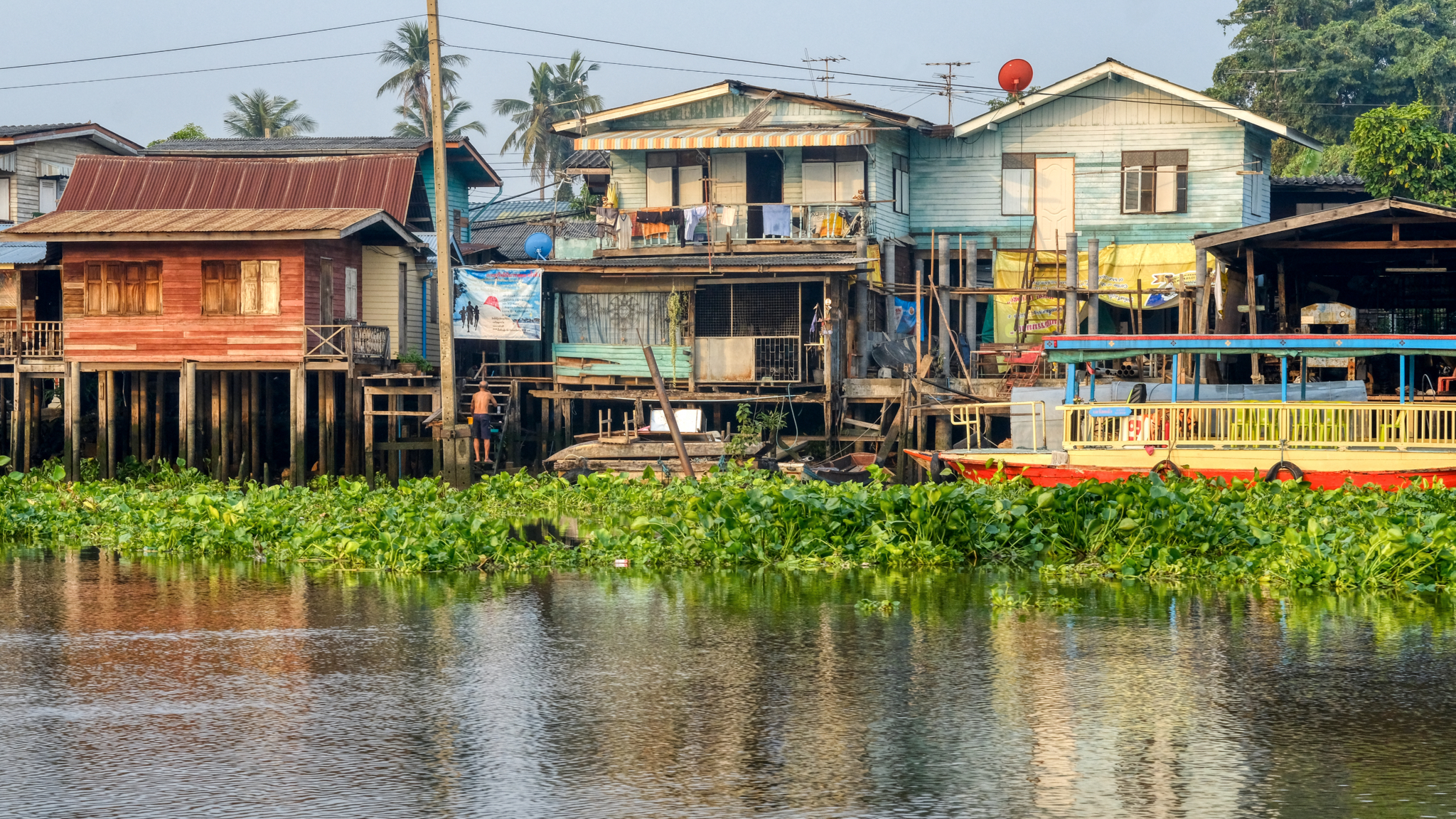
I know these houses by heart . . . I 'study' them every morning in the calm serenity and languid humidity of the tropical morning.
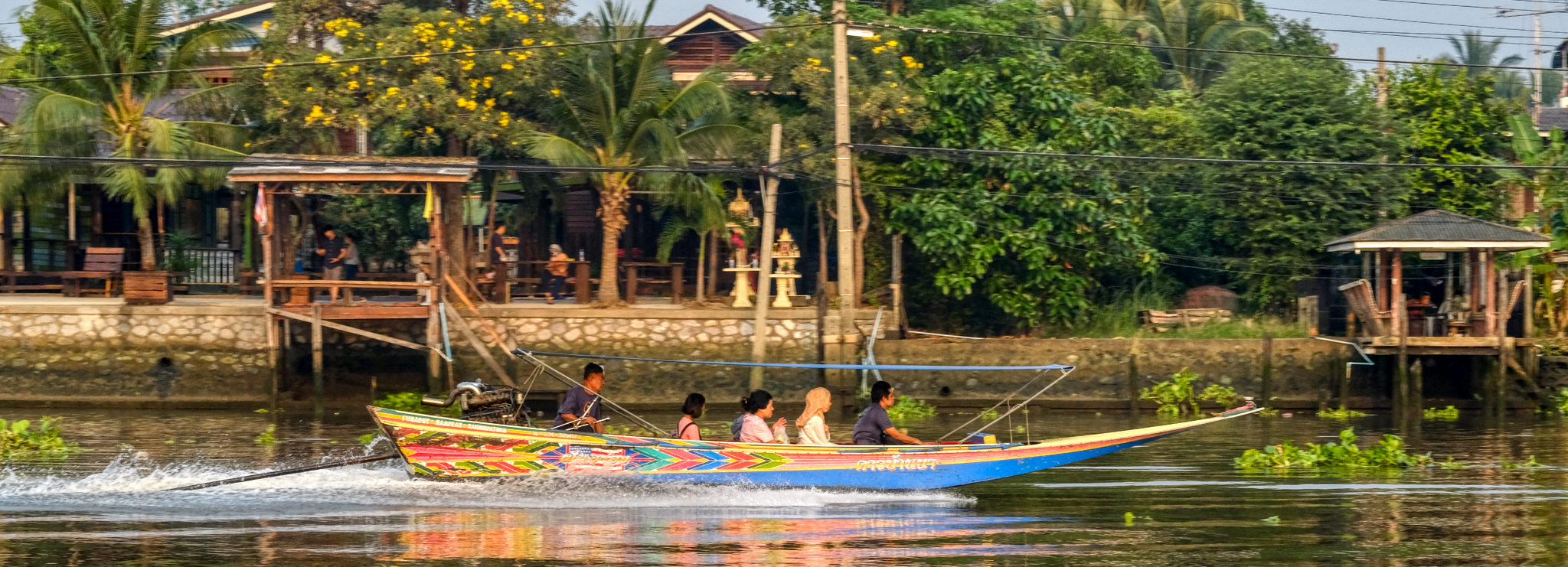 My express boat rattles some, and its old diesel engine chugs along in a rhythmic manner . . . but it's cadences are broken when a long-tail boat, a kind of hot rod river taxi, roars past. What a way to get to school or market!
My express boat rattles some, and its old diesel engine chugs along in a rhythmic manner . . . but it's cadences are broken when a long-tail boat, a kind of hot rod river taxi, roars past. What a way to get to school or market!
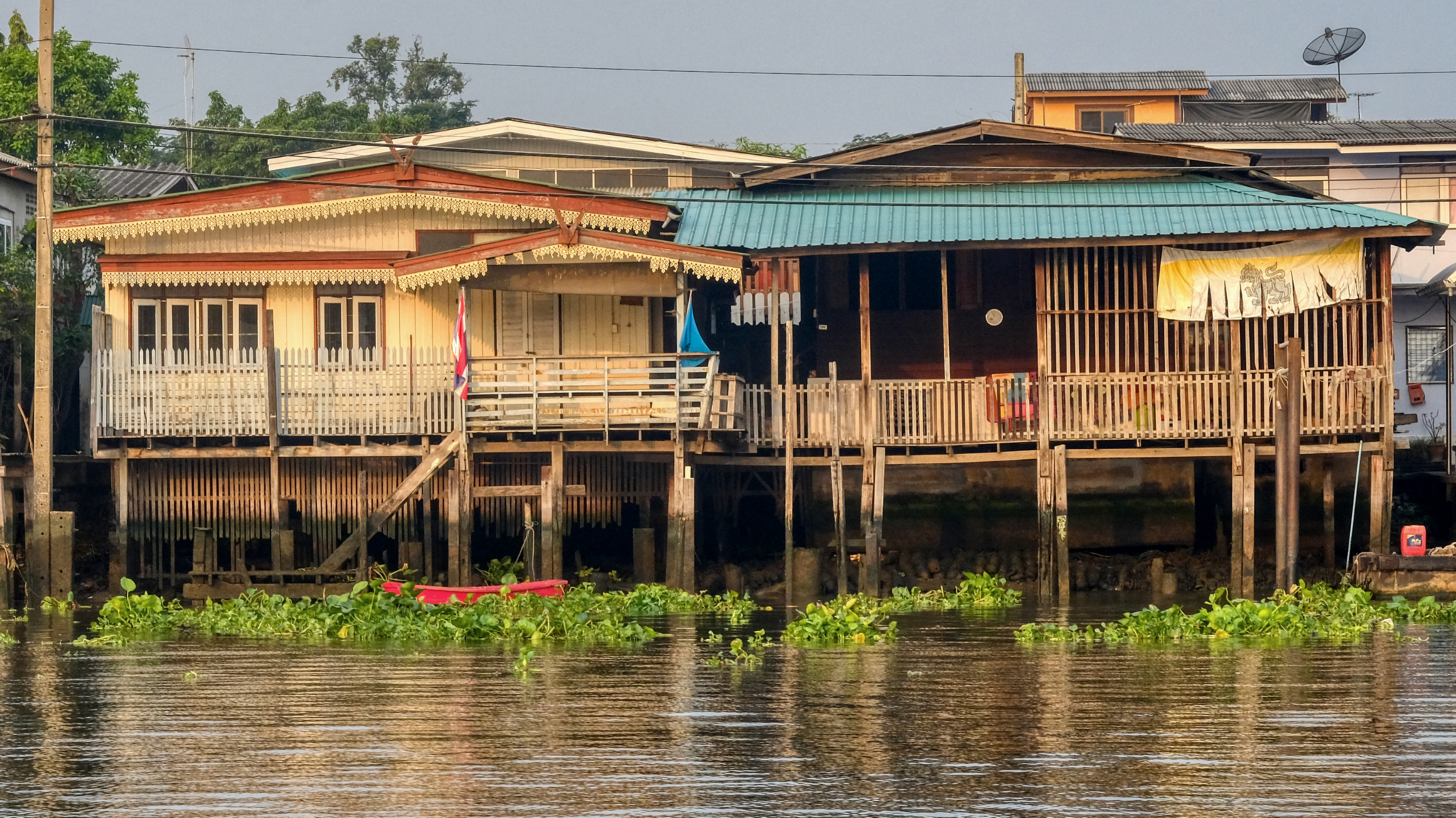
When I moved to Thailand 23 years ago I spent a good deal of time for two years trying to find one of these river houses to rent . . . and never could find one.
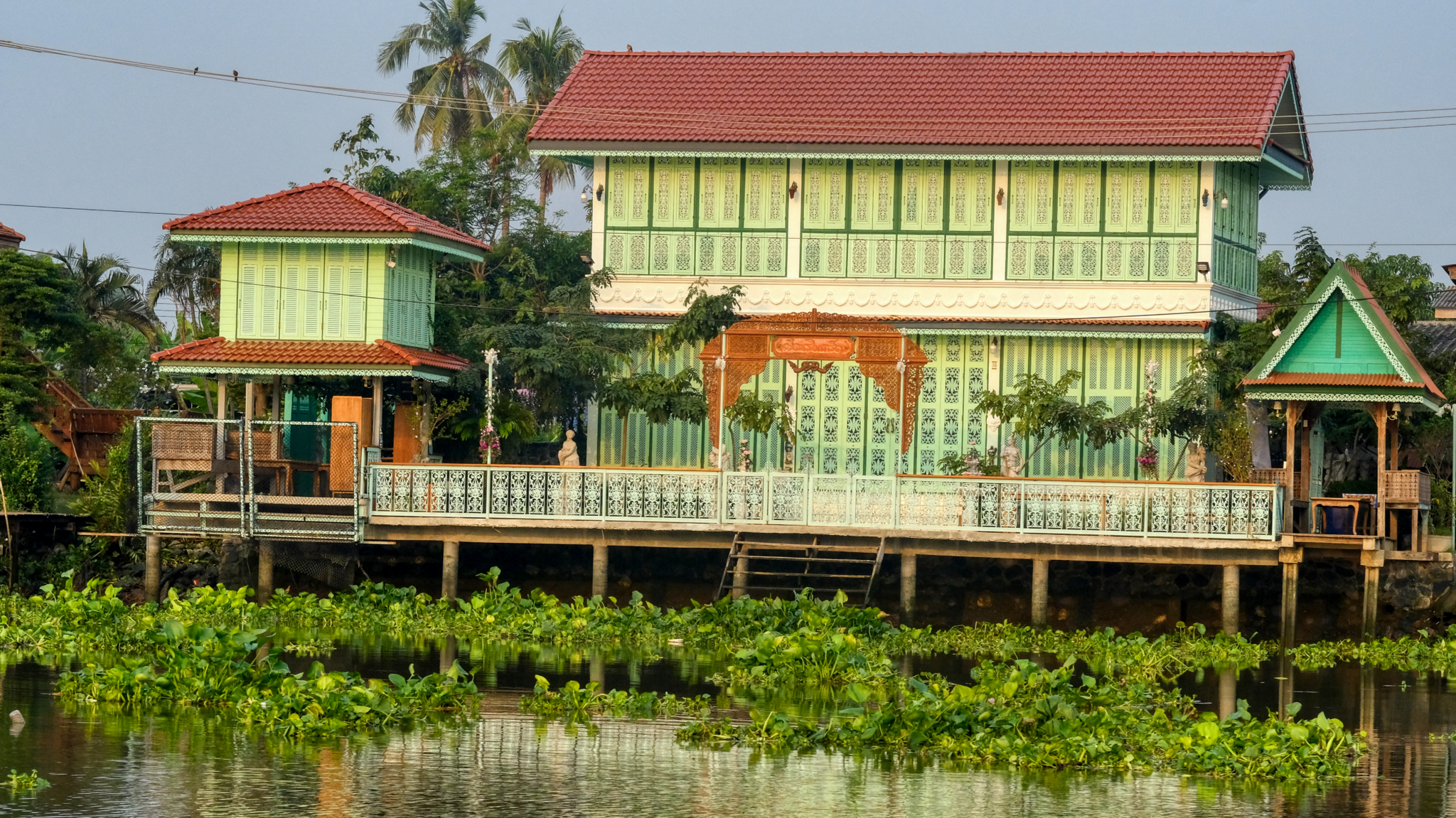 Every morning I have been watching this new construction of a traditional Thai-style house going up on the island side of the canal. Beautiful. I want to live here.
Every morning I have been watching this new construction of a traditional Thai-style house going up on the island side of the canal. Beautiful. I want to live here.
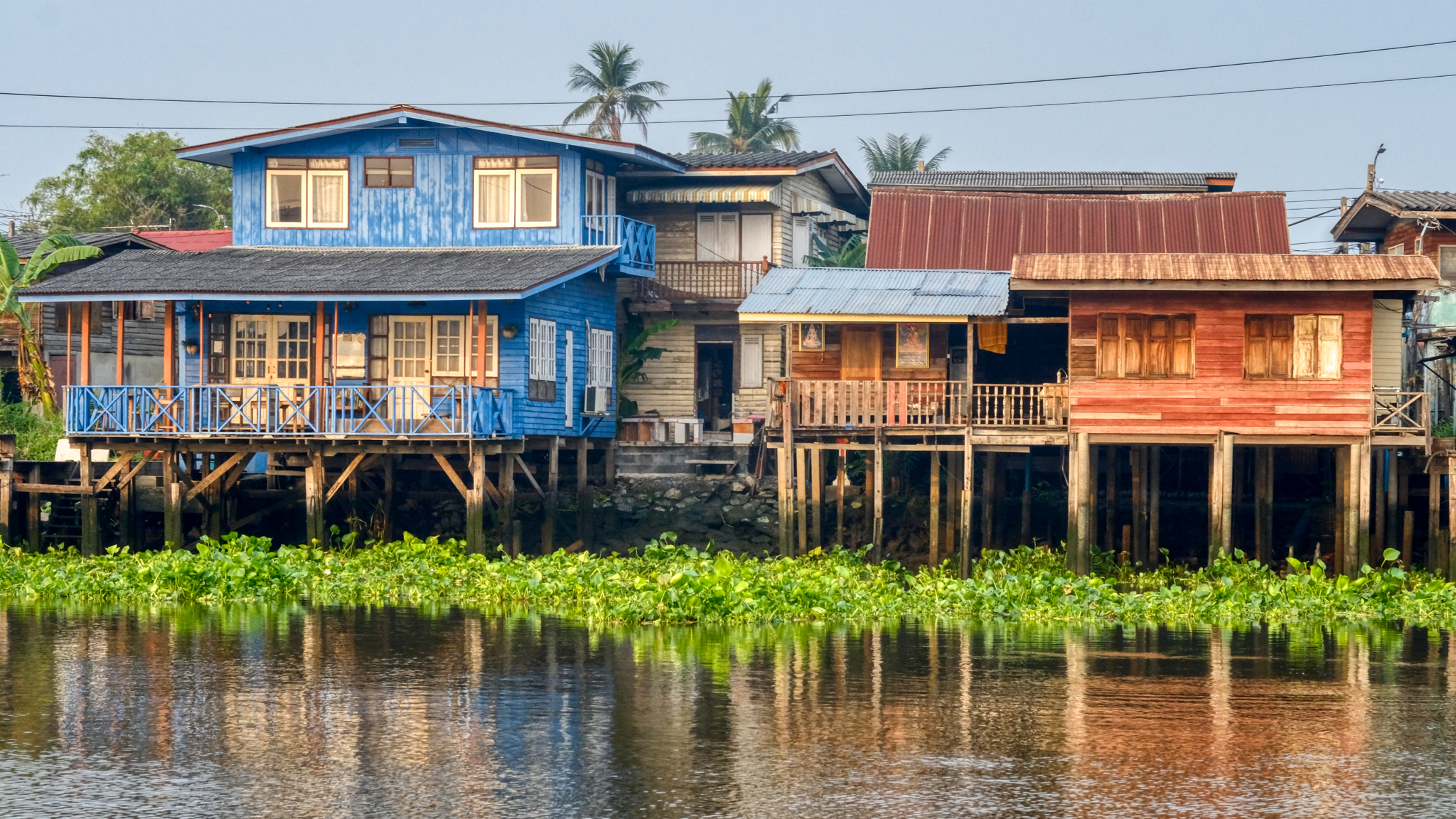 I can see myself sitting on one of these porches watching the boats go by . . . but this dream is not to be.
I can see myself sitting on one of these porches watching the boats go by . . . but this dream is not to be.
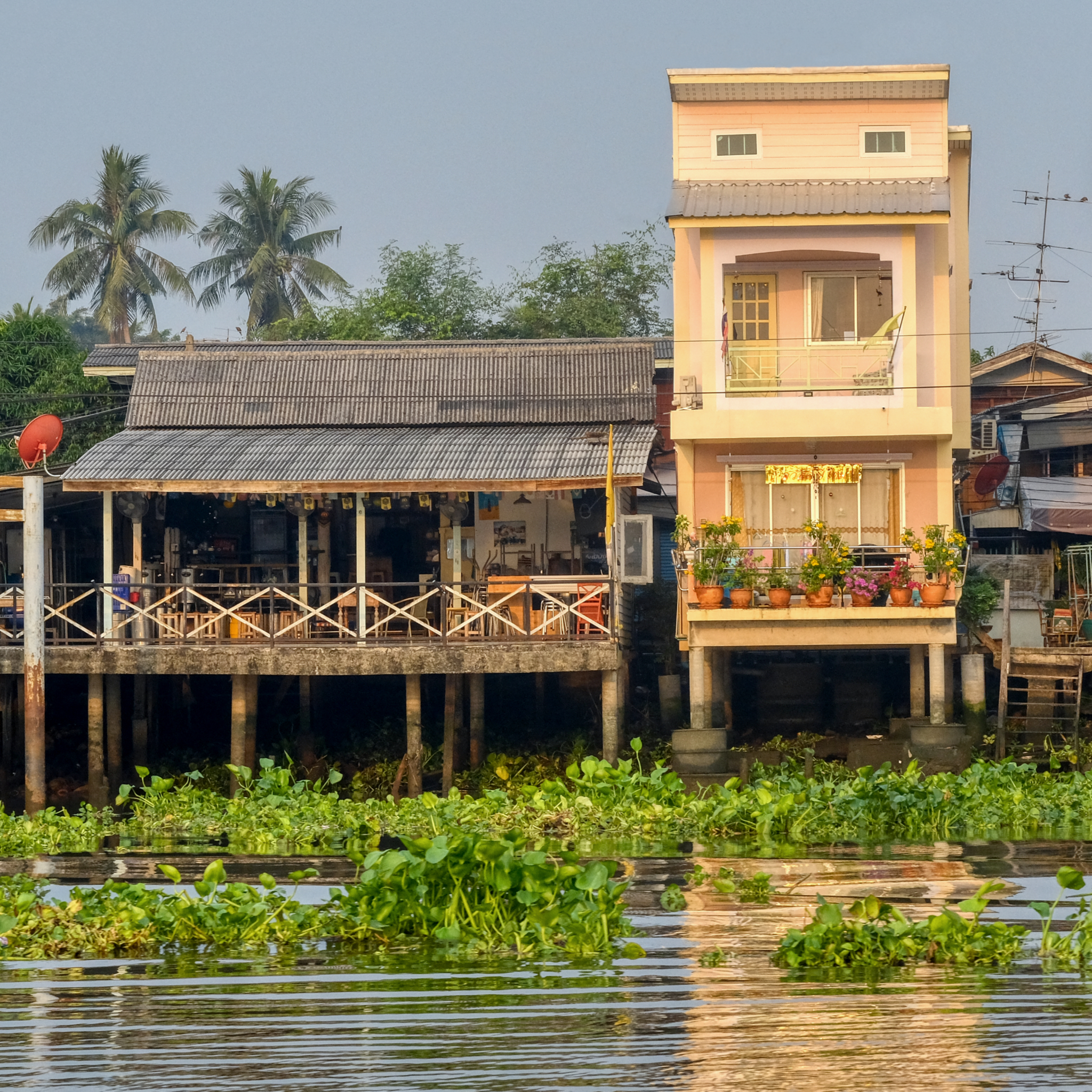 There is a charming mixture of houses along the canal: a traditional restaurent beside a stick and stucco modern house.
There is a charming mixture of houses along the canal: a traditional restaurent beside a stick and stucco modern house.
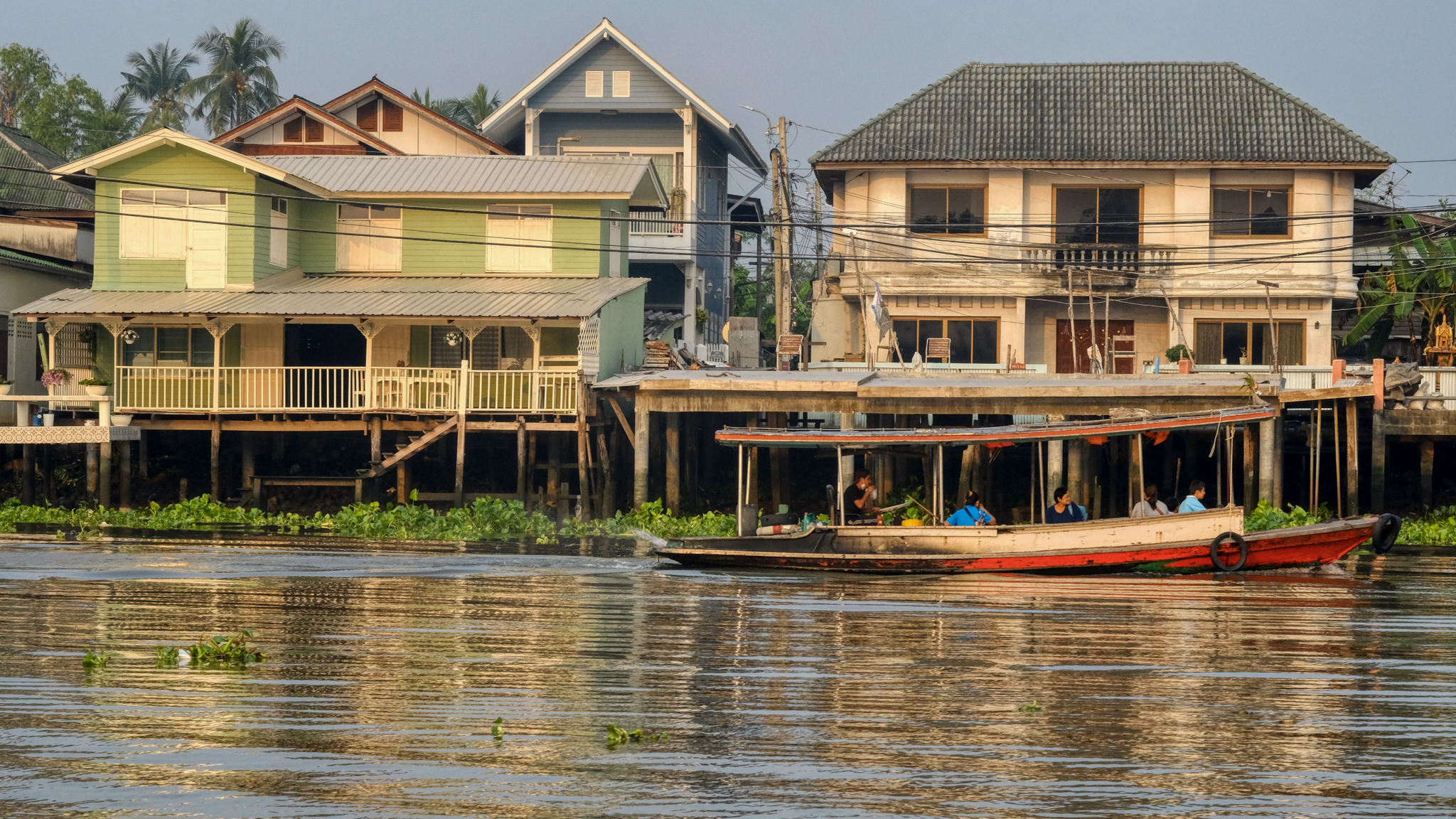 All along the canal small ferries offer a 'short cut' off the island.
All along the canal small ferries offer a 'short cut' off the island.
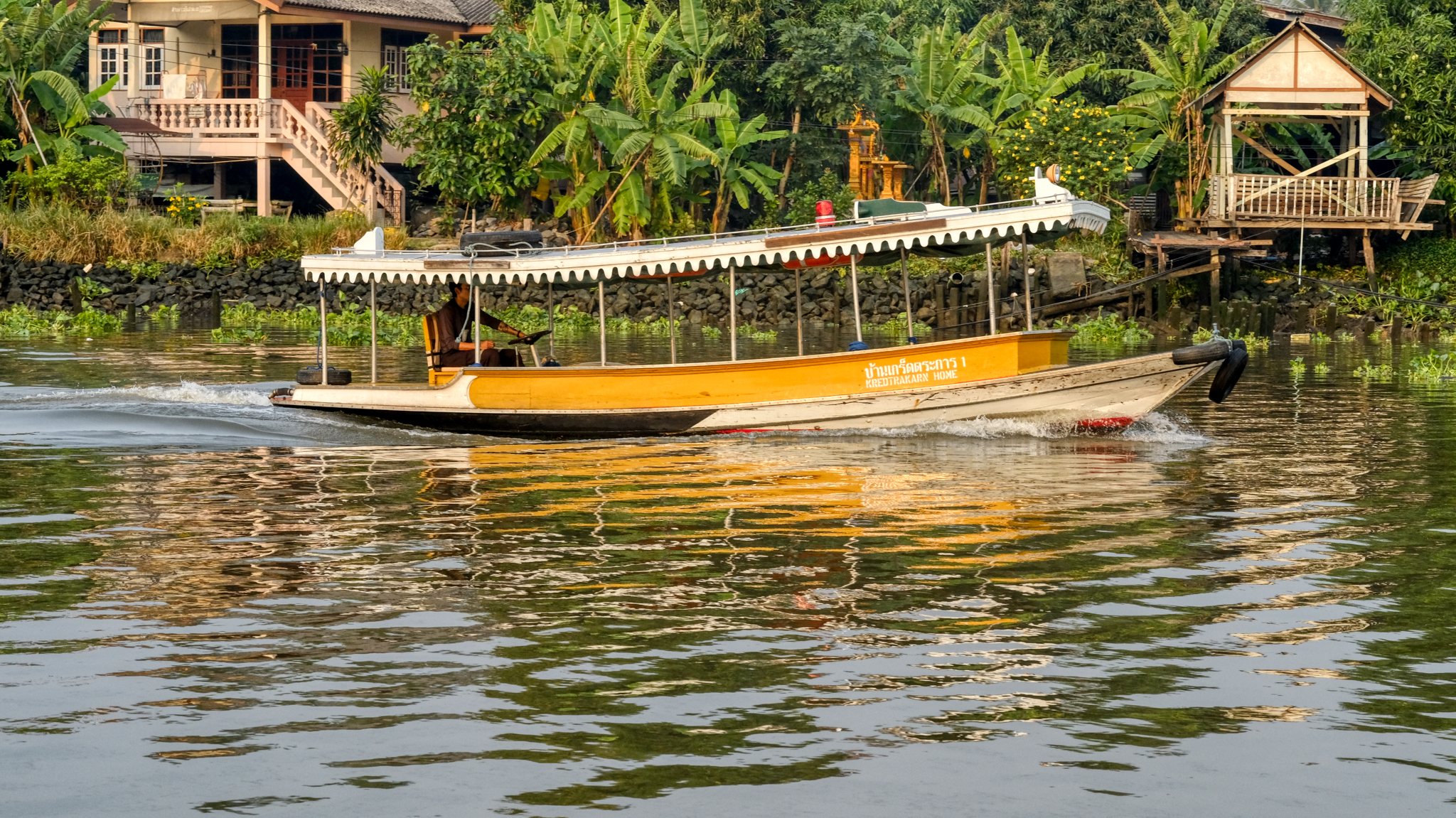 On most mornings these small ferries are full of school children on their way to school.
On most mornings these small ferries are full of school children on their way to school.
 The river is itself a busy part of the city in places. Here a collection of work boats busily raising the banks of the river.
The river is itself a busy part of the city in places. Here a collection of work boats busily raising the banks of the river.
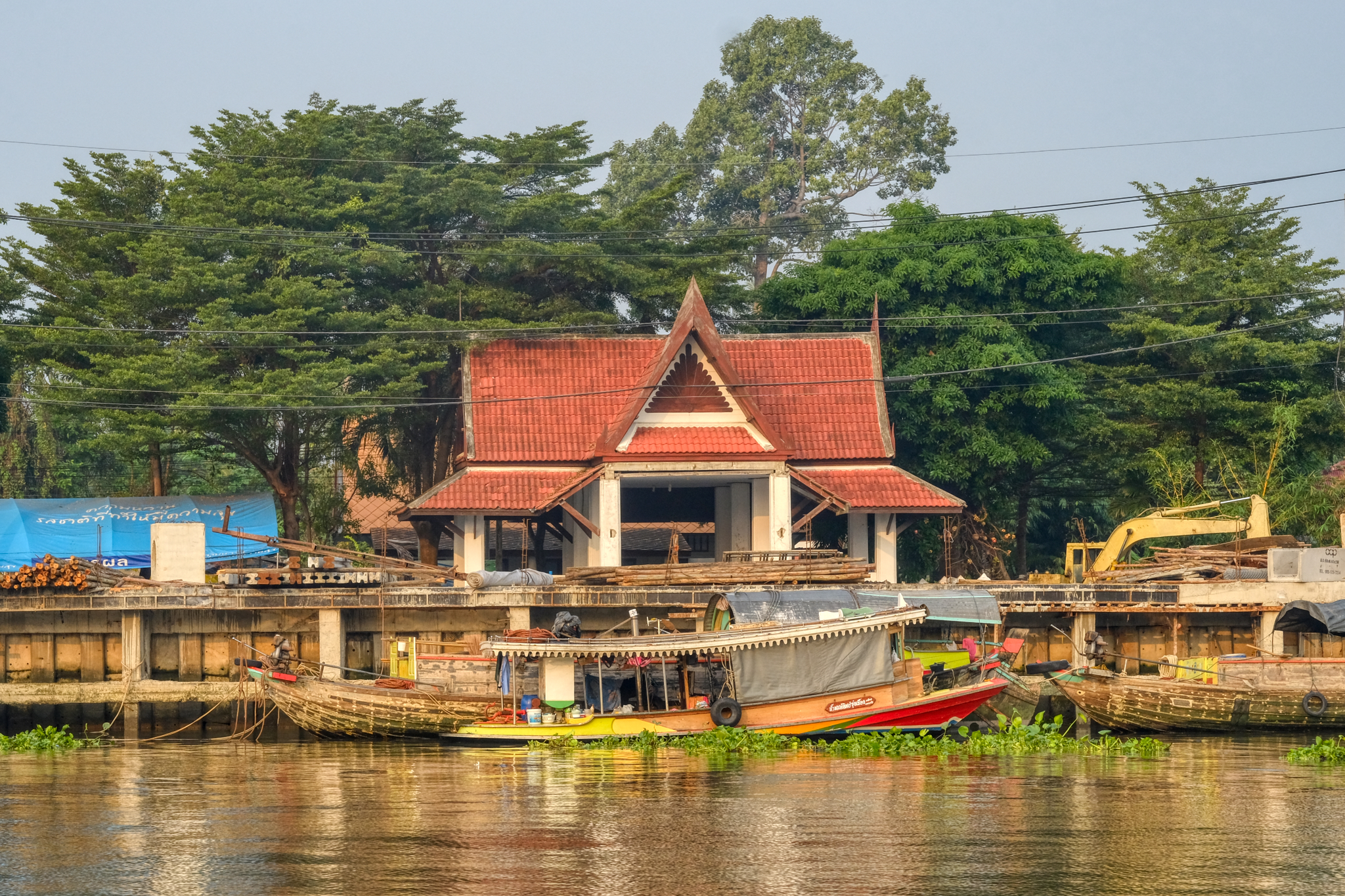 The river, even here at 75 miles from the ocean (Gulf of Thailand), is estuarial. As such, it is subject to the effects of climate change and sea level rise. The city and national government are making a huge effort to raise the banks along many, many miles of the river.
The river, even here at 75 miles from the ocean (Gulf of Thailand), is estuarial. As such, it is subject to the effects of climate change and sea level rise. The city and national government are making a huge effort to raise the banks along many, many miles of the river.
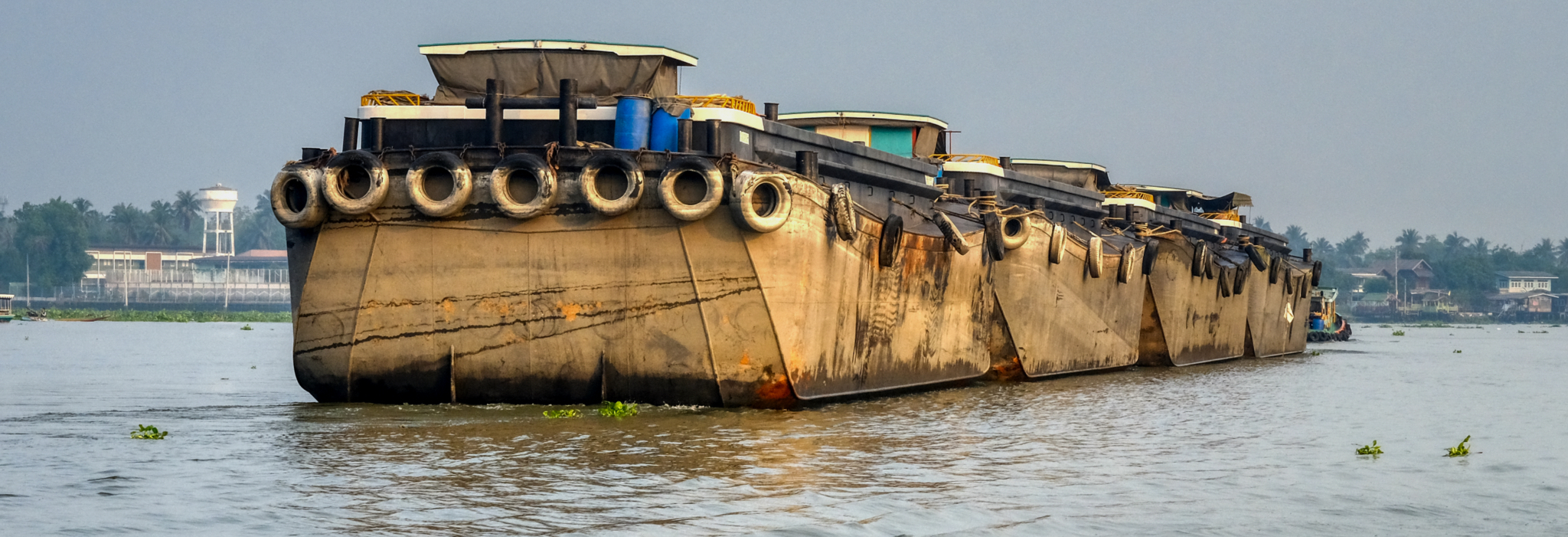 One of the great sights on the river each morning are the coming and goings of the barge trains, always four barges long. These barges are empty and sitting high in the water . . . easily managed by a single tug boat on the ebb tide.
One of the great sights on the river each morning are the coming and goings of the barge trains, always four barges long. These barges are empty and sitting high in the water . . . easily managed by a single tug boat on the ebb tide.
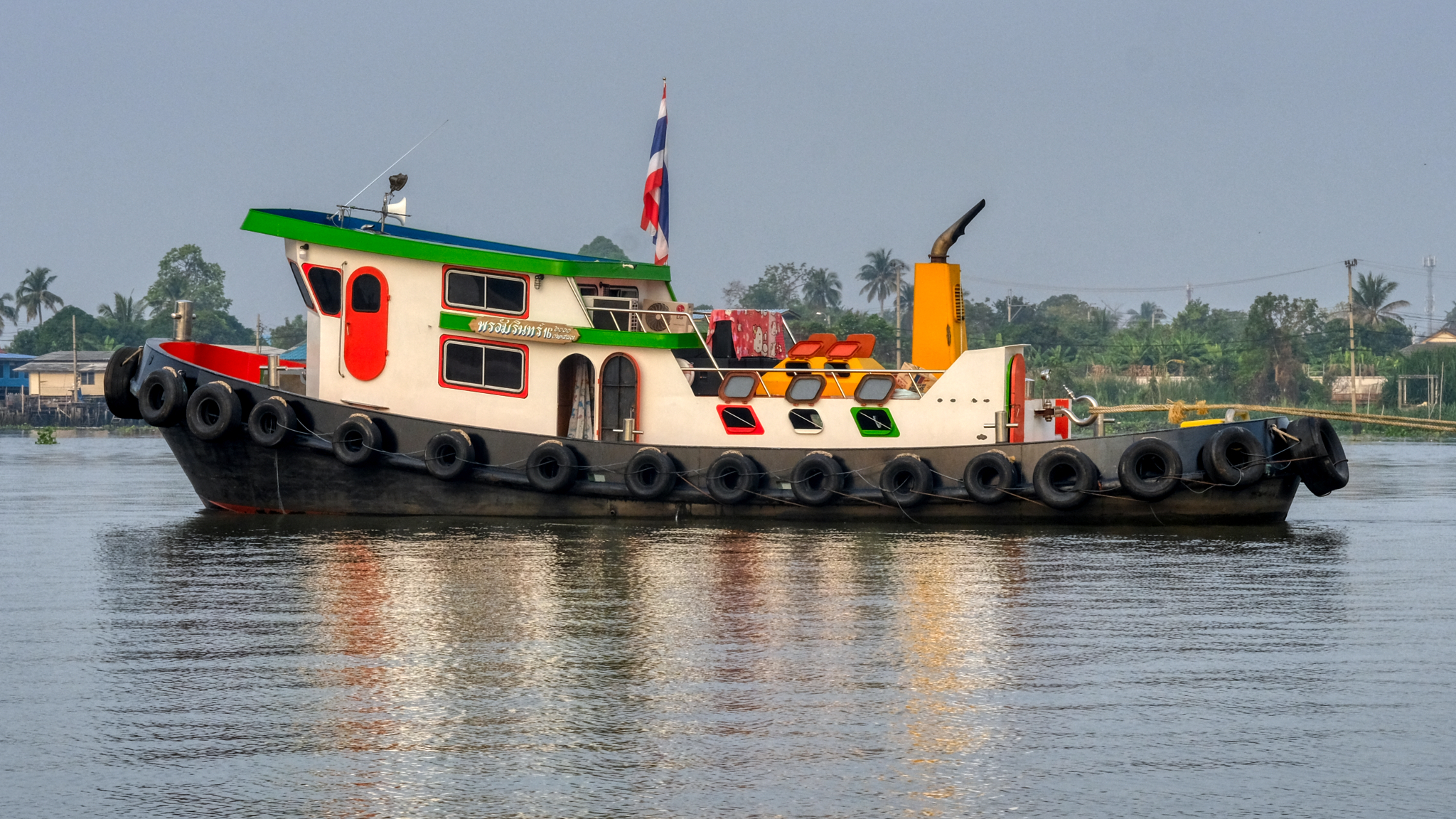 Magnificent and powerful: a Chao Phraya River tug boat.
Magnificent and powerful: a Chao Phraya River tug boat.
 Many fabulous Buddhist wats can be seen on my morning journey.
Many fabulous Buddhist wats can be seen on my morning journey.
 A loaded barge train passes a giant Buddha statue. I watched this colossal Buddha being built over the last three years from my seat on the express boat. It is now finished. I must make a pilgrimage to this wat soon to pay my respects and make a donation in thanks for the wonderful reminder it provides every morning to make something of my consciousness.
A loaded barge train passes a giant Buddha statue. I watched this colossal Buddha being built over the last three years from my seat on the express boat. It is now finished. I must make a pilgrimage to this wat soon to pay my respects and make a donation in thanks for the wonderful reminder it provides every morning to make something of my consciousness.
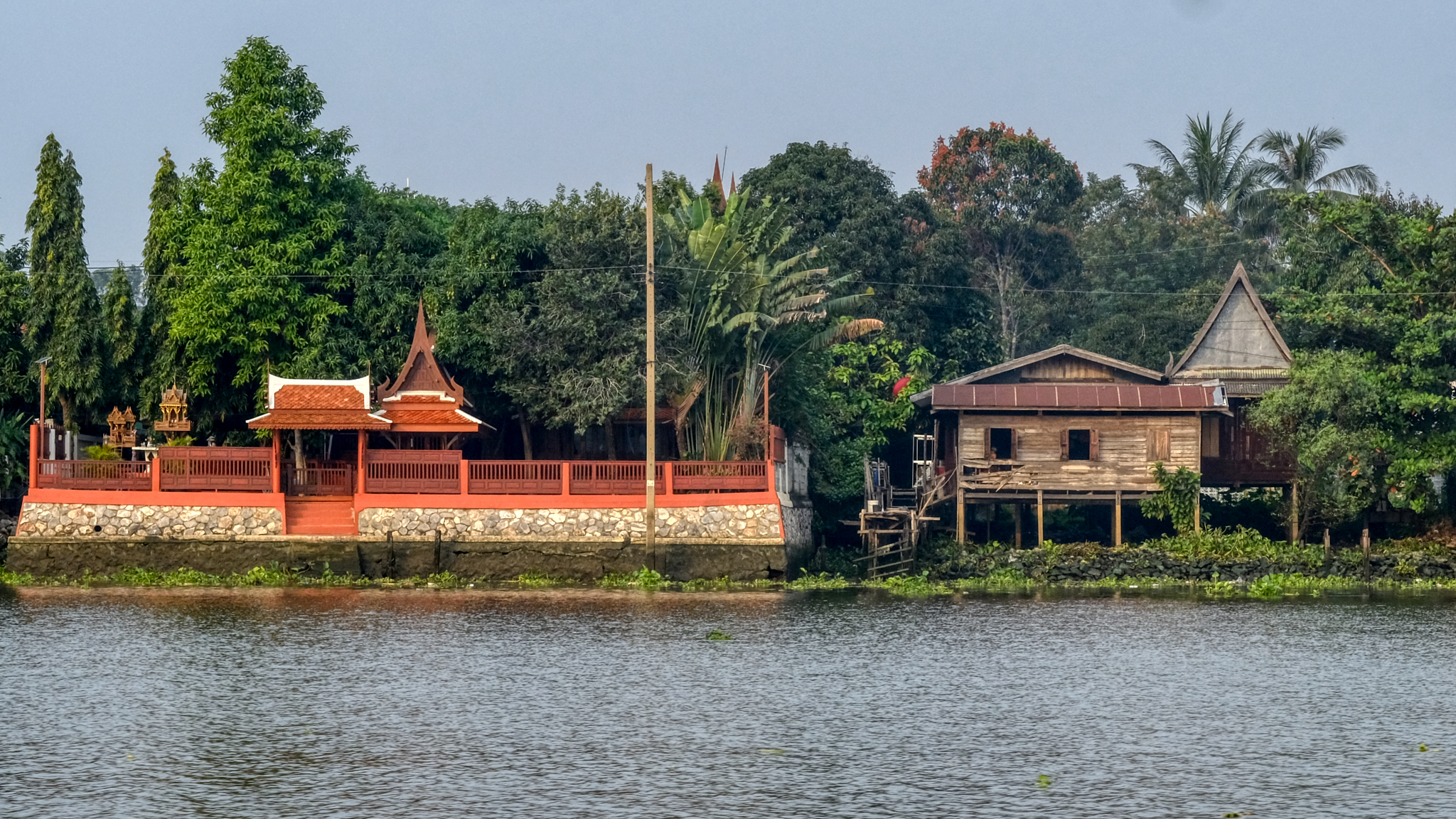 Traditional Thai architecture, old and new.
Traditional Thai architecture, old and new.
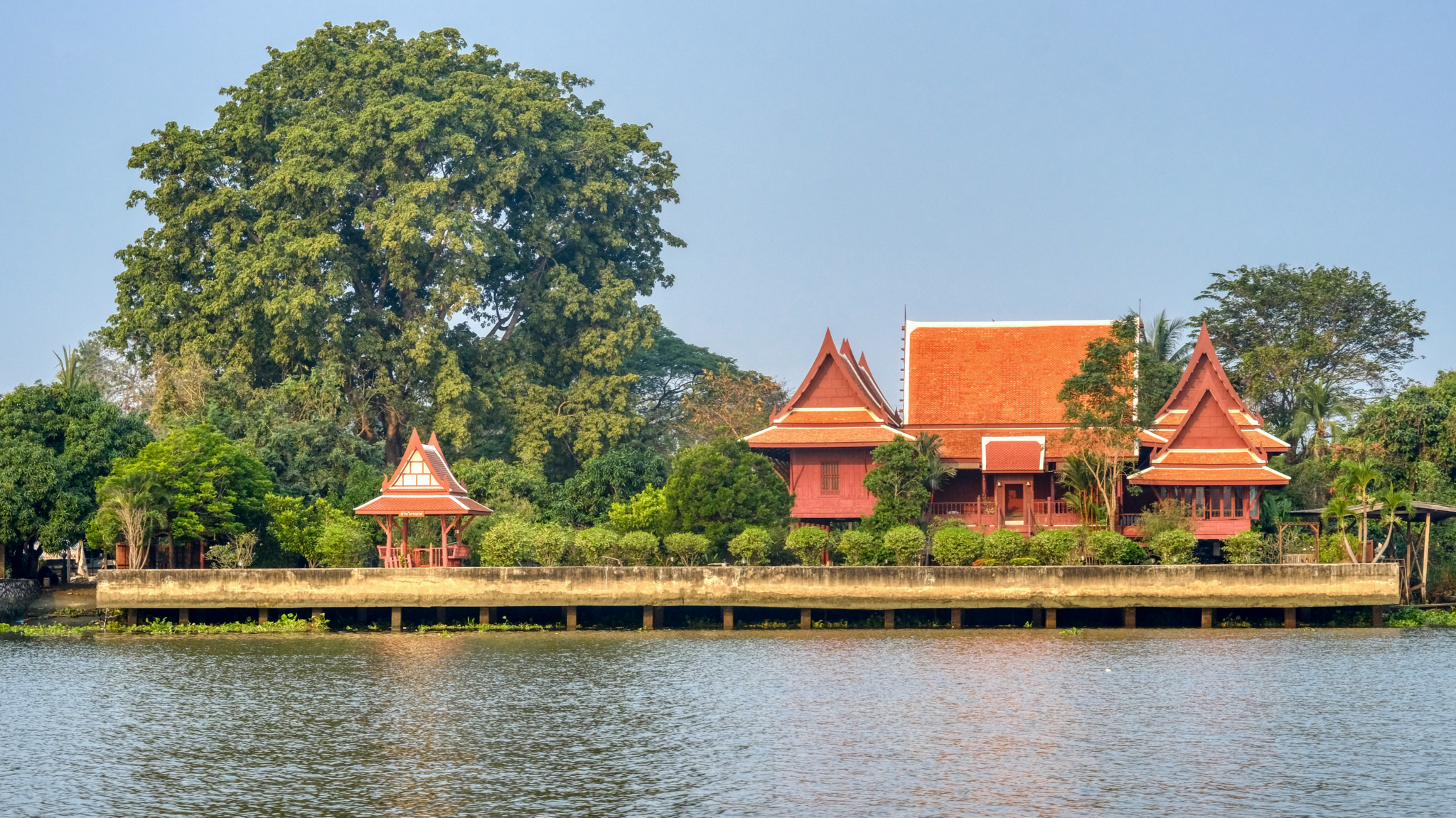 Another of my dream houses. I've been following its renovation from afar for quite some time.
Another of my dream houses. I've been following its renovation from afar for quite some time.
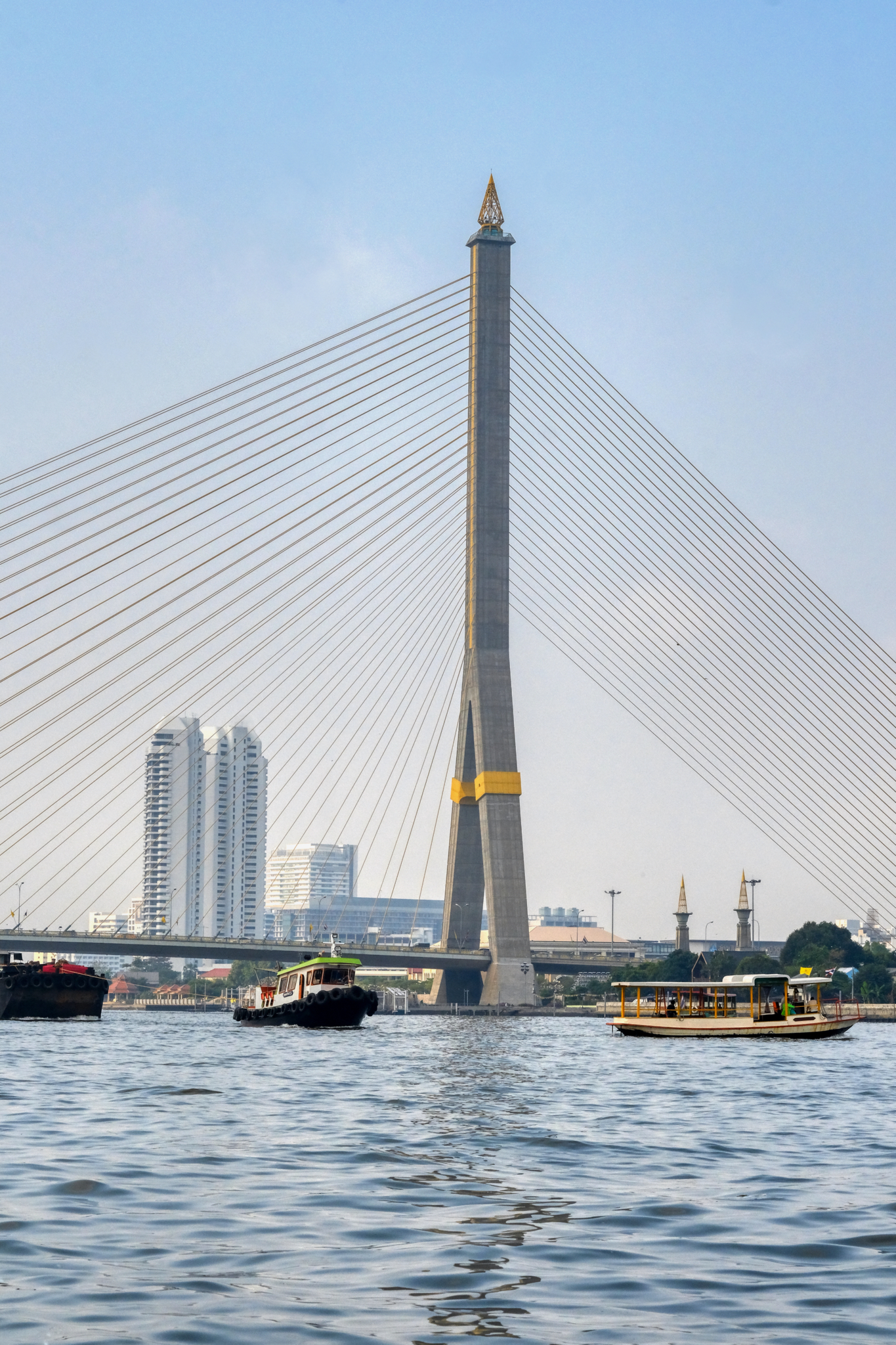 I pass under four bridges on my way to work.
I pass under four bridges on my way to work.
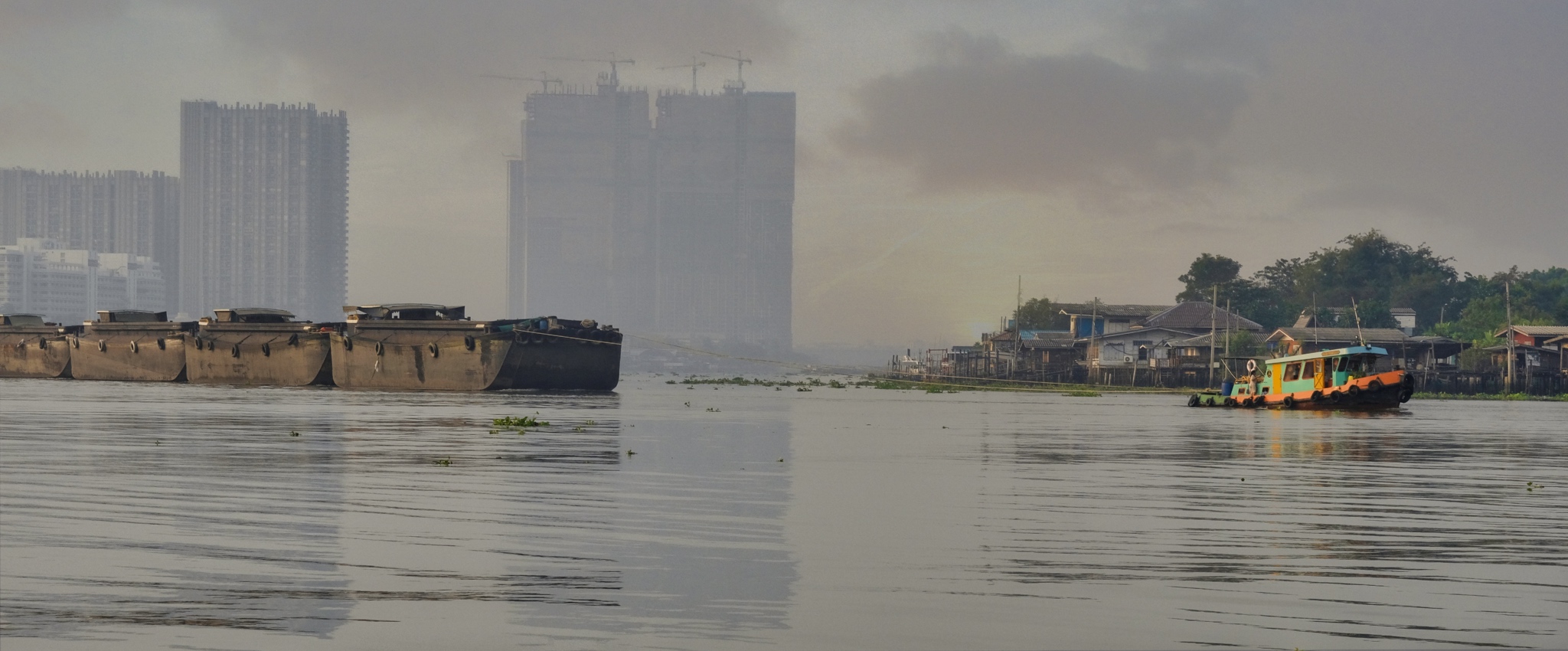 Further down the river and into fast growing Bangkok, a city of 14 million people . . . and the dusty, smoky air that it creates.
Further down the river and into fast growing Bangkok, a city of 14 million people . . . and the dusty, smoky air that it creates.
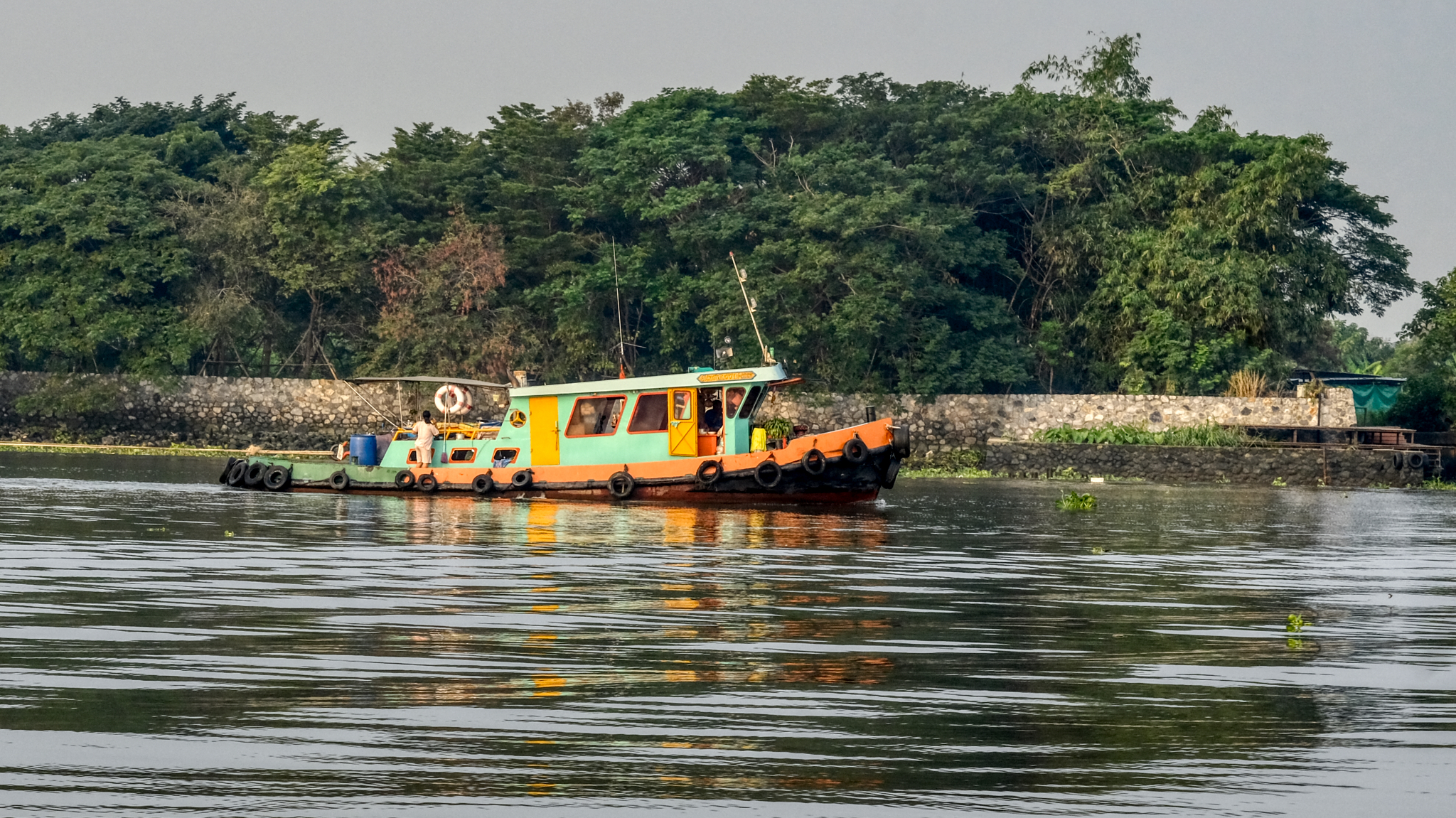 The river tug boats come in many sizes and colors.
The river tug boats come in many sizes and colors.
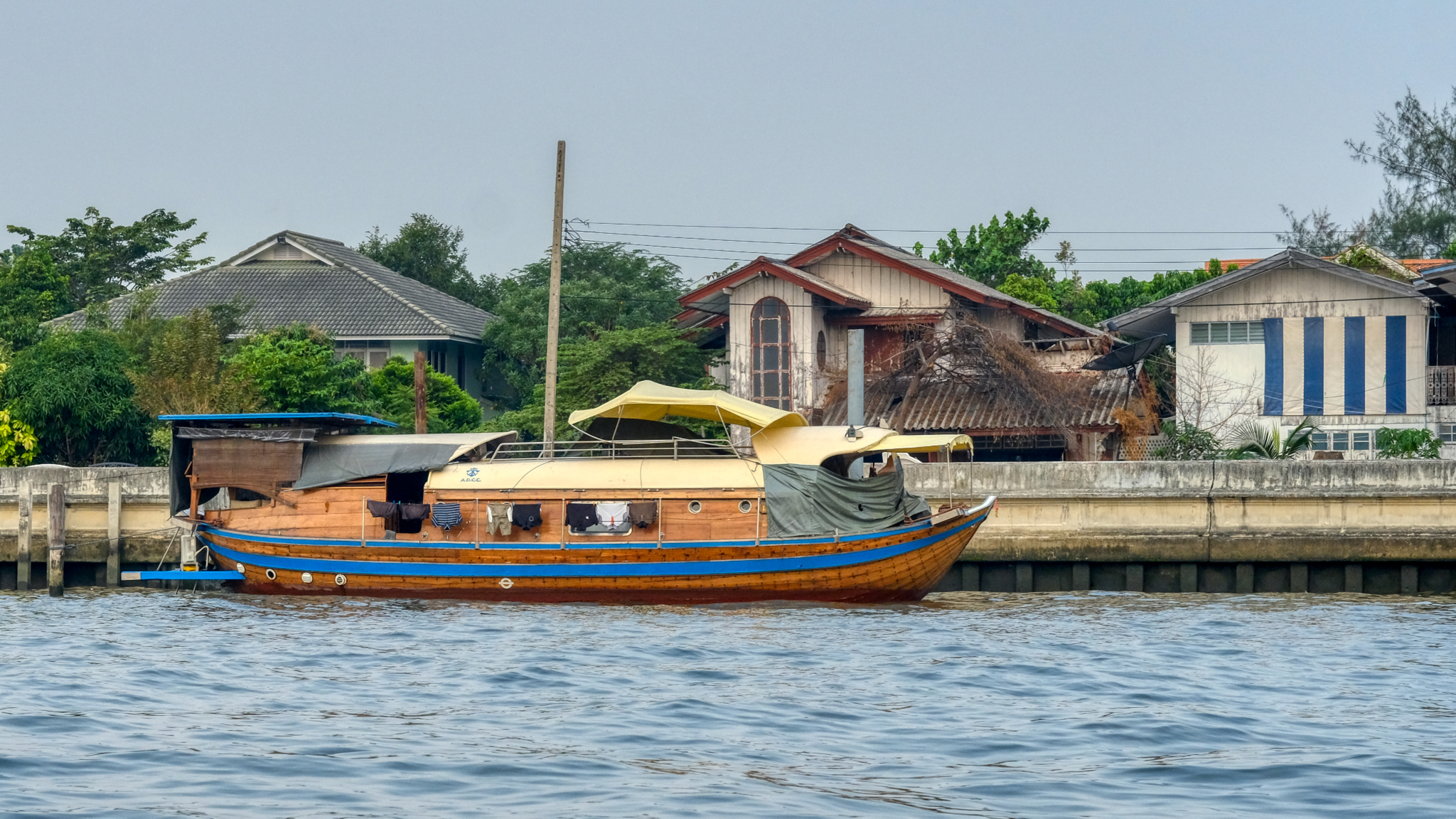 These barges, known as rice barges, were made of teak wood in former days. They are often now converted to self-propelled cabin boats for the tourist trade.
These barges, known as rice barges, were made of teak wood in former days. They are often now converted to self-propelled cabin boats for the tourist trade.
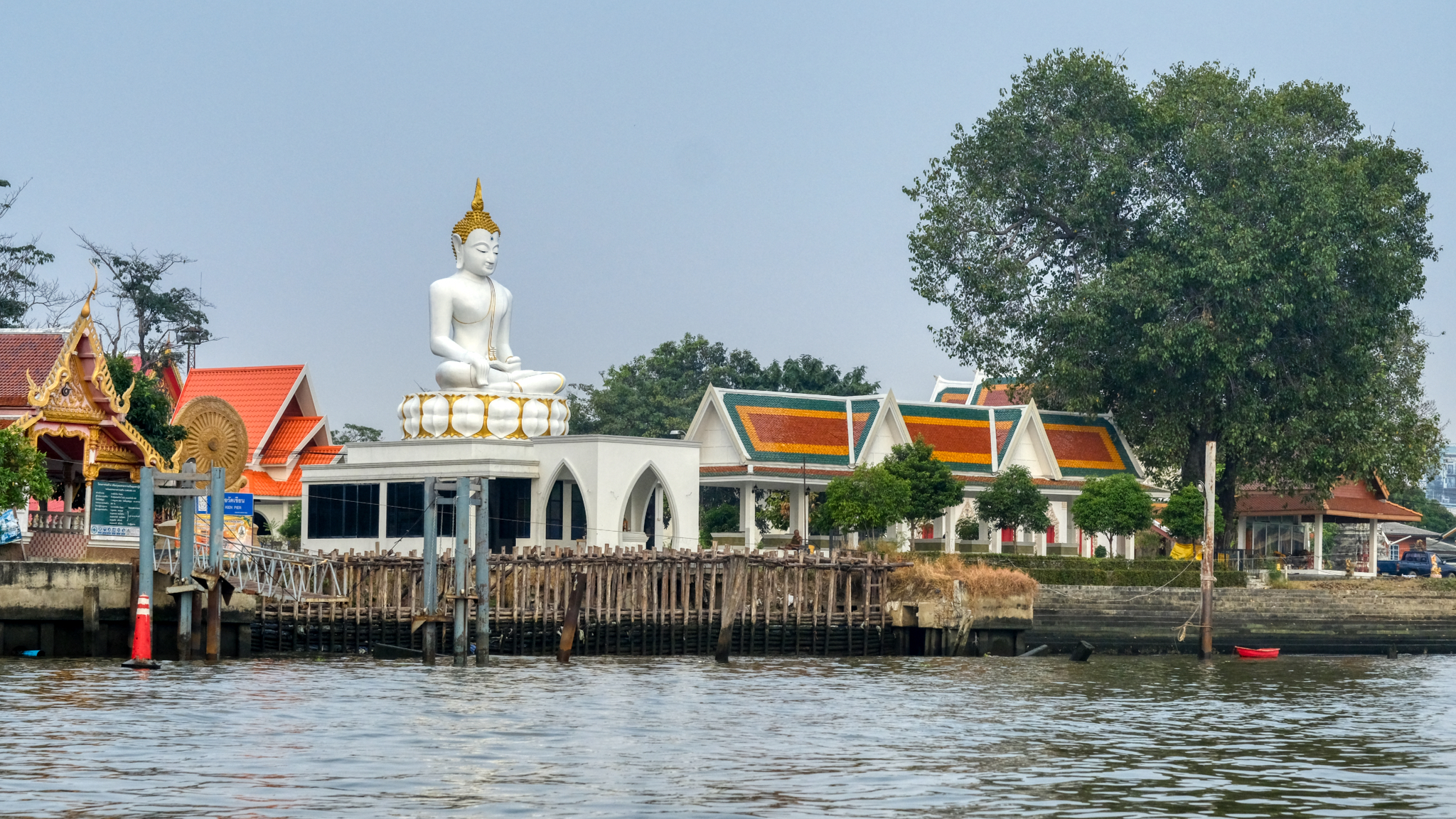 Whenever I see this particular Buddha image I wai and get up and walk to the disembarkation deck of the express boat; my stop is next.
Whenever I see this particular Buddha image I wai and get up and walk to the disembarkation deck of the express boat; my stop is next.
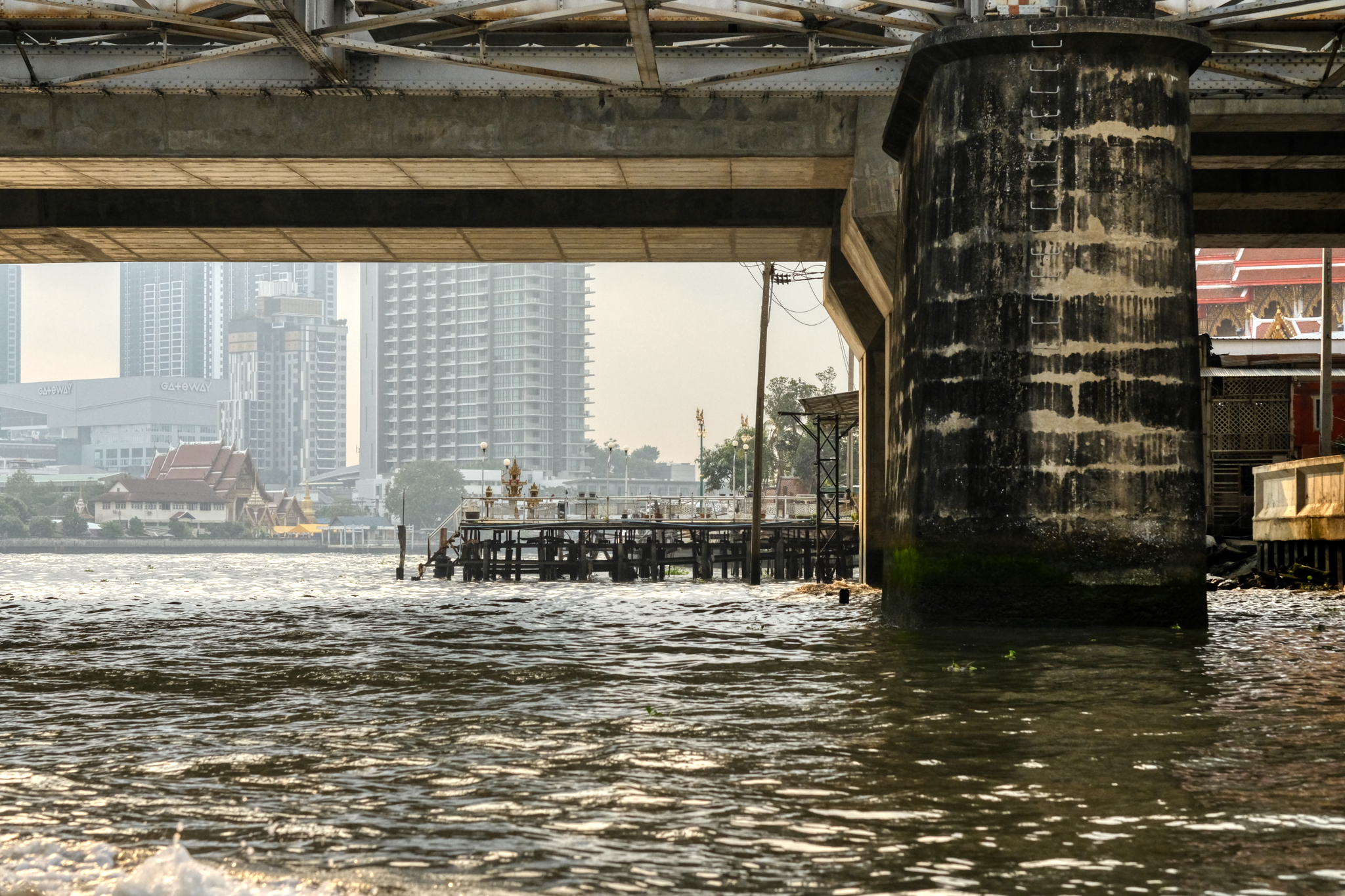 This is where I would normally get off the express boat, at the Rama VII Bridge, and walk the remaining one kilometer to my university job . . . but I am travelling on into the city this morning with a friend to see the Pak Khlong Flower Market.
This is where I would normally get off the express boat, at the Rama VII Bridge, and walk the remaining one kilometer to my university job . . . but I am travelling on into the city this morning with a friend to see the Pak Khlong Flower Market.
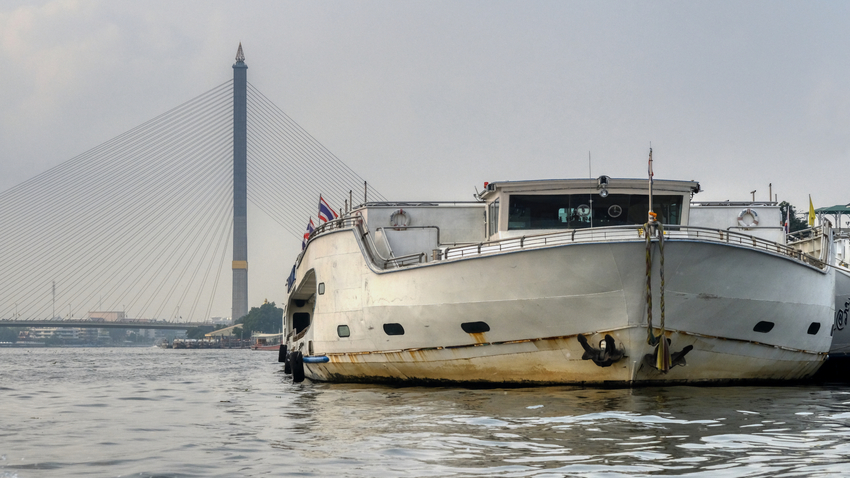 Down near the touristy part of the city are parked the large restaurant barges that specialize in night dining cruises through the lit city. I've done it.
Down near the touristy part of the city are parked the large restaurant barges that specialize in night dining cruises through the lit city. I've done it.
 Many tourist boats on the lower river . . . but almost no tourists in Thailand today. I worry for the Thai people who depend on tourist-related income.
Many tourist boats on the lower river . . . but almost no tourists in Thailand today. I worry for the Thai people who depend on tourist-related income.
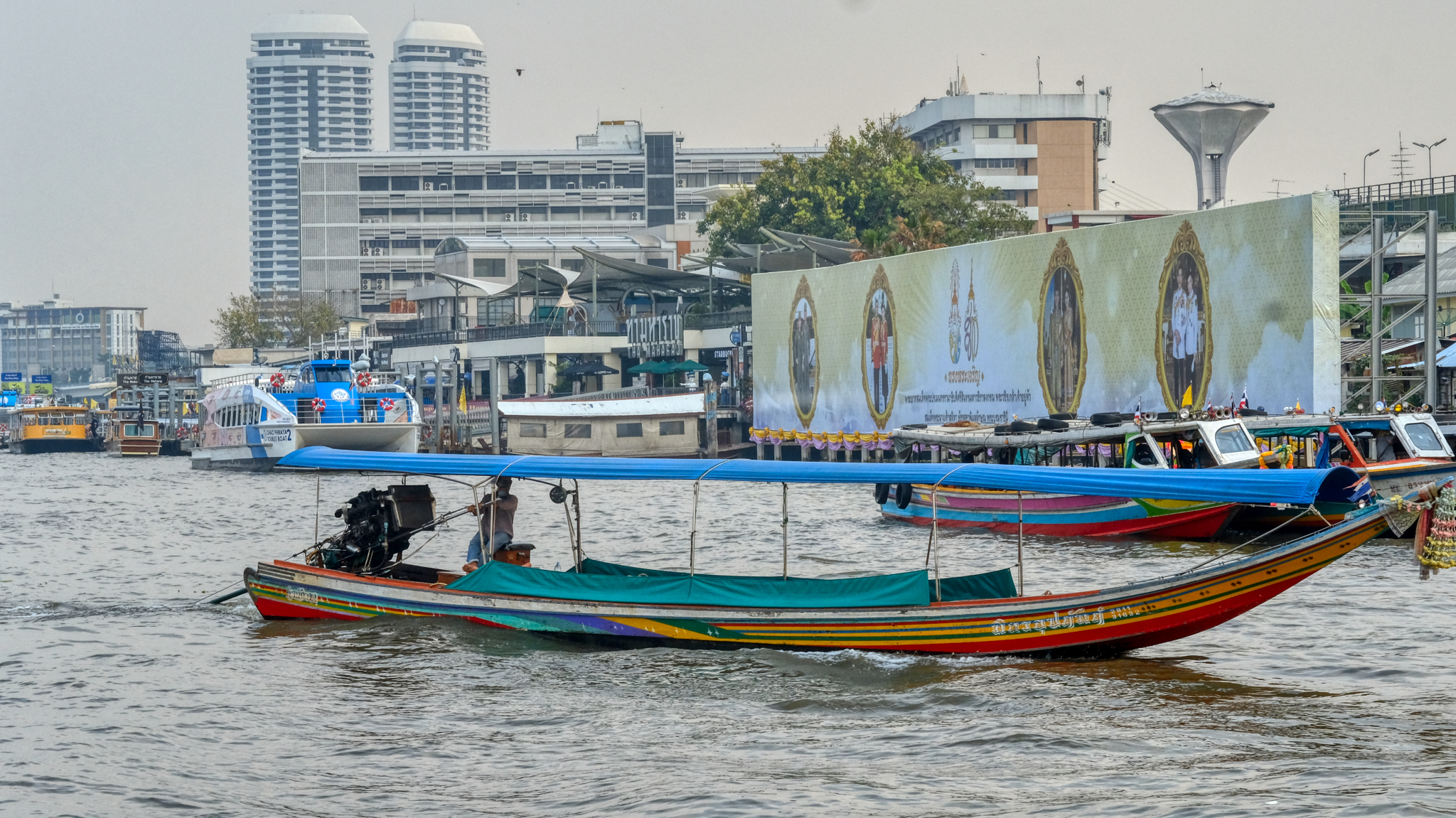 We got off the green flag Chao Phraya Express boat near here. The long-tail boat jockeys maneuvering for a fare.
We got off the green flag Chao Phraya Express boat near here. The long-tail boat jockeys maneuvering for a fare.
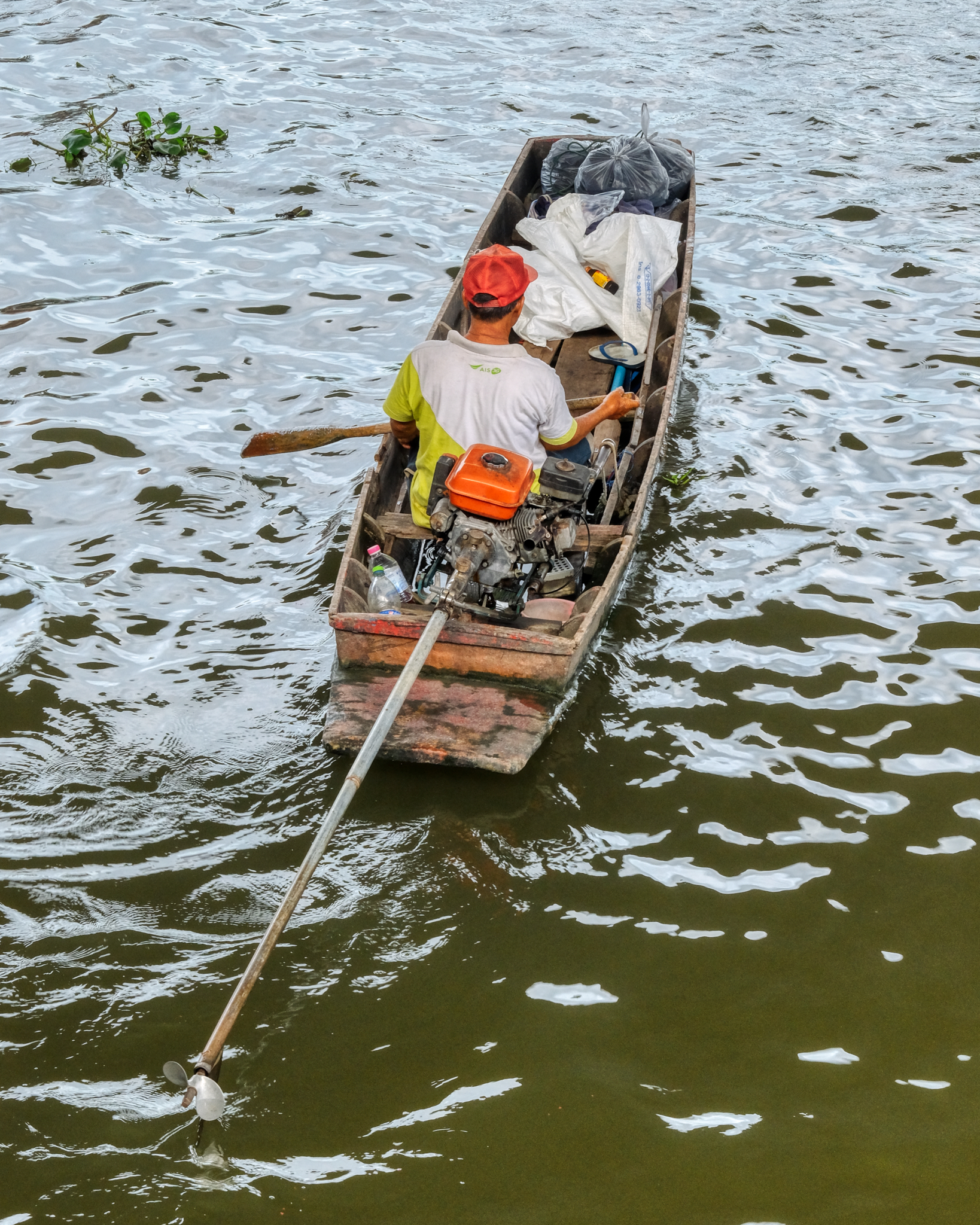
I miss all of this. This is my normal . . .
